D Link SR250NB1 Wireless N Service Router User Manual 13
D Link Corporation Wireless N Service Router 13
D Link >
Contents
- 1. User Manual-1
- 2. User Manual-2
User Manual-2
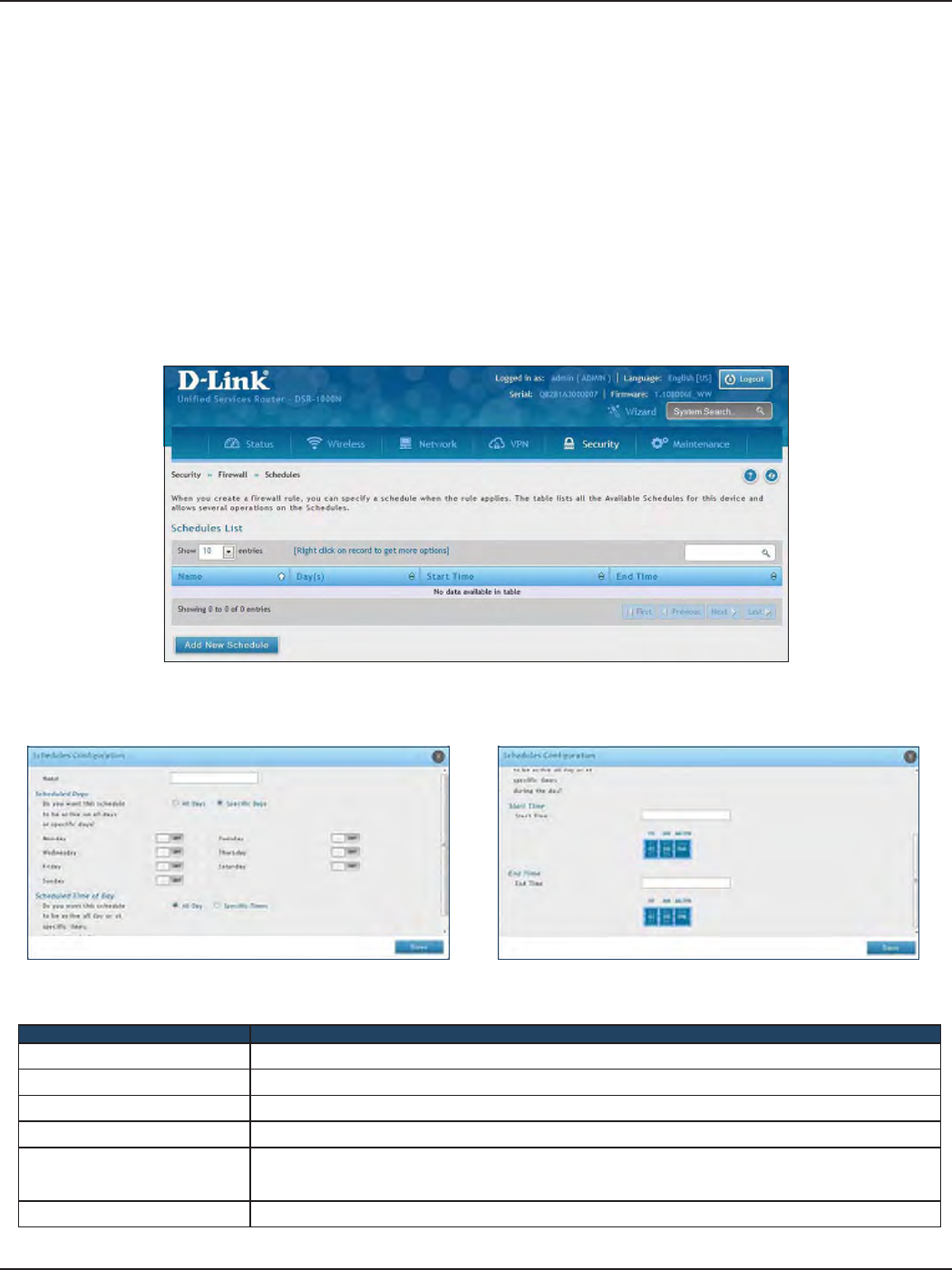
D-Link DSR-Series User Manual 148
Section 8 - Security
Schedules
Path: Security > Firewall > Schedules
Firewall rules can be enabled or disabled automatically if they are associated with a congured schedule. The
schedule conguration page allows you to dene days of the week and the time of day for a new schedule, and
then this schedule can be selected in the rewall rule conguration page.
Note: All schedules will follow the time in the router’s congured time zone. Refer to the section on choosing your Time
Zone and conguring NTP servers for more information.
To add, delete, or edit a schedule:
1. Click Security > Firewall > Schedules.
2. Right-click an entry and select either Edit or Delete. To add a new schedule, click Add New Schedule.
Field Description
Name Enter a name for your schedule.
Scheduled Days Select All Days or Specic Days.
Monday - Sunday If you selected Specic Days, toggle each day you want to ON.
Scheduled Time of Day Select All Day or Specic Times.
Start Time/End Time
If you selected Specic Times, use the mouse on the blue boxes representing the hour, minutes, and am/
pm to select the start time and end time. Click, hold, and move up to decrease the value or move down to
increase the value.
Save Click to save your settings.
Specic Days enabled Specic Times enabled
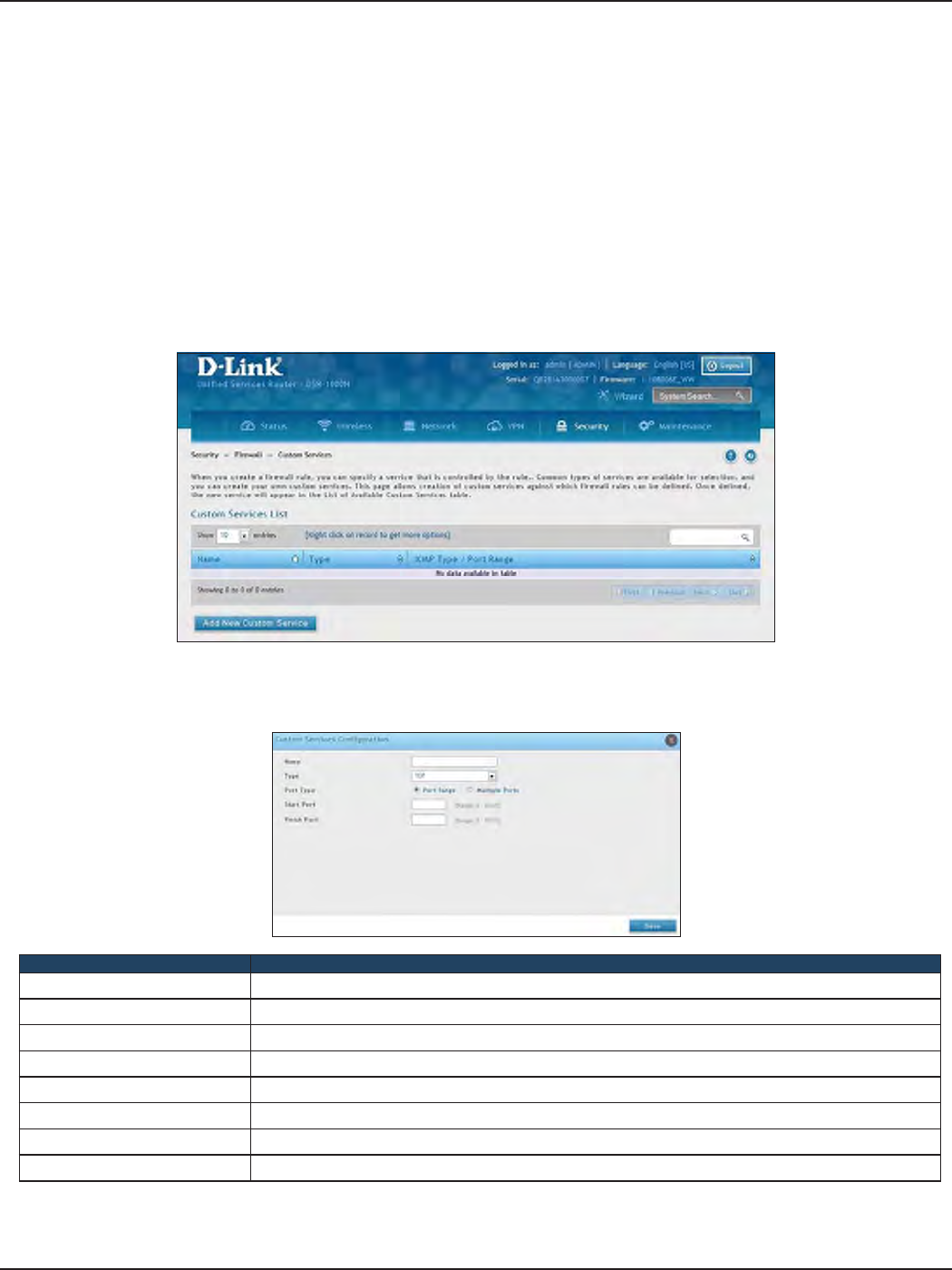
D-Link DSR-Series User Manual 149
Section 8 - Security
Custom Services
Path: Security > Firewall > Custom Services
Custom services can be dened to add to the list of services available during rewall rule conguration. While
common services have known TCP/UDP/ICMP ports for trac, many custom or uncommon applications exist
in the LAN or WAN. In the custom service conguration menu you can dene a range of ports and identify the
trac type (TCP/UDP/ICMP) for this service. Once dened, the new service will appear in the services list of the
rewall rules conguration menu.
To add, delete, or edit a custom service:
1. Click Security > Firewall > Custom Services.
2. Right-click an entry and select either Edit or Delete. To add a new schedule, click Add New Custom
Service.
Field Description
Name Enter a name for your custom service.
Type Enter the layer 3 protocol that the service uses (TCP, UDP, BOTH, or ICMP).
Port Type Select Port Range or Multiple Ports.
Start Port If you selected Port Range, enter the rst (TCP, UDP or BOTH) port of a range that the service uses.
Finish Port If you selected Port Range, enter the last port of a range that the service uses.
Ports If you selected Multiple Ports, enter the port or ports separated by a comma.
ICMP Type The ICMP type is a numeric value that can range between 0 and 40.
Save Click to save your settings.
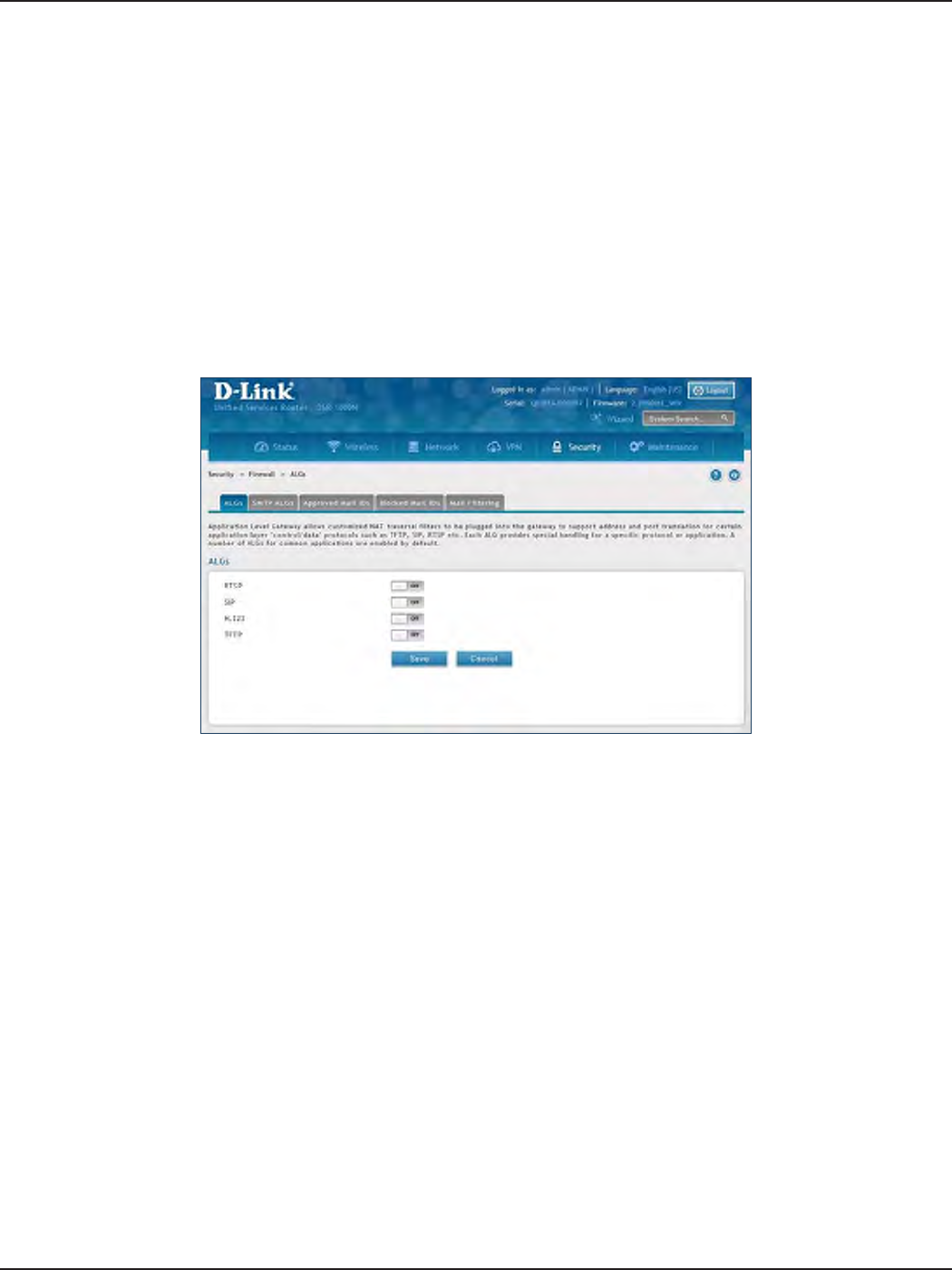
D-Link DSR-Series User Manual 150
Section 8 - Security
ALGs
Path: Security > Firewall > ALGs
Application Level Gateways (ALGs) are security components that enhance the rewall and NAT support of this
router to seamlessly support application layer protocols. In some cases enabling the ALG will allow the rewall
to use dynamic ephemeral TCP/ UDP ports to communicate with the known ports a particular client application
(such as H.323 or RTSP) requires, without which the admin would have to open large number of ports to
accomplish the same support. Because the ALG understands the protocol used by the specic application that it
supports, it is a very secure and ecient way of introducing support for client applications through the router’s
rewall.
1. Click Security > Firewall > ALGs tab.
2. Toggle the protocol(s) to ON that you want to allow through the router.
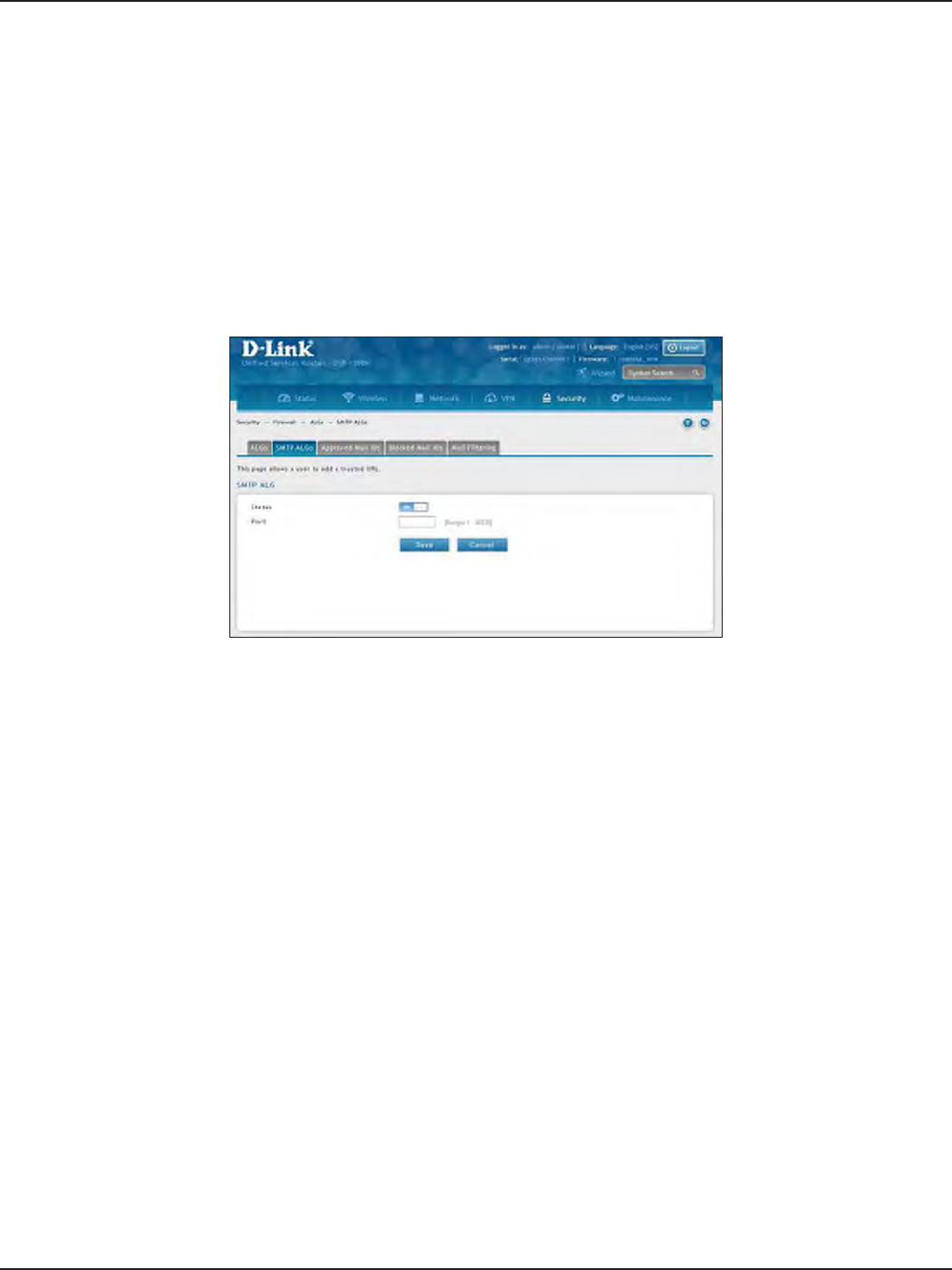
D-Link DSR-Series User Manual 151
Section 8 - Security
SMTP ALGs
Path: Security > Firewall > ALGs > SMTP ALGs
Simple Mail Transfer Protocol (SMTP) is a text based protocol used for transferring email between mail servers
over the Internet. Typically the local SMTP server will be located on a DMZ so that mail sent by remote SMTP
servers will traverse the router to reach the local server. Local users will then use email client software to retrieve
their email from the local SMTP server. SMTP is also used when clients are sending email and SMTP ALG can be
used to monitor SMTP trac originating from both clients and servers.
1. Click Security > Firewall > ALGs > SMTP ALGs tab.
2. Toggle Status to ON.
3. Enter the port at which the SMTP packets are inspected.
4. Click Save.
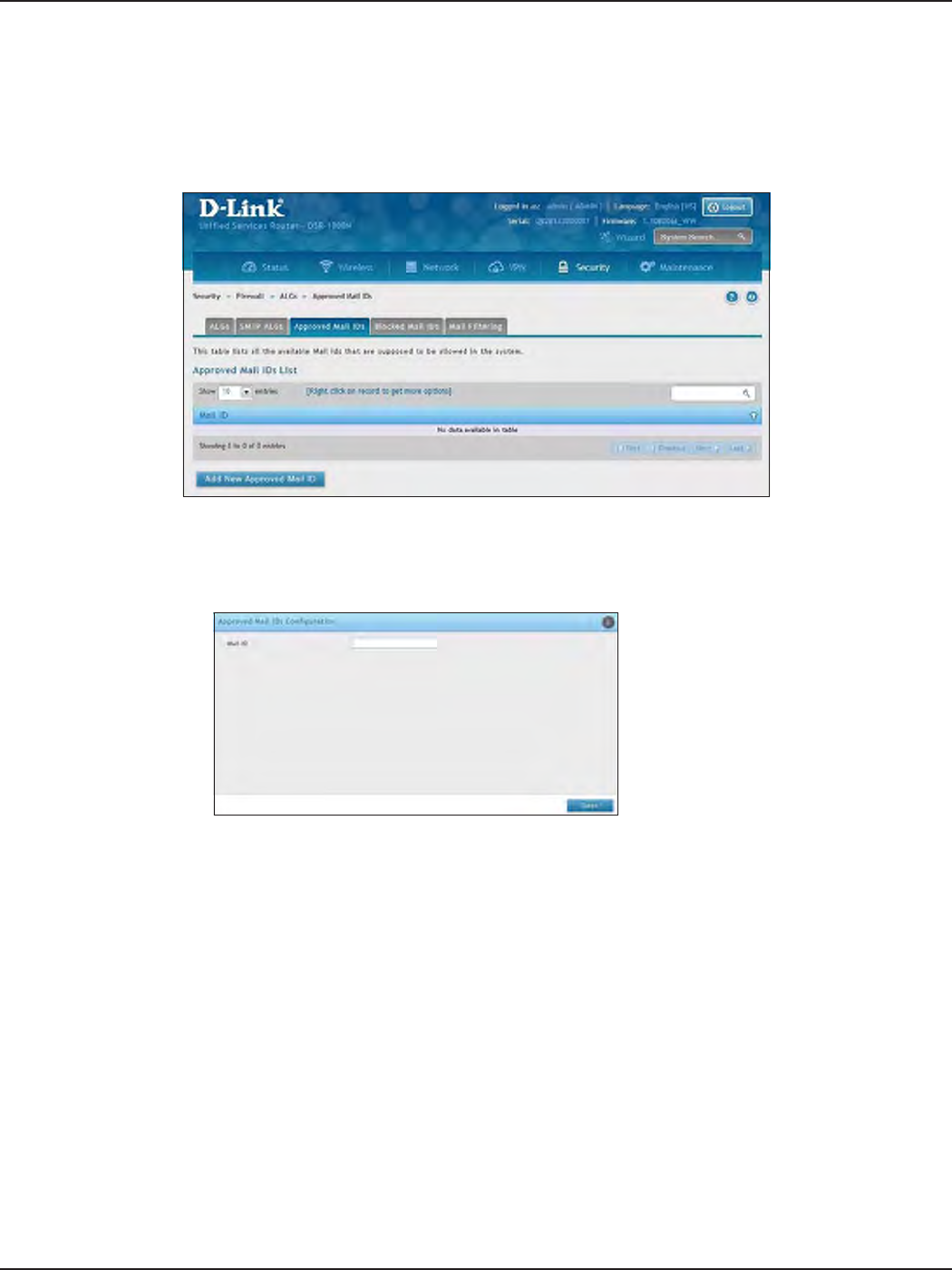
D-Link DSR-Series User Manual 152
Section 8 - Security
Approved Mail IDs
Path: Security > Firewall > ALGs > Approved Mail IDs
1. Click Security > Firewall > ALGs > Approved Mail IDs tab.
2. Right-click an entry and select either Edit or Delete. To add a new mail ID, click Add New Approved
Mail ID.
3. Enter a mail ID and click Save.
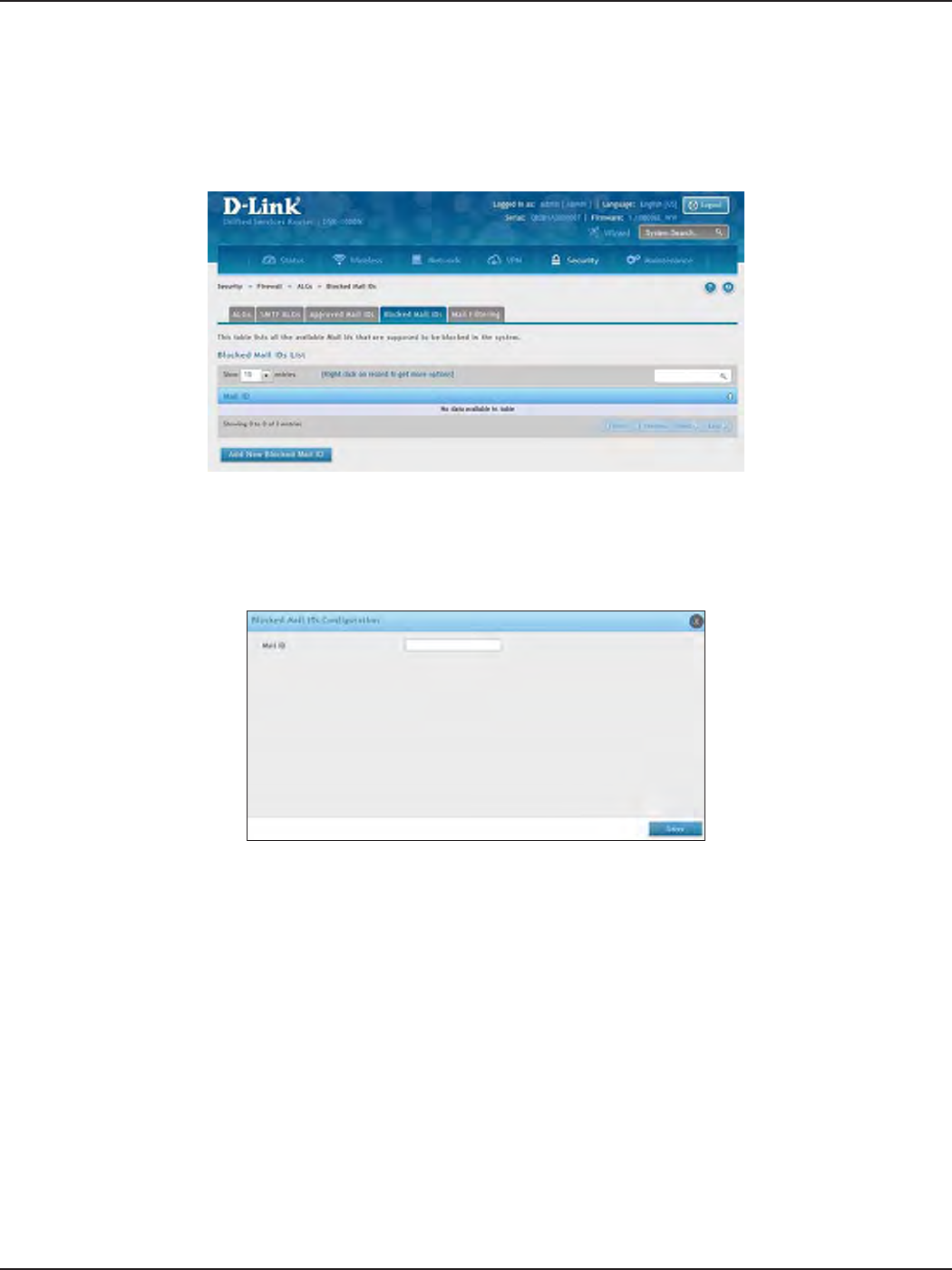
D-Link DSR-Series User Manual 153
Section 8 - Security
Blocked Mail IDs
Path: Security > Firewall > ALGs > Blocked Mail IDs
1. Click Security > Firewall > ALGs > Blocked Mail IDs tab.
2. Right-click an entry and select either Edit or Delete. To add a new mail ID, click Add New Blocked Mail
ID.
3. Enter a mail ID and click Save.
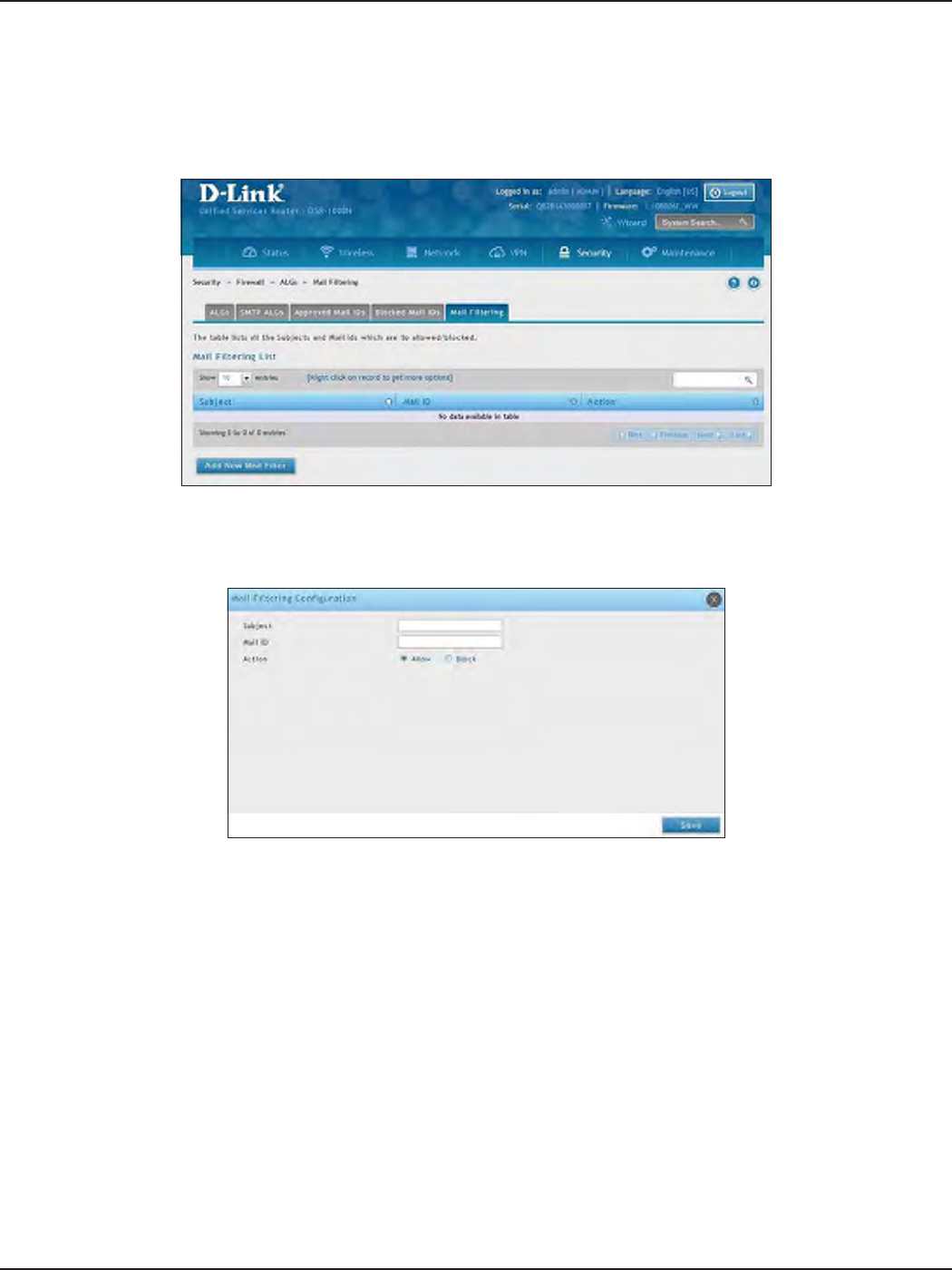
D-Link DSR-Series User Manual 154
Section 8 - Security
Mail Filtering
Path: Security > Firewall > ALGs > Mail Filtering
1. Click Security > Firewall > ALGs > Mail Filtering tab.
2. Right-click an entry and select either Edit or Delete. To add a new mail ID, click Add New Mail Filter.
3. Enter a subject and a mail ID.
4. Select to allow or block.
5. Click Save.
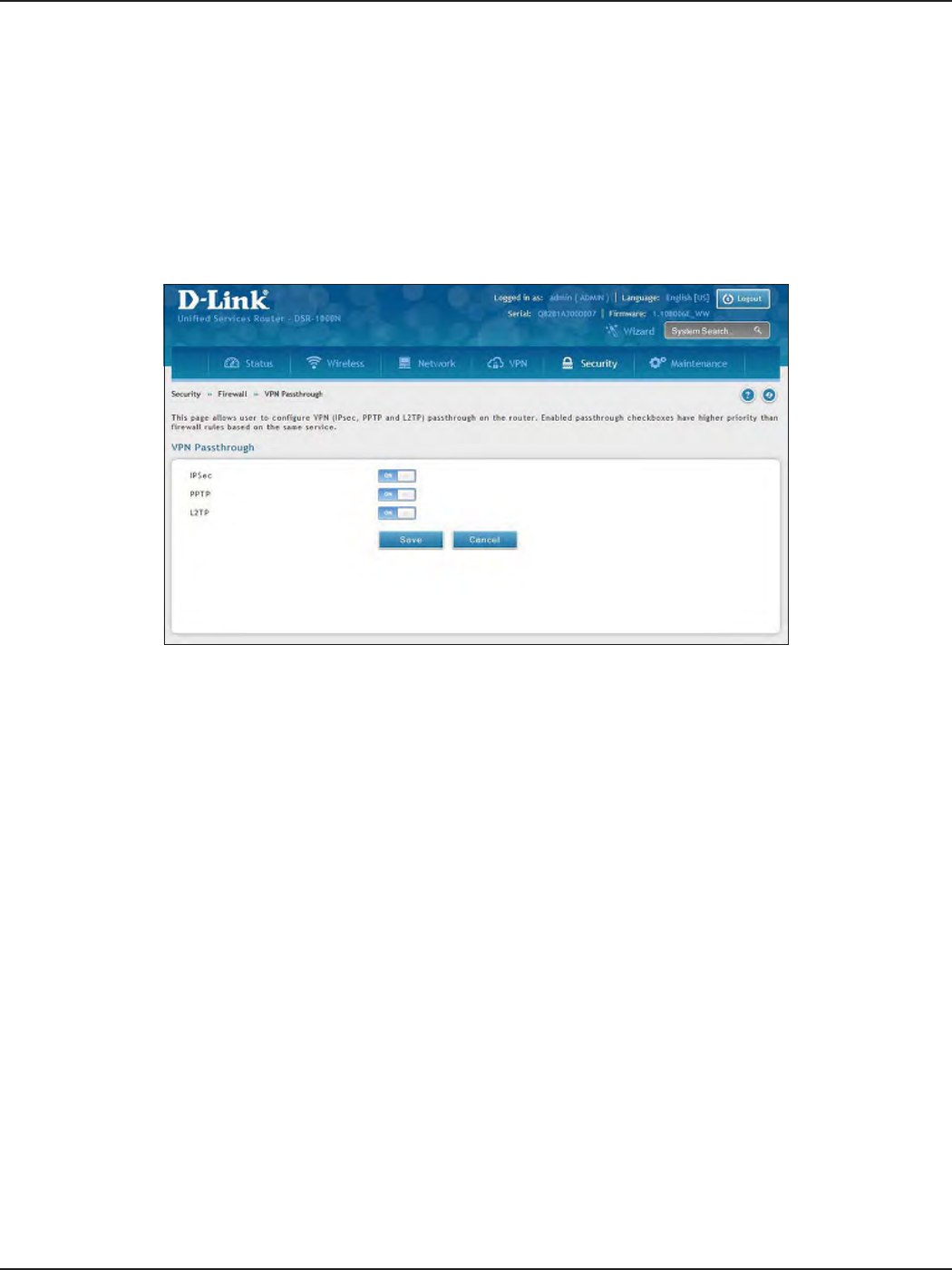
D-Link DSR-Series User Manual 155
Section 8 - Security
VPN Passthrough
Path: Security > Firewall > VPN Passthrough
This router’s rewall settings can be congured to allow encrypted VPN trac for IPsec, PPTP, and L2TP VPN tunnel
connections between the LAN and internet. A specic rewall rule or service is not appropriate to introduce this
passthrough support; instead the options in the VPN Passthrough page must be toggled to ON.
1. Click Security > Firewall > VPN Passthrough.
2. Toggle the VPN protocol you want to allow to ON and click Save.
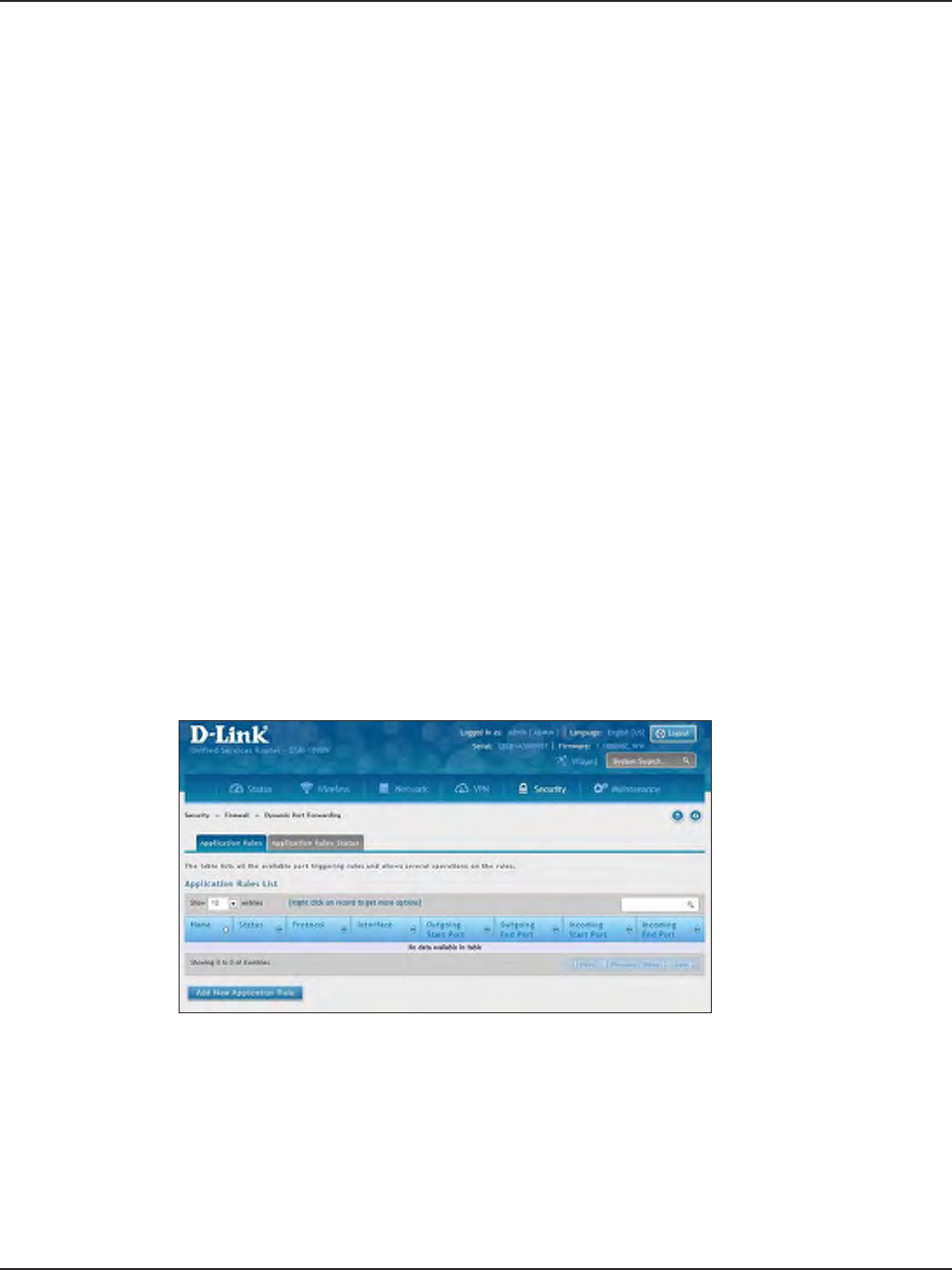
D-Link DSR-Series User Manual 156
Section 8 - Security
Dynamic Port Forwarding
Path: Security > Firewall > Dynamic Port Forwarding > Application Rules
Application rules are also referred to as port triggering. This feature allows devices on the LAN or DMZ to request
one or more ports to be forwarded to them. Port triggering waits for an outbound request from the LAN/DMZ
on one of the dened outgoing ports, and then opens an incoming port for that specied type of trac. This can
be thought of as a form of dynamic port forwarding while an application is transmitting data over the opened
outgoing or incoming port(s).
Port triggering application rules are more exible than static port forwarding that is an available option when
conguring rewall rules. This is because a port triggering rule does not have to reference a specic LAN IP or IP
range. As well ports are not left open when not in use, thereby providing a level of security that port forwarding
does not oer.
Note: Port triggering is not appropriate for servers on the LAN, since there i s a dependency on the LAN device making
an outgoing connection before incoming ports are opened.
Some applications require that when external devices connect to them, they receive data on a specic port or
range of ports in order to function properly. Th e router must send all incoming data for that application only on
the required port or range of ports. The router has a list of common applications and games with corresponding
outbound and inbound ports to open. You can also specify a port triggering rule by dening the type of trac
(TCP or UDP) and the range of incoming and outgoing ports to open when enabled.
1. Click Security > Firewall > Dynamic Port Forwarding > Application Rules tab.
Application Rules
2. Right-click an entry and select either Edit or Delete. To add a new schedule, click Add New Application
Rule.
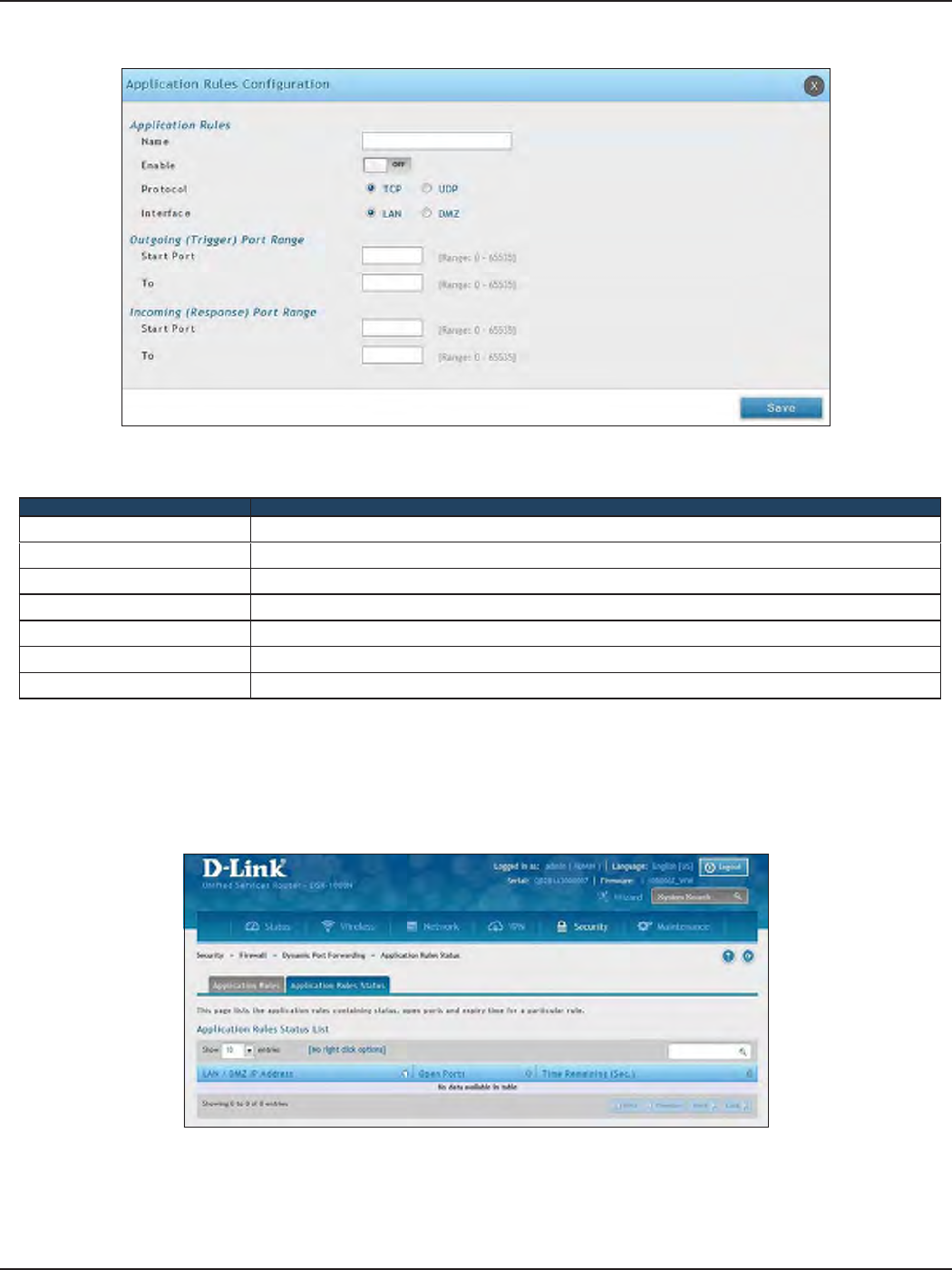
D-Link DSR-Series User Manual 157
Section 8 - Security
3. Complete the elds from the table below and click Save.
Field Description
Name Enter a name for your rule.
Enable Toggle to ON to activate the rule.
Protocol Select TCP or UDP.
Interface Select either LAN or DMZ.
Outgoing (Trigger) Port Range Enter the start and end trigger port range.
Incoming Port Range Enter the port range to open.
Save Click to save your settings.
4. Click on the Application Rules Status tab to see a list of rules and their status.
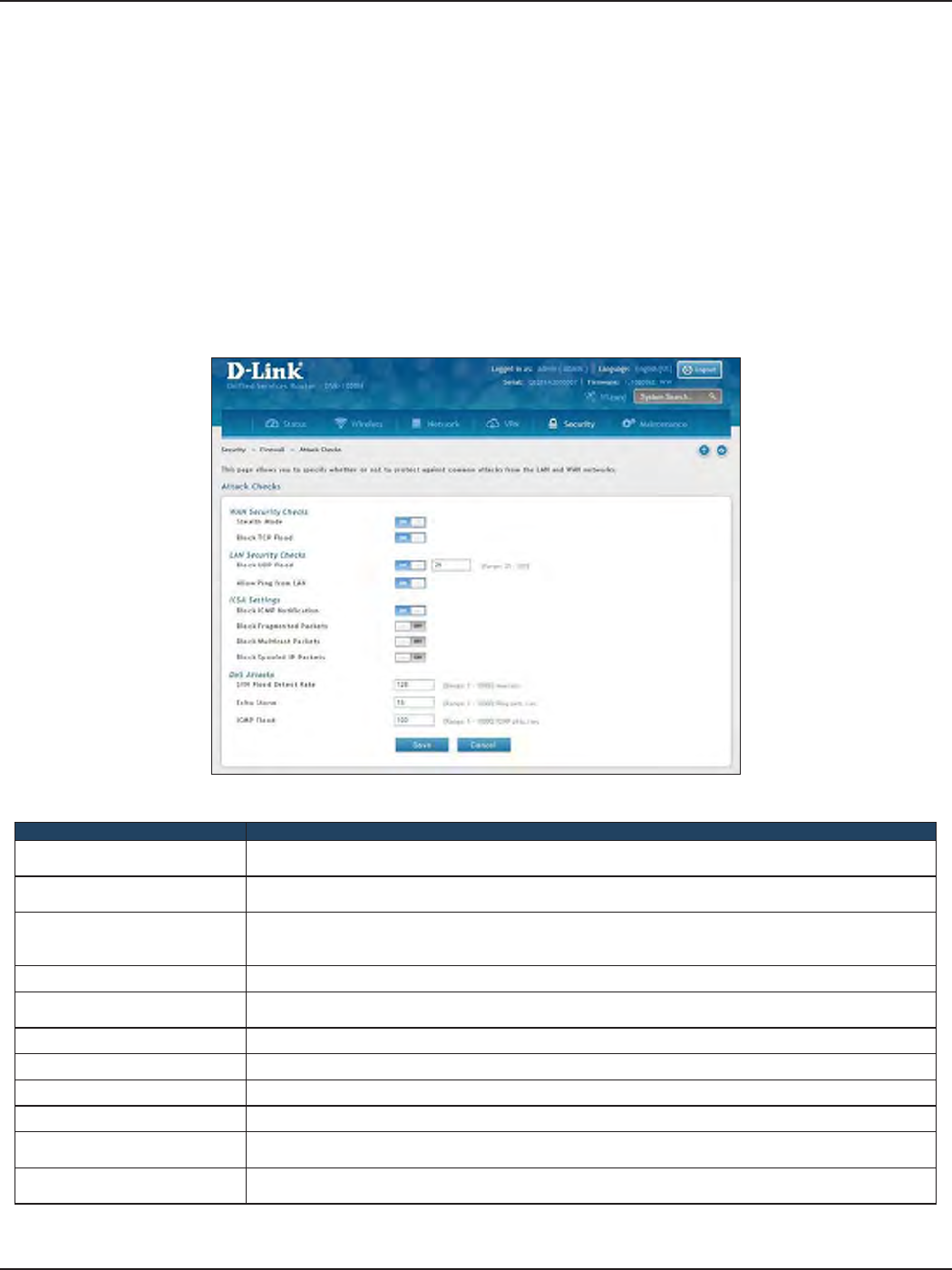
D-Link DSR-Series User Manual 158
Section 8 - Security
Attack Checks
Path: Security > Firewall > Attack Checks
Attacks can be malicious security breaches or unintentional network issues that render the router unusable
Attack checks allow you to manage WAN security threats such as continual ping requests and discovery via ARP
scans. TCP and UDP ood attack checks can be enabled to manage extreme usage of WAN resources.
Additionally certain Denial-of-Service (DoS) attacks can be blocked. These attacks, if uninhibited, can use up
processing power and bandwidth and prevent regular network services from running normally. ICMP packet
ooding, SYN trac ooding, and Echo storm thresholds can be congured to temporarily suspect trac from
the oending source.
1. Click Security > Firewall > Attack Checks.
2. Complete the elds from the table below and click Save.
Field Description
Stealth Mode If this option is toggled to ON, the router will not respond to port scans from the WAN. This makes it less
susceptible to discovery and attacks.
Block TCP Flood If this option is toggled to ON, the router will drop all invalid TCP packets and be protected from a SYN ood
attack.
Block UDP Flood
If this option is toggled to ON, the router will not accept more than 20 simultaneous, active UDP connec-
tions from a single computer on the LAN. You can set the number of simultaneous active UDP connections
to be accepted from a single computer on the LAN; the default is 25.
Allow Ping from LAN Toggle to ON to allow local computers to ping.
Block ICMP Notication Toggle to ON to prevent ICMP packets from being identied as such. ICMP packets, if identied, can be
captured and used in a Ping (ICMP) ood DoS attack.
Block Fragmented Packets Toggle to ON to drop any fragmented packets through or to the gateway
Block Multicast Packets Toggle to ON to drop multicast packets, which could indicate a spoof attack, through or to the router.
Block Spoofed IP Packets Toggle to ON to block any spoofed IP packets.
SYN Flood Detect Rate The rate at which the SYN Flood can be detected.
Echo Storm The number of ping packets per second at which the router detects an Echo storm attack from the WAN and
prevents further ping trac from that external address.
ICMP Flood The number of ICMP packets per second at which the router detects an ICMP ood attack from the WAN and
prevents further ICMP trac from that external address.
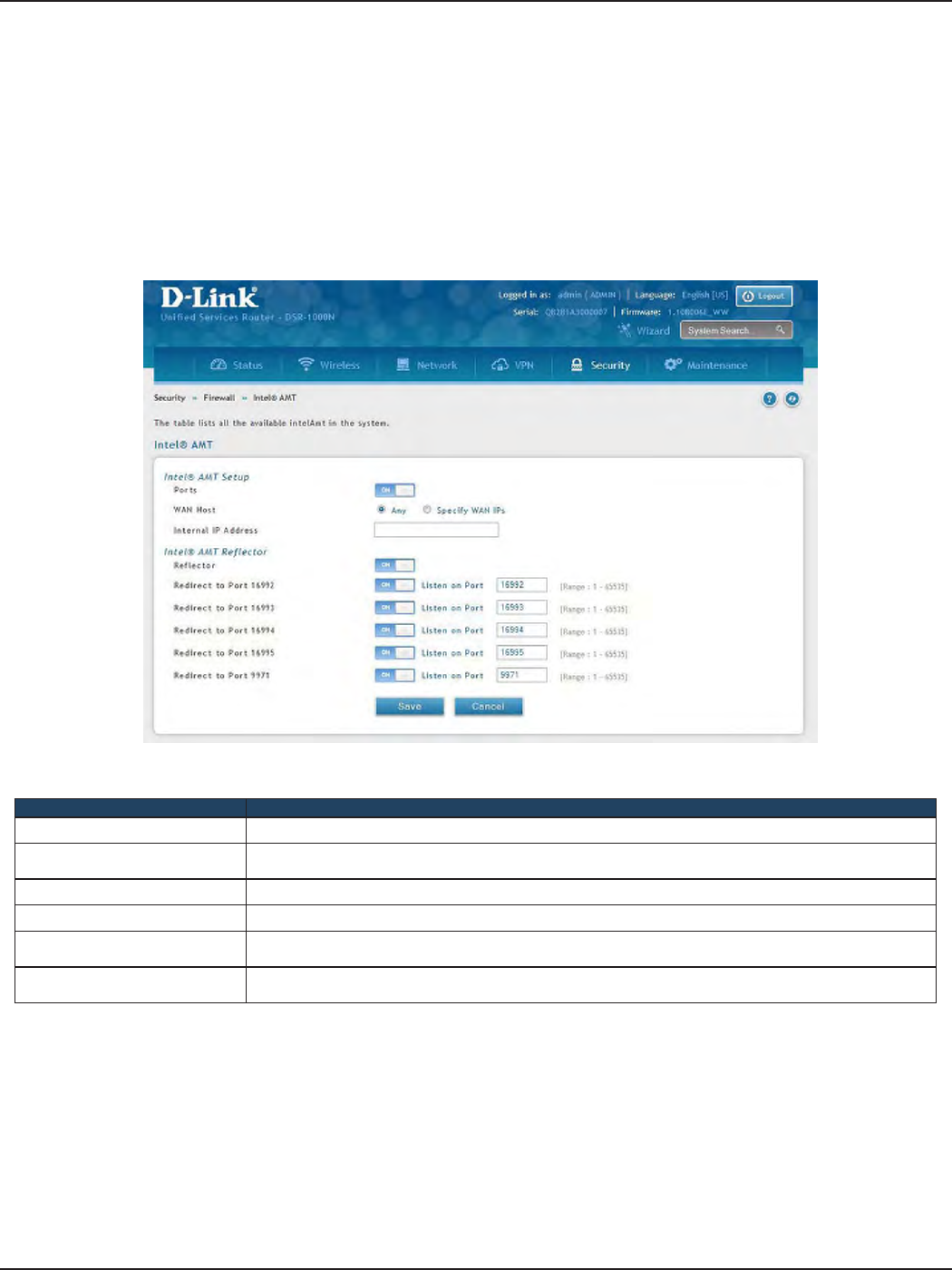
D-Link DSR-Series User Manual 159
Section 8 - Security
Intel® AMT
Path: Security > Firewall > Intel® AMT
Intel® Active Management Technology (AMT) allows you to remotely access and manage every networked
device, even those that lack a working operating system or hard drive, or are turned o as long as the computer
is connected to line power and to the network. Intel AMT uses a separate management processor that runs
independently on the client machine and can be reached through the wired or wireless network.
1. Click Security > Firewall > Intel AMT.
2. Complete the elds from the table below and click Save.
Field Description
Ports When enabled, inbound/outbound rewall rules are added for certain ports to enable Intel AMT service.
WAN Host Select ANY to allow all hosts access or select Specify WAN IPs and enter IP addresses of hosts (separate
with a comma) you want to grant access to. Do not use spaces.
Internal IP Address Enter the LAN IP address.
Reector Toggle to ON to enable Reector. This will send data back to the client on selected ports.
Redirect to Port 16992-16995 Toggle to ON to use the selected port. Enter the listening port on which the server will listen for incoming
connections.
Redirect to Port 9971 Toggle to ON to use the selected port. Enter the listening port on which the server will listen for incoming
connections.
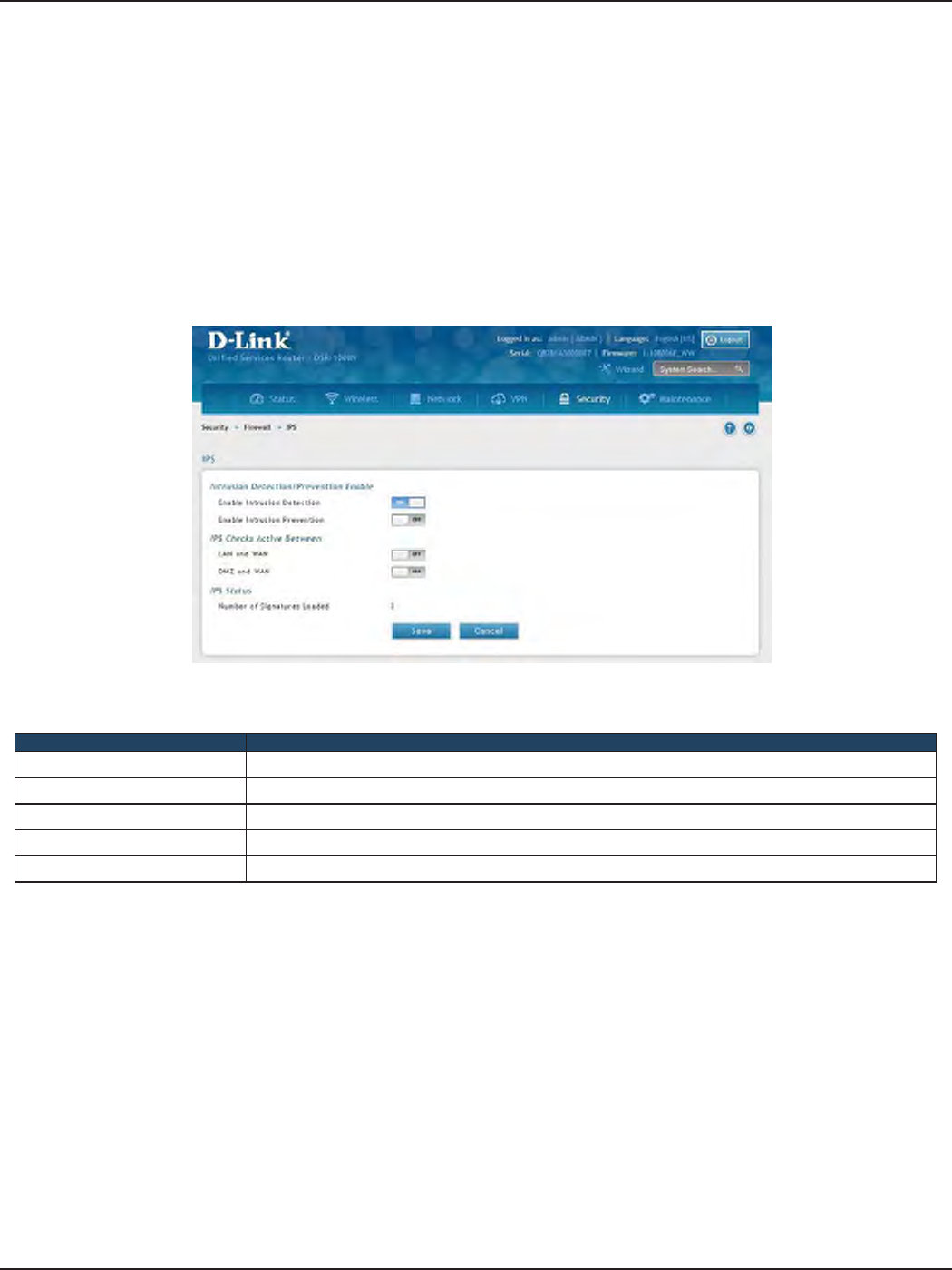
D-Link DSR-Series User Manual 160
Section 8 - Security
IPS
Path: Security > Firewall > IPS
The router’s Intrusion Prevention System (IPS) prevents malicious attacks from the internet from accessing
the private network. Static attack signatures loaded to the router allow common attacks to be detected and
prevented. The checks can be enabled between the WAN and DMZ or LAN, and a running counter will allow the
administrator to see how many malicious intrusion attempts from the WAN have been detected and prevented.
Note: The DSR-150/150N routers do not support Intrusion Prevention System.
1. Click Security > Firewall > IPS.
2. Complete the elds from the table below and click Save.
Field Description
Enable Intrusion Detection Toggle to ON to enable intrusion detection.
Enable Intrusion Prevention Toggle to ON to enable intrusion prevention.
LAN and WAN Toggle to ON to detect intrusions between the LAN and WAN interfaces.
DMZ and WAN Toggle to ON to detect intrusions between the DMZ and WAN interfaces.
Number of Signatures Loaded Displays the number of signatures loaded.
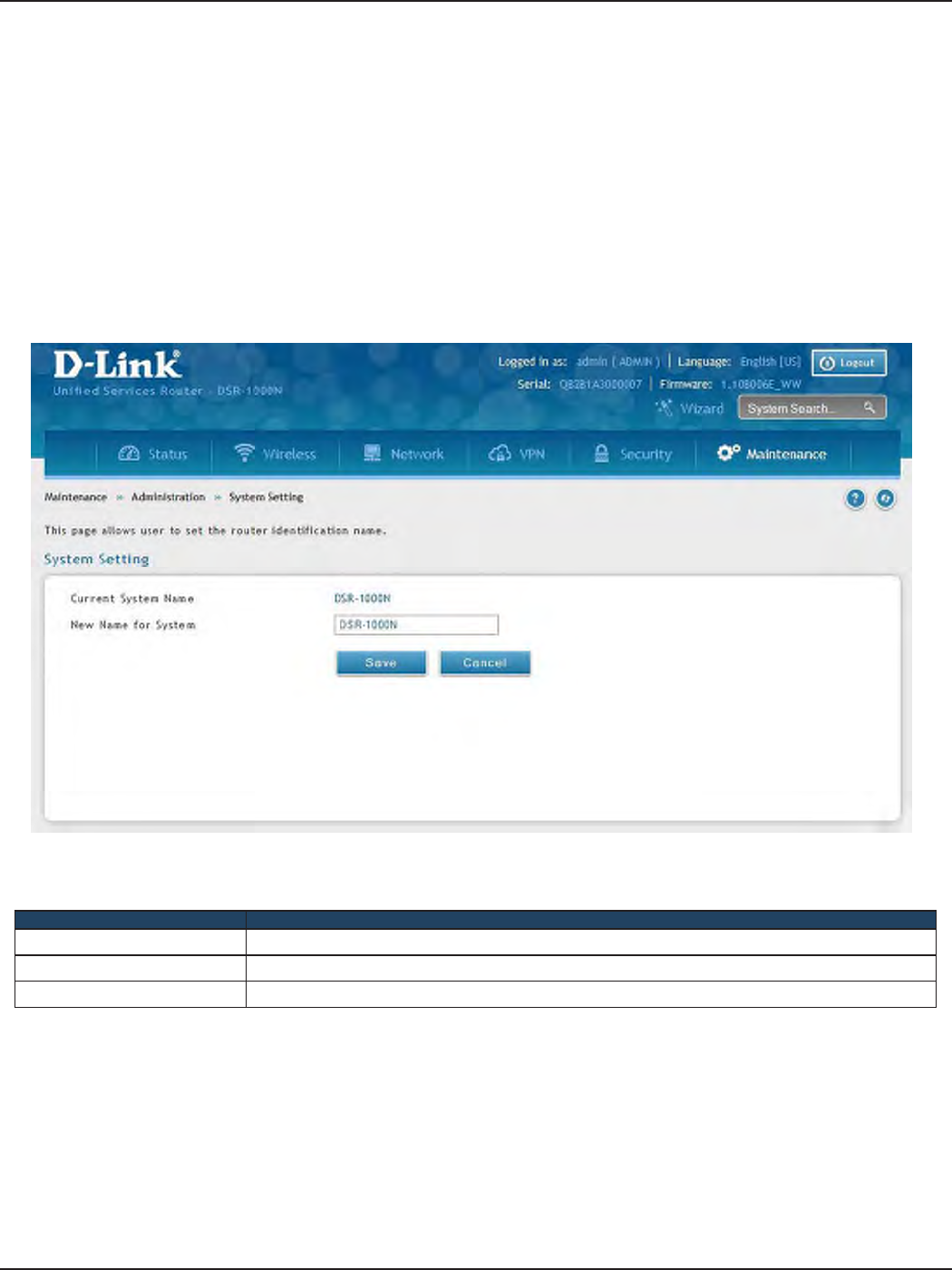
D-Link DSR-Series User Manual 161
Section 9 - Maintenance
System Settings
Path: Maintenance > Administration > System Setting
You may change the name of the router here.
1. Click Maintenance > Administration > System Setting.
Maintenance
2. Complete the elds from the table below and click Save.
Field Description
Current System Name Displays the current name for the router.
New Name for System Enter a new name for the router.
Save Click to save and activate your settings.
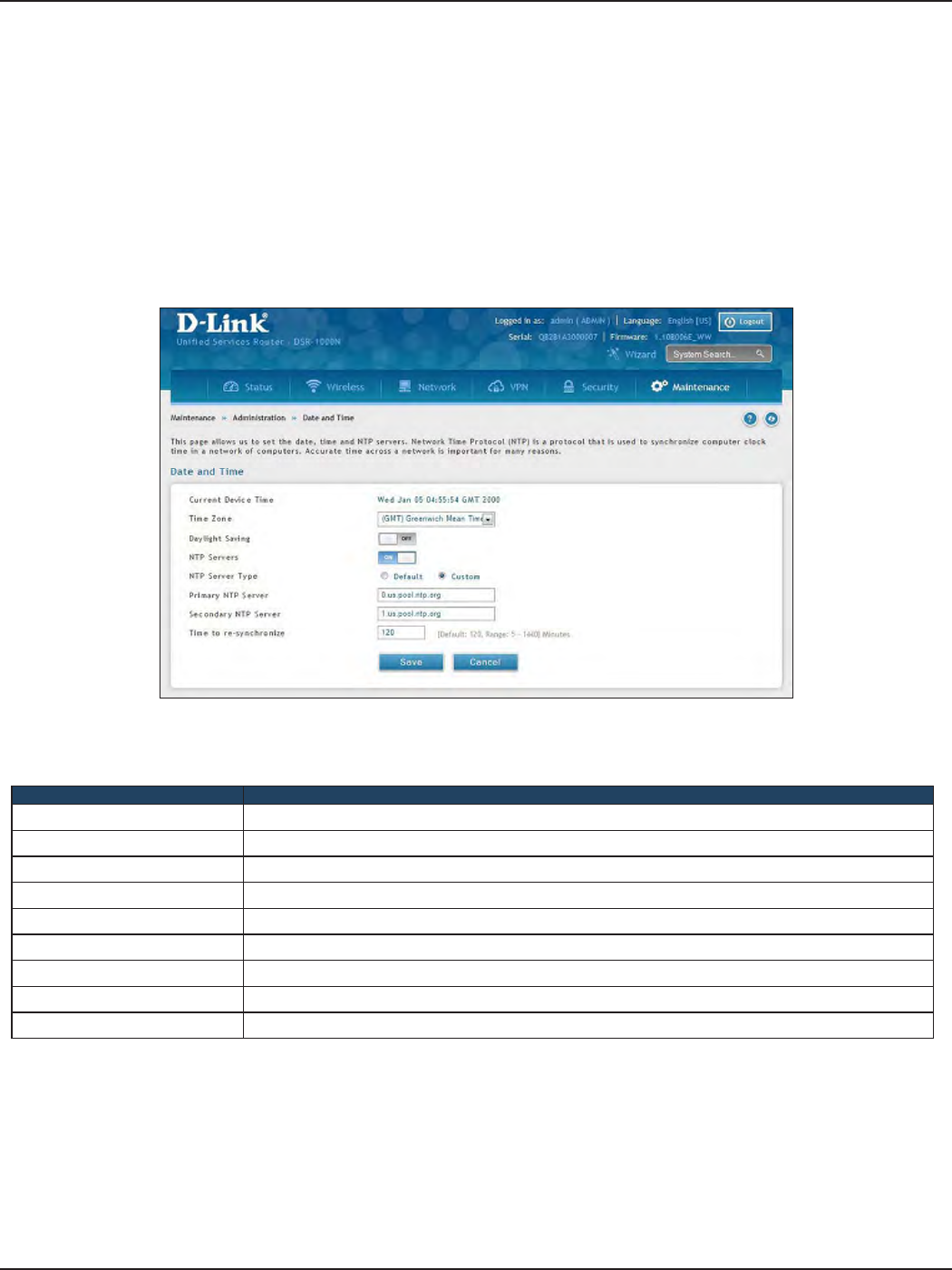
D-Link DSR-Series User Manual 162
Section 9 - Maintenance
Date and Time
Path: Maintenance > Administration > Date and Time
You can congure your time zone, whether or not to adjust for Daylight Savings Time, and with which Network
Time Protocol (NTP) server to synchronize the date and time. You can choose to set Date and Time manually,
which will store the information on the router’s real time clock (RTC). If the router has access to the internet, the
most accurate mechanism to set the router time is to enable NTP server communication.
1. Click Maintenance > Administration > Date and Time.
2. Complete the elds from the table below and click Save.
Field Description
Current Device Time Displays the current date and time on the router.
Time Zone Select your time zone from the drop-down menu.
Daylight Saving Toggle to ON to enable daylight saving time.
NTP Servers Toggle to ON to use NTP servers on the Internet.
NTP Server Type Select either Default or Custom to enter specic NTP Server addresses.
Primary NTP Server If you selected Custom, enter the primary NTP server address.
Secondary NTP Server If you selected Custom, enter the secondary NTP server address.
Time to re-synchronize Enter the time in minutes for the router to re-synch with the NTP server(s).
Save Click to save and activate your settings.
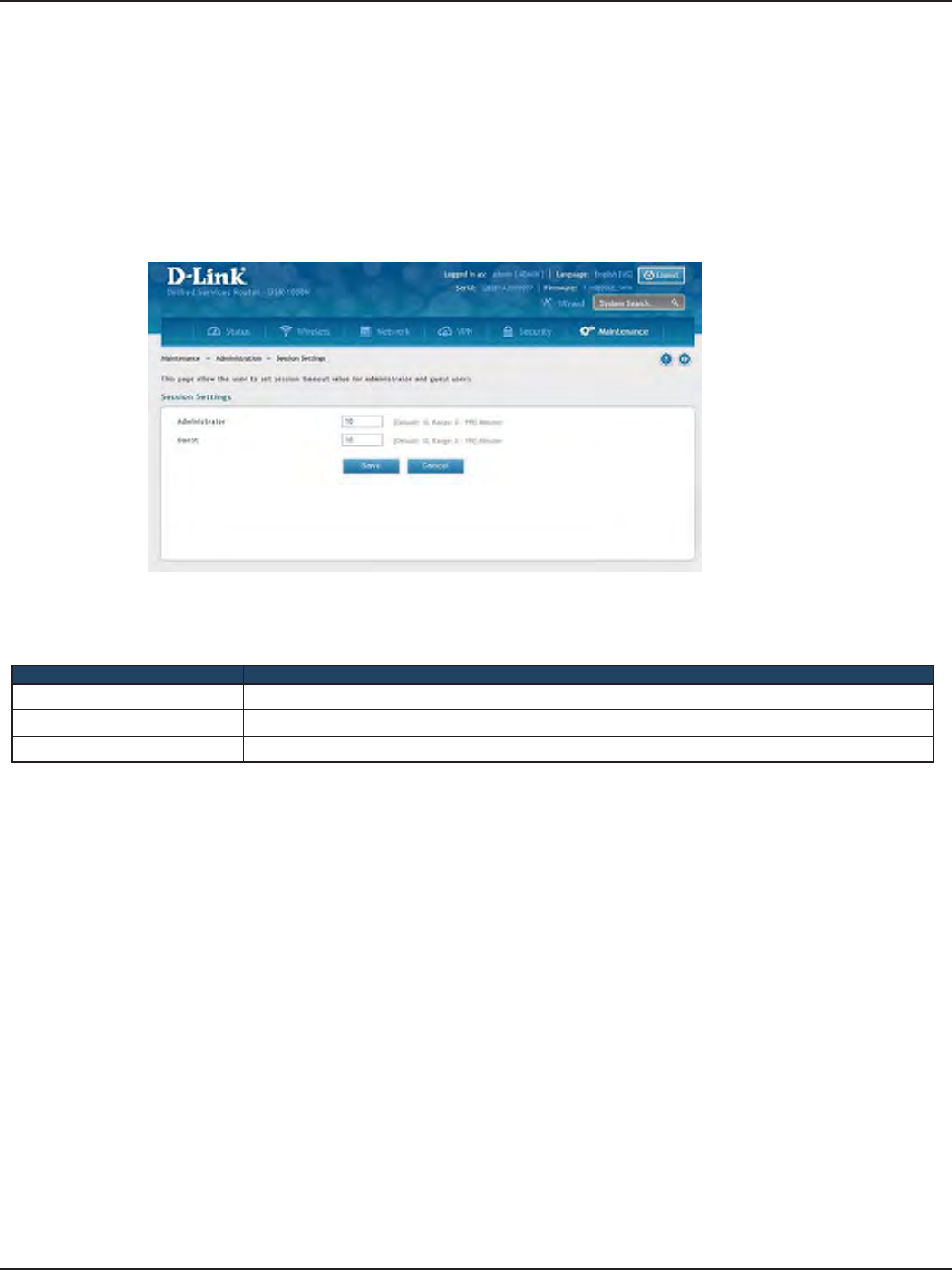
D-Link DSR-Series User Manual 163
Section 9 - Maintenance
Session Settings
Path: Maintenance > Administration > Session Settings
Here you can set the timeout value for admin and guest logins.
1. Click Maintenance > Administration > Session Settings.
2. Complete the elds from the table below and click Save.
Field Description
Administrator Enter the timeout value in minutes for the Administrator account.
Guest Enter the timeout value in minutes for the Guest account.
Save Click to save and activate your settings.
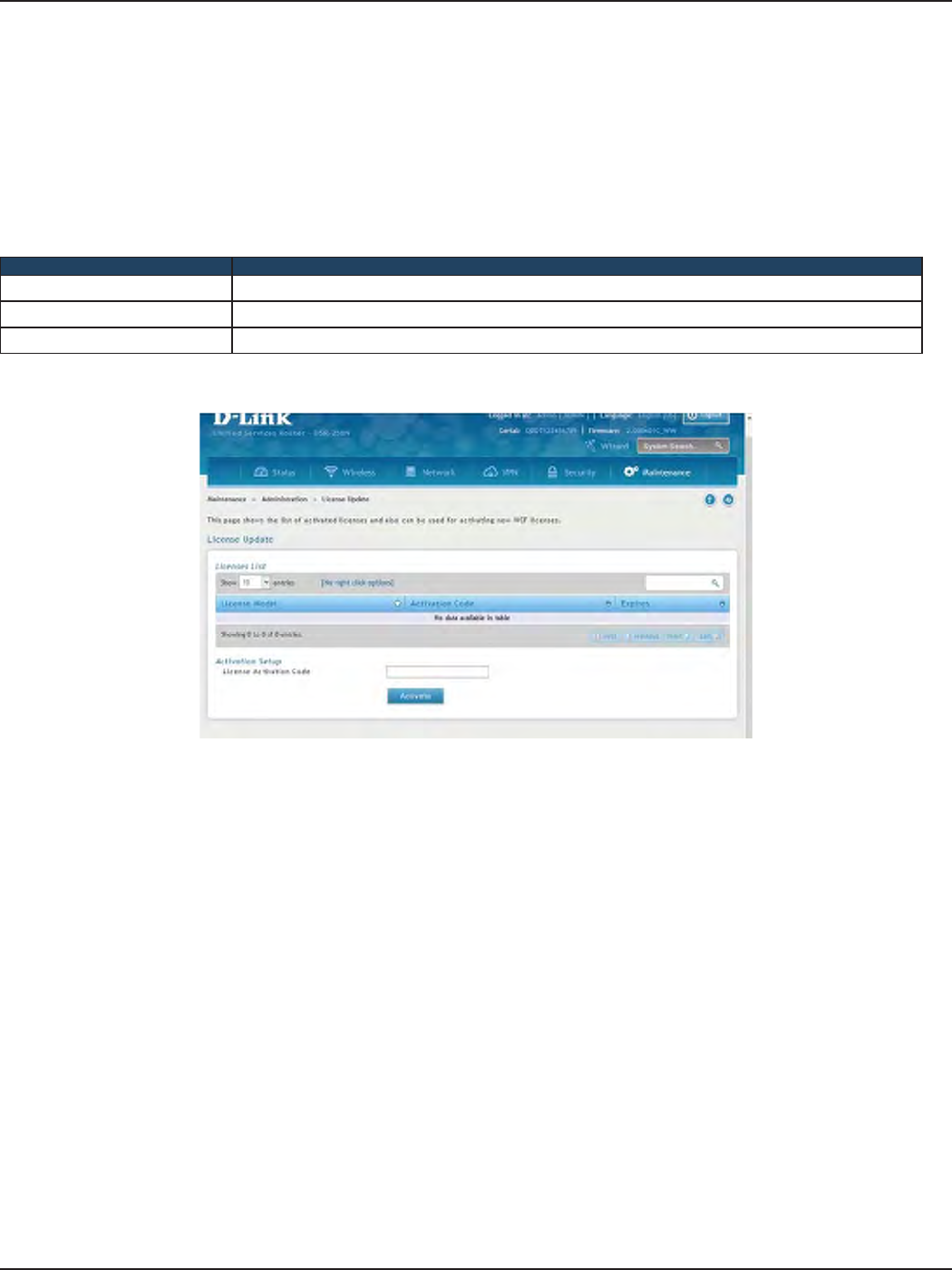
D-Link DSR-Series User Manual 164
Section 8 - Security
License Updates
Path: Maintenance > Administration > License Update
Certain features can be added to the router by purchasing a license key. An activation code is provided based on
the router’s MAC Address, so it will be unique to that particular device.
Each license has the following three parameters:
Field Description
Model The license model as it relates to the feature being added.
Activation Code The activation code corresponding to this license.
Expiration Licenses can either have a xed duration, or are perpetual for the life of this router.
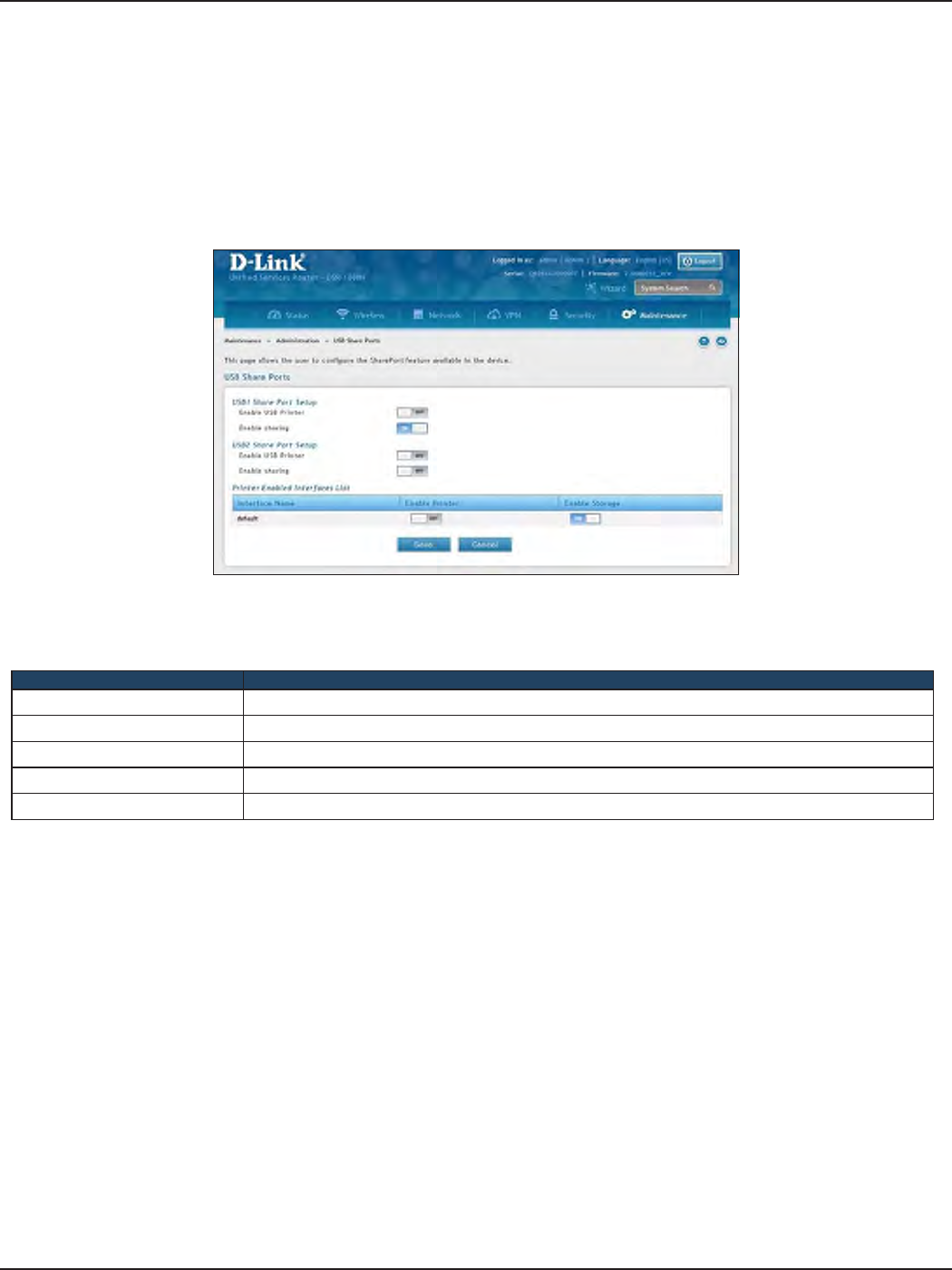
D-Link DSR-Series User Manual 165
Section 9 - Maintenance
USB Share Ports
Path: Maintenance > Administration > USB Share Ports
This page allows congure the SharePort feature available on this router.
1. Click Maintenance > Administration > USB Share Ports.
2. Complete the elds from the table below and click Save.
Field Description
USB Port 1 Printer Toggle to ON to enable USB port 1. Once enabled you will need to enter your printer information.
USB Port 2 Printer Toggle to ON to enable USB port 2. Once enabled you will need to enter your printer information.
Interface Name Displays the name of the printer interface.
Enable Printer Displays if the printer is enabled or not. Toggle to ON to enable.
Save Click to save and activate your settings.
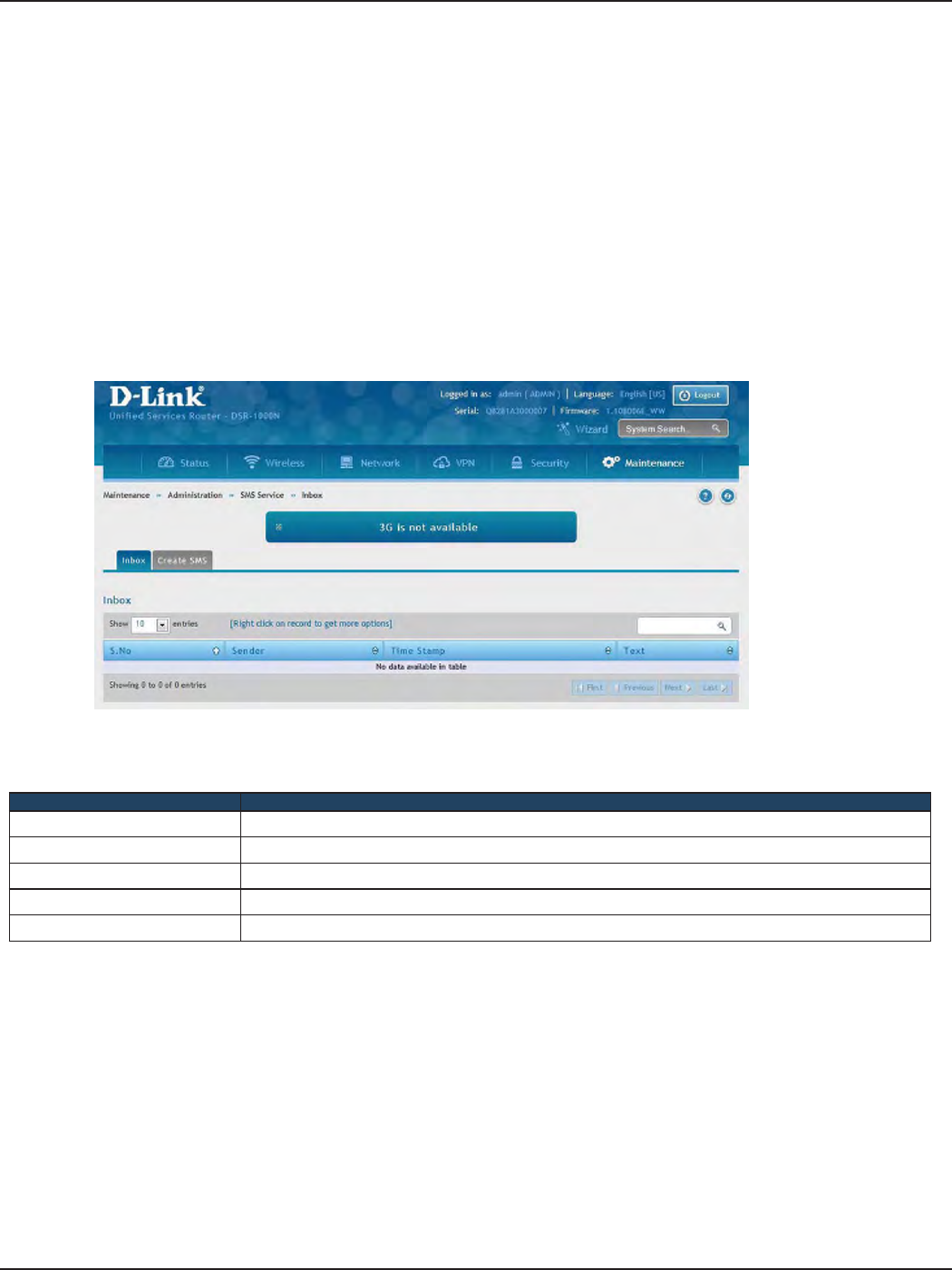
D-Link DSR-Series User Manual 166
Section 9 - Maintenance
SMS Service
Path: Maintenance > Administration > SMS Service > Inbox
The D-Link Services Router has a USB interface to connect 3G modem support to send and receive Short
Messaging Service (SMS). The received messages can be seen in the Inbox and allows the user to create a new
SMS. If WAN3 is used in dedicated WAN mode, load balancing mode, or if the 3G USB device is not connected to
router then the controls on this page will not be available.
To view any incoming messages:
1. Click Maintenance > Administration > SMS Service > Inbox tab.
2. The following details are displayed.
Field Description
S. No Displays the serial number of the message.
Sender Displays the sender of the message.
Time Stamp Displays the time when the message was sent.
Text Displays the content of the message.
Save Click to save and activate your settings.
Inbox
3. Right-click the entry to delete, refresh, reply, or forward the message.
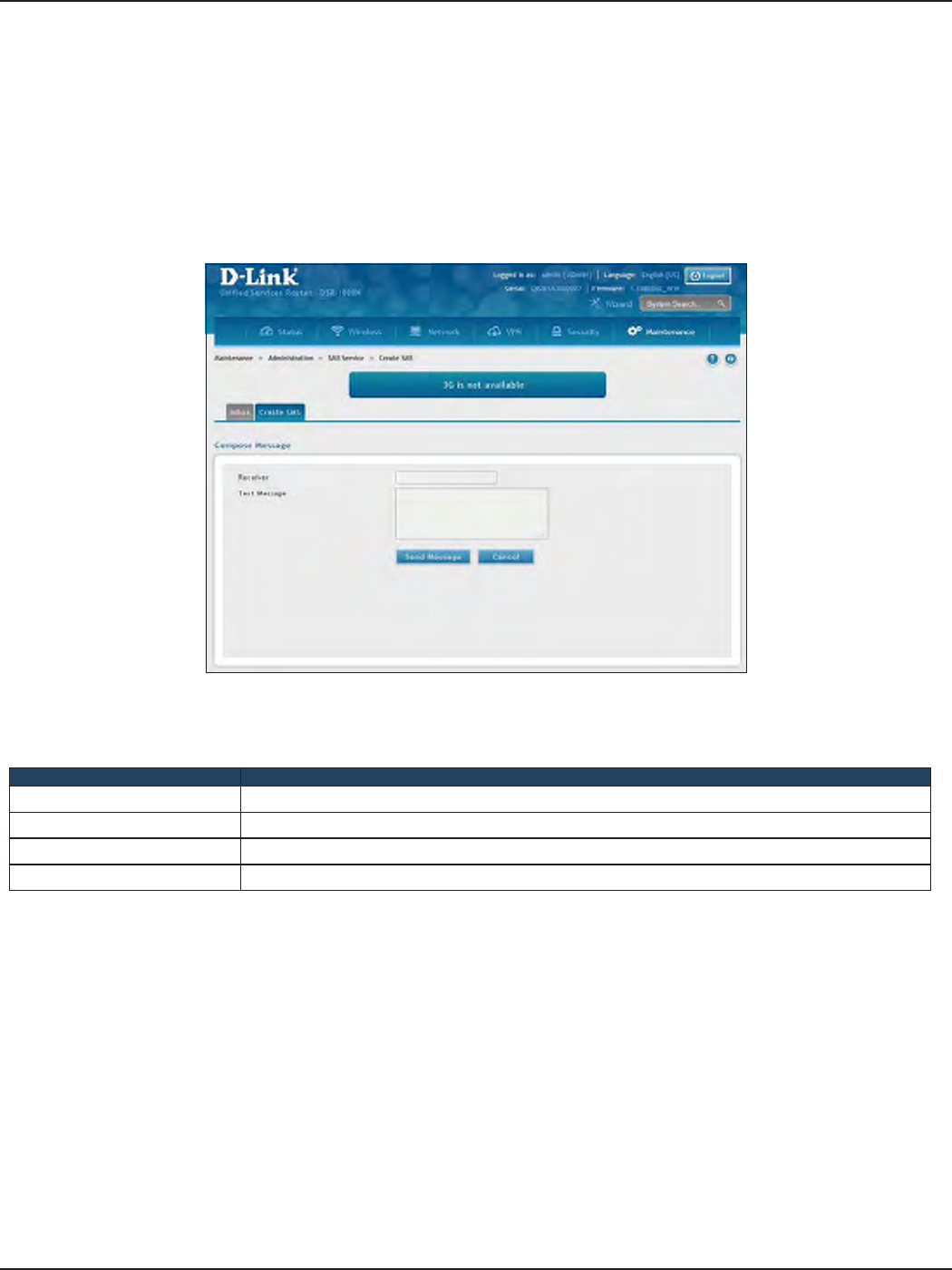
D-Link DSR-Series User Manual 167
Section 9 - Maintenance
Create SMS
Path: Maintenance > Administration > SMS Service> Create SMS
This page allows you to send a message using the SMS service.
1. Click Maintenance > Administration > SMS Service > Create SMS tab.
2. Complete the elds from the table below and click Send Message.
Field Description
Receiver Enter the phone number of the intended receiver.
Text Message Enter the message you want to send.
Send Message Click to send your message.
Cancel Click to reset the elds.
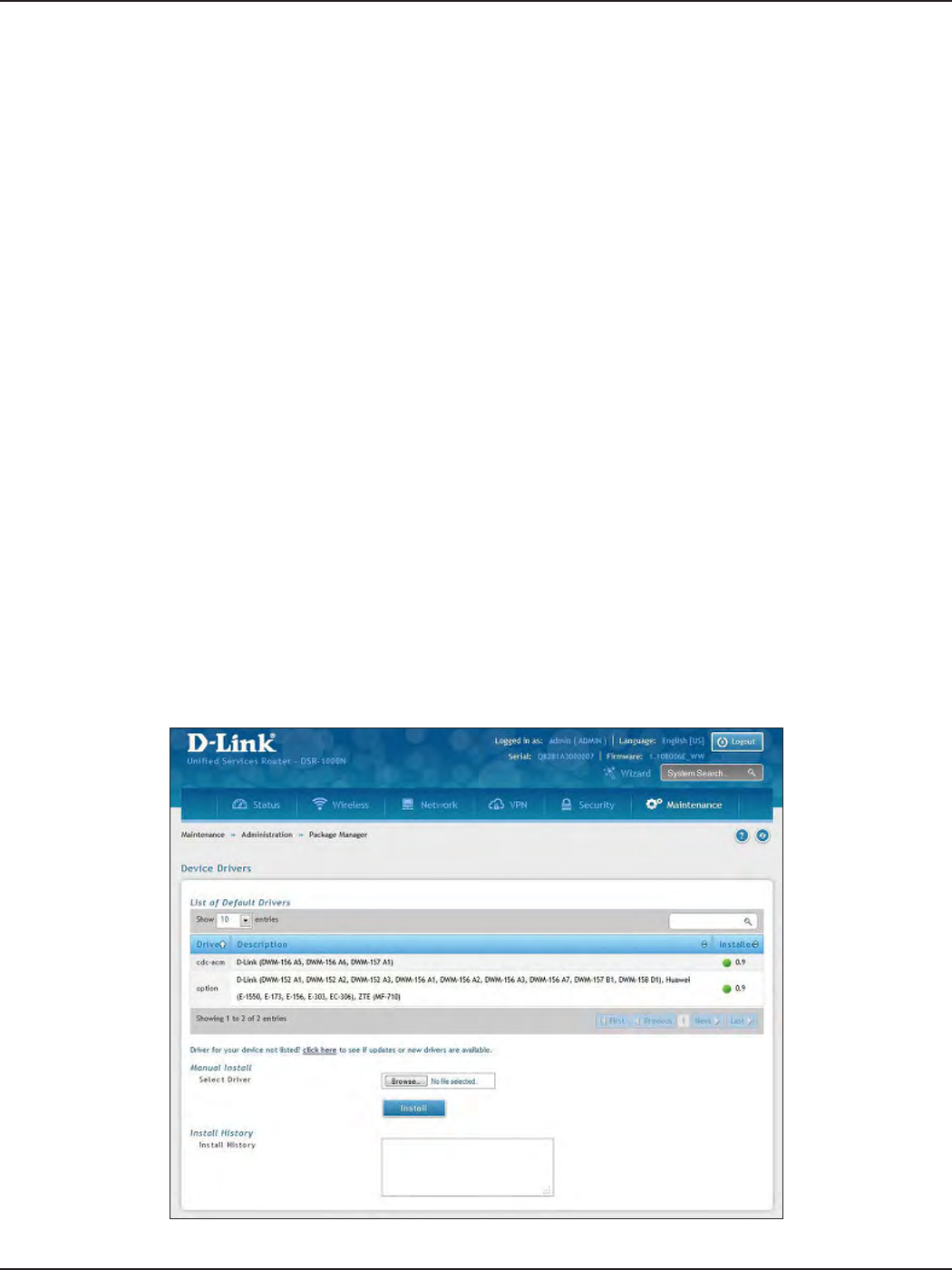
D-Link DSR-Series User Manual 168
Section 9 - Maintenance
Package Manager
Path: Maintenance > Administration > Package Manager
Note: This feature is only supported on the DSR-1000, DSR-1000N, DSR-500, and DSR-500N routers.
A package is a set of les which are installed by the router from D-Link’s repositories. This feature allows users
to download new drivers for supported USB devices and language packs to enable multi-lingual support for
the router’s management interface. Multi-lingual support via the package manager allows the user to choose
a language of choice so that the entire textual content in the router’s user interface is presented in the selected
language.
This feature supports a single driver and single language pack to be stored in the router (i.e. these les are
available for use after device reboot) . There are 2 types of installations supported by this feature:
1. Manual Installation: Upon selecting manual installation, the user has to download the
package which will then display the available languages that the router GUI now supports.
Note: Only drivers provided by D-Link can be used for manual installation. A validation process will
be performed during installation.
2. Auto Installation: By selecting the link “click here” the auto-installation of the package is
exercised. A page showing the list of available drivers / language packs is displayed from which
the user can select and install one of the options. For this type of installation the router must be
able to access the internet, as this will allow the user to download the package from a repository
server which consists of all the available languages.
1. Click Maintenance > Administration > Package Manager.

D-Link DSR-Series User Manual 169
Section 9 - Maintenance
Field Description
List of Default Drivers Displays the default drivers that are installed.
Click Here Click to display a list of available packages for download. You must be connected to the Internet. Here you
can select the driver to update or install.
Manual Install If you have downloaded a packed, click Browse and select the package. Click Open and then click Install.
Install History Displays a list of package installations.
2. Complete the elds from the table below.
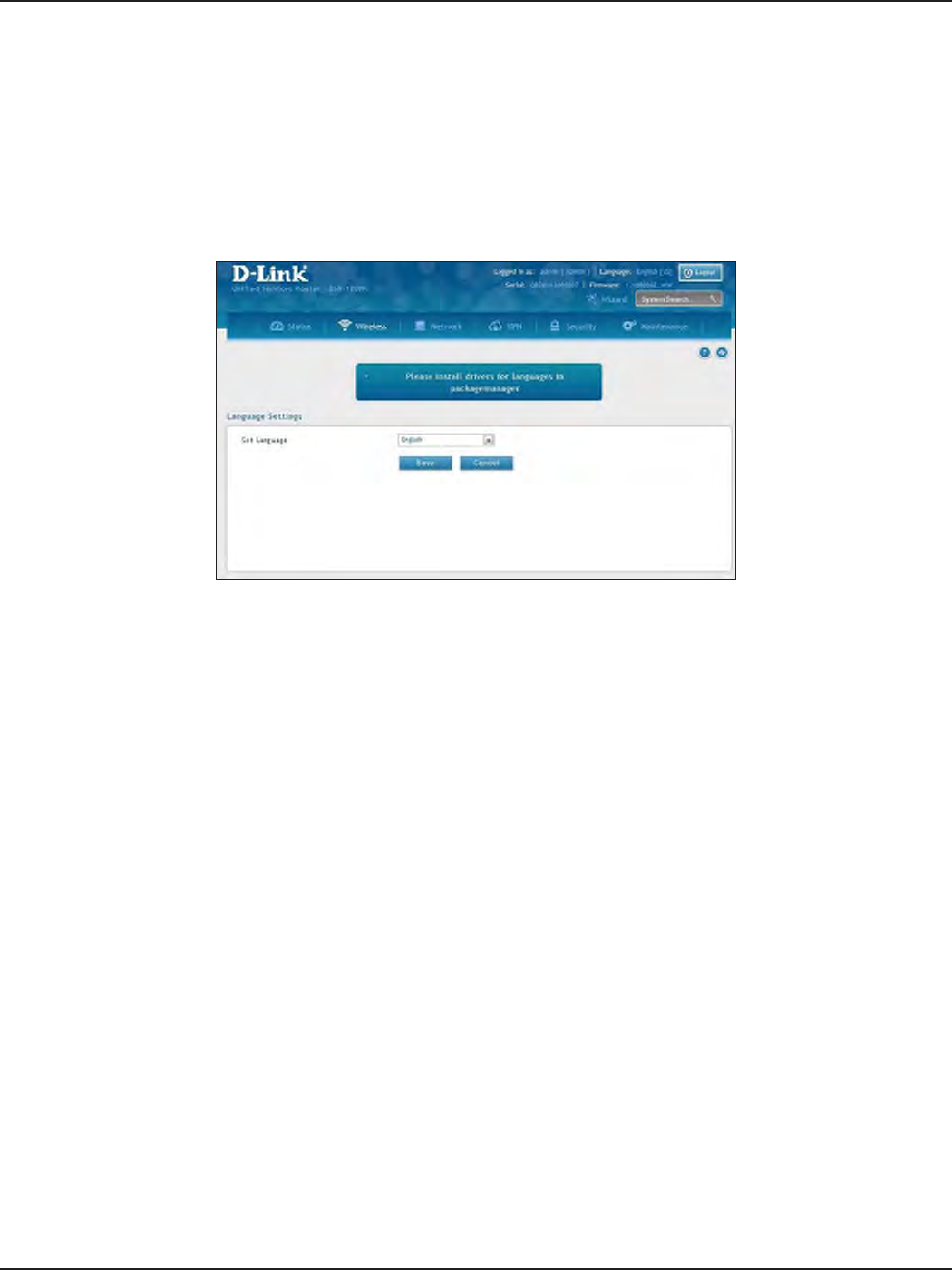
D-Link DSR-Series User Manual 170
Section 9 - Maintenance
Path: Maintenance > Administration > Set Language
You can download language packs (refer to “Package Manager” on page 168) and install them on the router. Once
you have downloaded a pack, follow the steps below to install:
1. Click Maintenance > Administration > Set Language.
2. Select a loaded language pack from the drop-down menu and click Save.
Set Language
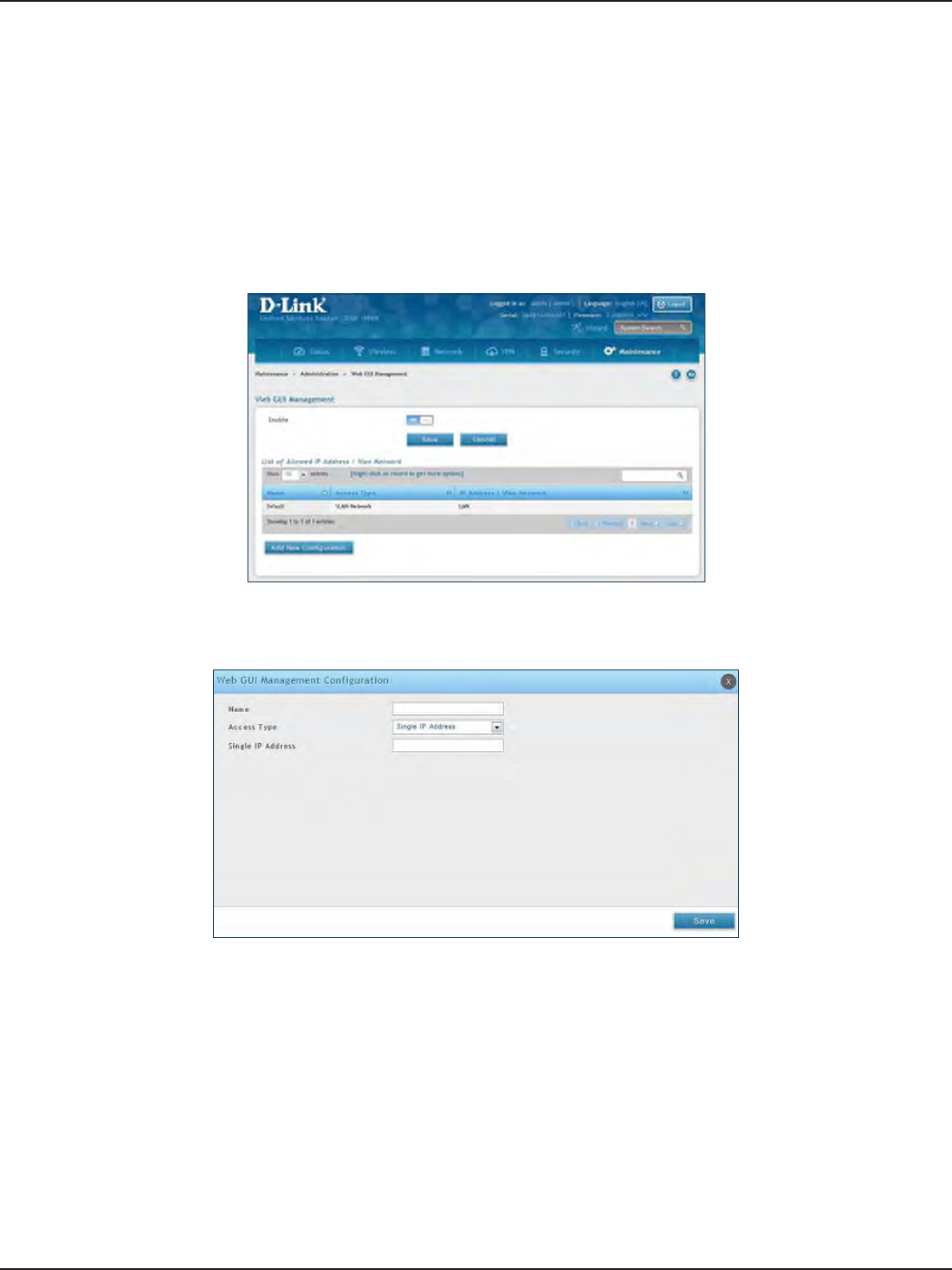
D-Link DSR-Series User Manual 171
Section 9 - Maintenance
Web GUI Management
Path: Maintenance > Administration > Web GUI Management
The Web GUI Management page will allow you to specify by IP address or VLAN what users can congure the
router using the web GUI.
1. Click Maintenance > Administration > Web GUI Management.
2. Toggle Enable to ON and click Save.
3. Click Add New Conguration.
4. Enter a name for this conguration.
5. Select either Single IP Address and enter the IP address of the computer/device or VLAN Network
and enter the VLAN ID that you want to allow access to the web GUI.
6. Click Save.
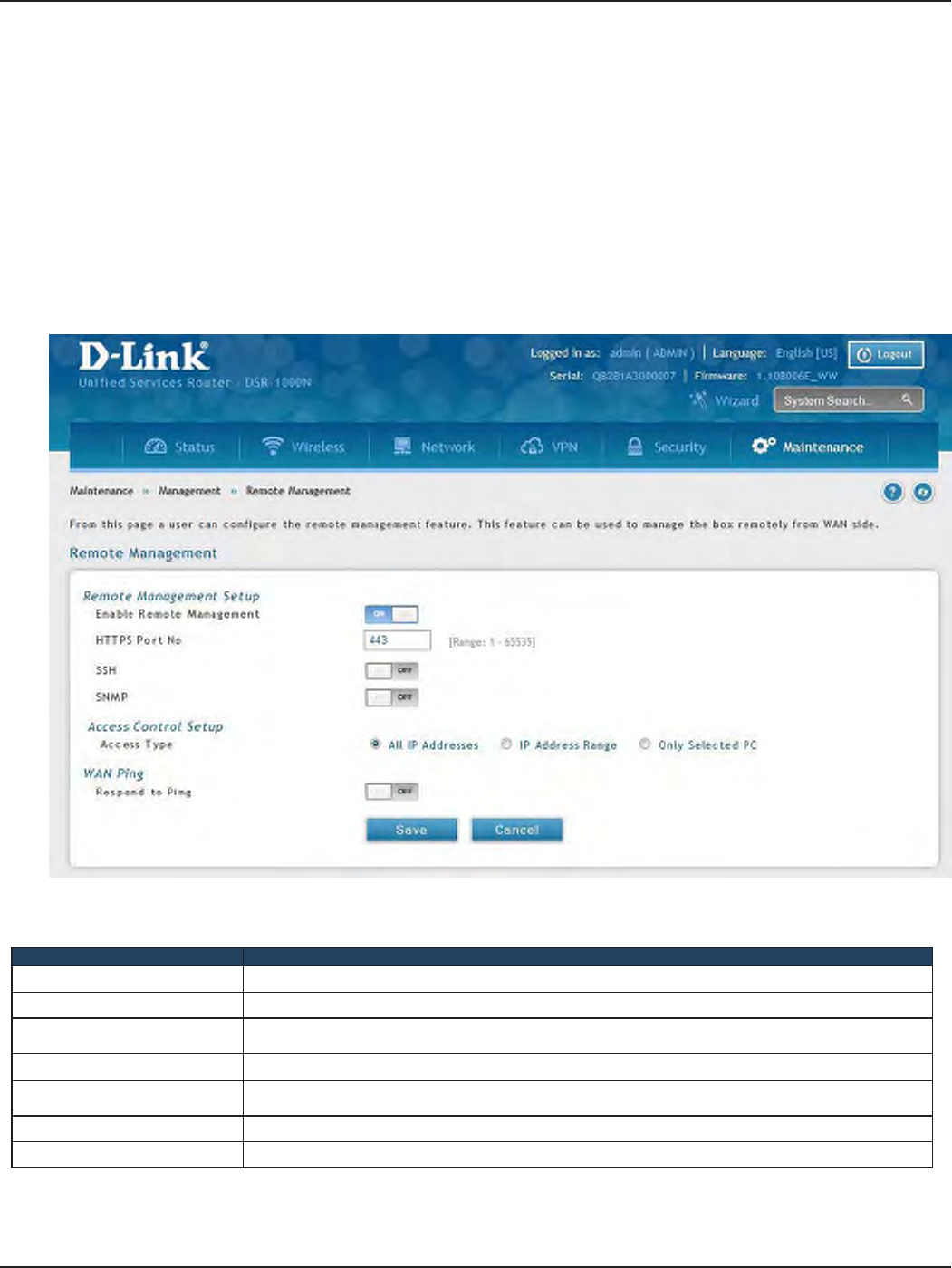
D-Link DSR-Series User Manual 172
Section 9 - Maintenance
Remote Management
Path: Maintenance > Management > Remote Management
Enable this feature to be able to manage the router from a remote location, using HTTPS or Telnet. Both HTTPS
and Telnet access can be restricted to a subset of IP addresses. The router administrator can dene a known PC,
single IP address or range of IP addresses that are allowed to access the GUI with HTTPS. The opened port for SSL
trac can be changed from the default of 443 at the same time as dening the allowed remote management IP
address range.
1. Click Maintenance > Management > Remote Management.
2. Complete the elds from the table below and click Save.
Field Description
Enable Remote Management Toggle to ON to enable remote management.
HTTPS Port No. Enter the port for HTTPS access. The default port is 443.
SSH Toggle ON to enable SSH (Secure Shell) protocol which can be used to access the CLI over the network
from a remote host.
SNMP Toggle to ON to enable SNMP for remote management.
Access Type Select either All IP Addresses, IP Address Range (enter an IP range), or Only Selected PC (enter an IP
address).
Respond to Ping Toggle to ON to allow the router to respond to ping requests from the WAN.
Save Click to save and activate your settings.
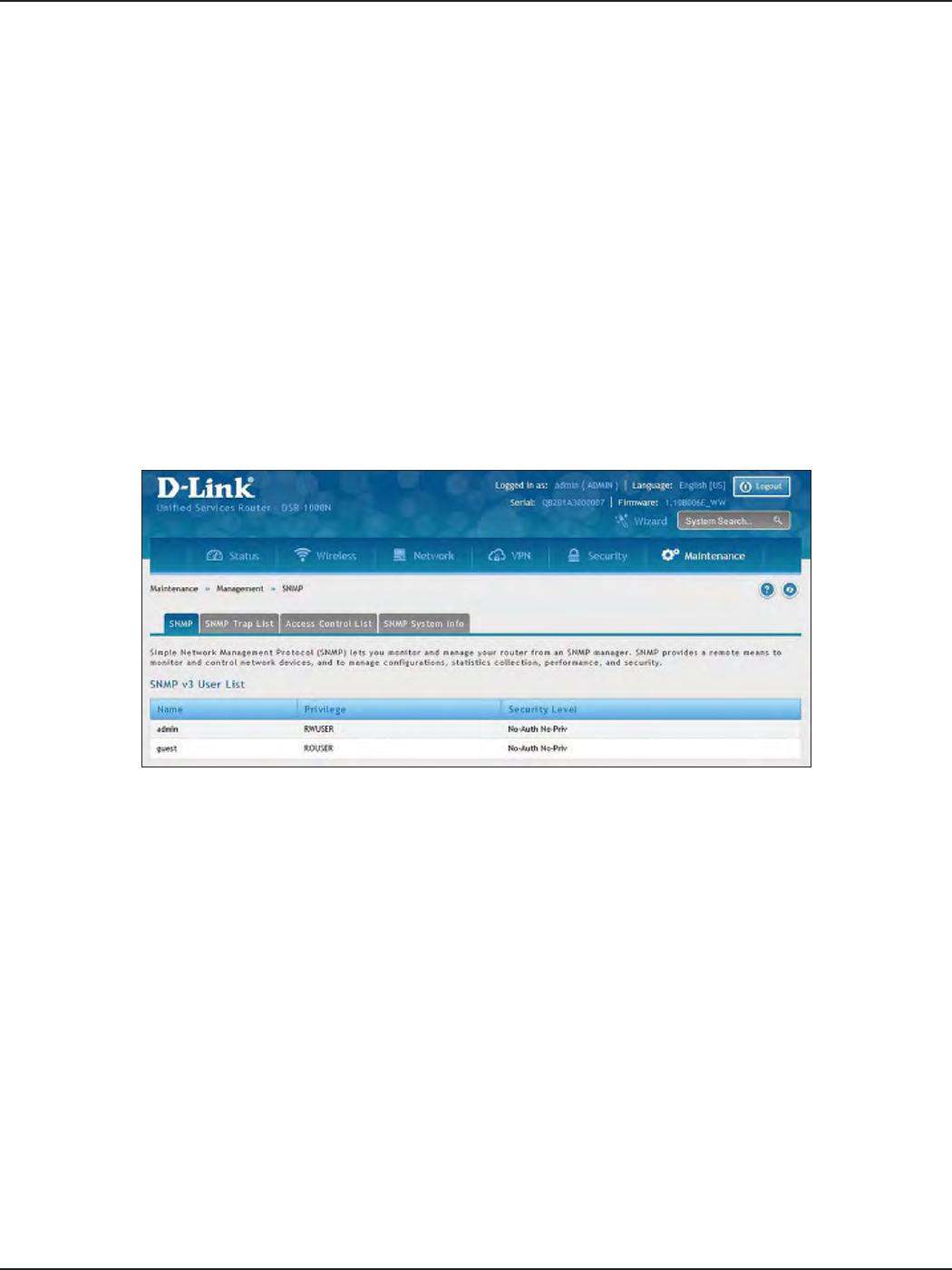
D-Link DSR-Series User Manual 173
Section 9 - Maintenance
SNMP
Path: Maintenance > Management > SNMP
SNMP is an additional management tool that is useful when multiple routers in a network are being managed by
a central Master system. When an external SNMP manager is provided with this router’s Management Information
Base (MIB) le, the manager can update the router’s hierarchal variables to view or update conguration
parameters. The router as a managed device has an SNMP agent that allows the MIB conguration variables
to be accessed by the Master (the SNMP manager). The Access Control List on the router identies managers
in the network that have read-only or read-write SNMP credentials. The Traps List outlines the port over which
notications from this router are provided to the SNMP community (managers) and also the SNMP version (v1,
v2c, v3) for the trap.
1. Click Maintenance > Management > SNMP > SNMP tab.
SNMP User List
2. Right-click a user and select Edit if you want to change the security level.
3. Select the security level from the drop-down list. Select one of the following:
• No-Auth No-Priv: Only requires a user name match for authentication.
• Auth No-Priv: Provides authentication based on the MD5 or SHA algorithms.
• Auth Priv: Provides authentication based on the MD5 or SHA algorithms as well as encryption
privacy with the DES 256-bit standard.
4. Click Save.
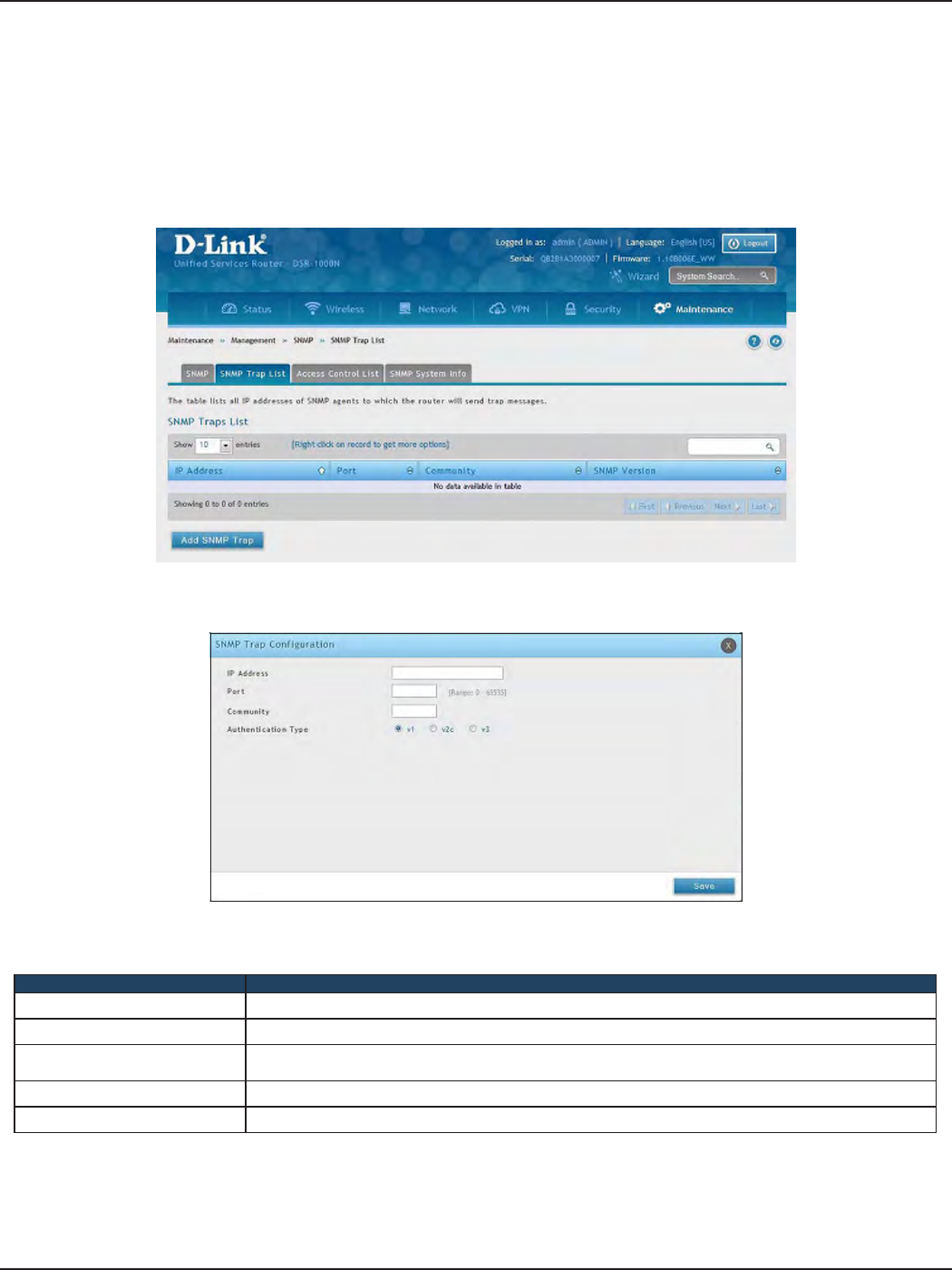
D-Link DSR-Series User Manual 174
Section 9 - Maintenance
Path: Maintenance > Management > SNMP > SNMP Trap List
To create a new SNMP trap:
1. Click Maintenance > Management > SNMP > SNMP Trap List tab.
SNMP Trap List
2. Right-click an entry and select either Edit or Delete. To add a new trap, click Add SNMP Trap.
3. Complete the elds from the table below and click Save.
Field Description
IP Address The IP Address of the SNMP trap agent.
Port The SNMP trap port to which the trap messages will be sent.
Community The community string to which the agent belongs. Most agents are congured to listen for traps in the
Public community.
Authentication Type The SNMP version used by the trap agent. The choices are v1, v2c, or v3.
Save Click to save and activate your settings.
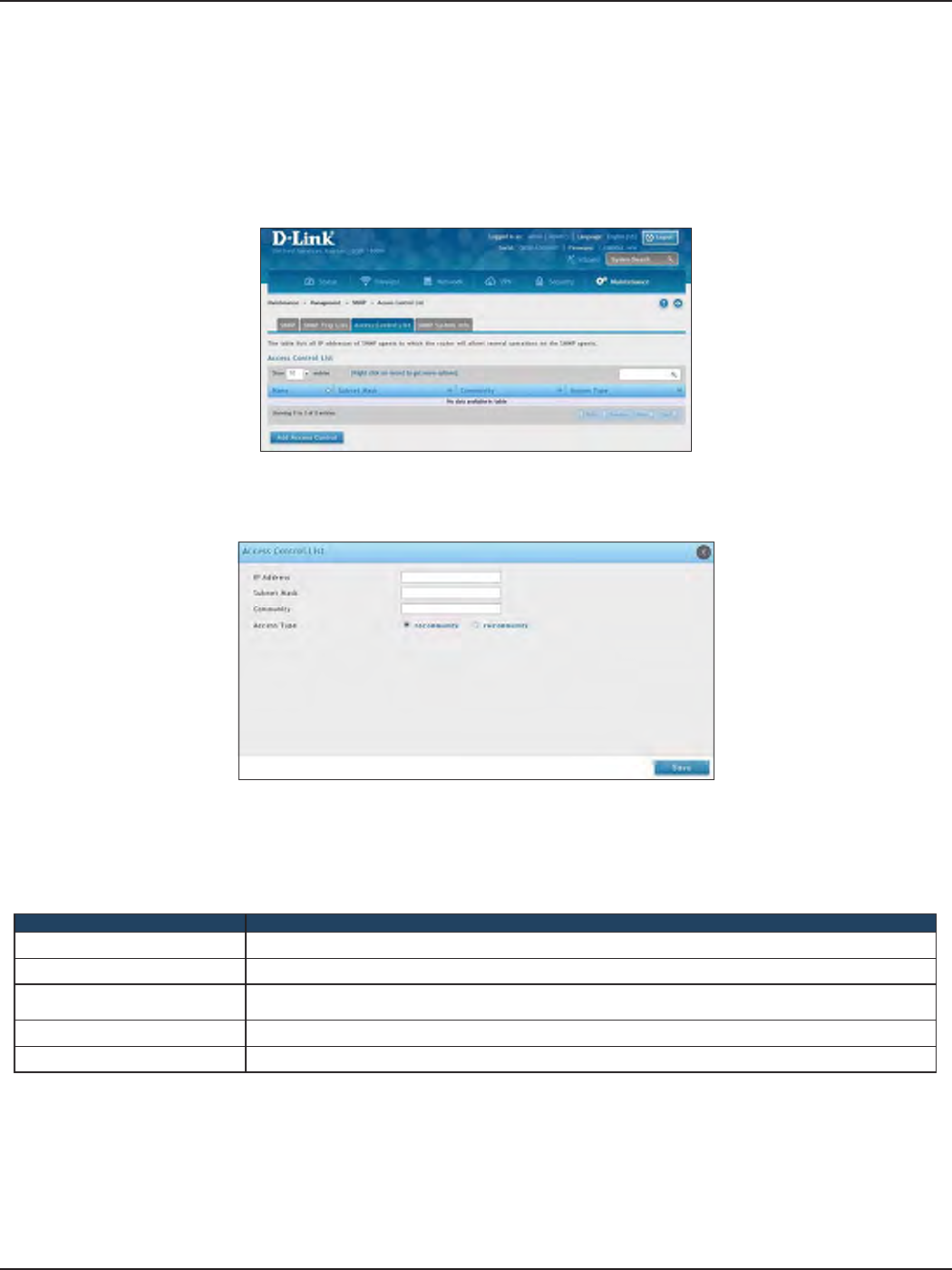
D-Link DSR-Series User Manual 175
Section 9 - Maintenance
Path: Maintenance > Management > SNMP > Access Control List
To edit, delete, or create a new access control entry:
1. Click Maintenance > Management > SNMP > Access Control List tab.
Access Control
2. Right-click an entry and select either Edit or Delete. To add a new trap, click Add Access Control.
3. Complete the elds from the table below and click Save.
Field Description
IP Address The IP Address of the SNMP agent.
Subnet Mask The network mask used to determine the list of allowed SNMP managers.
Community The community string to which the agent belongs. Most agents are congured to listen for traps in the
Public community.
Access Type Access will be either read only (ROcommunity) or read-write (RWcommunity).
Save Click to save and activate your settings.
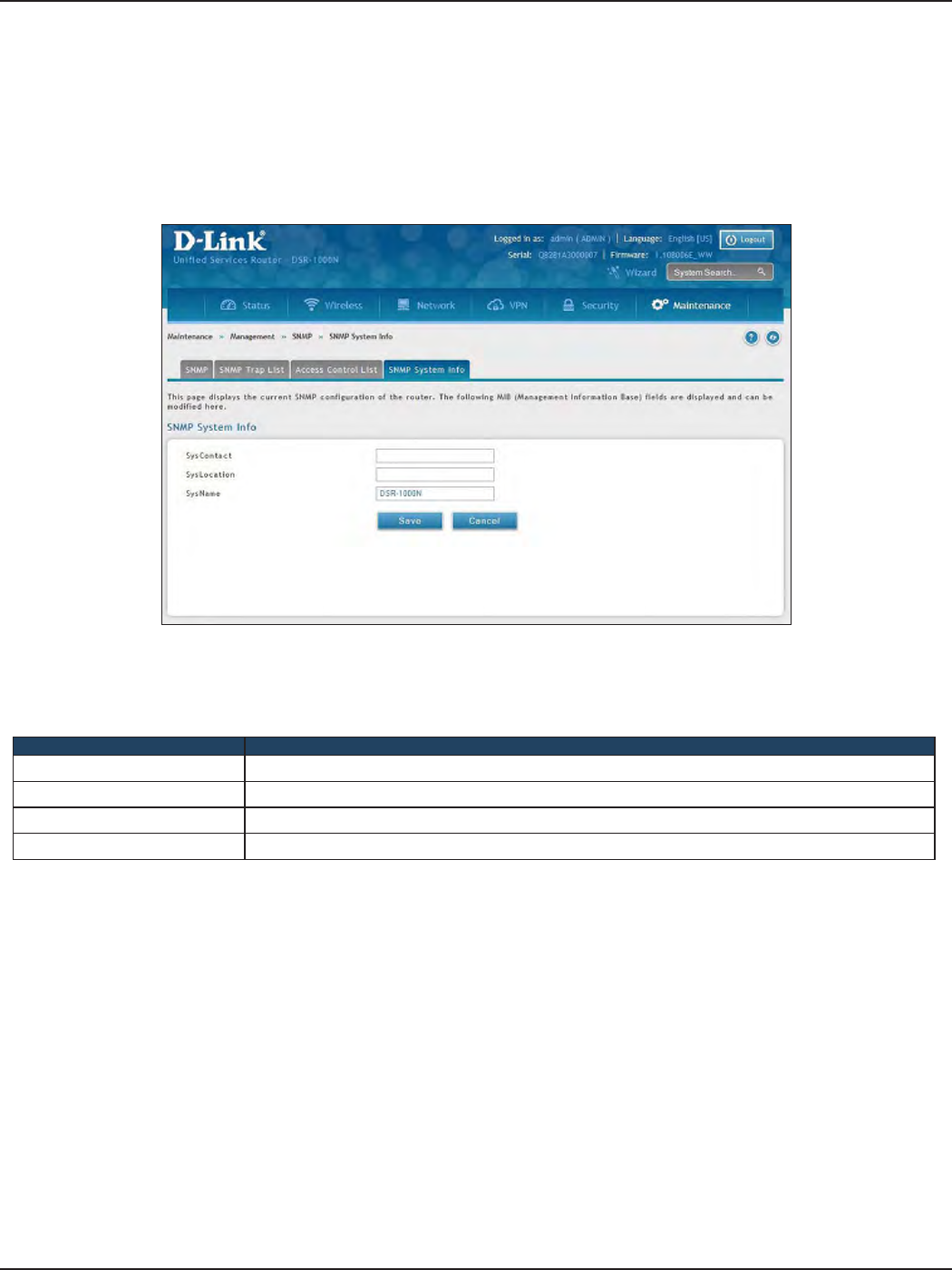
D-Link DSR-Series User Manual 176
Section 9 - Maintenance
Path: Maintenance > Management > SNMP > SNMP System Info
To create a new SNMP trap:
1. Click Maintenance > Management > SNMP > SNMP System Info tab.
SNMP System Info
2. Complete the elds from the table below and click Save.
Field Description
SysContact The name of the contact person for this router. Examples: admin, John Doe.
SysLocation The physical location of the router: Example: Rack #2, 4th Floor.
SysName A name given for easy identication of the router.
Save Click to save and activate your settings.
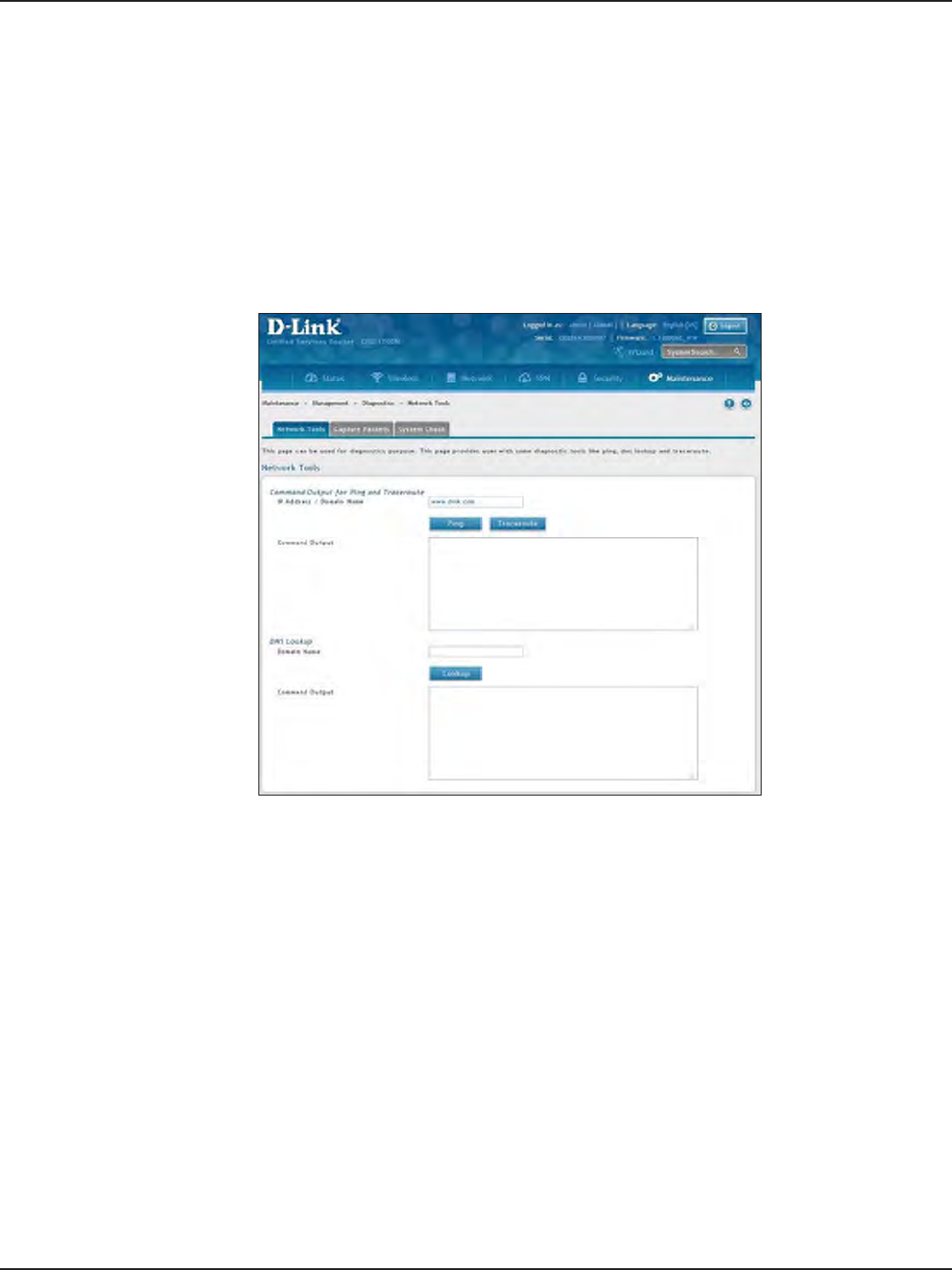
D-Link DSR-Series User Manual 177
Section 9 - Maintenance
Path: Maintenance > Management > Diagnostics > Network Tools
As part of the diagnostics functions on the router, you can ping an IP address or domain name. You can use this
function to test connectivity between the router and another device on the network or the Internet.
1. Click Maintenance > Diagnostics > Network Tools tab.
Diagnostics
Ping an IP Address/Domain Name
2. Under Command Output for Ping and Traceroute, in the IP Address/Domain Name eld, enter an IP
address or domain name.
3. Click Ping. The results will appear in the Command Output display below.
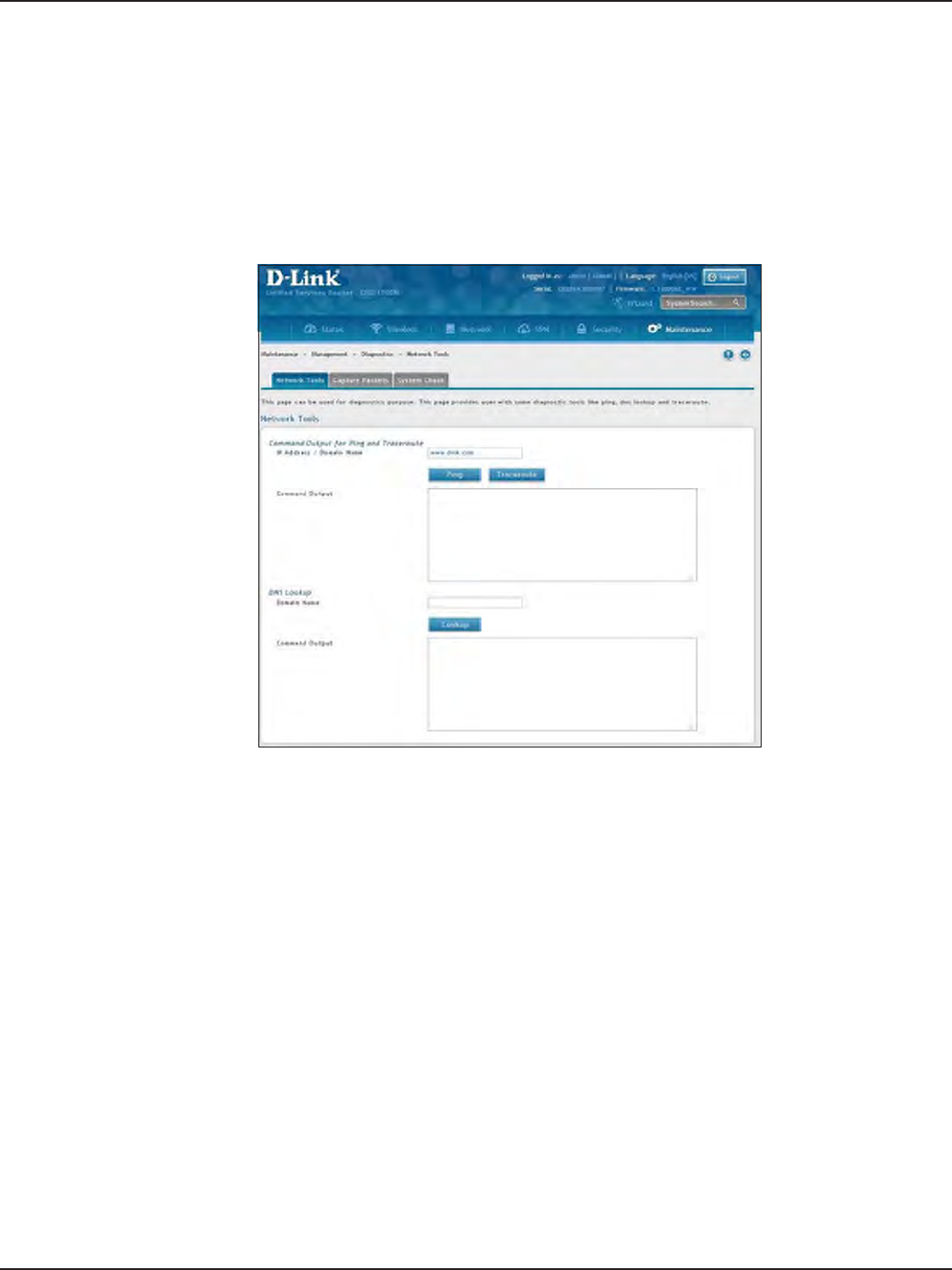
D-Link DSR-Series User Manual 178
Section 9 - Maintenance
Path: Maintenance > Management > Diagnostics > Network Tools
The router provides a Traceroute function that lets you map the network path to a public host. Up to 30 “hops”
between this router and the destination will be displayed.
1. Click Maintenance > Diagnostics > Network Tools tab.
Using Traceroute
2. Under Command Output for Ping and Traceroute, in the IP Address/Domain Name eld, enter an IP
address or domain name.
3. Click Traceroute. The results will appear in the Command Output display below.
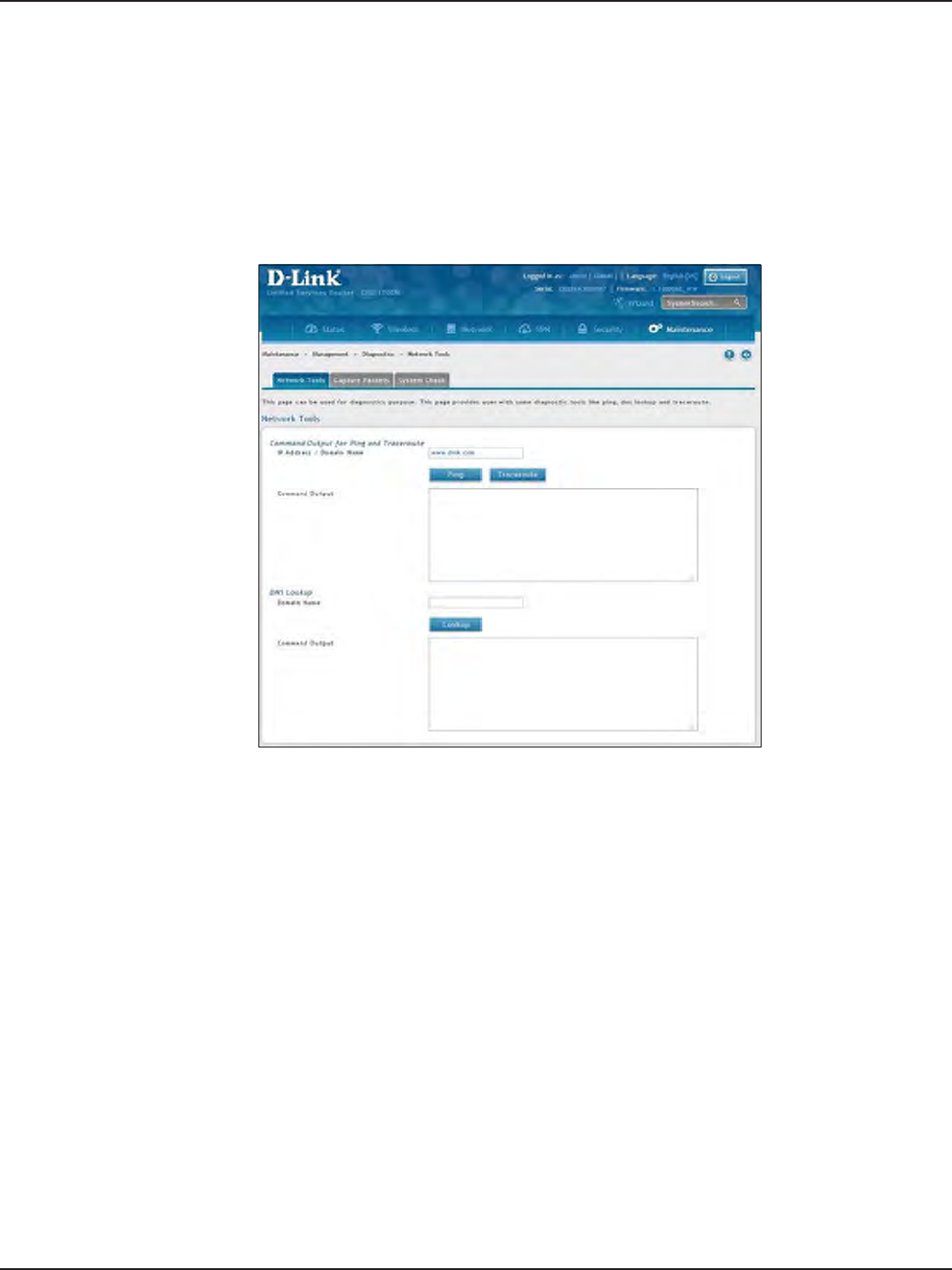
D-Link DSR-Series User Manual 179
Section 9 - Maintenance
Path: Maintenance > Management > Diagnostics > Network Tools
The router provides a DNS lookup function that lets you retrieve the IP address of a Web, FTP, Mail, or any other
server on the Internet.
1. Click Maintenance > Diagnostics > Network Tools tab.
Performing DNS Lookups
2. Under DNS Lookup, in the Domain Name eld, enter an Internet name.
3. Click Lookup. The results will appear in the Command Output display. If the host or domain entry exists,
a response will appear with the IP address. If the message Host Unknown appears, the Internet name
does not exist.
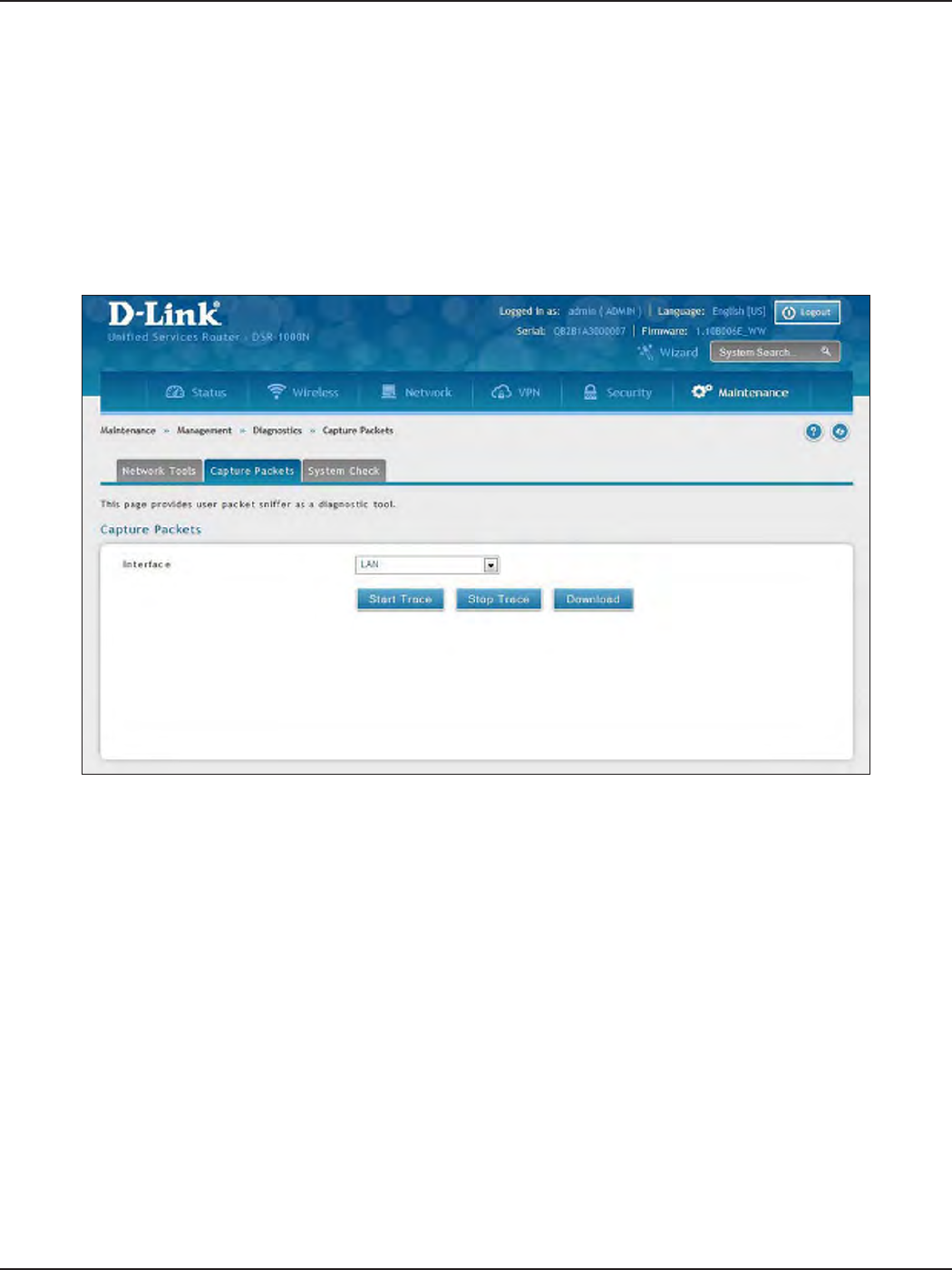
D-Link DSR-Series User Manual 180
Section 9 - Maintenance
Path: Maintenance > Management > Diagnostics > Capture Packets
The router lets you capture all packets that pass through the LAN and WAN interfaces. The packet trace is limited
to 1MB of data per capture session. If the capture le size exceeds 1MB, it is deleted automatically and a new
capture le is created.
1. Click Maintenance > Diagnostics > Capture Packets tab.
Capture Packets
2. Select an interface from the drop-down menu.
3. Click Start Trace. The trace can be downloaded by clicking the Download button, which will
immediately begin the download to the browser’s default download location. To stop the trace click
Stop Trace.
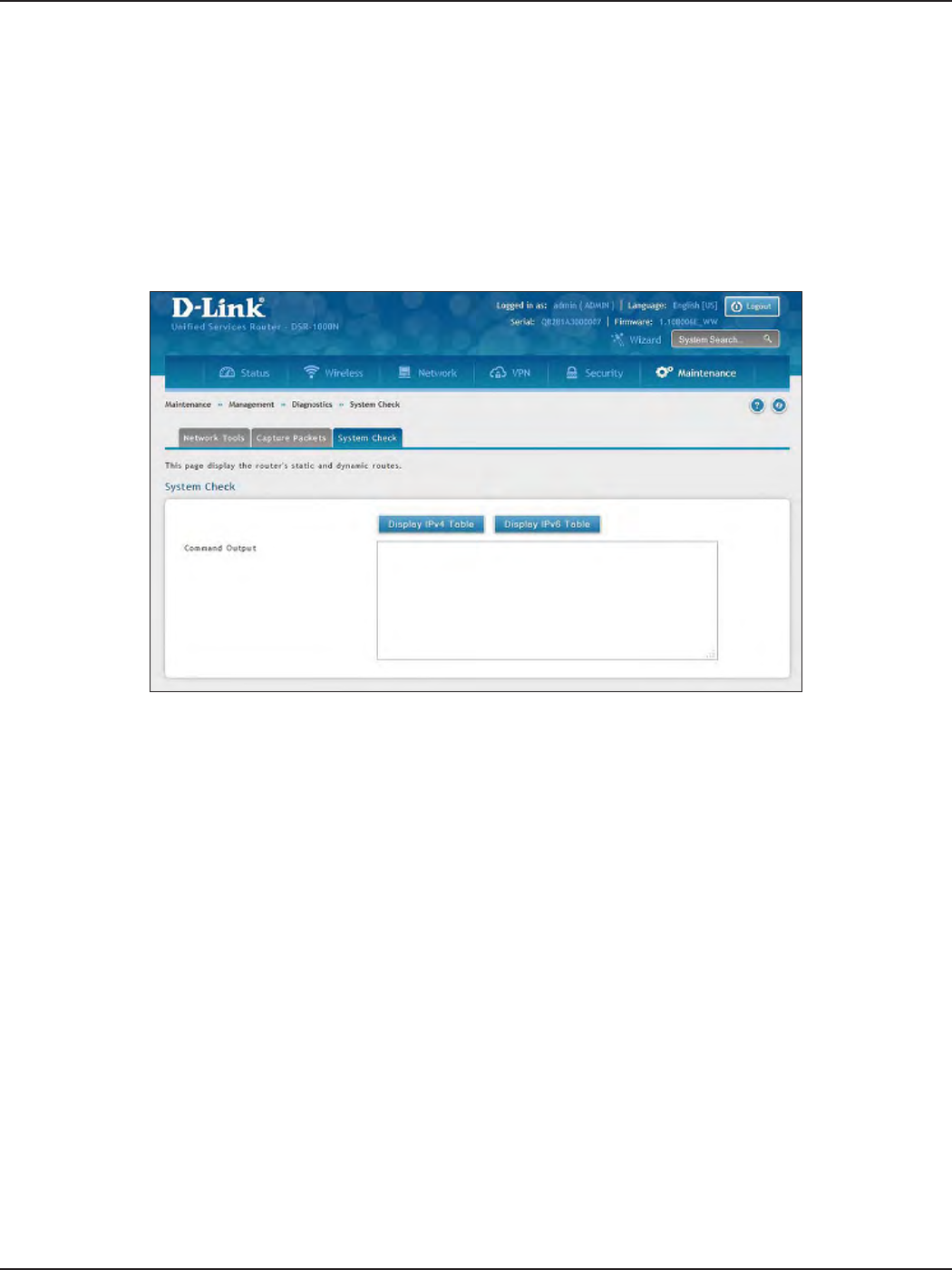
D-Link DSR-Series User Manual 181
Section 9 - Maintenance
Path: Maintenance > Management > Diagnostics > System Check
As part of the diagnostics functions on the router, you can view the static and dynamic routes for both IPv4 and IPv6.
1. Click Maintenance > Diagnostics > System Check tab.
System Check
2. Click Display IPv4 Table or Display IPv6 Table. The results will appear in the Command Output
display.
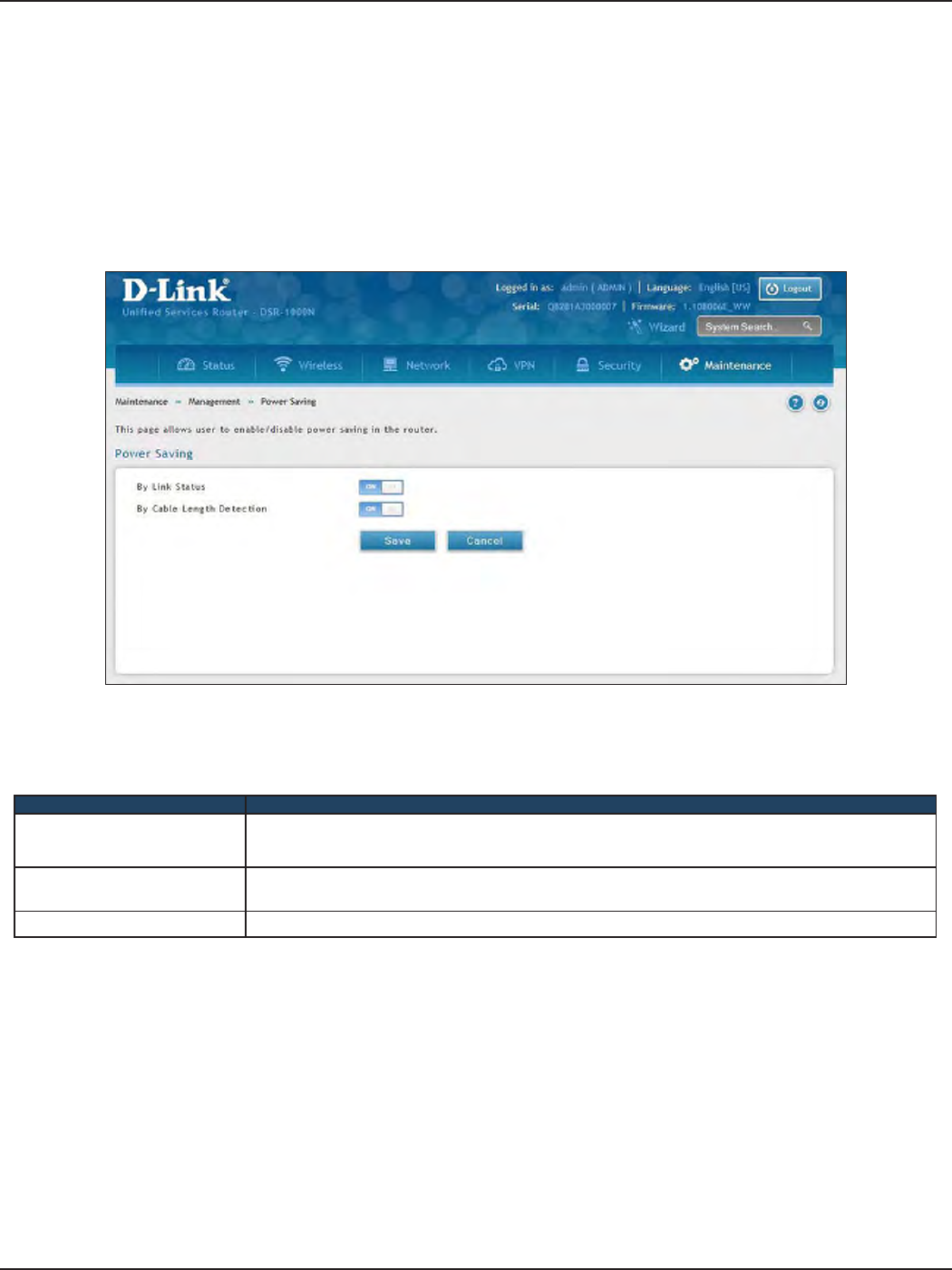
D-Link DSR-Series User Manual 182
Section 9 - Maintenance
Path: Maintenance > Management > Power Saving
The router allows you to adjust the power consumption of the hardware based on your actual usage. The two
“green” options available for your LAN switch are Power Saving by Link Status and Length Detection State.
1. Click Maintenance > Diagnostics > Power Saving.
Power Saving
Field Description
By Link Status
With “Power Saving by Link Status” option toggled to ON, the total power consumption by the LAN switch
is dependent function of on the number of connected ports. The overall current draw when a single port is
connected is less than when all the ports are connected.
By Cable Length Detection With “Length Detection State” option toggled to ON, the overall current supplied to a LAN port is reduced
when a smaller cable length is connected on a LAN port.
Save Click to save and activate your settings.
2. Complete the elds from the table below and click Save.
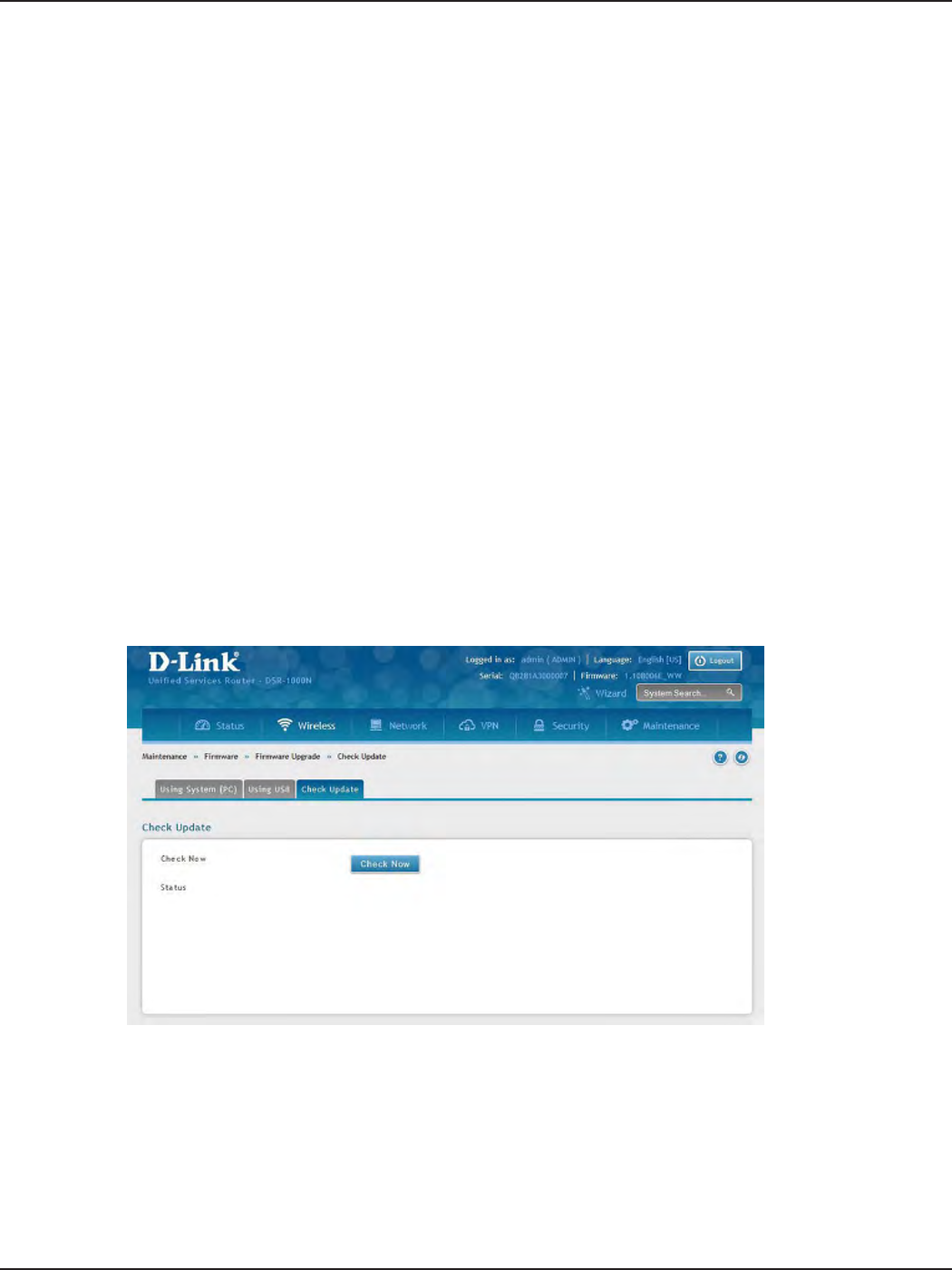
D-Link DSR-Series User Manual 183
Section 9 - Maintenance
You can upgrade to a newer rmware version from the Administration web page. In the Firmware Upgrade
section, to upgrade your rmware, click Browse, locate and select the rmware image on your host, and click
Upgrade. After the new rmware image is validated, the new image is written to ash and the router will
automatically reboot with the new rmware.
Warning: During the rmware upgrade, do NOT try to go online, turn o the DSR, shut down your PC, or interrupt the
process in anyway until the operation is complete. This should take only a minute or so including the reboot process.
Interrupting the upgrade process at specic points when the ash is being written to may corrupt the ash memory
and render the router unusable without a low-level process of restoring the ash rmware (not through the web GUI).
Firmware Upgrade
Path: Maintenance > Firmware > Firmware Upgrade
This router supports an automated notication to determine if a newer rmware version is available for this
router. By clicking the Check Now button in the notication section, the router will check a D-Link server to see
if a newer rmware version for this router is available for download.
To see if a new version is available:
1. Click Maintenance > Firmware > Firmware Upgrade > Check Update tab.
Check Update
2. Click Check Now. If new rmware is available or if you have the most current version a message will
appear under Status.
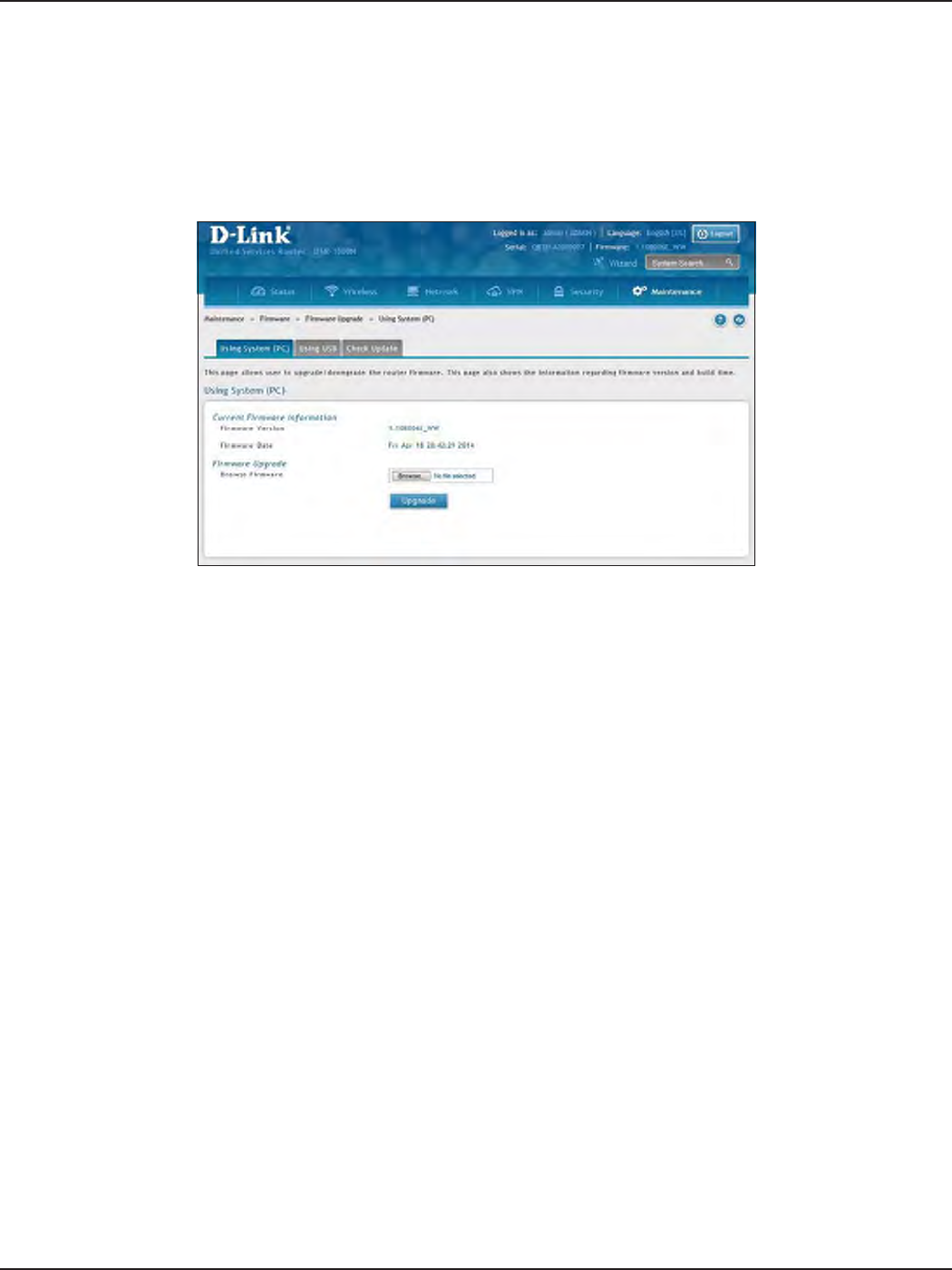
D-Link DSR-Series User Manual 184
Section 9 - Maintenance
To upgrade the rmware from a PC:
1. Download the latest rmware version from the D-Link support website.
2. Once downloaded, log in to the router and click Maintenance > Firmware > Firmware Upgrade >
Using System (PC) tab.
Using PC
3. Click Browse and locate the rmware le you downloaded. Select it and click Open.
4. Click Upgrade.
Note: The upgrade process takes a few minutes. Do not interrupt the upgrade or turn o the router;
otherwise you can damage the rmware. Wait for the upgrade to complete before browsing any sites from
your browser.
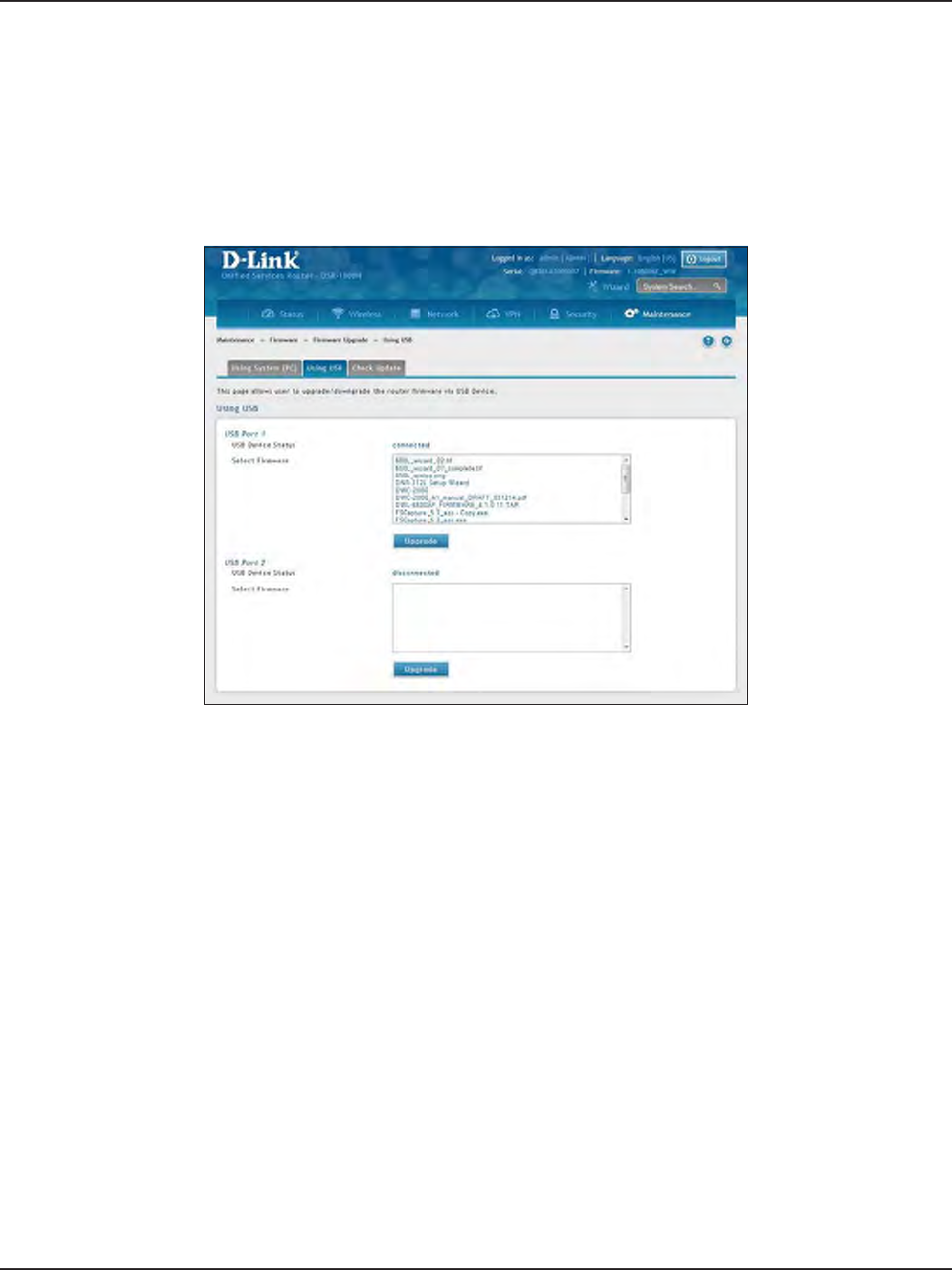
D-Link DSR-Series User Manual 185
Section 9 - Maintenance
Using USB
To upgrade the rmware using a USB thumb drive:
1. Download the latest rmware version from the D-Link support website and copy the le to a USB
thumb drive.
2. Plug the USB thumb drive into a USB port on the router.
3. Log in to the router and click Maintenance > Firmware > Firmware Upgrade > Using USB tab.
4. Select the rmware le from the list and click Upgrade.
Note: The upgrade process takes a few minutes. Do not interrupt the upgrade or turn o the router;
otherwise you can damage the rmware. Wait for the upgrade to complete before browsing any sites from
your browser.
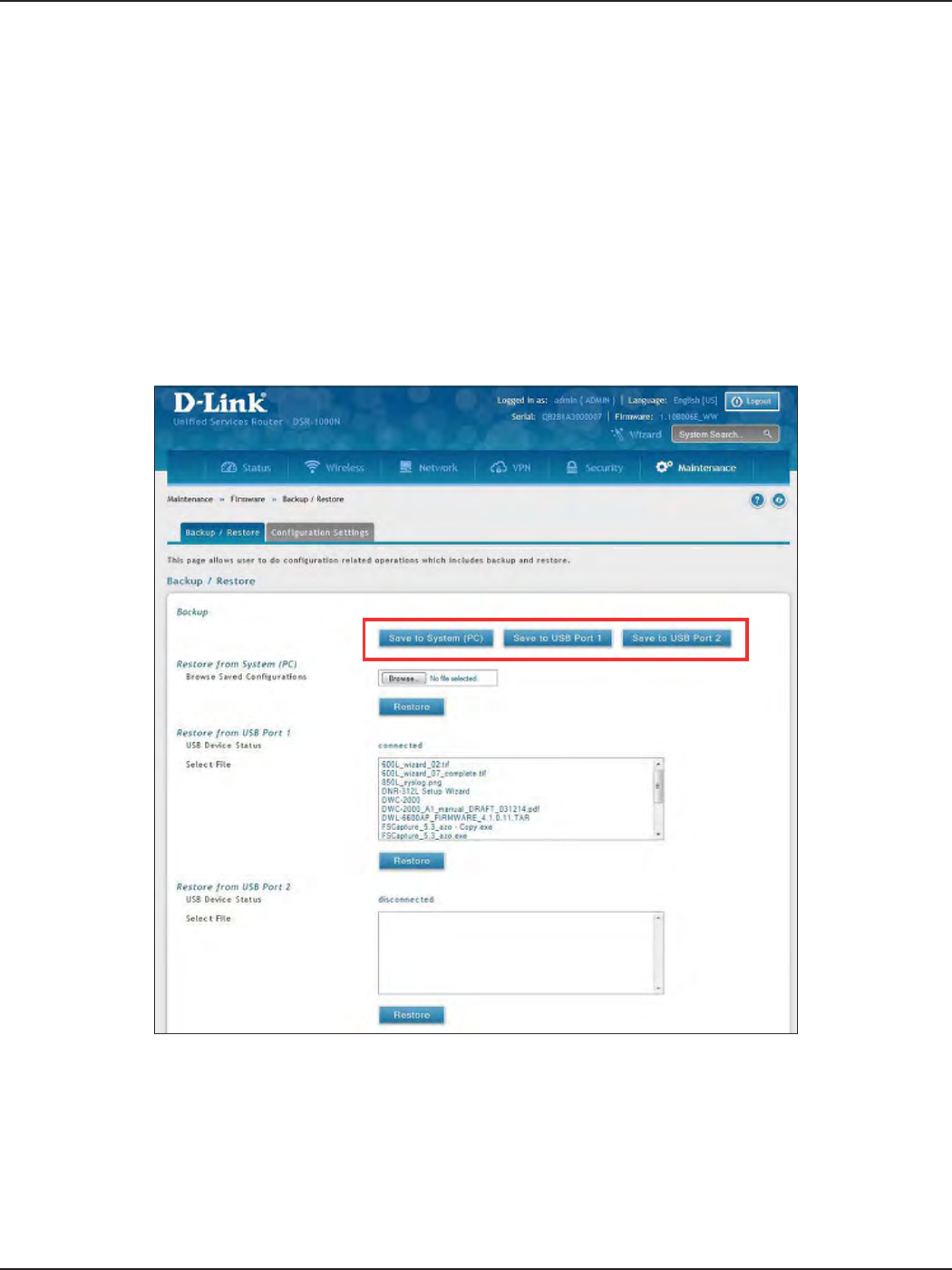
D-Link DSR-Series User Manual 186
Section 9 - Maintenance
Conguration Files
To backup your conguration les:
1. Click Maintenance > Firmware > Backup / Restore tab.
Path: Maintenance > Firmware > Backup / Restore
After you congure the router, you can back up the conguration settings. When you back up the settings, they
are saved as a le. You can then use the le to restore the settings on the same router if something goes wrong
or on a dierent router (must be the same model) that will replace the existing router.
Backup
2. To save the le to your computer, click Save to System (PC). If you have a USB thumb drive connected
to the router, you can click Save to USB Port 1 (or Port 2).
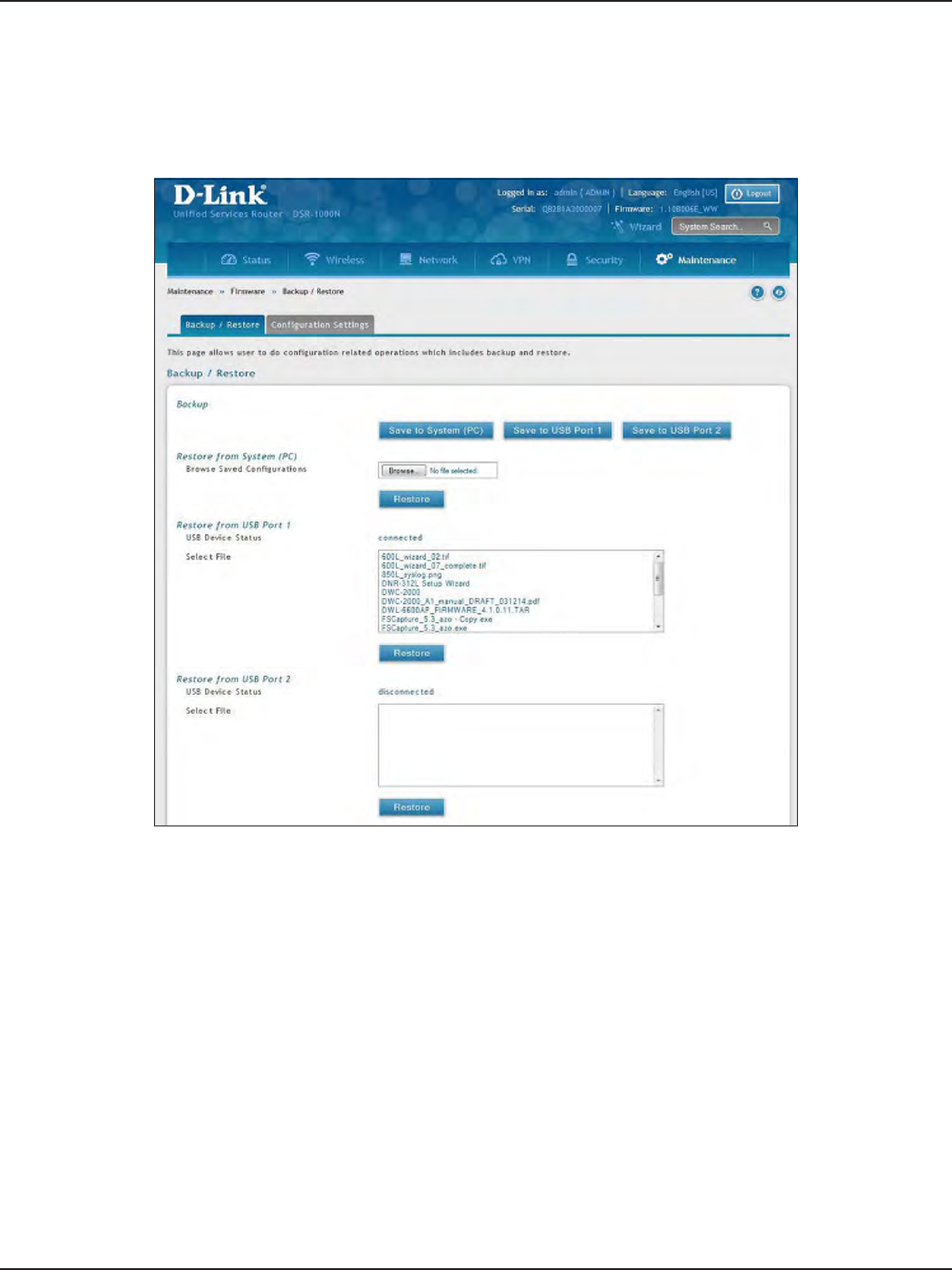
D-Link DSR-Series User Manual 187
Section 9 - Maintenance
To restore your settings from a saved backup le:
1. Click Maintenance > Firmware > Backup / Restore.
2. To restore the le from your computer, click Browse and select the le. Click Open and then click
Restore.
To restore the le from a USB thumb drive, select the le in the list under the corresponding USB port
and click Restore.
Restore
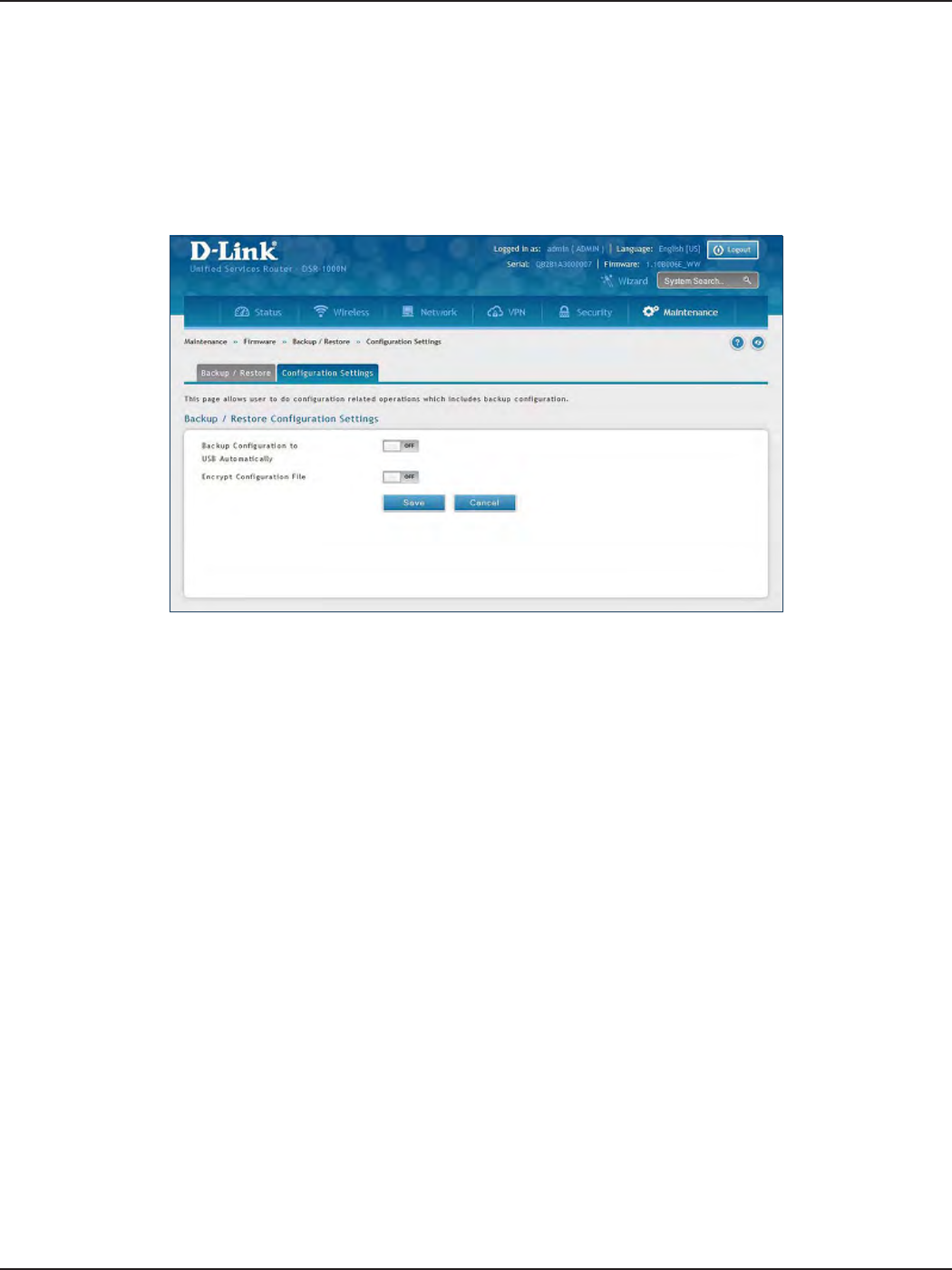
D-Link DSR-Series User Manual 188
Section 9 - Maintenance
If there is a USB storage device currently plugged in to the router, you can enable auto-backup. The snapshot of
current conguration settings will be updated on the USB storage device and overwrite any les with the same
lename (i.e., if there was an earlier conguration backup done to this location).
1. Click Maintenance > Firmware > Backup / Restore > Conguration Settings tab.
Conguration Settings
2. Toggle Backup Conguration to USB Automatically to ON to automatically save your conguration
settings to a le on your USB storage device.
3. Toggle Encrypt Conguration File to ON to encrypt the conguration le. This will ensure condential
information like system username/passwords are not available for view by unauthorized sources.
Enabling this option will apply to conguration les backed up on the host as well as a USB drive.
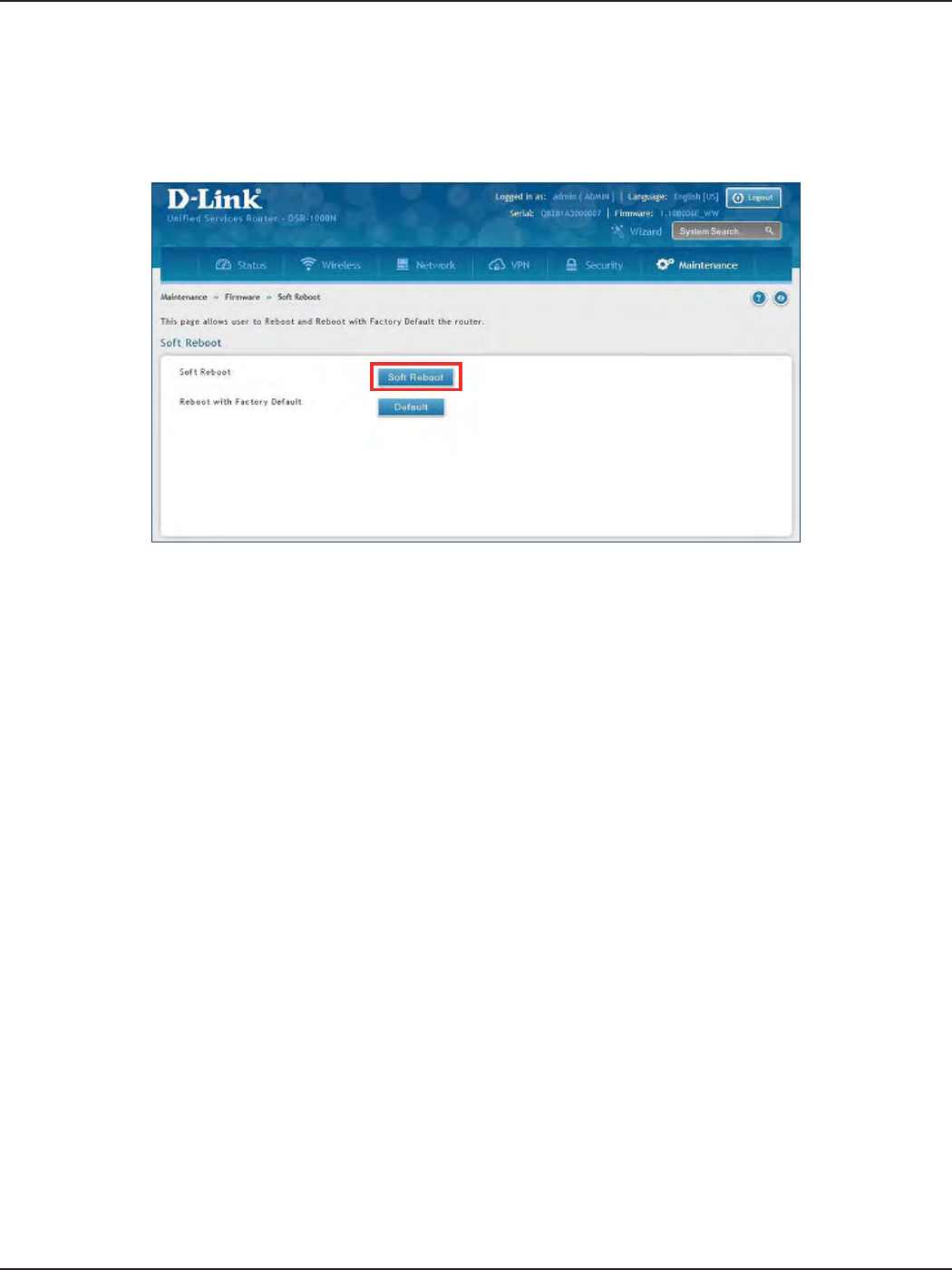
D-Link DSR-Series User Manual 189
Section 9 - Maintenance
Soft Reboot
Performing a soft reboot simply performs a power cycle.
1. Click Maintenance > Firmware > Soft Reboot.
2. Click Soft Reboot. The router will power cycle.
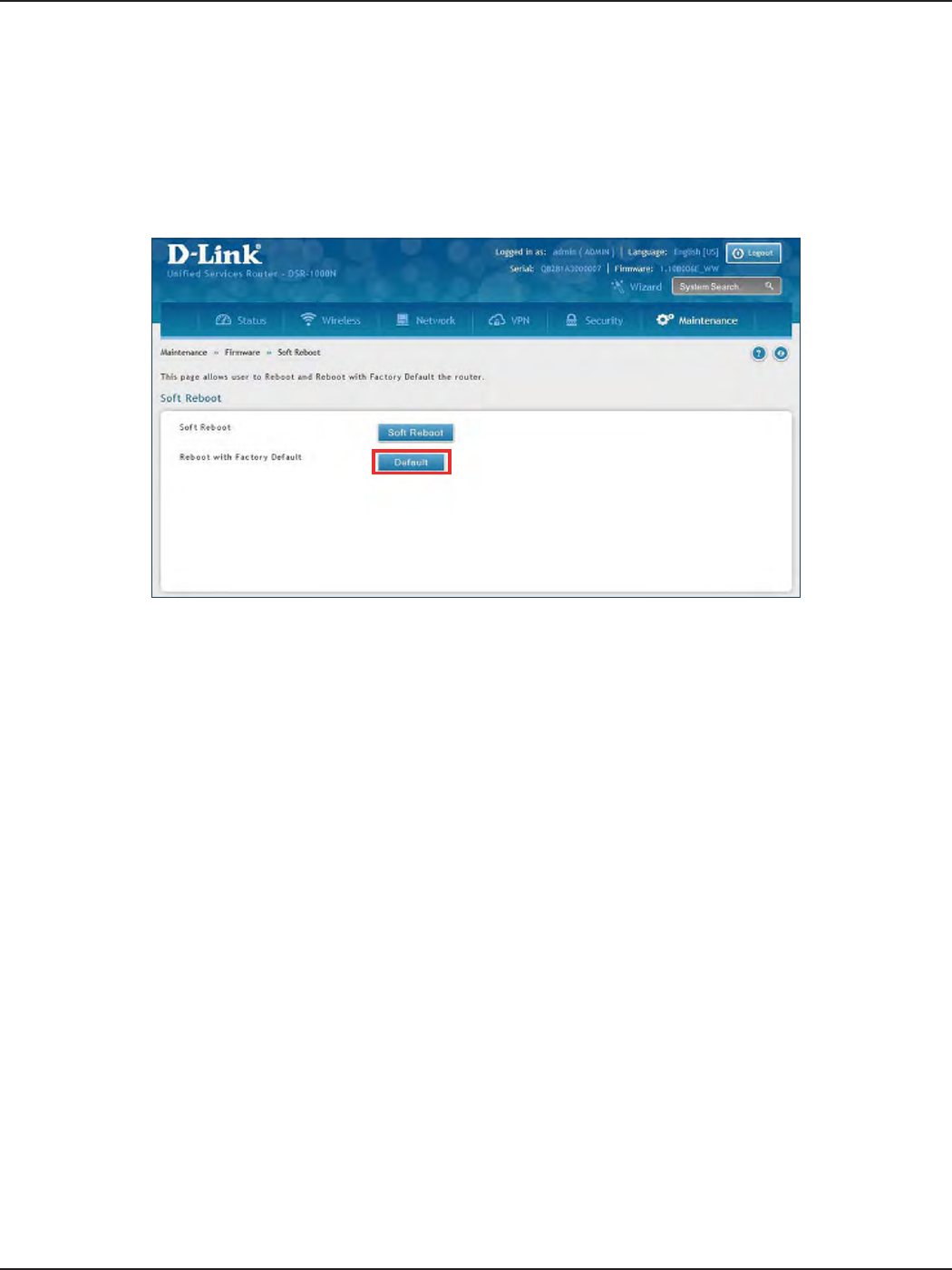
D-Link DSR-Series User Manual 190
Section 9 - Maintenance
Reset to Factory Default Settings
If you reset the router to its factory default settings, it returns to the state when it was new — all changes you
made to the default conguration are lost. Examples of settings that get restored include critical things you need
to get online, such as login password, SSID, IP addresses, and wireless security keys.
1. Click Maintenance > Firmware > Soft Reboot.
2. Click Default. The router will power cycle and reset all settings to the default values.
Note: After restoring to the factory default settings, the router’s default LAN IP address is 192.168.10.1, the
default login user name is ‘admin’, and the default login password is ‘admin’.
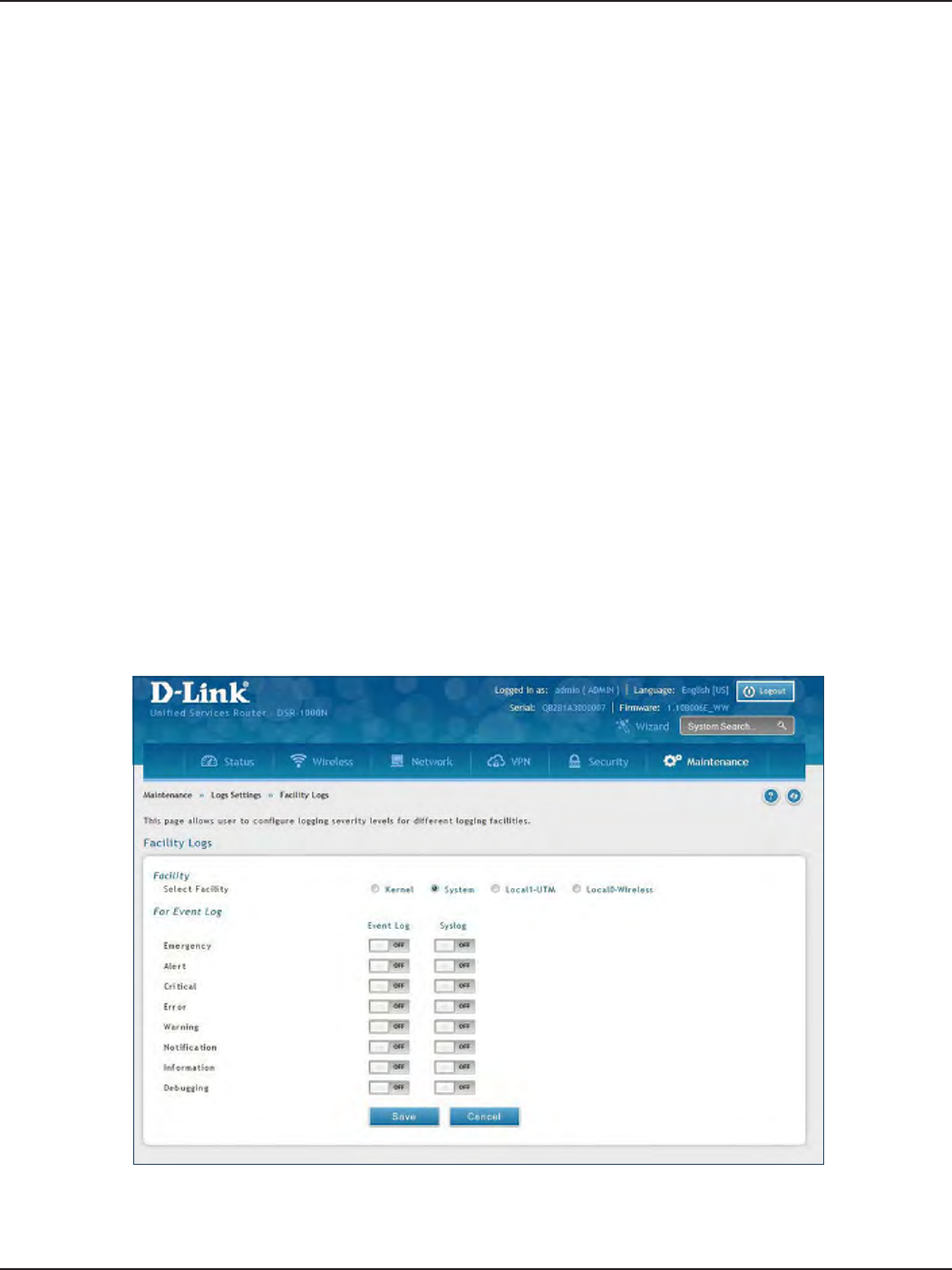
D-Link DSR-Series User Manual 191
Section 9 - Maintenance
Log Settings
The router allows you capture log messages. You can monitor the type of trac that goes through the router
and be notied of potential attacks or errors when they are detected by the controller. The following sections
describe the log conguration settings and the ways you can access these logs.
Dening What to Log
Path: Maintenance > Logs Settings > Log Facilities
The Facility Logs page lets you determine the granularity of logs to receive from the wireless controller. Select
one of the following facilities:
• Kernel: The Linux kernel. Log messages that correspond to this facility would correspond to
trac through the rewall or network stack.
• System: Application and management-level features available on this router for managing the
unit.
• Local1-UTM: This facility corresponds to IPS (Intrusion Prevention System) which helps in
detecting malicious intrusion attempts from the WAN.
• Local0-Wireless: This facility corresponds to the 802.11 driver used for providing AP
functionality to your network.
1. Click Maintenance > Log Settings > Log Facilities.
2. Select the facility and then toggle ON which events you want to log and click Save.

D-Link DSR-Series User Manual 192
Section 9 - Maintenance
For each facility, the following events (in order of severity) can be logged:
• Emergency: system is unusable
• Alert: action must be taken immediately
• Critical: critical conditions
• Error: error conditions
• Warning: warning conditions
• Notication: normal but signicant condition
• Information: informational
• Debugging: debug-level messages
When a particular severity level is selected, all events with severity equal to and greater than the chosen severity
are captured. For example if you have congured CRITICAL level logging for the Wireless facility, then 802.11
logs with severities CRITICAL, ALERT, and EMERGENCY are logged.
The display for logging can be customized based on whether the logs are sent to the Event Log viewer in the
web management interface (the Event Log viewer is in the Status > System Information > All Logs > Current
Logs) or a remote Syslog server for later review. E-mail logs, discussed in a subsequent section, follow the same
conguration as logs congured for a Syslog server.
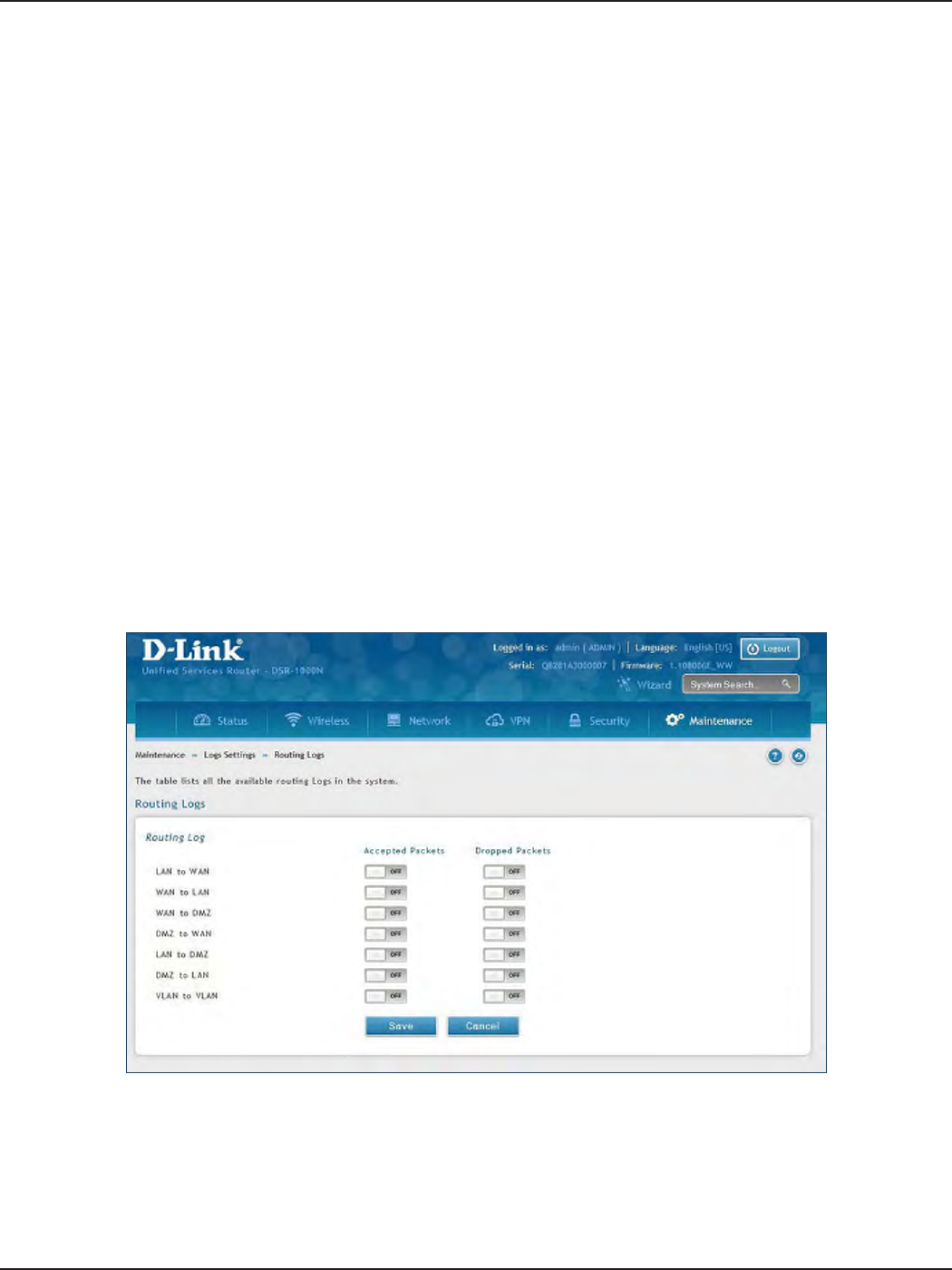
D-Link DSR-Series User Manual 193
Section 9 - Maintenance
Routing Logs
Path: Maintenance > Logs Settings > Routing Logs
Trac can be tracked based on whether the packet was accepted or dropped by the rewall. Denial of service
attacks, general attack information, login attempts, dropped packets, and similar events can be captured for
review.
Note: Enabling logging options may generate a signicant volume of log messages and is recommended for
debugging purposes only.
Trac through each network segment (LAN, WAN, DMZ) can be tracked based on whether the packet was
accepted or dropped by the rewall.
Accepted Packets are those that were successfully transferred through the corresponding network segment (i.e.,
LAN to WAN). This option is particularly useful when the Default Outbound Policy is “Block Always” so you can
monitor trac that is passed through the rewall.
Dropped Packets are packets that were intentionally blocked from being transferred through the corresponding
network segment. This option is useful when the Default Outbound Policy is “Allow Always”.
1. Click Maintenance > Log Settings > Routing Logs.
2. Toggle which events you want to log to ON and click Save.
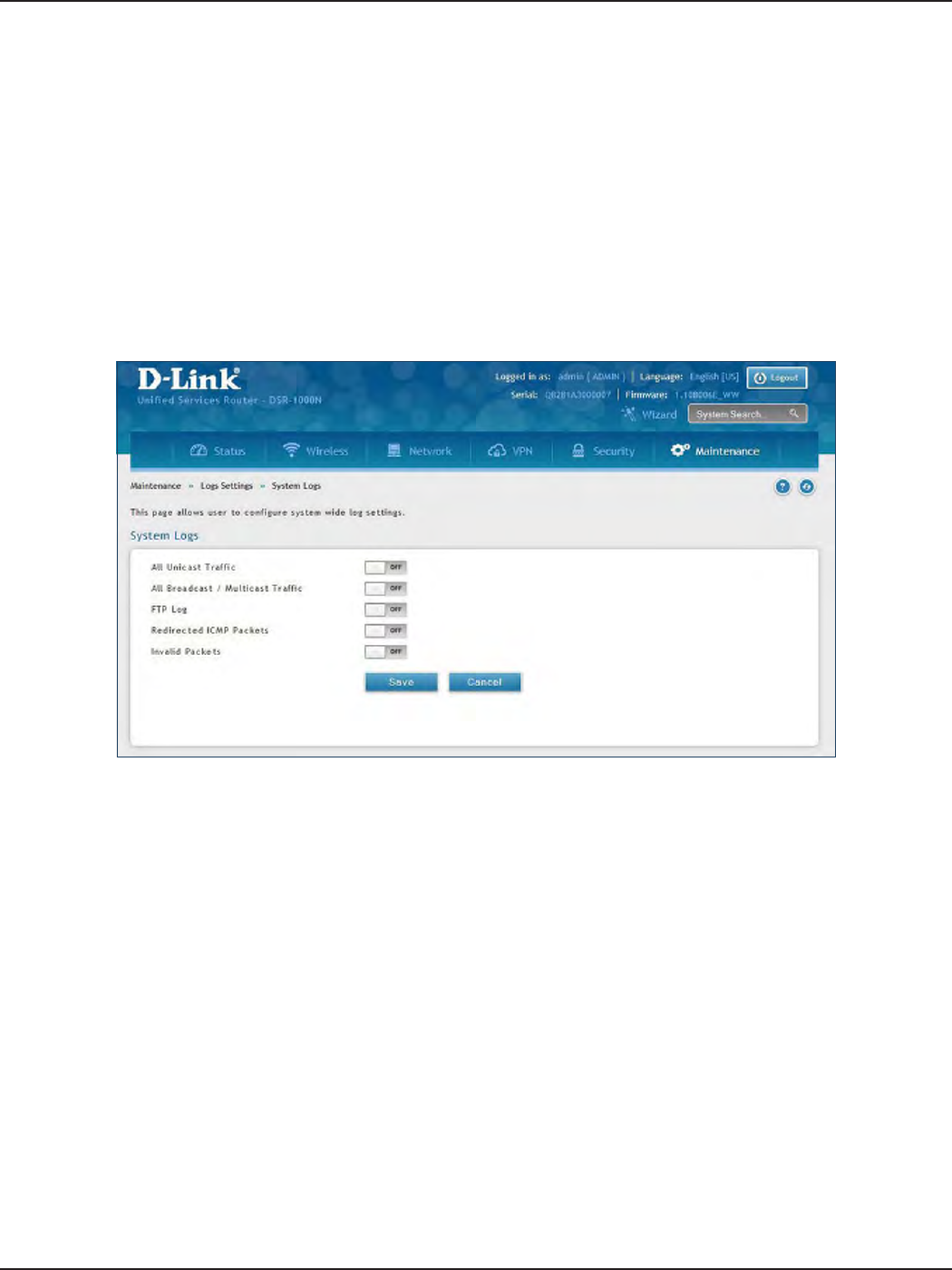
D-Link DSR-Series User Manual 194
Section 9 - Maintenance
System Logs
Path: Maintenance > Logs Settings > System Logs
In addition to network segment logging, unicast and multicast trac can be logged. Unicast packets have a
single destination on the network, whereas broadcast (or multicast) packets are sent to all possible destinations
simultaneously. One other useful log control is to log packets that are dropped due to congured bandwidth
proles over a particular interface. This data will indicate to the admin whether the bandwidth prole has to be
modied to account for the desired internet trac of LAN users.
1. Click Maintenance > Log Settings > System Logs.
2. Toggle which events you want to log to ON and click Save.
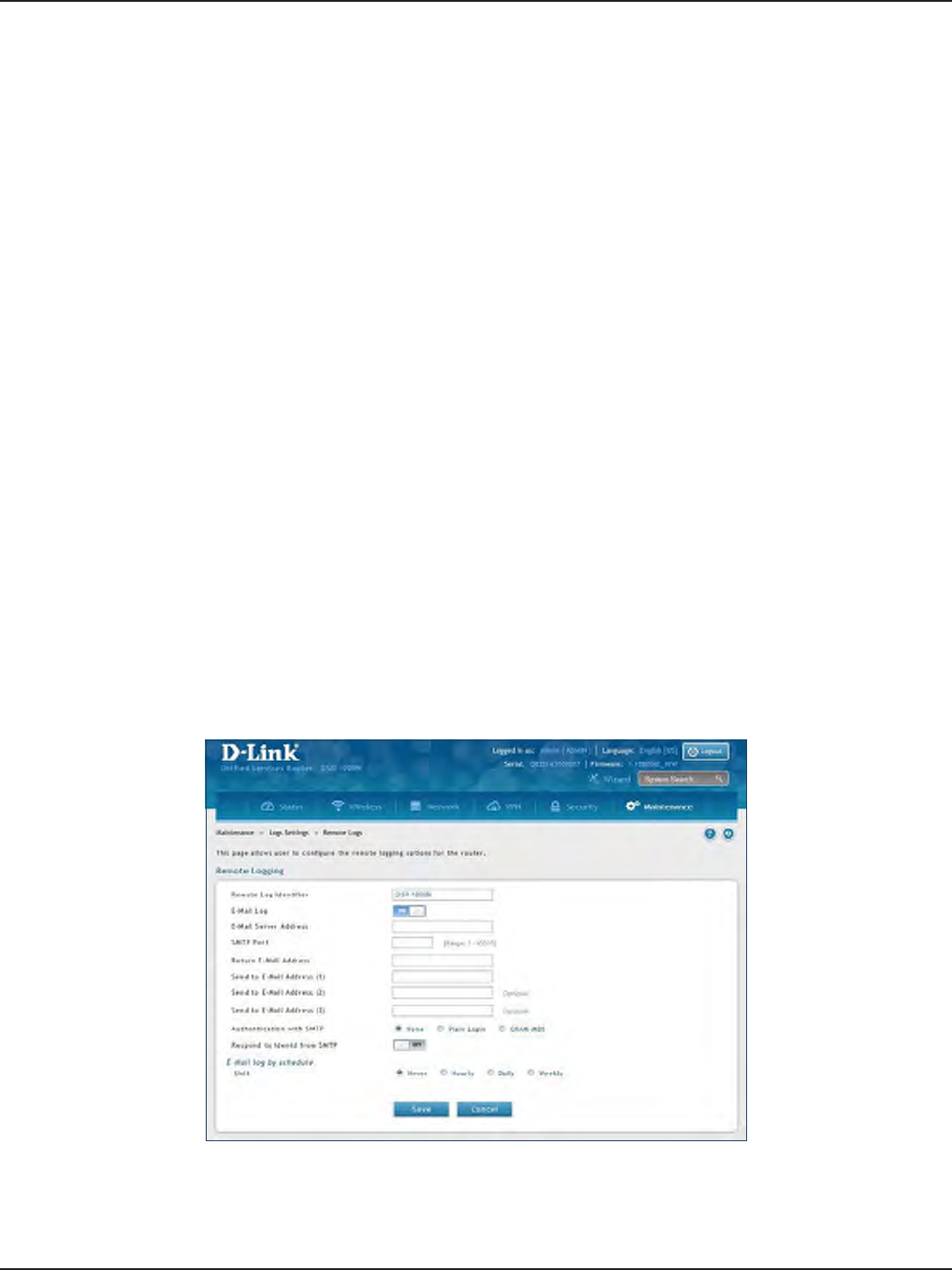
D-Link DSR-Series User Manual 195
Section 9 - Maintenance
Remote Logs
Path: Maintenance > Logs Settings > Remote Logs
Once you have congured the type of logs that you want the router to collect, they can be sent to either a Syslog
server or an E-Mail address. For remote logging a key conguration eld is the Remote Log Identier. Every
logged message will contain the congured prex of the Remote Log Identier, so that syslog servers or email
addresses that receive logs from more than one router can sort for the relevant device’s logs.
Once you enable the option to e-mail logs, enter the e-mail server’s address (IP address or FQDN) of the SMTP
server. The router will connect to this server when sending e-mails out to the congured addresses. The SMTP
port and return e-mail addresses are required elds to allow the router to package the logs and send a valid e-mail
that is accepted by one of the congured “send-to” addresses. Up to three e-mail addresses can be congured as
log recipients.
In order to establish a connection with the congured SMTP port and server, dene the server’s authentication
requirements. The router supports Login Plain (no encryption) or CRAM-MD5 (encrypted) for the username and
password data to be sent to the SMTP server. Authentication can be disabled if the server does not have this
requirement. In some cases the SMTP server may send out IDENT requests, and this router can have this response
option enabled as needed.
Once the e-mail server and recipient details are dened you can determine when the router should send out
logs. E-mail logs can be sent out based on a dened schedule by rst choosing the unit (i.e., the frequency) of
sending logs: Hourly, Daily, or Weekly. Selecting Never will disable log e-mails but will preserve the e-mail server
settings.
1. Click Maintenance > Log Settings > Remote Logs.
2. Complete the elds from the table on the next page and click Save.

D-Link DSR-Series User Manual 196
Section 9 - Maintenance
Field Description
Remote Log Identier Enter a prex used to identify the source of the message. This identier is prexed to both e-mail and
Syslog messages.
E-Mail Log Toggle to ON to enable E-Mail logs.
E-Mail Server Address Enter the IP address or network address of the SMTP server. The router will connect to this server to send
e-mail logs when required. The SMTP server must be operational for e-mail notications to be received.
SMTP Port Enter the SMTP port of the e-mail server.
Return E-Mail Address Enter the e-mail address where replies from the SMTP server are to be sent (required for failure messages).
Send to E-Mail Address (1-3) Enter up to three e-mail addresses where logs and alerts are to be sent.
Authentication with SMTP
Select an authentication if the SMTP server requires authentication before accepting connections. Choices
are:
• None: No authentication is used. The User Name and Password elds are not available.
• Login Plain: Authentication used to log in using Base64-encoded passwords over non-encrypted
communication session. Base64-encoded passwords oer no cryptographic protection, making them
vulnerable.
• CRAM-MD5: A challenge-response authentication mechanism dened in RFC 2195 based on the
HMAC-MD5 MAC algorithm. CRAM-MD5 oers a higher level of authentication than Login Plain.
User Name If Authentication with SMTP is set to Login Plain or CRAM-MD5, enter the user name to be used for
authentication.
Password If Authentication with SMTP is set to Login Plain or CRAM-MD5, enter the case-sensitive password to be
used for authentication.
Respond to identd from SMTP Toggle to ON to have the router respond to IDENT requests from the SMTP server.
Unit
Select the period of time that you need to send the log. This option is useful when you do not want to
receive logs by e-mail, but want to keep e-mail options congured, so you can use the Send Log function
Event Log viewer pages. Choices are:
• Never: Disable sending of logs.
• Hourly: Send logs every hour.
• Daily: Send logs every day at the Time specied.
• Weekly: Send logs weekly, at the Day and Time specied.
Day If Unit is set to Weekly, select the day of the week when logs will be sent.
Time If Unit is set to Daily or Weekly, select the time when logs will be sent.
Save Click to save and activate your settings.
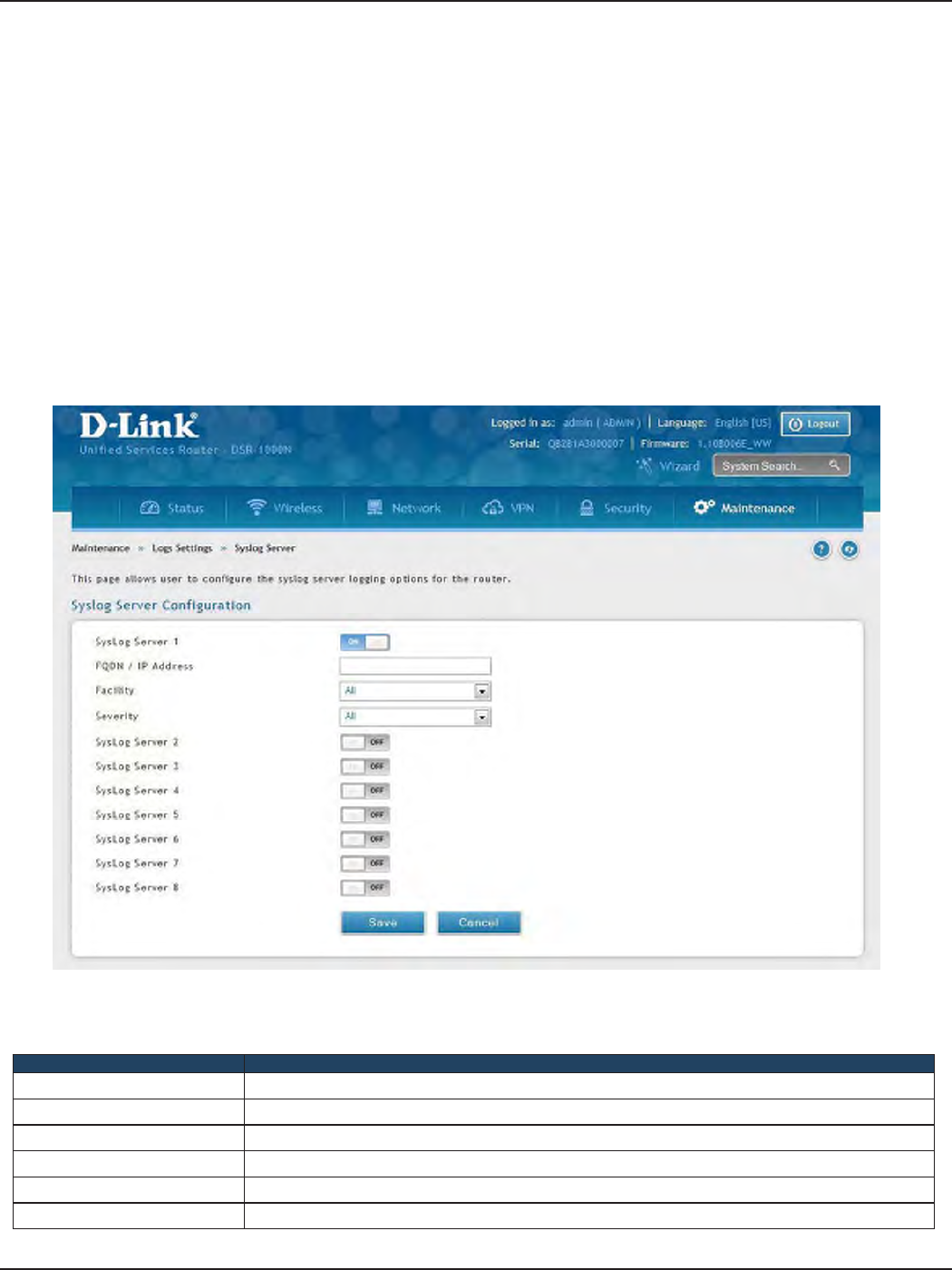
D-Link DSR-Series User Manual 197
Section 9 - Maintenance
Syslog Server
Path: Maintenance > Logs Settings > Syslog Server
An external Syslog server is often used to collect and store logs from the router. This remote device typically has
less memory constraints than the local Event Viewer on the router. Therefore, a number of logs can be collected
over a sustained period. This is useful for debugging network issues or to monitor router trac over a long
duration.
The router supports eight concurrent Syslog servers. Each server can be congured to receive dierent log
facility messages of varying severity using the Remote Logs page. This page also lets you send conguration
logs to three email recipients.
1. Click Maintenance > Log Settings > Syslog Server.
2. Complete the elds from the table on the next page and click Save.
Field Description
Syslog Server 1 Toggle to ON to setup a Syslog server.
FQDN / IP Address Enter the IP address or Internet Name of the Syslog server.
Facility Select which facility you want to log. Refer to “Dening What to Log” on page 191 for denitions.
Severity Select the severity level you want to log. Refer to “Dening What to Log” on page 191 for denitions.
Syslog Server 2-8 Toggle to ON to setup another Syslog server. Repeat the elds above for each server you want to setup.
Save Click to save and activate your settings.
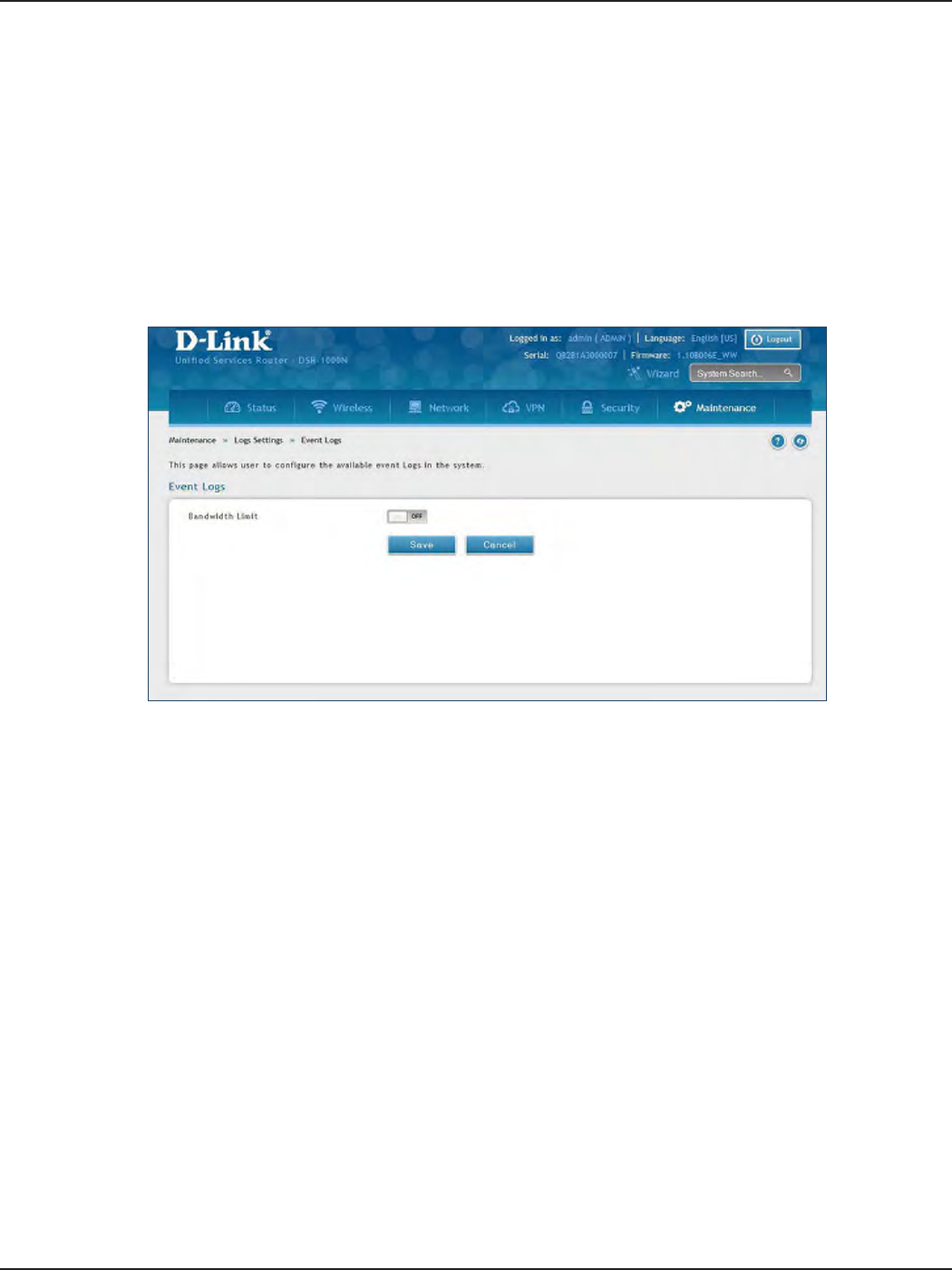
D-Link DSR-Series User Manual 198
Section 9 - Maintenance
Event Logs
Path: Maintenance > Logs Settings > Event Logs
The router’s web management interface displays congured log messages from the Status menu. When trac
through or to the router matches settings in the Facility Logs page or Routing Logs page, the corresponding log
message will appear in this window with a timestamp.
1. Click Maintenance > Log Settings > Event Logs.
2. Toggle to ON and click Save.
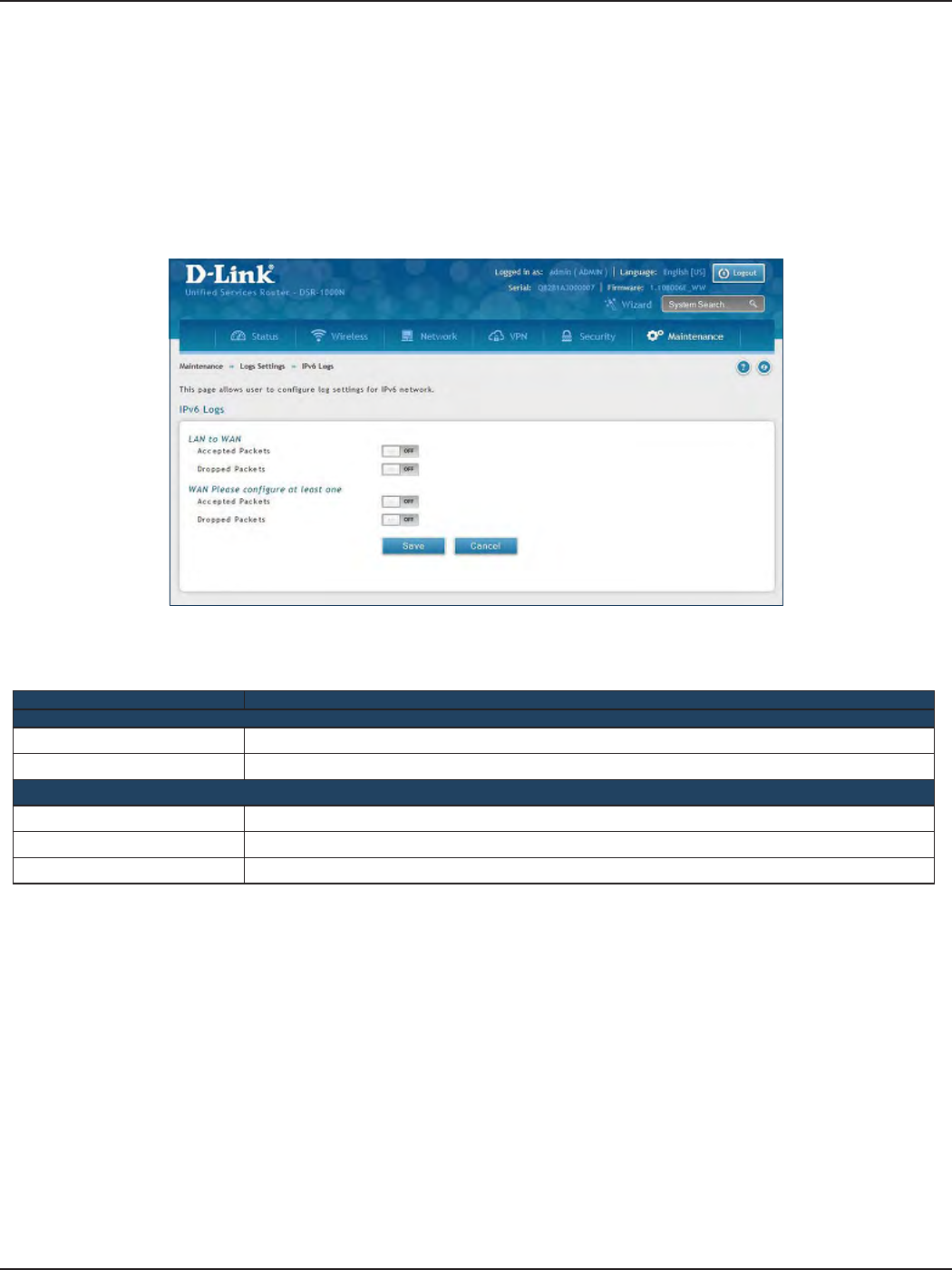
D-Link DSR-Series User Manual 199
Section 9 - Maintenance
IPv6 Logs
Path: Maintenance > Logs Settings > IPv6 Logs
This page allows you to congure what IPv6 events you want to log.
1. Click Maintenance > Log Settings > IPv6 Logs.
2. Complete the elds from the table below and click Save.
Field Description
LAN to WAN
Accepted Packets Toggle to ON to log accepted packets.
Dropped Packets Toggle to ON to log dropped packets.
WAN
Accepted Packets Toggle to ON to log accepted packets.
Dropped Packets Toggle to ON to log dropped packets.
Save Click to save and activate your settings.
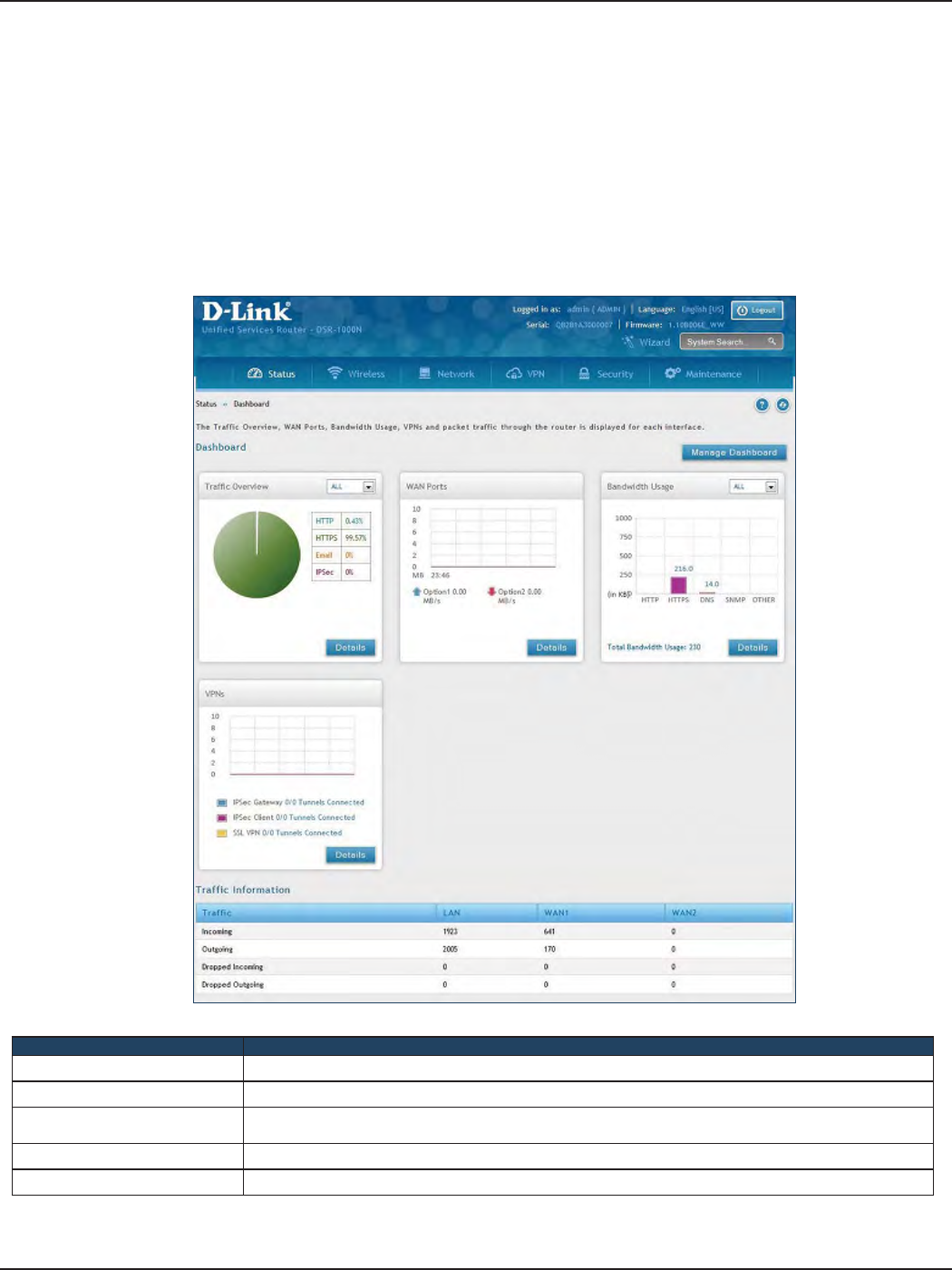
D-Link DSR-Series User Manual 200
Section 10 - Status and Statistics
Status and Statistics
Path: Status > Dashboard
The router provides a dashboard that displays about the resources the system is using. The dashboard page is
organized into the following sections:
Field Description
Trac Overview Displays a chart of trac overview by service for each interface.
WAN Ports Displays a chart of trac overview by bandwidth and packet information for WAN trac.
Bandwidth Usage Displays bandwidth usage by network segment such as WAN or LAN. The data is broken into by applications
service such as HTTP, HTTPS, DNS, SNMP, and others.
VPNs Displays a chart of VPN trac by bandwidth and number of tunnels.
Trac Information Displays a grid of trac statistics for each interface.
Dashboard
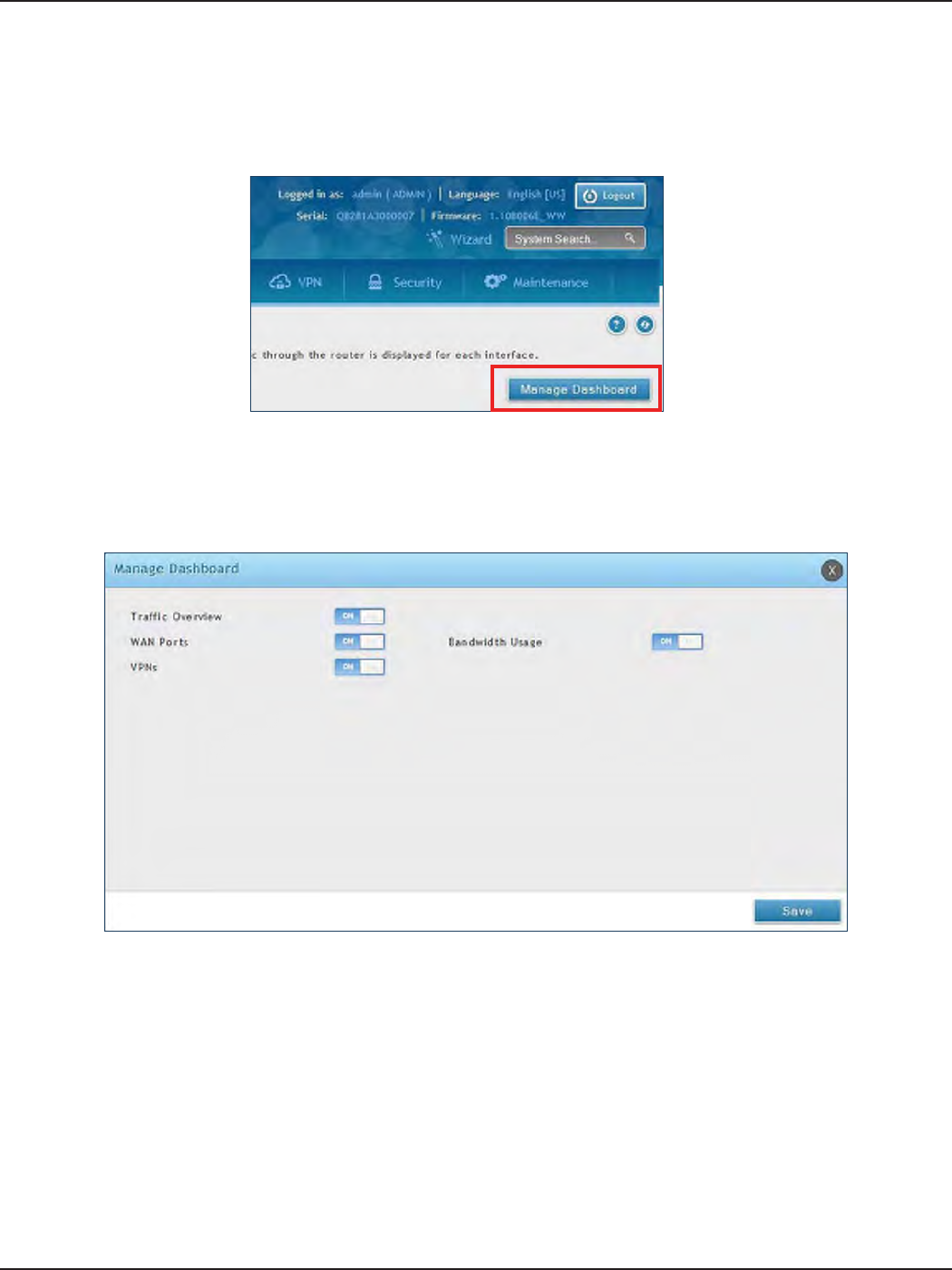
D-Link DSR-Series User Manual 201
Section 10 - Status and Statistics
Manage Dashboard
To manage the dashboard:
1. Click on the Manage Dashboard button.
2. The following window will pop out and allow you to enable or disable the overview panels shown on
the dashboard. Toggle the panel to ON or OFF and click Save.
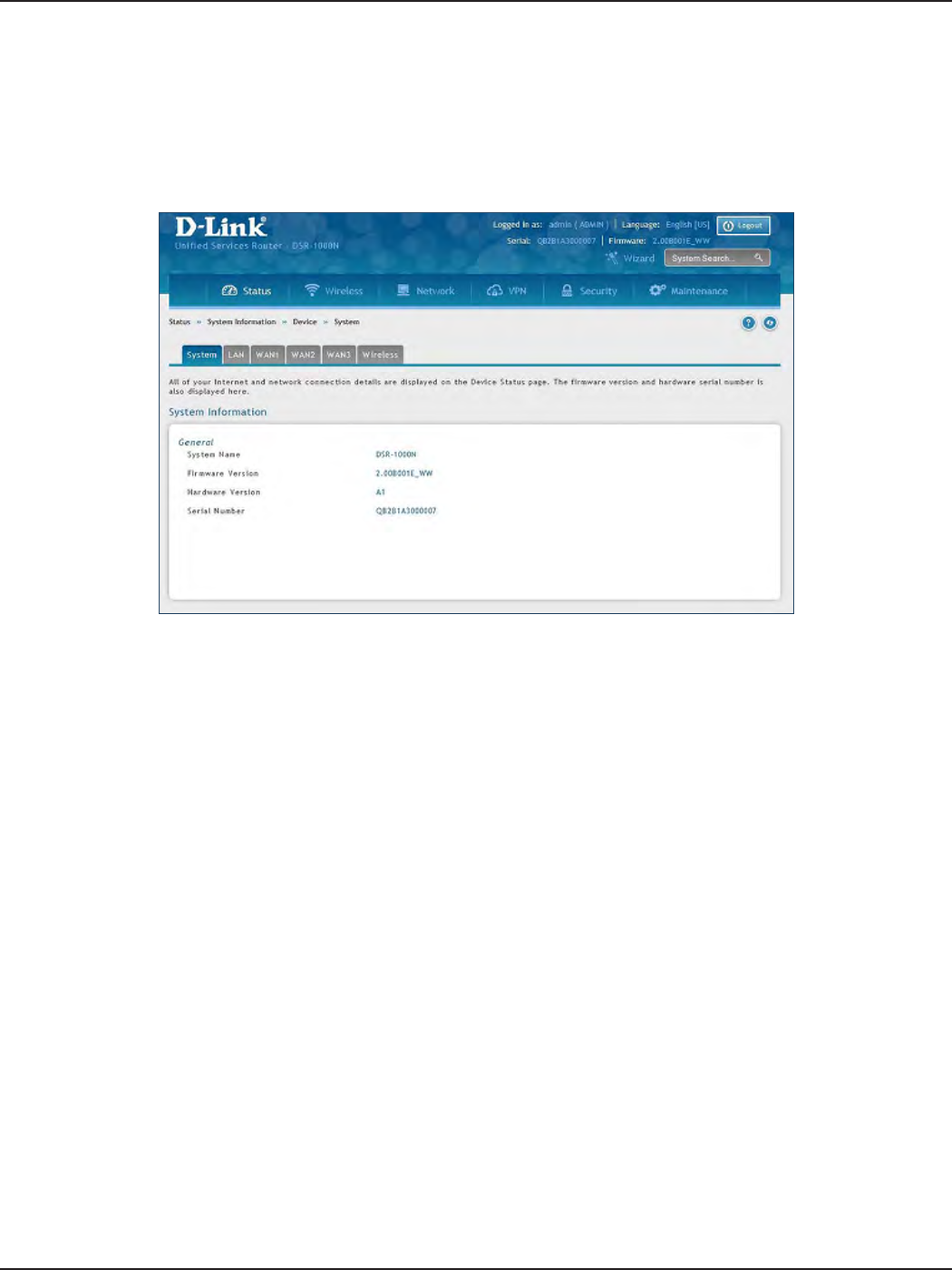
D-Link DSR-Series User Manual 202
Section 10 - Status and Statistics
System
Path: Status > System Information > Device > System
The System Info page displays the current system name, rmware version, hardware version, and serial number.
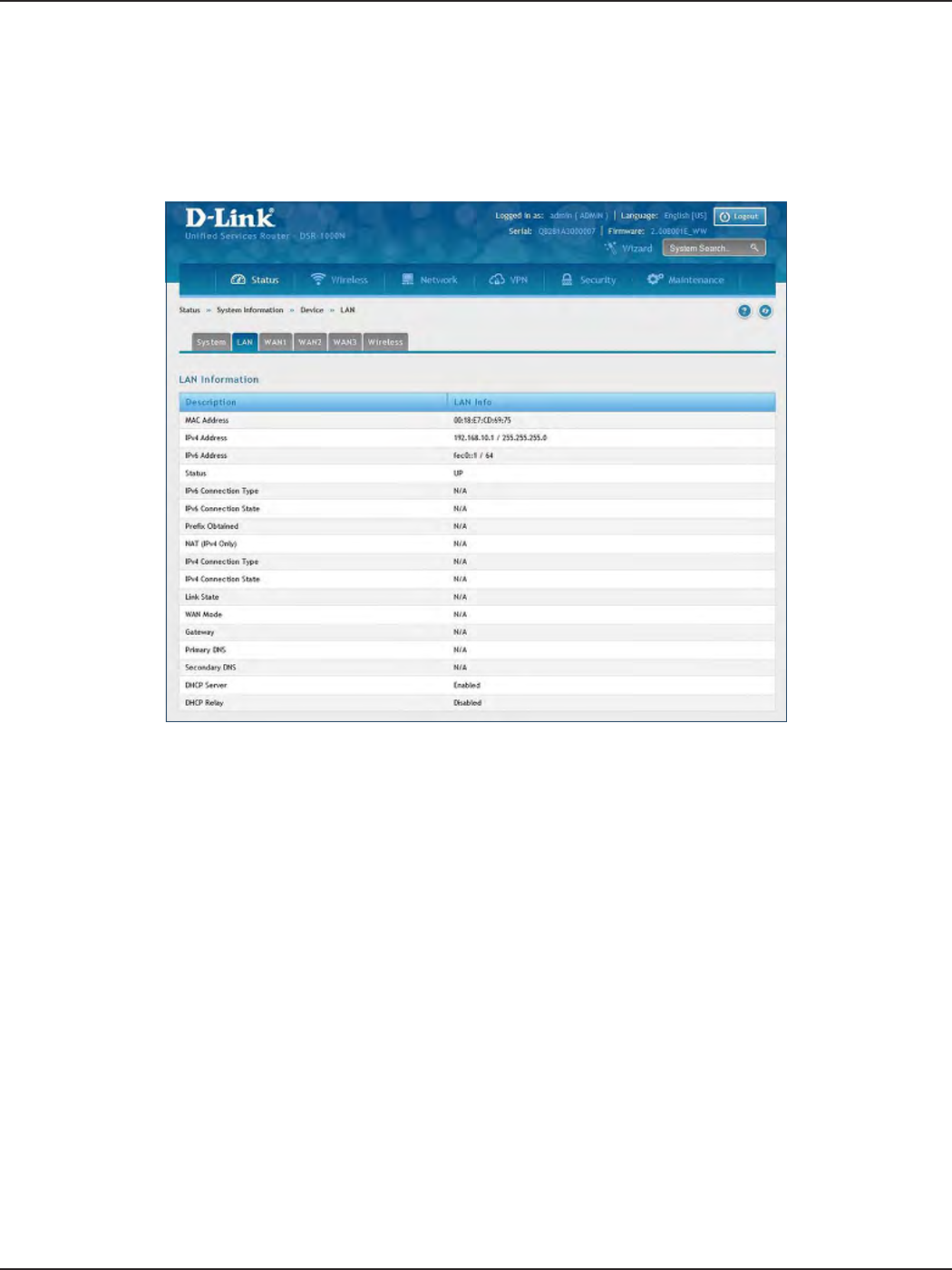
D-Link DSR-Series User Manual 203
Section 10 - Status and Statistics
LAN Info
Path: Status > System Information > Device > LAN
The LAN Information page summarizes the LAN settings including MAC address, IP address, and link state.
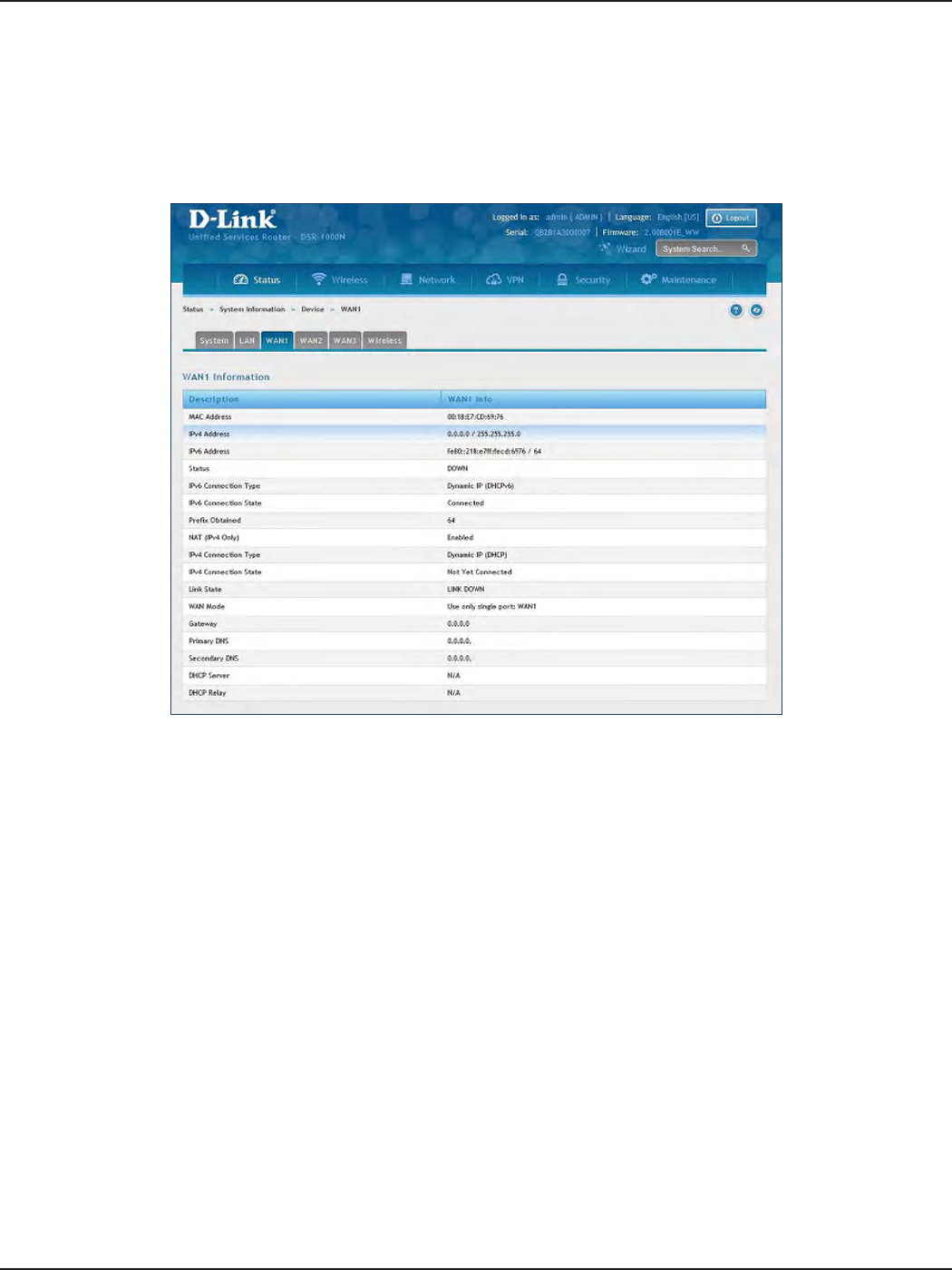
D-Link DSR-Series User Manual 204
Section 10 - Status and Statistics
WAN1
Path: Status > System Information > Device > WAN1
The WAN1 Information page summarizes the WAN1 port settings.
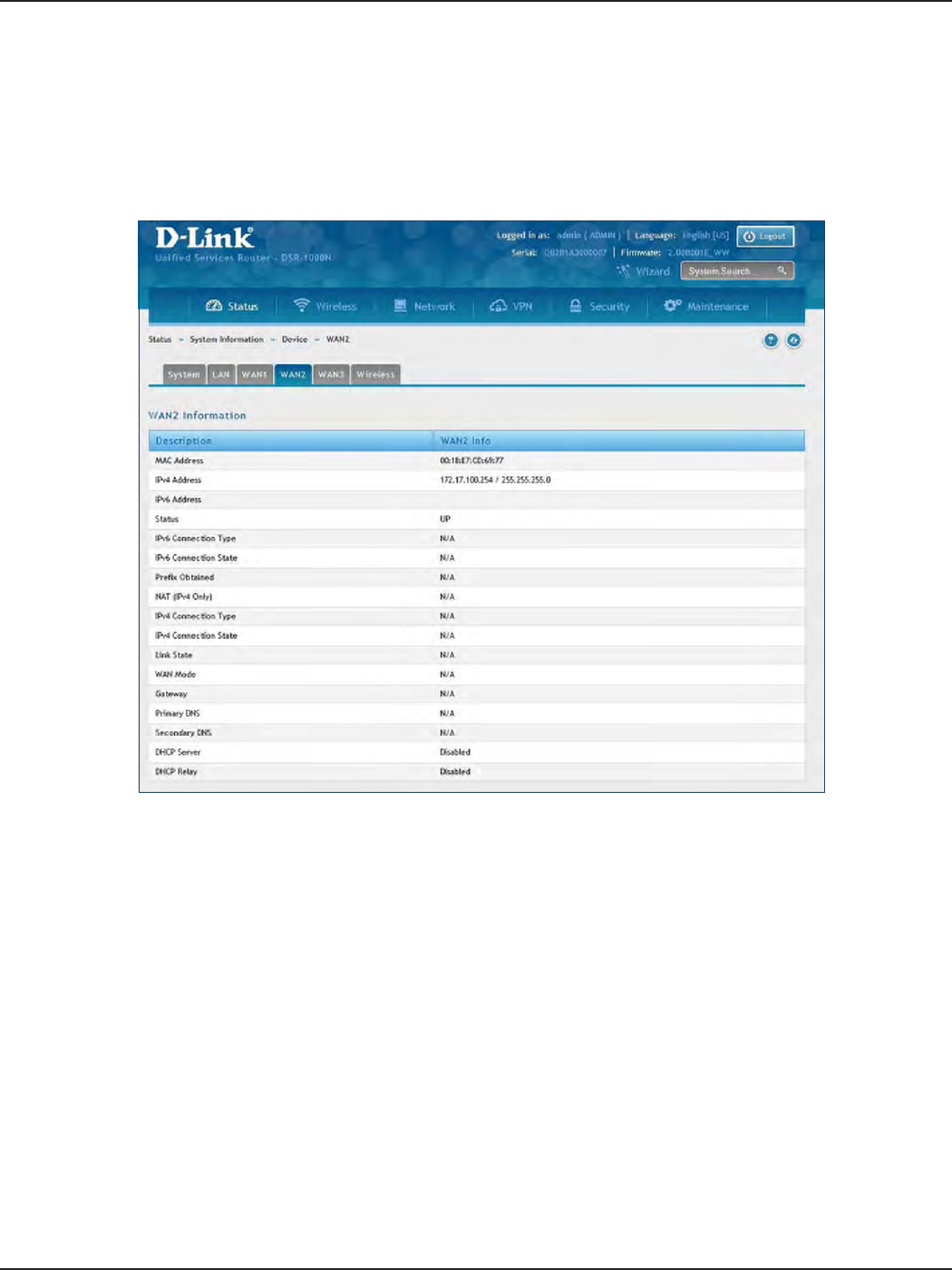
D-Link DSR-Series User Manual 205
Section 10 - Status and Statistics
WAN2
Path: Status > System Information > Device > WAN2
The WAN2 Information page summarizes the WAN2 port settings.
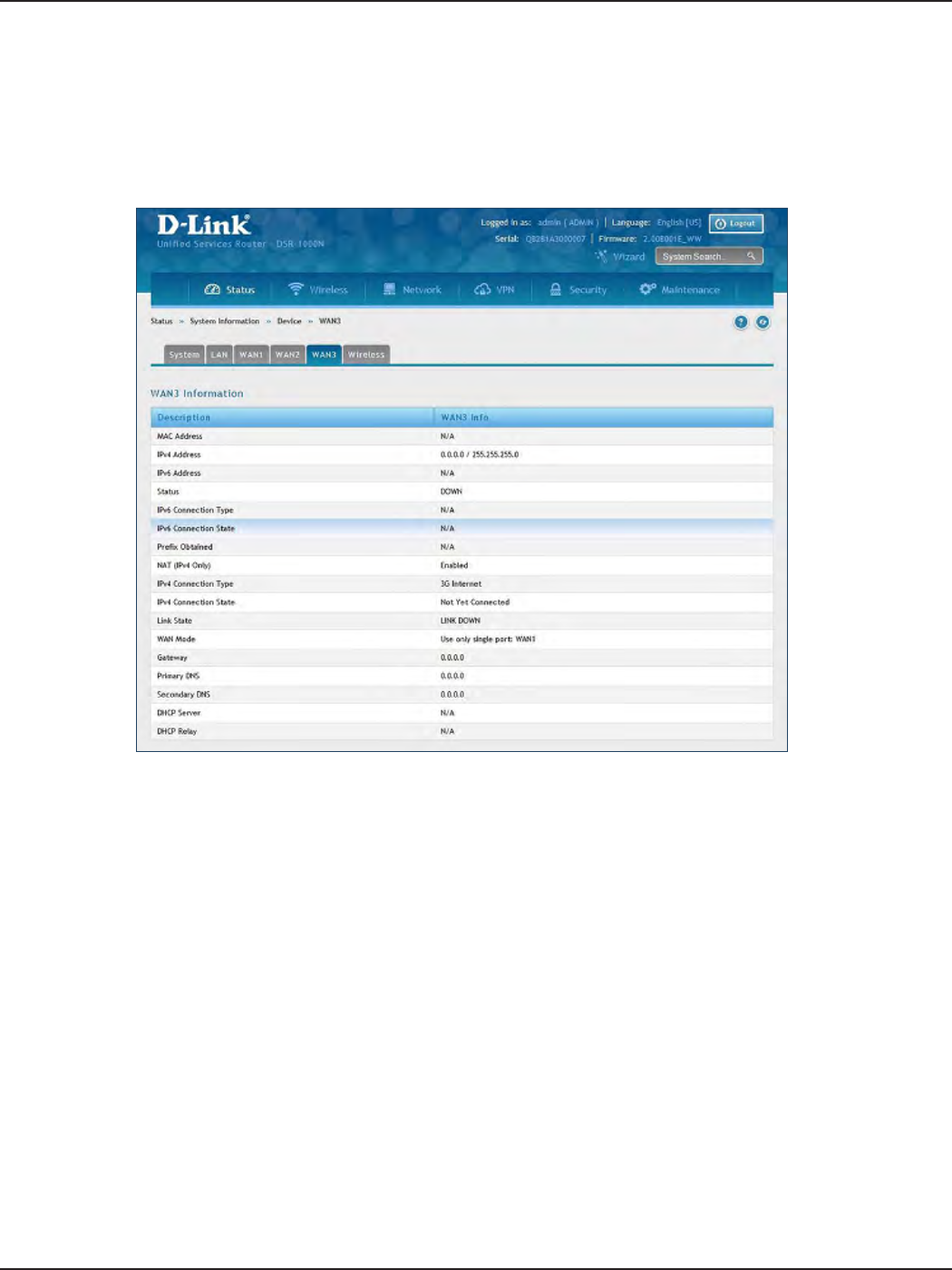
D-Link DSR-Series User Manual 206
Section 10 - Status and Statistics
WAN3
Path: Status > System Information > Device > WAN3
The WAN3 Information page summarizes the WAN3 settings.
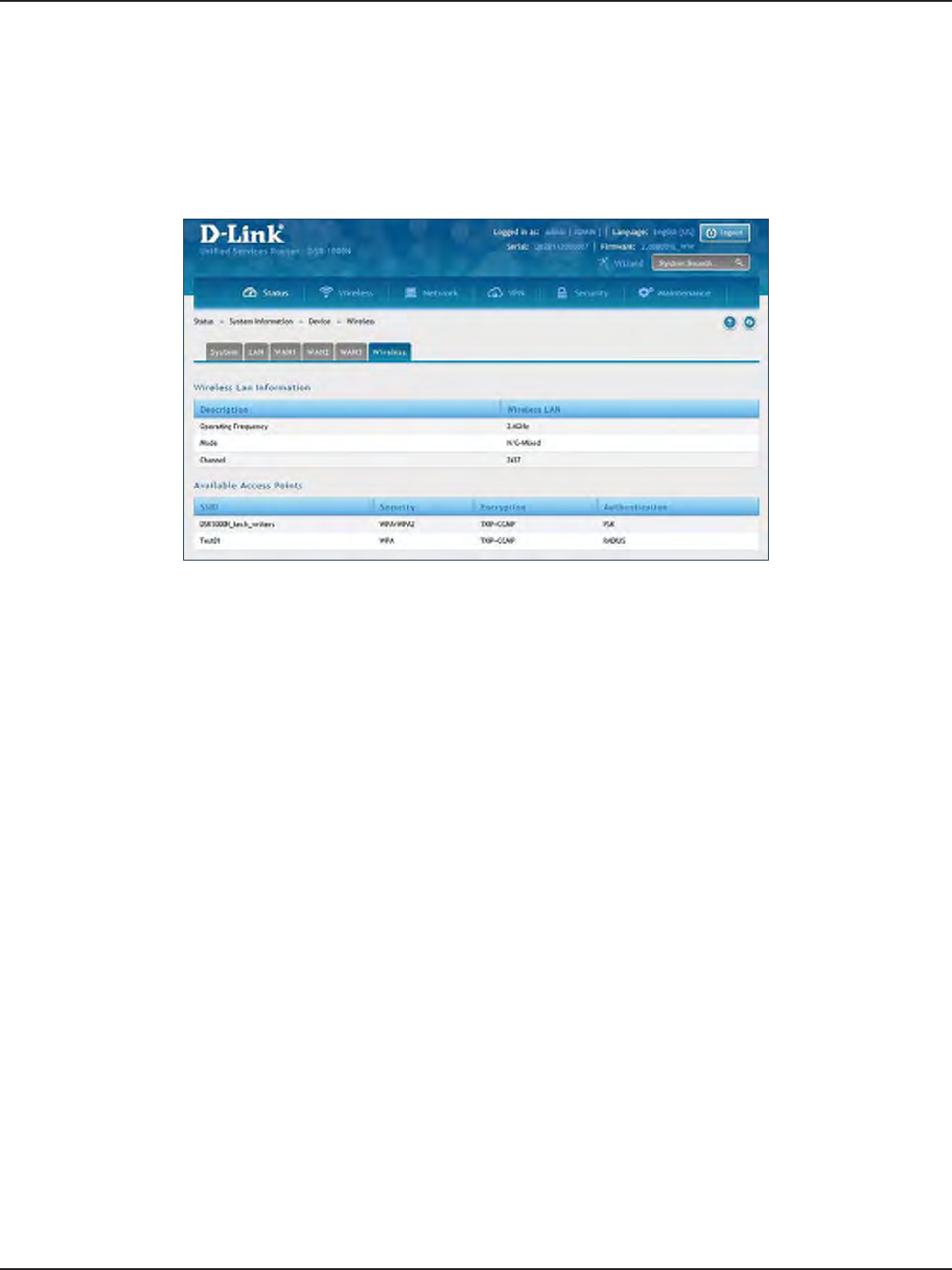
D-Link DSR-Series User Manual 207
Section 10 - Status and Statistics
Wireless
Path: Status > System Information > Device > Wireless
The Wireless Information page displays trac statistics for each enabled access point. This page will give a
snapshot of how much trac is being transmitted over each wireless link.
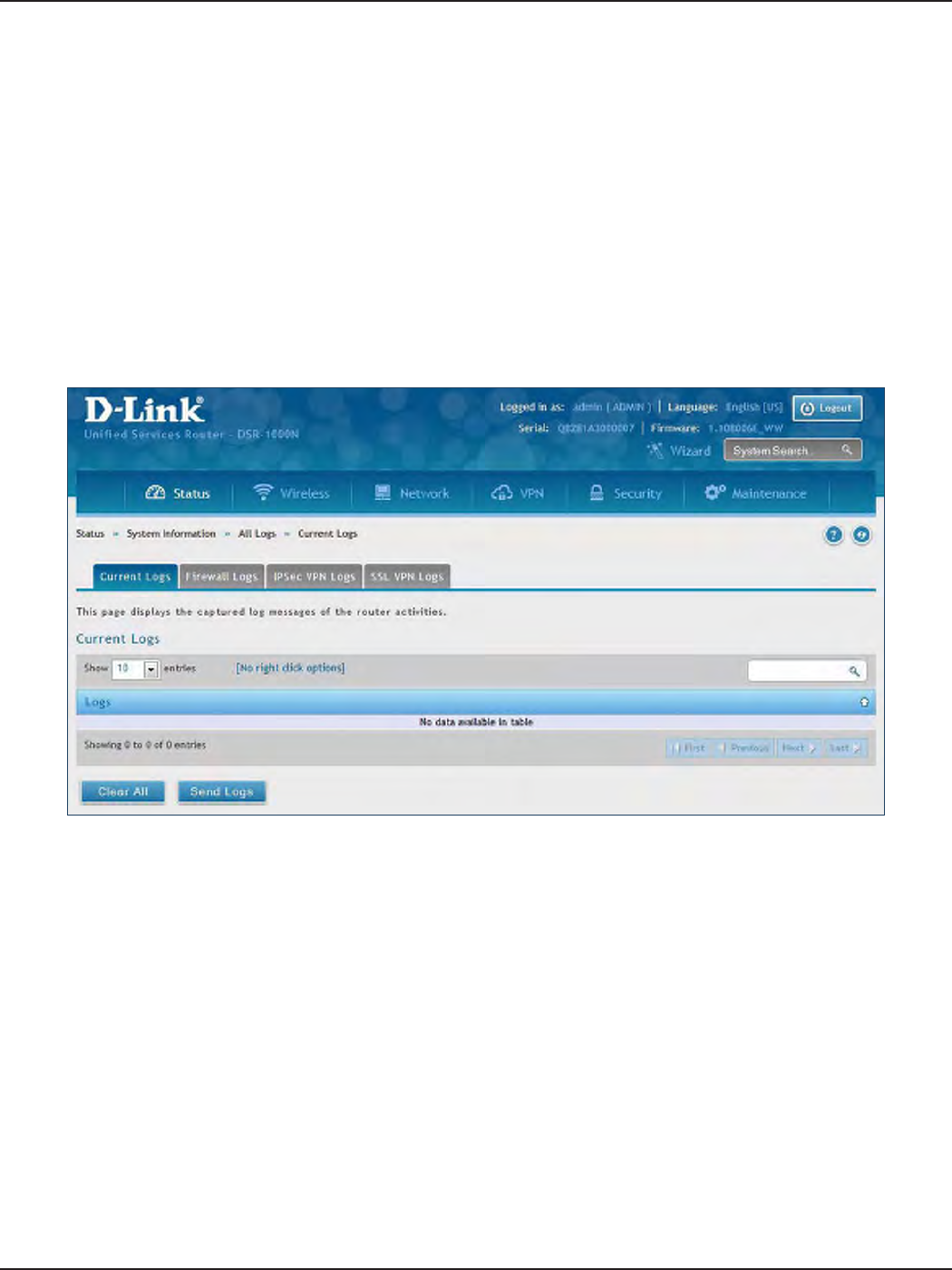
D-Link DSR-Series User Manual 208
Section 10 - Status and Statistics
All Logs
Current Logs
Path: Status > System Information > All Logs > Current Logs
The Current Logs window displays congured log messages from the router as they appear. Each log will appear
with a timestamp as determined by the router's congured time. If remote logging such as a Syslog server or
e-mail logging is congured, the same logs are sent to the remote interface while being displayed here.
Click Clear All to remove all entries in the Display Logs screen or click Send Logs to send all logs in the Current
Logs screen to precongured e-mail recipients.
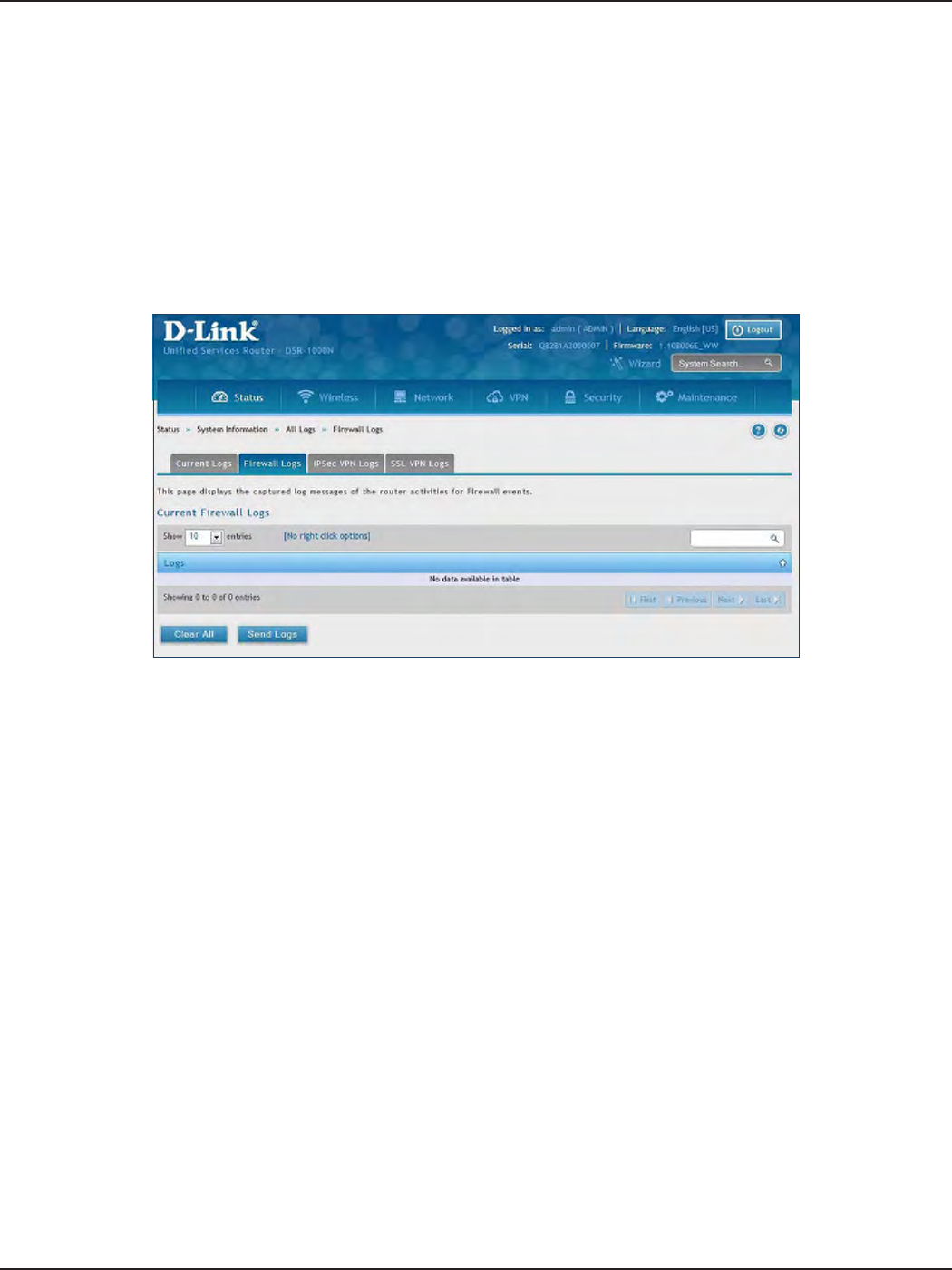
D-Link DSR-Series User Manual 209
Section 10 - Status and Statistics
Firewall Logs
Path: Status > System Information > All Logs > Firewall Logs
The Firewall Logs window displays congured rewall event messages from the router as they appear. Each log
will appear with a timestamp as determined by the router's congured time.
Click Clear All to remove all entries in the Display Logs screen or click Send Logs to send all logs in the Current
Logs screen to precongured e-mail recipients.
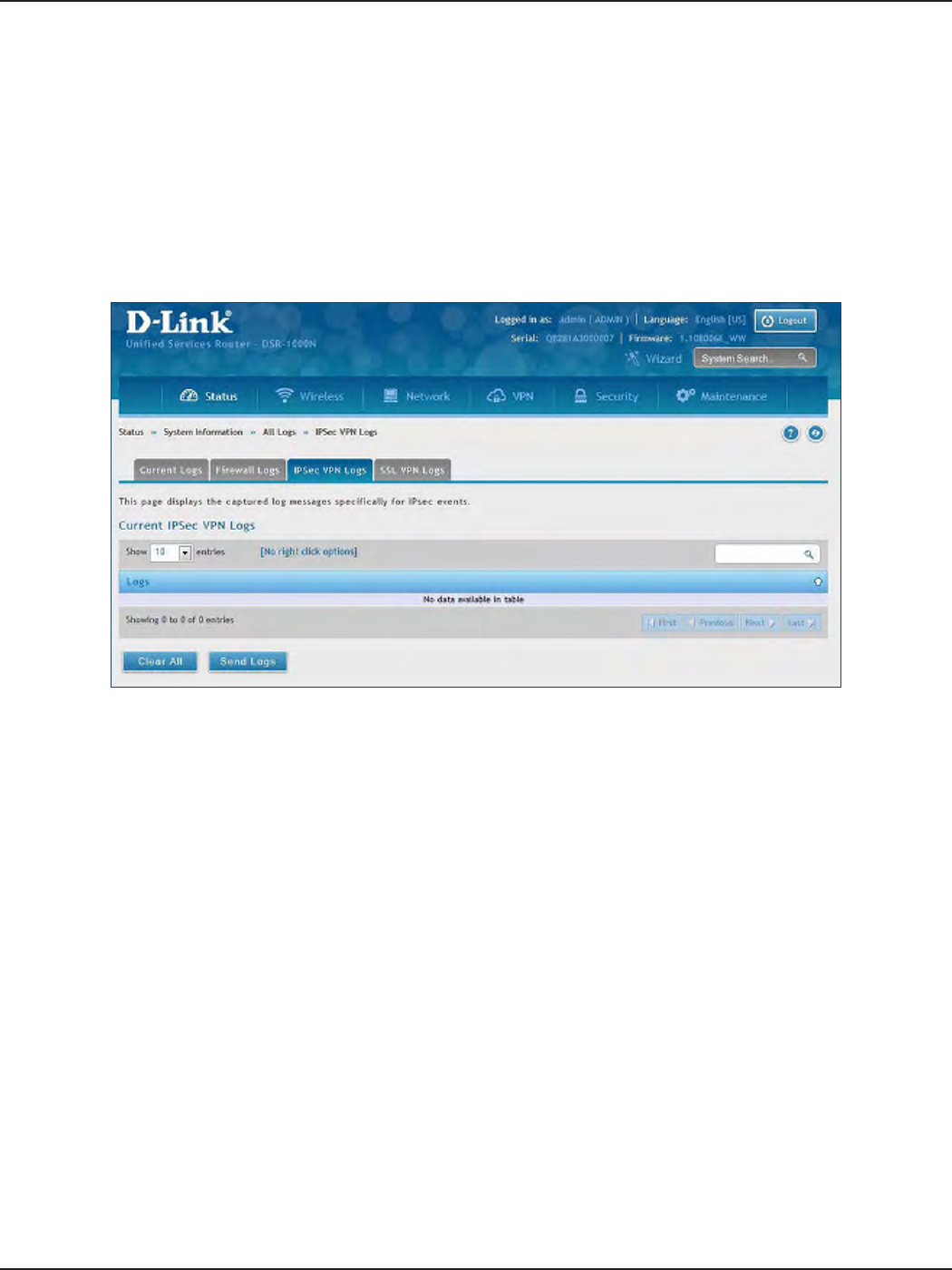
D-Link DSR-Series User Manual 210
Section 10 - Status and Statistics
IPSec VPN Logs
Path: Status > System Information > All Logs > IPSec VPN Logs
The IPSec VPN Logs window displays IPSec VPN event messages from the router as they appear. Each log will
appear with a timestamp as determined by the router's congured time.
Click Clear All to remove all entries in the Display Logs screen or click Send Logs to send all logs in the Current
Logs screen to precongured e-mail recipients.
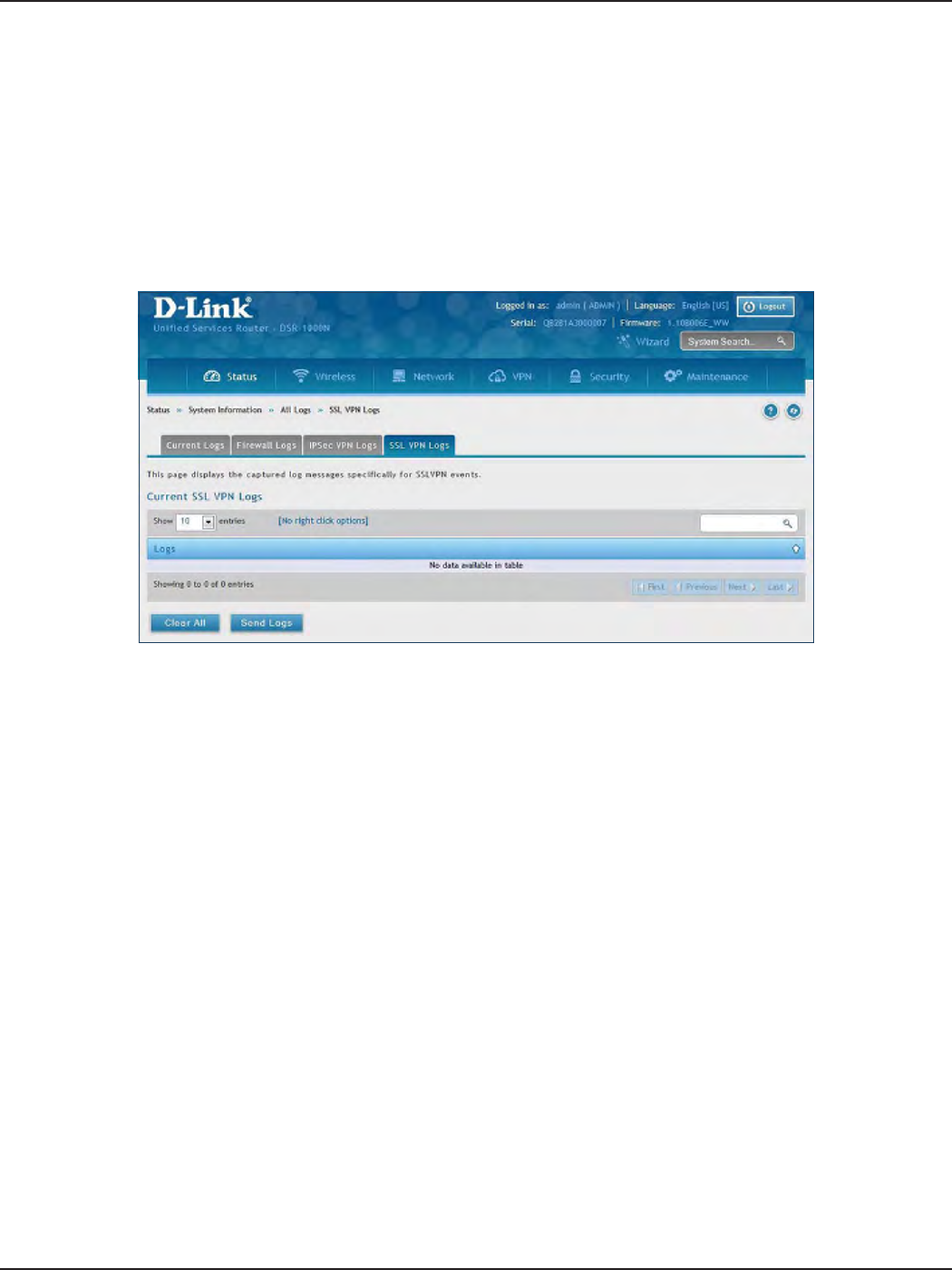
D-Link DSR-Series User Manual 211
Section 10 - Status and Statistics
SSL VPN Logs
Path: Status > System Information > All Logs > SSL VPN Logs
The SSL VPN Logs window displays SSL VPN event messages from the router as they appear. Each log will appear
with a timestamp as determined by the router's congured time.
Click Clear All to remove all entries in the Display Logs screen or click Send Logs to send all logs in the Current
Logs screen to precongured e-mail recipients.
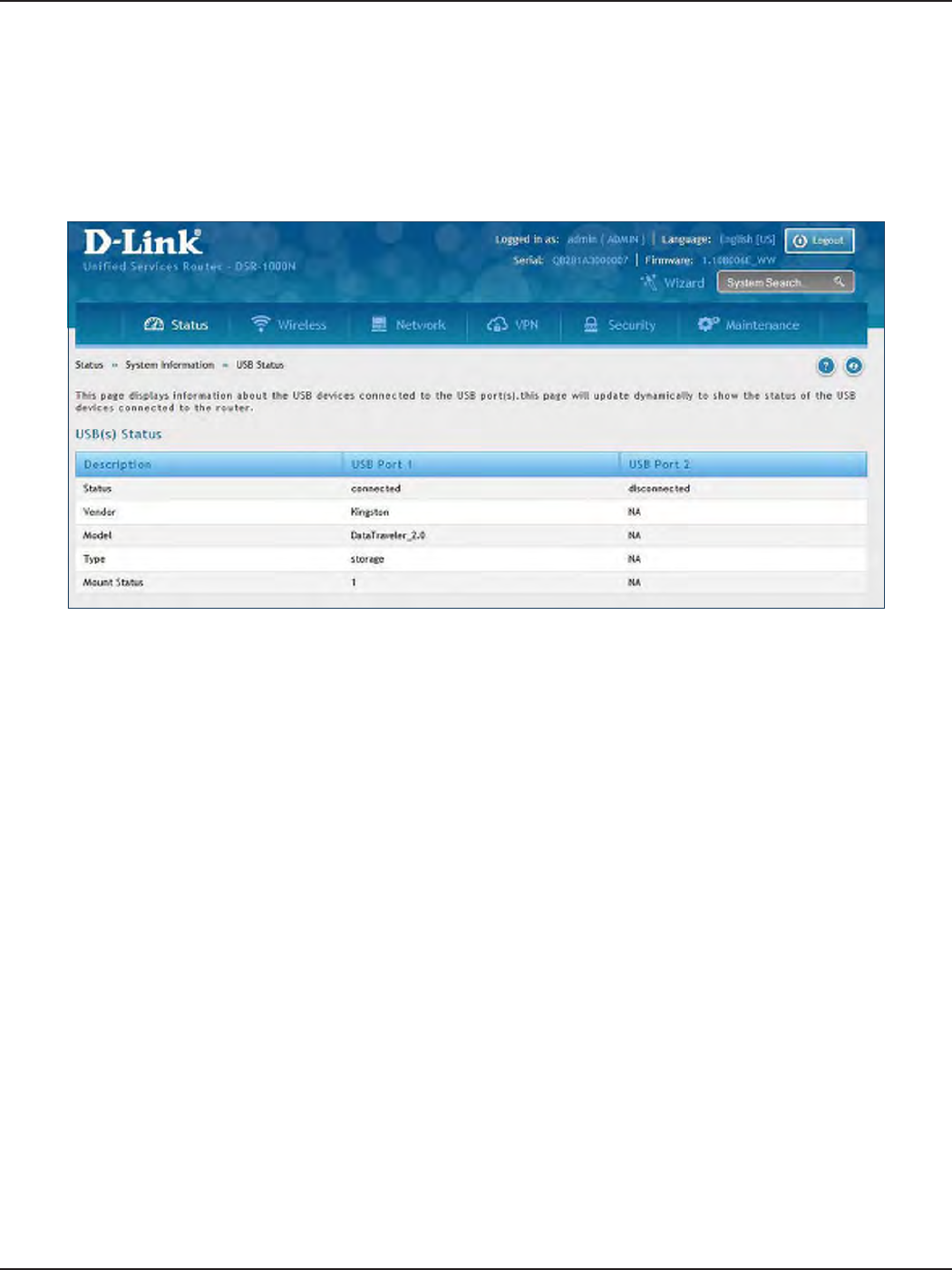
D-Link DSR-Series User Manual 212
Section 10 - Status and Statistics
USB Status
Path: Status > System Information > USB Status
The USB Status page summarizes the USB devices connected to the router. You may connect USB printer and
USB storage device directly to the router.
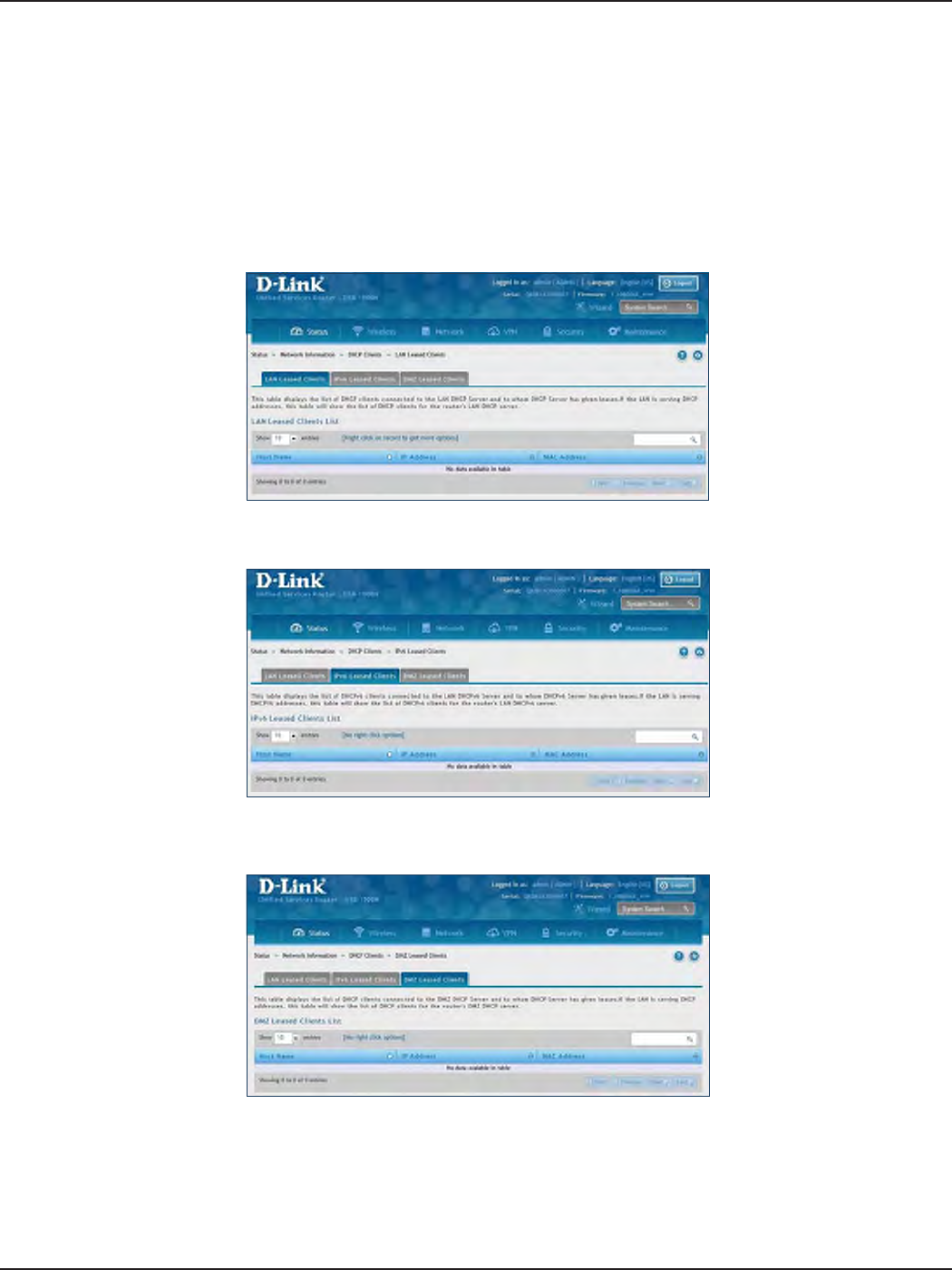
D-Link DSR-Series User Manual 213
Section 10 - Status and Statistics
Network Information
DHCP Leased Clients
Path: Status > Network Information > DHCP Clients
Three separated tabs display a list of clients whom get IP leased from the router: LAN leased clients, IPv6 leased
clients, and DMZ leased clients.
LAN Leased Clients
IPv6 Leased Clients
DMZ Leased Clients
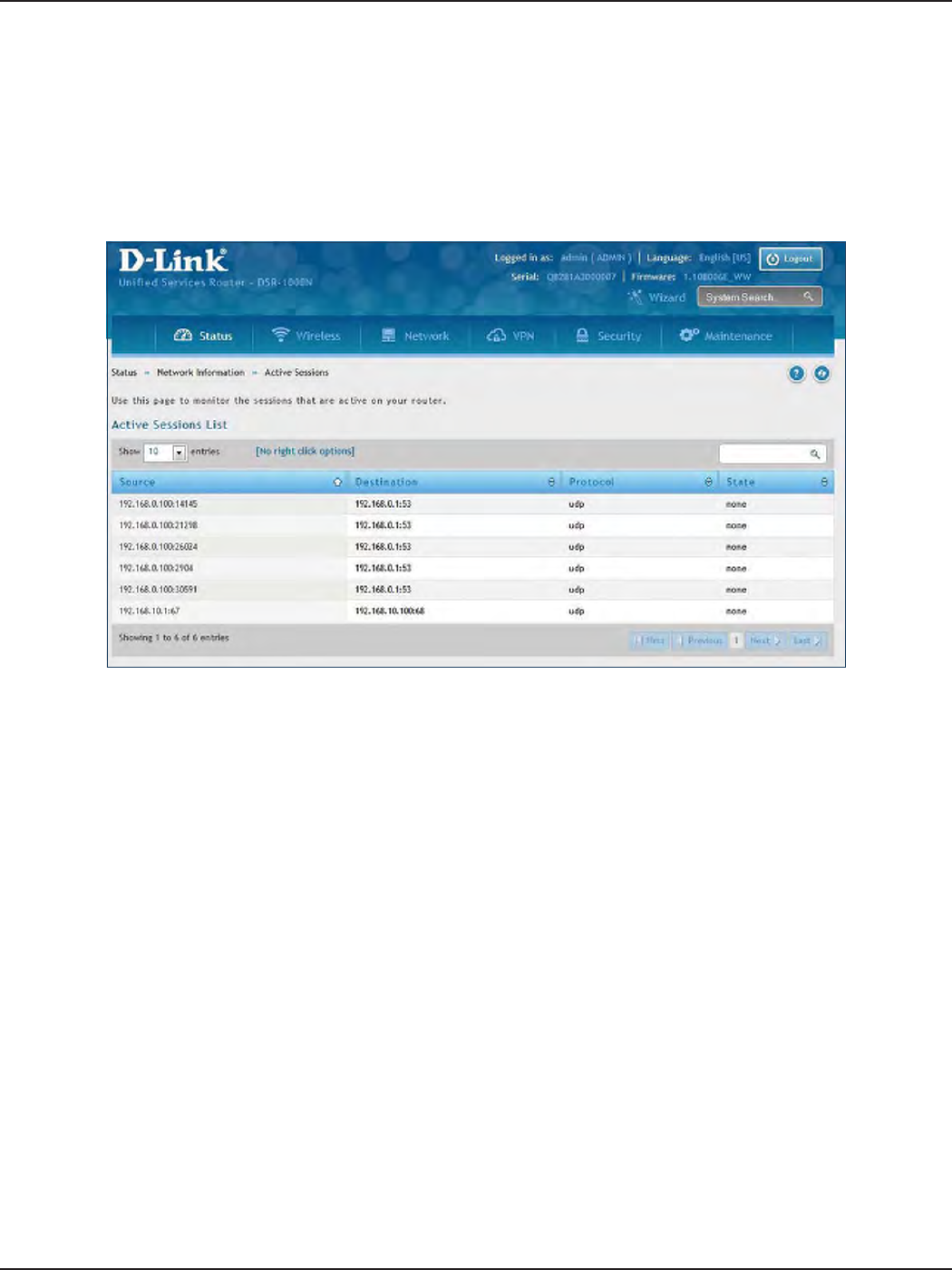
D-Link DSR-Series User Manual 214
Section 10 - Status and Statistics
Path: Status > Network Information > Active Sessions
This table lists the active internet sessions through the router’s rewall. The session’s protocol, state, local, and
remote IP addresses are shown.
Active Sessions
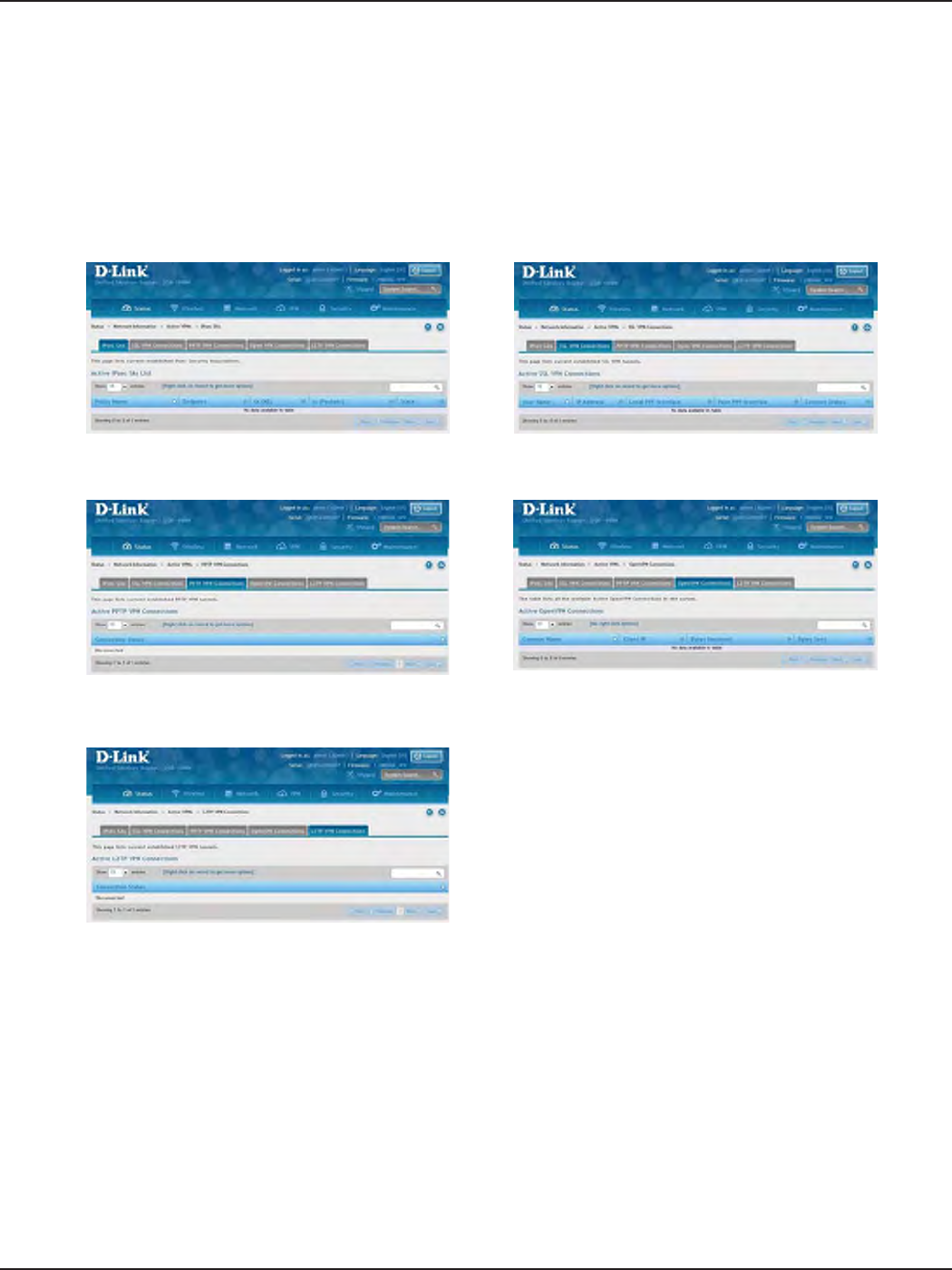
D-Link DSR-Series User Manual 215
Section 10 - Status and Statistics
Path: Status > Network Information > Active VPNs
You can view and change the status (connect or drop) of the router’s VPN associations/connections. Here, the
active VPN associations/connections are listed along with the trac details and tunnel state. The trac is a
cumulative measure of transmitted/received packets since the tunnel was established.
Active VPNs
IPSec SAs
PPTP VPN Connections
L2TP VPN Connections
SSL VPN Connections
OpenVPN Connections
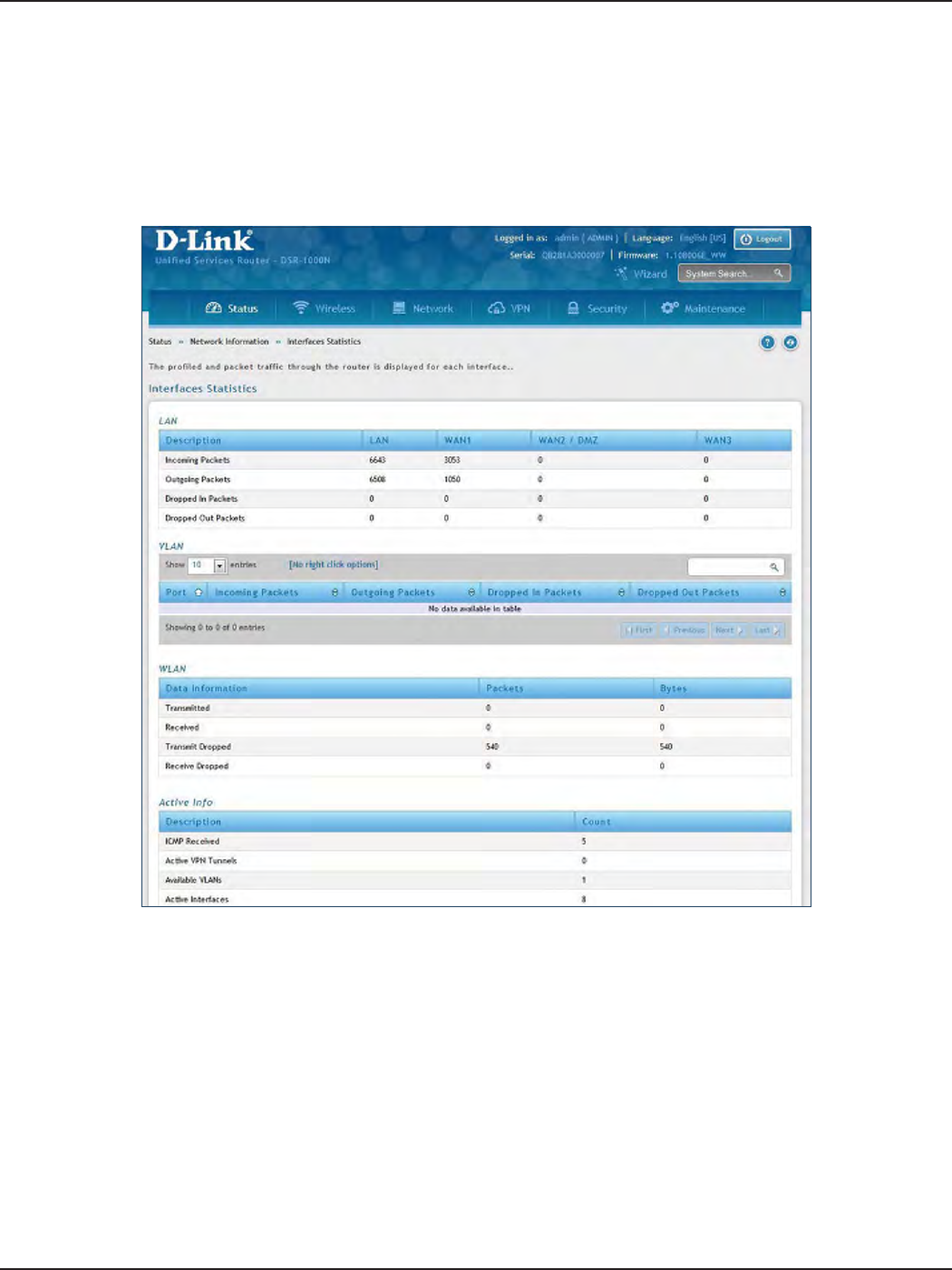
D-Link DSR-Series User Manual 216
Section 10 - Status and Statistics
Path: Status > Network Information > Interfaces Statistics
This page displays packet information on the LAN, VLAN, and WLAN interfaces.
Interface Statistics
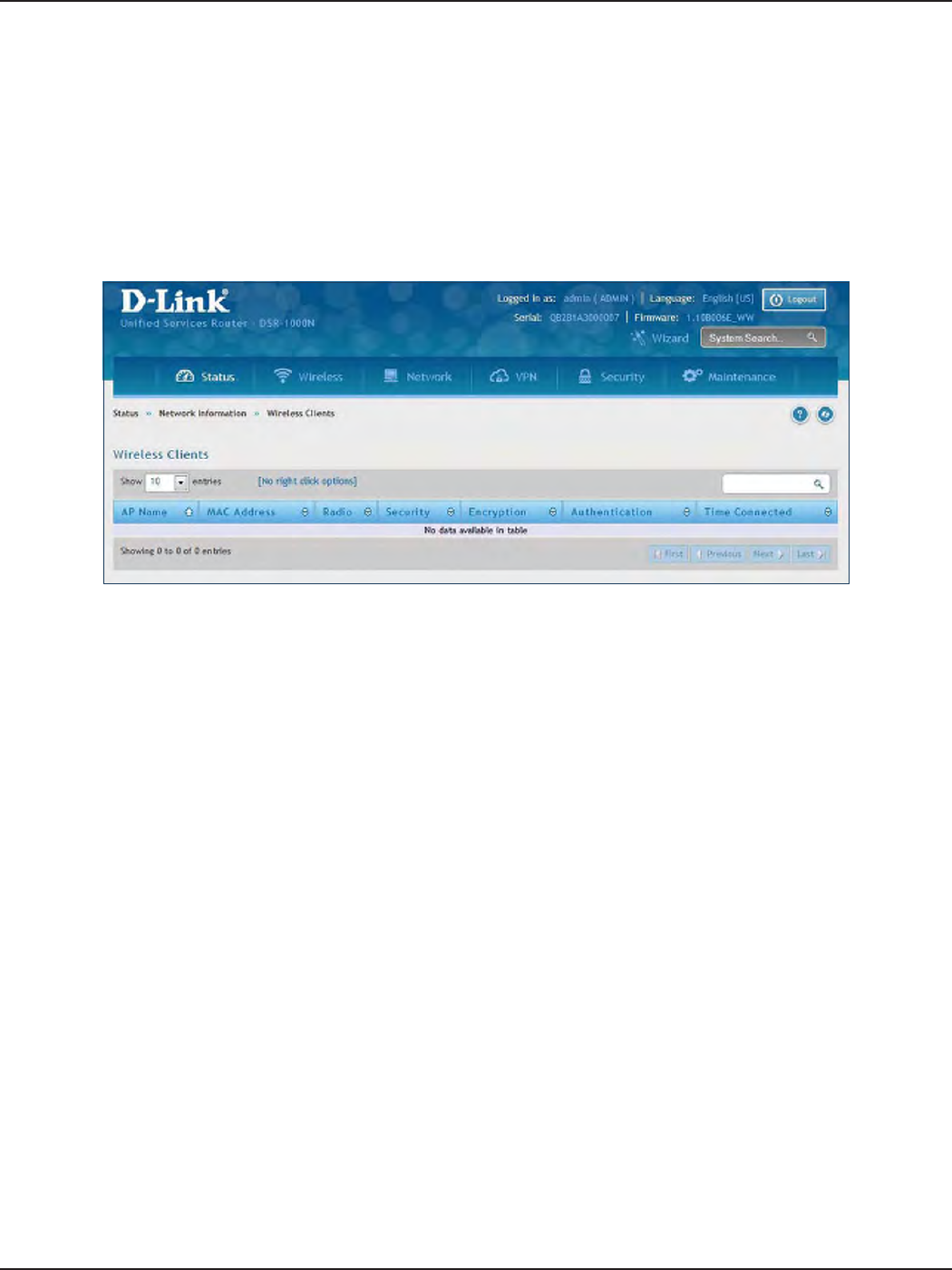
D-Link DSR-Series User Manual 217
Section 10 - Status and Statistics
Path: Status > Network Information > Wireless Clients
The clients connected to a particular AP can be viewed on this page. Connected clients are sorted by the MAC
address and indicate the security parameters used by the wireless link, as well as the time connected to the
corresponding AP. The statistics table has auto-refresh control which allows display of the most current port level
data at each page refresh. The default auto-refresh for this page is 10 seconds.
View Wireless Clients
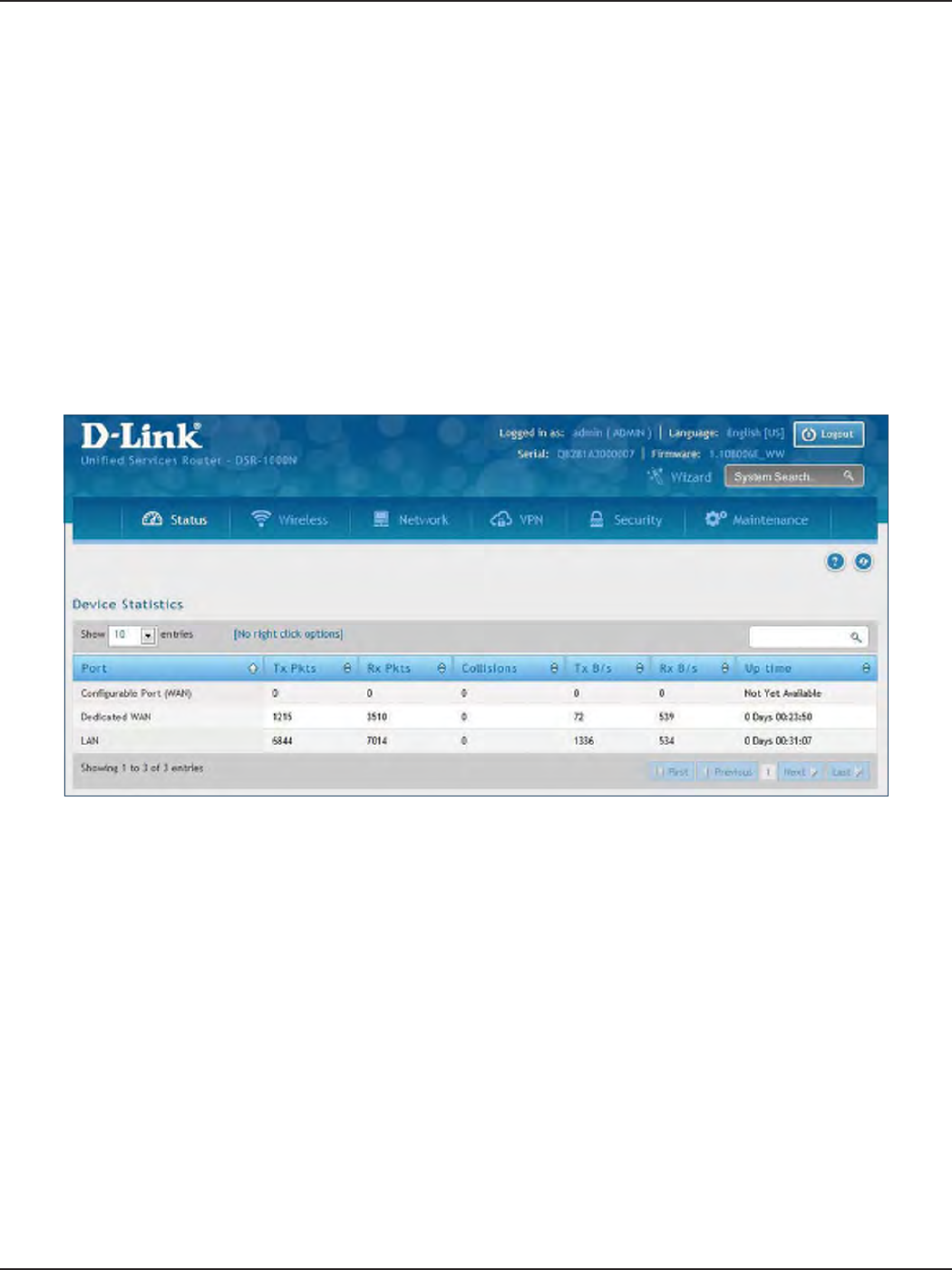
D-Link DSR-Series User Manual 218
Section 10 - Status and Statistics
Path: Status > Network Information > Device Stats
Detailed transmit and receive statistics for each physical port are presented here. Each interface (WAN1, WAN2/
DMZ, LAN, and VLANs) have port specic packet level information provided for review. Transmitted/received
packets, port collisions, and the cumulating bytes/sec for transmit/receive directions are provided for each
interface along with the port up time. If you suspect issues with any of the wired ports, this table will help
diagnose uptime or transmit level issues with the port.
The statistics table has auto-refresh control which allows display of the most current port level data at each page
refresh. The default auto-refresh for this page is 10 seconds.
Device Stats
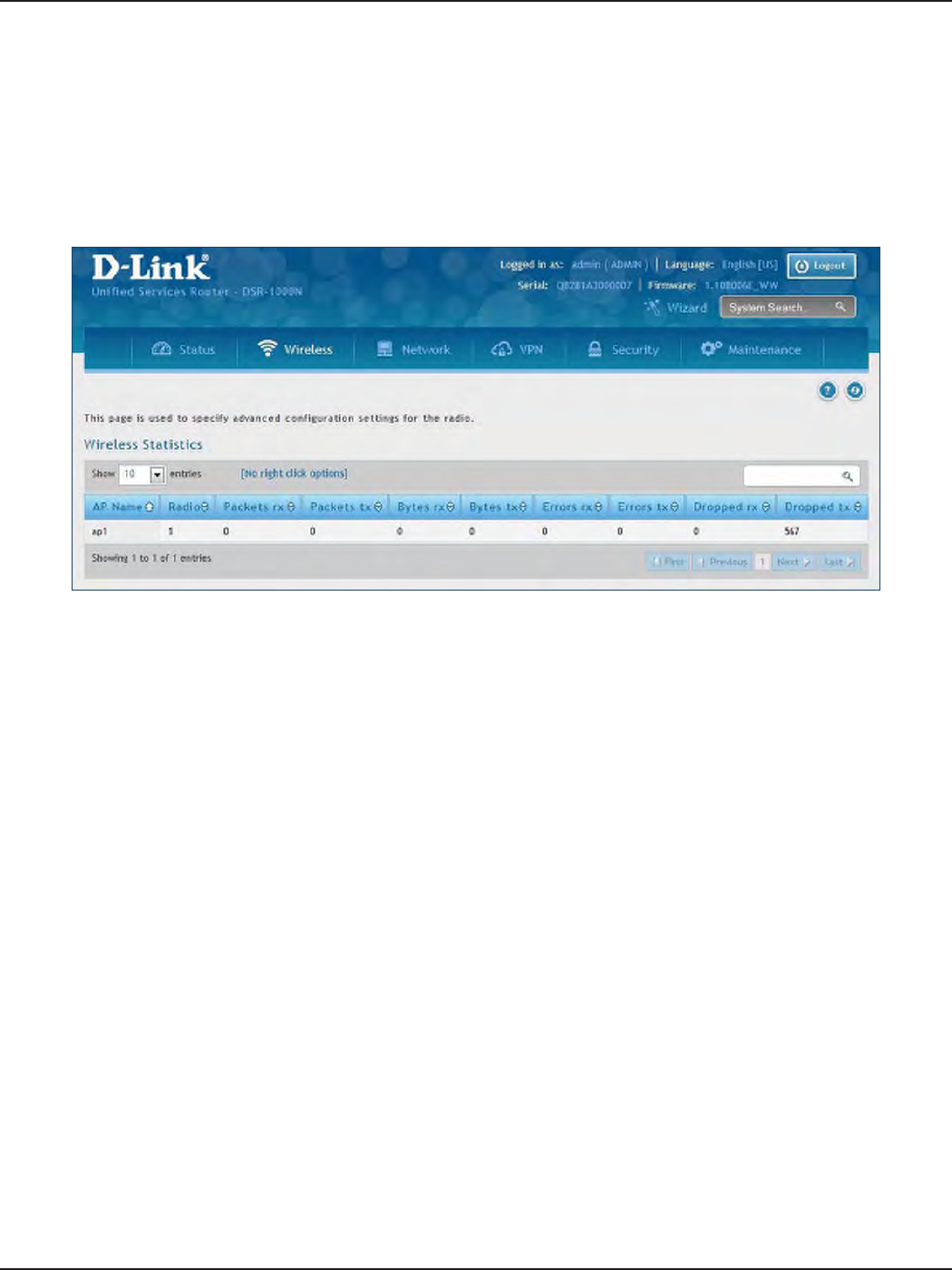
D-Link DSR-Series User Manual 219
Section 10 - Status and Statistics
Path: Status > Network Information > Wireless Statistics
The Wireless Statistics page displays the incrementing trac statistics for each enabled access point. This page
will give a snapshot of how much trac is being transmitted over each wireless link. If you suspect that a radio
or VAP may be down, the details on this page would conrm if trac is being sent and received through the VAP.
Wireless Statistics
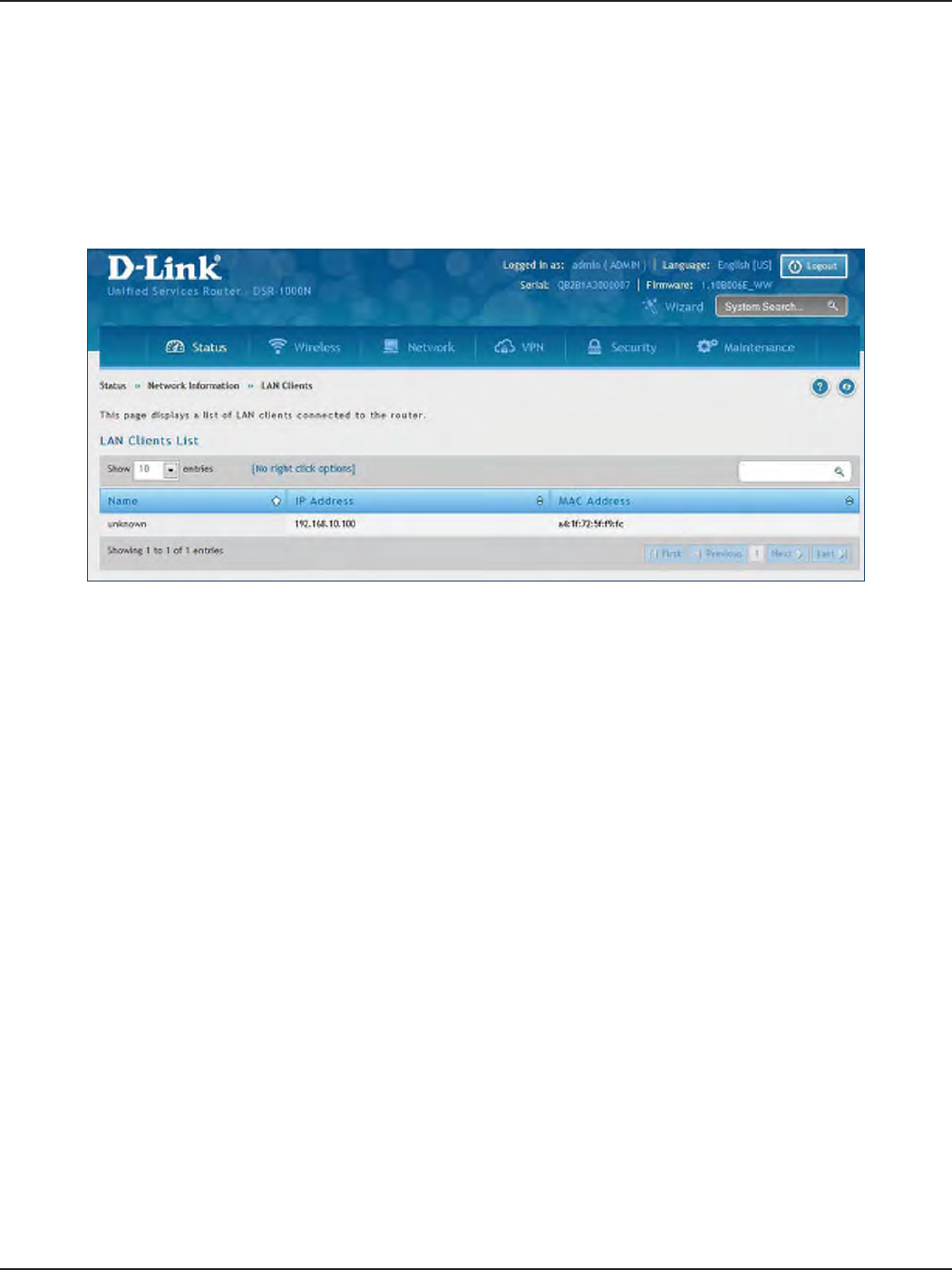
D-Link DSR-Series User Manual 220
Section 10 - Status and Statistics
Path: Status > Network Information > LAN Clients
The LAN clients to the router are identied by an ARP scan through the LAN switch. The NetBIOS name (if
available), IP address, and MAC address of discovered LAN hosts are displayed.
View LAN Clients

D-Link DSR-Series User Manual 221
Section 11 - Troubleshooting
Troubleshooting
Symptom: You cannot access the router’s web-conguration interface from a PC on your LAN.
Recommended action:
1. Check the Ethernet connection between the PC and the router.
2. Ensure that your PC’s IP address is on the same subnet as the router. If you are using the recommended
addressing scheme, your PC’s address should be in the range 192.168.10.2 to 192.168.10.254.
3. Check your PC’s IP address. If the PC cannot reach a DHCP server, some versions of Windows and
Mac OS generate and assign an IP address. These auto-generated addresses are in the range
169.254.x.x. If your IP address is in this range, check the connection from the PC to the rewall and
reboot your PC.
4. If your router’s IP address has changed and you don’t know what it is, reset the router conguration
to factory defaults (this sets the rewall’s IP address to 192.168.10.1).
5. If you do not want to reset to factory default settings and lose your conguration, reboot the
router and use a packet snier (such as Ethereal™) to capture packets sent during the reboot. Look
at the Address Resolution Protocol (ARP) packets to locate the router’s LAN interface address.
6. Launch your browser and ensure that Java, JavaScript, or ActiveX is enabled. If you are using
Internet Explorer, click Refresh to ensure that the Java applet is loaded. Close the browser and
launch it again.
7. Ensure that you are using the correct login information. The factory default login name is admin
and the password is password. Ensure that CAPS LOCK is o when entering this information.
Symptom: Router does not save conguration changes.
Recommended action:
1. When entering conguration settings, click Apply before moving to another menu or tab;
otherwise your changes are lost.
2. Click Refresh or Reload in the browser. Your changes may have been made, but the browser may
be caching the old conguration.
Symptom: Router cannot access the Internet.
Possible cause: If you use dynamic IP addresses, your router may not have requested an IP address from the ISP.
Recommended action:
1. Launch your browser and go to an external site such as www.google.com.
2. Access the rewall’s conguration main menu at http://192.168.10.1.
3. Select Monitoring > Router Status.
4. Ensure that an IP address is shown for the WAN port. If 0.0.0.0 is shown, your rewall has not
obtained an IP address from your ISP. See the next symptom.
Internet Connection

D-Link DSR-Series User Manual 222
Section 11 - Troubleshooting
Symptom: Router cannot obtain an IP address from the ISP.
Recommended action:
1. Turn o power to the cable or DSL modem.
2. Turn o the router.
3. Wait ve minutes, and then reapply power to the cable or DSL modem.
4. When the modem LEDs indicate that it has resynchronized with the ISP, reapply power to the
router. If the router still cannot obtain an ISP address, see the next symptom.
Symptom: Router still cannot obtain an IP address from the ISP.
Recommended action:
1. Ask your ISP if it requires a login program — PPP over Ethernet (PPPoE) or some other type of login.
2. If yes, verify that your congured login name and password are correct.
3. Ask your ISP if it checks for your PC’s hostname.
4. If yes, select Network Conguration > WAN Settings > Ethernet ISP Settings and set the account
name to the PC hostname of your ISP account.
5. Ask your ISP if it allows only one Ethernet MAC address to connect to the Internet, and therefore
checks for your PC’s MAC address.
6. If yes, inform your ISP that you have bought a new network device, and ask them to use the rewall’s
MAC address.
7. Alternatively, select Network Conguration > WAN Settings > Ethernet ISP Settings and congure
your router to spoof your PC’s MAC address.
Symptom: Router can obtain an IP address, but PC is unable to load Internet pages.
Recommended action:
1. Ask your ISP for the addresses of its designated Domain Name System (DNS) servers. Congure
your PC to recognize those addresses. For details, see your operating system documentation.
2. On your PC, congure the router to be its TCP/IP gateway.

D-Link DSR-Series User Manual 223
Section 11 - Troubleshooting
Date and time
Symptom: Date shown is January 1, 1970.
Possible cause: The router has not yet successfully reached a network time server (NTS).
Recommended action:
1. If you have just congured the router, wait at least ve minutes, select Administration > Time Zone,
and recheck the date and time.
2. Verify your Internet access settings.
Symptom: Time is o by one hour.
Possible cause: The router does not automatically adjust for Daylight Savings Time.
Recommended action:
1. Select Administration > Time Zone and view the current date and time settings.
2. Click to check or uncheck “Automatically adjust for Daylight Savings Time”, then click Apply.

D-Link DSR-Series User Manual 224
Section 11 - Troubleshooting
Pinging to Test LAN Connectivity
Most TCP/IP terminal devices and rewalls contain a ping utility that sends an ICMP echo-request packet to the
designated device. The DSR responds with an echo reply. Troubleshooting a TCP/IP network is made very easy by
using the ping utility in your PC or workstation.
Testing the LAN path from your PC to your router
1. From the PC’s Windows toolbar, Click Start and in the search box at the bottom, type cmd and
press Enter.
2. At the prompt, type ping <IP_address> where <IP_address> is the router’s IP address. Example:
ping 192.168.10.1.
3. Press Enter.
4. Observe the display:
• If the path is working, you will see this message sequence:
Pinging <IP address> with 32 bytes of data
Reply from <IP address>: bytes=32 time=NN ms TTL=xxx
• If the path is not working, you will see this message sequence:
Pinging <IP address> with 32 bytes of data
Request timed out
5. If the path is not working, Test the physical connections between PC and router:
• If the LAN port LED is o, go to the “LED displays” section on your Install Guide and follow
instructions for “LAN or Internet port LEDs are not lit.”
• Verify that the corresponding link LEDs are lit for your network interface card and for any
hub ports that are connected to your workstation and rewall.
6. If the path is still not up, test the network conguration:
• Verify that the Ethernet card driver software and TCP/IP software are installed and
congured on the PC.
• Verify that the IP address for the router and PC are correct and on the same subnet.

D-Link DSR-Series User Manual 225
Section 11 - Troubleshooting
1. From the PC’s Windows toolbar, Click Start and in the search box at the bottom, type cmd and
press Enter.
2. Type ping -n 10 <IP_address> where -n 10 species a maximum of 10 tries and <IP address> is
the IP address of a remote device such as your ISP’s DNS server. Example: ping -n 10 10.1.1.1.
3. Press Enter and then observe the display (see the previous procedure).
4. If the path is not working, do the following:
• Check that the PC has the IP address of your rewall listed as the default gateway. (If the
IP conguration of your PC is assigned by DHCP, this information is not visible in your PC’s
Network Control Panel.)
• Verify that the network (subnet) address of your PC is dierent from the network address
of the remote device.
• Verify that the cable or DSL modem is connected and functioning.
• Ask your ISP if it assigned a hostname to your PC. If yes, select Network Conguration >
WAN Settings > Ethernet ISP Settings and enter that hostname as the ISP account name.
• Ask your ISP if it rejects the Ethernet MAC addresses of all but one of your PCs.
Many broadband ISPs restrict access by allowing trac from the MAC address of only your
broadband modem; but some ISPs additionally restrict access to the MAC address of just a single
PC connected to that modem. If this is the case, congure your rewall to clone or spoof the MAC
address from the authorized PC.
Testing the LAN path from your PC to a remote device

D-Link DSR-Series User Manual 226
Section 11 - Troubleshooting
Restoring factory-default conguration settings
To restore factory-default conguration settings, do either of the following:
1. Do you know the account password and IP address?
• If yes, select Administration > Settings Backup & Upgrade and click default.
• If no, do the following:
On the rear panel of the router, press and hold the Reset button about 10 seconds, until
the test LED lights and then blinks. Release the button and wait for the router to reboot.
2. If the router does not restart automatically; manually restart it to make the default settings eective.
3. After a restore to factory defaults —whether initiated from the conguration interface or the Reset
button — the following settings apply:
• LAN IP address: 192.168.10.1
• Username: admin
• Password: admin
• DHCP server on LAN: enabled
• WAN port conguration: Get conguration via DHCP

D-Link DSR-Series User Manual 227
Appendix A - Glossary
Appendix A - Glossary
ARP Address Resolution Protocol. Broadcast protocol for mapping IP addresses to MAC addresses.
CHAP Challenge-Handshake Authentication Protocol. Protocol for authenticating users to an ISP.
DDNS Dynamic DNS. System for updating domain names in real time. Allows a domain name to be
assigned to a device with a dynamic IP address.
DHCP Dynamic Host Conguration Protocol. Protocol for allocating IP addresses dynamically so that
addresses can be reused when hosts no longer need them.
DNS
Domain Name System. Mechanism for translating H.323 IDs, URLs, or e-mail IDs into IP addresses.
Also used to assist in locating remote gatekeepers and to map IP addresses to hostnames of
administrative domains.
FQDN Fully qualied domain name. Complete domain name, including the host portion. Example:
serverA.companyA.com.
FTP File Transfer Protocol. Protocol for transferring les between network nodes.
HTTP Hypertext Transfer Protocol. Protocol used by web browsers and web servers to transfer les.
IKE Internet Key Exchange. Mode for securely exchanging encryption keys in ISAKMP as part of
building a VPN tunnel.
IPsec
IP security. Suite of protocols for securing VPN tunnels by authenticating or encrypting IP packets
in a data stream. IPsec operates in either transport mode (encrypts payload but not packet
headers) or tunnel mode (encrypts both payload and packet headers).
ISAKMP Internet Key Exchange Security Protocol. Protocol for establishing security associations and
cryptographic keys on the Internet.
ISP Internet service provider.
MAC Address Media-access-control address. Unique physical-address identier attached to a network adapter.
MTU Maximum transmission unit. Size, in bytes, of the largest packet that can be passed on. The MTU
for Ethernet is a 1500-byte packet.
NAT
Network Address Translation. Process of rewriting IP addresses as a packet passes through a
router or rewall. NAT enables multiple hosts on a LAN to access the Internet using the single
public IP address of the LAN’s gateway router.
NetBIOS Microsoft Windows protocol for le sharing, printer sharing, messaging, authentication, and
name resolution.
NTP Network Time Protocol. Protocol for synchronizing a router to a single clock on the network,
known as the clock master.
PAP Password Authentication Protocol. Protocol for authenticating users to a remote access server or
ISP.

D-Link DSR-Series User Manual 228
Appendix A - Glossary
PPPoE Point-to-Point Protocol over Ethernet. Protocol for connecting a network of hosts to an ISP
without the ISP having to manage the allocation of IP addresses.
PPTP Point-to-Point Tunneling Protocol. Protocol for creation of VPNs for the secure transfer of data
from remote clients to private servers over the Internet.
RADIUS Remote Authentication Dial-In User Service. Protocol for remote user authentication and
accounting. Provides centralized management of usernames and passwords.
RSA Rivest-Shamir-Adleman. Public key encryption algorithm.
TCP Transmission Control Protocol. Protocol for transmitting data over the Internet with guaranteed
reliability and in-order delivery.
UDP User Data Protocol. Protocol for transmitting data over the Internet quickly but with no
guarantee of reliability or in-order delivery.
VPN
Virtual private network. Network that enables IP trac to travel securely over a public TCP/IP
network by encrypting all trac from one network to another. Uses tunneling to encrypt all
information at the IP level.
WINS
Windows Internet Name Service. Service for name resolution. Allows clients on dierent IP
subnets to dynamically resolve addresses, register themselves, and browse the network without
sending broadcasts.
XAUTH
IKE Extended Authentication. Method, based on the IKE protocol, for authenticating not just
devices (which IKE authenticates) but also users. User authentication is performed after device
authentication and before IPsec negotiation.

D-Link DSR-Series User Manual 229
Appendix B - Factory Default Settings
Appendix B - Factory Default Settings
Feature Description Default Settings
Device Login
User Login URL http://192.168.10.1
User Name admin
Password admin
Internet Connection
WAN MAC Address Use default address
WAN MTU size 1500
Port Speed Autosense
Local Area Network (LAN)
IP Address 192.168.10.1
IPv4 Subnet Mask 255.255.255.0
RIP Direction None
RIP Version Disabled
RIP Authentication Disabled
DHCP Server Enabled
DHCP Starting IP Address 192.168.10.2
DHCP Ending IP Address 192.168.10.100
Time Zone GMT
Daylight Saving Time Disabled
SNMP Disabled
Remote Management Disabled
Firewall
Inbound Communication from Internet Disabled (except Port 80 HTTP)
Outbound Communication to Internet Enabled (all)
Source MAC Filtering Disabled
Stealth Mode Enabled

D-Link DSR-Series User Manual 230
Appendix C - Standard Services Available for Port Forwarding & Firewall Conguration
Appendix C - Standard Services for Port
Forwarding & Firewall Conguration
• ANY
• AIM
• BGP
• BOOTP_CLIENT
• BOOTP_SERVER
• CU-SEEME:UDP
• CU-SEEME:TCP
• DNS:UDP
• DNS:TCP
• FINGER
• FTP
• HTTP
• HTTPS
• ICMP-TYPE-3
• ICMP-TYPE-4
• ICMP-TYPE-5
• ICMP-TYPE-6
• ICMP-TYPE-7
• ICMP-TYPE-8
• ICMP-TYPE-9
• ICMP-TYPE-10
• ICMP-TYPE-11
• ICMP-TYPE-13
• ICQ
• IMAP2
• IMAP3
• IRC
• NEWS
• NFS
• NNTP
• PING
• POP3
• PPTP
• RCMD
• REAL-AUDIO
• REXEC
• RLOGIN
• RTELNET
• RTSP:TCP
• RTSP:UDP
• SFTP
• SMTP
• SNMP:TCP
• SNMP:UDP
• SNMP-TRAPS:TCP
• SNMP-TRAPS:UDP
• SQL-NET
• SSH:TCP
• SSH:UDP
• STRMWORKS
• TACACS
• TELNET
• TFTP
• VDOLIVE

D-Link DSR-Series User Manual 231
Appendix D - Log Output Reference
Appendix D - Log Output Reference
Facility: System (Networking)
Log Message Severity Log Message Severity
DBUpdate event: Table: %s opCode:%d
rowId:%d DEBUG BridgeCong: too few arguments to
command %s ERROR
networkIntable.txt not found DEBUG BridgeCong: too few arguments to
command %s ERROR
sqlite3QueryResGet failed DEBUG sqlite3QueryResGet failed.Query:%s ERROR
Interface is already deleted in bridge DEBUG ddnsDisable failed ERROR
removing %s from bridge %s... %s DEBUG sqlite3QueryResGet failed.Query:%s ERROR
adding %s to bridge %s... %s DEBUG sqlite3QueryResGet failed.Query:%s ERROR
stopping bridge... DEBUG ddnsDisable failed ERROR
stopping bridge... DEBUG failed to call ddns enable ERROR
stopping bridge... DEBUG ddnsDisable failed ERROR
%s:DBUpdate event: Table: %s opCode:%d
rowId:%d DEBUG sqlite3QueryResGet failed.Query:%s ERROR
Wan is not up DEBUG Error in executing DB update handler ERROR
%s:DBUpdate event: Table: %s opCode:%d
rowId:%d DEBUG sqlite3QueryResGet failed.Query:%s ERROR
doDNS:failed DEBUG Illegal invocation of ddnsView (%s) ERROR
doDNS:failed DEBUG sqlite3QueryResGet failed.Query:%s ERROR
doDNS:Result = FAILED DEBUG sqlite3QueryResGet failed.Query:%s ERROR
doDNS:Result SUCCESS DEBUG ddns: SQL error: %s ERROR
Write Old Entry: %s %s %s: to %s DEBUG Illegal operation interface got deleted ERROR
Write New Entry: %s %s #%s : to %s DEBUG sqlite3QueryResGet failed.Query:%s ERROR
Write Old Entry: %s %s %s: to %s DEBUG sqlite3QueryResGet failed.Query:%s ERROR
Write New Entry: %s %s #%s : to %s DEBUG sqlite3QueryResGet failed.Query:%s ERROR
ifStaticMgmtDBUpdateHandler: returning
with “ DEBUG ddnsDisable failed ERROR
nimfLinkStatusGet: buer: \ DEBUG ddns: SQL error: %s ERROR
nimfLinkStatusGetErr: returning with
status: %d DEBUG Failed to call ddns enable ERROR
nimfAdvOptSetWrap: current Mac Option:
%d DEBUG ddns: SQL error: %s ERROR
nimfAdvOptSetWrap: current Port Speed
Option: %d DEBUG sqlite3QueryResGet failed.Query:%s ERROR
nimfAdvOptSetWrap: current Mtu Option:
%d DEBUG Failed to call ddns enable ERROR

D-Link DSR-Series User Manual 232
Appendix D - Log Output Reference
nimfAdvOptSetWrap: looks like we are
reconnecting. “ DEBUG ddns: SQL error: %s ERROR
nimfAdvOptSetWrap: Mtu Size: %d DEBUG ddnsDisable failed ERROR
nimfAdvOptSetWrap: NIMF table is %s DEBUG ddns: SQL error: %s ERROR
nimfAdvOptSetWrap:WAN_MODE
TRIGGER DEBUG sqlite3QueryResGet failed.Query:%s ERROR
nimfAdvOptSetWrap: MTU: %d DEBUG Failed to call ddns enable ERROR
nimfAdvOptSetWrap: MacAddress: %s DEBUG ddns: SQL error: %s ERROR
nimfAdvOptSetWrap: old Mtu Flag: %d DEBUG ddnsDisable failed ERROR
nimfAdvOptSetWrap: user has changed
MTU option DEBUG ddns: SQL error: %s ERROR
nimfAdvOptSetWrap: MTU: %d DEBUG sqlite3QueryResGet failed.Query:%s ERROR
nimfAdvOptSetWrap: old MTU size: %d DEBUG sqlite3QueryResGet failed.Query:%s ERROR
nimfAdvOptSetWrap: old Port Speed
Option: %d DEBUG ddnsDisable failed ERROR
nimfAdvOptSetWrap: old Mac Address
Option: %d DEBUG ddns: SQL error: %s ERROR
nimfAdvOptSetWrap: MacAddress: %s DEBUG sqlite3QueryResGet failed.Query:%s ERROR
Setting LED [%d]:[%d] For %s DEBUG sqlite3QueryResGet failed.Query:%s ERROR
l2tpEnable: command string: %s DEBUG ddnsDisable failed ERROR
nimfAdvOptSetWrap: handling reboot
scenario DEBUG failed to call ddns enable ERROR
nimfAdvOptSetWrap: INDICATOR = %d DEBUG ddns: SQL error: %s ERROR
nimfAdvOptSetWrap: UpdateFlag: %d DEBUG ddnsDisable failed ERROR
nimfAdvOptSetWrap: returning with
status: %s DEBUG sqlite3QueryResGet failed.Query:%s ERROR
nimfGetUpdateMacFlag: MacTable Flag
is: %d DEBUG Error in executing DB update handler ERROR
nimfMacGet: Mac Option changed DEBUG Failed to open the resolv.conf le.
Exiting./n ERROR
nimfMacGet: Update Flag: %d DEBUG Could not write to the resolv.conf le.
Exiting. ERROR
nimfMacGet: MacAddress: %s DEBUG Error opening the lanUptime File ERROR
nimfMacGet: MacAddress: %s DEBUG Error Opening the lanUptime File. ERROR
nimfMacGet: MacAddress: %s DEBUG failed to open %s ERROR
nimfMacGet: MacAddress: %s DEBUG failed to open %s ERROR
nimfMacGet: MacAddress: %s DEBUG failed to query networkInterface table ERROR
nimfMacGet:Mac option Not changed \ DEBUG failed to query networkInterface table ERROR
nimfMacGet: MacAddress: %s DEBUG sqlite3QueryResGet failed.Query:%s ERROR

D-Link DSR-Series User Manual 233
Appendix D - Log Output Reference
nimfMacGet: MacAddress: %s DEBUG failed to enable IPv6 forwarding ERROR
nimfMacGet: MacAddress: %s DEBUG failed to set capabilities on the “ ERROR
nimfMacGet: returning with status: %s DEBUG failed to enable IPv6 forwarding ERROR
Now in enableing LanBridge function DEBUG failed to set capabilities on the “ ERROR
sucessfully executed the command %s DEBUG failed to disable IPv6 forwarding ERROR
Now in disableing LanBridge function DEBUG failed to set capabilities on the “ ERROR
sucessfully executed the command %s DEBUG failed to open %s ERROR
congPortTblHandler:Now we are in
Sqlite Update “ DEBUG Could not create ISATAP Tunnel ERROR
The Old Conguration of ConPort
was:%s DEBUG Could not destroy ISATAP Tunnel ERROR
The New Conguration of ConPort
was:%s DEBUG Could not congure ISATAP Tunnel ERROR
The user has deselected the congurable
port DEBUG Could not de-congure ISATAP Tunnel ERROR
failed query %s DEBUG nimfStatusUpdate: updating
NimfStatus failed ERROR
failed query %s DEBUG nimfStatusUpdate: updating
NimfStatus failed ERROR
failed query %s DEBUG nimfLinkStatusGet: determinig link’s
status failed ERROR
%s:DBUpdate event: Table: %s opCode:%d
rowId:%d DEBUG nimfLinkStatusGet: opening status le
failed ERROR
%s:DBUpdate event: Table: %s opCode:%d
rowId:%d DEBUG Failed to commit ERROR
%s:%d SIP ENABLE: %s DEBUG ifStatusDBUpdate: Failed to begin “ ERROR
sipTblHandler:failed to update ifStatic DEBUG %s: SQL error: %s ERROR
sipTblHandler:failed to update Congport DEBUG %s: Failed to commit “ ERROR
%s:%d SIP DISABLE: %s DEBUG nimfNetIfaceTblHandler: unable to get
LedPinId ERROR
%s:%d SIP SET CONF: %s DEBUG nimfNetIfaceTblHandler: unable to get
LedPinId ERROR
Failed to open %s: %s DEBUG nimfNetIfaceTblHandler: unable to get
LedPinId ERROR
Failed to start sipalg DEBUG %s: unable to kill dhclient ERROR
Failed to stop sipalg DEBUG nimfAdvOptSetWrap: unable to get
current Mac Option ERROR

D-Link DSR-Series User Manual 234
Appendix D - Log Output Reference
Failed to get cong info DEBUG nimfAdvOptSetWrap: unable to get
current Port “ ERROR
Network Mask: 0x%x DEBUG nimfAdvOptSetWrap: unable to get
current MTU Option ERROR
RTP DSCP Value: 0x%x DEBUG nimfAdvOptSetWrap: error getting
Mac Address from “ ERROR
Need more arguments DEBUG nimfAdvOptSetWrap: unable to get
the MTU ERROR
Invalid lanaddr DEBUG nimfAdvOptSetWrap: error setting
interface advanced “ ERROR
Invalid lanmask DEBUG nimfAdvOptSetWrap: error getting
MTU size ERROR
Invalid option DEBUG nimfAdvOptSetWrap: unable to get
Mac Address ERROR
Failed to set cong info DEBUG nimfAdvOptSetWrap: error setting
interface advanced “ ERROR
Unknown option DEBUG nimfAdvOptSetWrap: failed to get old
connectiontype ERROR
sshdTblHandler DEBUG nimfAdvOptSetWrap: old connection
type is: %s ERROR
pPort: %s DEBUG nimfAdvOptSetWrap: failed to get old
MTU Option ERROR
pProtocol: %s DEBUG nimfAdvOptSetWrap: error getting
MTU size ERROR
pListerAddr: %s DEBUG nimfOldFieldValueGet: failed to get
old “ ERROR
pKeyBits: %s DEBUG nimfOldFieldValueGet: user has
changed MTU size ERROR
pRootEnable: %s DEBUG nimfAdvOptSetWrap: failed to get old
Port Speed “ ERROR
pRsaEnable: %s DEBUG nimfAdvOptSetWrap: user has
changed Port Speed ERROR
pDsaEnable: %s DEBUG nimfAdvOptSetWrap: failed to get old
Mac Address “ ERROR
pPassEnable: %s DEBUG nimfAdvOptSetWrap: user has
changed Mac Address “ ERROR
pEmptyPassEnable: %s DEBUG nimfAdvOptSetWrap: unable to get
Mac Address ERROR
pSftpEnable: %s DEBUG nimfAdvOptSetWrap:Failed to RESET
the ag ERROR
pScpEnable: %s DEBUG nimfAdvOptSetWrap: setting
advanced options failed ERROR
pSshdEnable: %s DEBUG nimfAdvOptSetWrap: interface
advanced options applied ERROR
pPrivSep: %s DEBUG nimfGetUpdateMacFlag: unable to get
Flag from MacTable ERROR
%s:DBUpdate event: Table: %s opCode:%d
rowId:%d DEBUG nimfMacGet: Updating MAC address
failed ERROR
Re-Starting sshd daemon.... DEBUG sqlite3QueryResGet failed.Query:%s ERROR
sshd re-started successfully. DEBUG error executing the command %s ERROR
sshd stopped . DEBUG error executing the command %s ERROR
failed query %s DEBUG error executing the command %s ERROR

D-Link DSR-Series User Manual 235
Appendix D - Log Output Reference
vlan disabled, not applying vlan
conguration.. DEBUG disableLan function is failed to disable
CongPort” ERROR
failed query %s DEBUG sqlite3QueryResGet failed.Query:%s ERROR
failed query %s DEBUG sqlite3QueryResGet failed.Query:%s ERROR
no ports present in this vlanId %d DEBUG Unable to Disable congurable port
from ERROR
failed query %s DEBUG congPortTblHandler has failed ERROR
vlan disabled, not applying vlan
conguration.. DEBUG sqlite3QueryResGet failed.Query:%s ERROR
disabling vlan DEBUG Error in executing DB update handler ERROR
enabling vlan DEBUG sqlite3QueryResGet failed ERROR
vlan disabled, not applying vlan
conguration.. DEBUG Failed to execute switchCong for
port\ ERROR
no ports present in this vlanId %d DEBUG Failed to execute switchCong for port
enable ERROR
failed query %s DEBUG Failed to execute ifcong for port
enable ERROR
vlan disabled, not applying vlan
conguration.. DEBUG Failed to execute ethtool for\ ERROR
removing %s from bridge%s... %s DEBUG Failed to execute switchCong for port
disable ERROR
adding %s to bridge%d... %s DEBUG Failed to execute ifcong for port
disable ERROR
restarting bridge... DEBUG sqlite3QueryResGet failed ERROR
[switchCong] Ignoring event on port
number %d DEBUG sqlite3_mprintf failed ERROR
restarting bridge... DEBUG sqlite3QueryResGet failed ERROR
executing %s ... %s DEBUG Failed to execute switchCong for port
mirroring ERROR
removing %s from bridge%s... %s DEBUG Usage:%s <DB Name> <Entry Name>
<logFile> <subject> ERROR
adding %s to bridge%d... %s DEBUG sqlite3QueryResGet failed ERROR
[switchCong] Ignoring event on %s DEBUG Could not get all the required variables
to email the Logs. ERROR
restarting bridge... DEBUG runSmtpClient failed ERROR
[switchCong] Ignoring event on port
number %d DEBUG getaddrinfo returned %s ERROR
[switchCong] executing %s ... %s DEBUG le not found ERROR
restarting bridge... DEBUG sqlite3QueryResGet failed.Query:%s ERROR
UserName: %s DEBUG sqlite3QueryResGet failed.Query:%s ERROR
Password: %s DEBUG sqlite3QueryResGet failed.Query:%s ERROR
IspName: %s DEBUG No memory to allocate ERROR

D-Link DSR-Series User Manual 236
Appendix D - Log Output Reference
DialNumber: %s DEBUG Failed to Open SSHD Conguration File ERROR
Apn: %s DEBUG Ipaddress should be provided with
accessoption 1 ERROR
GetDnsFromIsp: %s DEBUG Subnetaddress should be provided
with accessoption 2 ERROR
IdleTimeOutFlag: %s DEBUG Failed to restart sshd ERROR
IdleTimeOutValue: %d DEBUG unable to open the “ ERROR
AuthMetho: %d DEBUG sqlite3QueryResGet failed.Query:%s ERROR
executing %s ... %s DEBUG Error in executing DB update handler ERROR
removing %s from bridge%d... %s DEBUG Error in executing DB update handler ERROR
adding %s to bridge%d... %s DEBUG unknown vlan state ERROR
stopping bridge... DEBUG Failed to execute vlanCong binary for
vlanId %d ERROR
restarting bridge... DEBUG sqlite3_mprintf failed ERROR
Could not congure 6to4 Tunnel Interface DEBUG Access port can be present only in
single vlan ERROR
Could not de-congure 6to4 Tunnel
Interface DEBUG Failed to execute vlanCong binary for
vlanId %d ERROR
failed to restart 6to4 tunnel interfaces DEBUG unknown vlan state ERROR
BridgeCong: too few arguments to
command %s DEBUG Failed to execute vlanCong binary for
port number %d ERROR
BridgeCong: unsupported command %d DEBUG Failed to clear vlan for oldPVID %d ERROR
BridgeCong returned error=%d DEBUG Failed to execute vlanCong binary for
port number %d ERROR
sqlite3QueryResGet failed DEBUG Failed to clear vlan for %d ERROR
Error in executing DB update handler DEBUG Failed to set vlan entry for vlan %d ERROR
sqlite3QueryResGet failed DEBUG Failed to set vlan entries, while
enabling \ ERROR
Failed to remove vlan Interface for vlanId \ DEBUG sqlite3QueryResGet failed ERROR
sqlite3QueryResGet failed DEBUG Failed to execute vlanCong binary for
port number %d ERROR
Invalid oidp passed DEBUG Failed to execute vlanCong binary for
vlanId %d ERROR

D-Link DSR-Series User Manual 237
Appendix D - Log Output Reference
Invalid oidp passed DEBUG Failed to enable vlan ERROR
Failed to get oid from the tree DEBUG Failed to disable vlan ERROR
threegEnable: Input to wrapper %s DEBUG Failed to set vlanPort table entries,
while \ ERROR
threegEnable: spawning command %s DEBUG Failed to enable vlan ERROR
threegMgmtHandler: query string: %s DEBUG unknown vlan state ERROR
threegMgmtHandler: returning with
status: %s DEBUG Error in executing DB update handler ERROR
adding to dhcprealy ifgroup failed DEBUG unknown vlan state ERROR
adding to ipset fwDhcpRelay failed DEBUG Failed to execute vlanCong binary for
vlanId %d ERROR
Disabling Firewall Rule for DHCP Relay
Protocol DEBUG sqlite3_mprintf failed ERROR
Enabling Firewall Rule for DHCP Relay
Protocol DEBUG Access port can be present only in
single vlan ERROR
prerouting Firewall Rule add for Relay
failed DEBUG Failed to execute vlanCong binary for
vlanId %d ERROR
prerouting Firewall Rule add for Relay
failed DEBUG unknown vlan state ERROR
%s: SQL get query: %s DEBUG Failed to execute vlanCong binary for
port number %d ERROR
%s: sqlite3QueryResGet failed DEBUG Failed to clear vlan for oldPVID %d ERROR
%s: no result found DEBUG Failed to execute vlanCong binary for
port number %d ERROR
%s: buer overow DEBUG Failed to clear vlan for %d ERROR
%s: value of %s in %s table is: %s DEBUG Failed to set vlan entry for vlan %d ERROR
%s: returning with status: %s DEBUG Failed to set vlan entries, while
enabling \ ERROR
dnsResolverCongure: addressFamily: %d DEBUG Failed to execute vlanCong binary for
port number %d ERROR
dnsResolverCongure: LogicalIfName: %s DEBUG Failed to execute vlanCong binary for
vlanId %d ERROR
chap-secrets File found DEBUG Failed to enable vlan ERROR
PID File for xl2tpd found DEBUG Failed to disable vlan ERROR
pid: %d DEBUG Failed to set vlanPort table entries,
while \ ERROR
options.xl2tpd le found DEBUG Failed to enable vlan ERROR
options.xl2tpd le not found DEBUG unknown vlan state ERROR
Conf File for xl2tpd found DEBUG threegMgmtInit: unable to open the
database le %s ERROR
xl2tpd.conf not found DEBUG threegConnEnable: failed to get the
WanMode ERROR
Chap Secrets le found DEBUG threegEnable:spawning failed ERROR
Chap Secrets le not found DEBUG threegDisable: unable to kill ppp
daemon ERROR
%s:DBUpdate event: Table: %s opCode:%d
rowId:%d DEBUG threegMgmtHandler: Query: %s ERROR
chap-secrets File found DEBUG threegMgmtHandler: error in
executing database update ERROR

D-Link DSR-Series User Manual 238
Appendix D - Log Output Reference
PID File for pptpd found DEBUG Error in executing DB update handler ERROR
pid: %d DEBUG are we getting invoked twice ?? ERROR
PID File for pptpd interface found DEBUG could not open %s to append ERROR
pid: %d DEBUG could not write nameserver %s to %s ERROR
options.pptpd le found DEBUG could not write nameserver %s to %s ERROR
options.pptpd le not found DEBUG could not open %s to truncate ERROR
Conf File for pptpd found DEBUG dnsResolverCongMgmtInit: unable to
open the “ ERROR
pptpd.conf not found DEBUG resolverCongDBUpateHandler:
sqlite3QueryResGet “ ERROR
Chap Secrets le found DEBUG could not congure DNS resolver ERROR
Chap Secrets le not found DEBUG dnsResolverCongure: could not write
nameserver:%s,” ERROR
%s:DBUpdate event: Table: %s opCode:%d
rowId:%d DEBUG unboundMgmt: unable to open the “ ERROR
chap-secrets File found DEBUG ioctl call Failed-could not update
active user Details ERROR
pppoeMgmtTblHandler: MtuFlag: %d DEBUG sqlite3QueryResGet failed.Query:%s ERROR
pppoeMgmtTblHandler: Mtu: %d DEBUG Can’t kill xl2tpd ERROR
pppoeMgmtTblHandler: IdleTimeOutFlag:
%d DEBUG xl2tpd restart failed ERROR
pppoeMgmtTblHandler:
IdleTimeOutValue: %d DEBUG failed to get eld value ERROR
pppoeMgmtTblHandler: UserName: %s DEBUG failed to get eld value ERROR
pppoeMgmtTblHandler: Password: %s DEBUG sqlite3QueryResGet failed.Query:%s ERROR
pppoeMgmtTblHandler: DNS specied:
%s DEBUG sqlite3QueryResGet failed.Query:%s ERROR
pppoeMgmtTblHandler: Service: %s DEBUG unboundMgmt: unable to open the “ ERROR
pppoeMgmtTblHandler: StaticIp: %s DEBUG writing options.xl2tpd failed ERROR
pppoeMgmtTblHandler: NetMask: %s DEBUG xl2tpdStop failed ERROR
pppoeMgmtTblHandler: AuthOpt: %d DEBUG writing xl2tpd.conf failed ERROR
pppoeMgmtTblHandler: Satus: %d DEBUG writing options.xl2tpd failed ERROR
pppoeEnable: ppp dial string: %s DEBUG xl2tpdStop failed ERROR
pppoeMgmtDBUpdateHandler: returning
with status: %s DEBUG xl2tpdStart failed ERROR
pptpMgmtTblHandler: MtuFlag: %d DEBUG sqlite3QueryResGet failed.Query:%s ERROR
pptpMgmtTblHandler: Mtu: %d DEBUG writing Chap-secrets/Pap-Secrets
failed ERROR
pptpMgmtTblHandler: IdleTimeOutFlag:
%d DEBUG xl2tpdStop failed ERROR
pptpMgmtTblHandler: IdleTimeOutValue:
%d DEBUG xl2tpdStart failed ERROR
pptpMgmtTblHandler: GetDnsFromIsp:
%d DEBUG sqlite3QueryResGet failed.Query:%s ERROR

D-Link DSR-Series User Manual 239
Appendix D - Log Output Reference
pptpMgmtTblHandler: UserName: %s DEBUG writing Chap-secrets/Pap-Secrets
failed ERROR
pptpMgmtTblHandler: Password: %s DEBUG xl2tpdStop failed ERROR
pptpMgmtTblHandler: dynamic MyIp
congured DEBUG xl2tpdStart failed ERROR
pptpMgmtTblHandler: MyIp: %s DEBUG sqlite3QueryResGet failed.Query:%s ERROR
pptpMgmtTblHandler: ServerIp: %s DEBUG writing Chap-secrets/Pap-Secrets
failed ERROR
pptpMgmtTblHandler: StaticIp: %s DEBUG Error in executing DB update handler ERROR
pptpMgmtTblHandler: NetMask: %s DEBUG unboundMgmt: unable to open the “ ERROR
pptpMgmtTblHandler:
MppeEncryptSupport: %s DEBUG Can’t kill pptpd ERROR
pptpMgmtTblHandler: SplitTunnel: %s DEBUG pptpd restart failed ERROR
pptpEnable: ppp dial string: %s DEBUG Can’t kill pptpd ERROR
pptpEnable: spawning command %s DEBUG failed to get eld value ERROR
PID File for dhcpc found DEBUG failed to get eld value ERROR
pid: %d DEBUG unboundMgmt: unable to open the “ ERROR
pptpMgmtDBUpdateHandler: query
string: %s DEBUG writing options.pptpd failed ERROR
pptpMgmtDBUpdateHandler: returning
with status: %s DEBUG pptpdStop failed ERROR
dhcpcReleaseLease: dhcpc release
command: %s DEBUG writing pptpd.conf failed ERROR
dhcpcMgmtTblHandler: MtuFlag: %d DEBUG writing options.pptpd failed ERROR
dhcpcMgmtTblHandler: Mtu: %d DEBUG pptpdStop failed ERROR
DHCPv6 Server started successfully. DEBUG pptpdStart failed ERROR
DHCPv6 Server stopped successfully DEBUG writing Chap-secrets/Pap-Secrets
failed ERROR
DHCPv6 Client started successfully. DEBUG Error in executing DB update handler ERROR
DHCPv6 Client stopped successfully. DEBUG pppStatsUpdate: unable to get default
MTU ERROR
DHCPv6 Client Restart successful DEBUG pppoeMgmtInit: unable to open the
database le %s ERROR
l2tpMgmtTblHandler: MtuFlag: %d DEBUG pppoeDisable: unable to kill ppp
daemon ERROR

D-Link DSR-Series User Manual 240
Appendix D - Log Output Reference
l2tpMgmtTblHandler: Mtu: %d DEBUG pppoeMultipleEnableDisable: pppoe
enable failed ERROR
l2tpMgmtTblHandler: IspName: %s DEBUG pppoeMultipleEnableDisable: pppoe
disable failed ERROR
l2tpMgmtTblHandler: UserName: %s DEBUG pppoeMgmtTblHandler: unable to get
current Mtu Option ERROR
l2tpMgmtTblHandler: Password: %s DEBUG pppoeMgmtTblHandler: unable to get
the Mtu ERROR
l2tpMgmtTblHandler: AccountName: %s DEBUG pppoeMgmtTblHandler: pppoe enable
failed ERROR
l2tpMgmtTblHandler: DomainName: %s DEBUG pppoeMgmtDBUpdateHandler: failed
query: %s ERROR
l2tpMgmtTblHandler: Secret: not specied DEBUG pppoeMgmtDBUpdateHandler: error
in executing “ ERROR
l2tpMgmtTblHandler: Secret: %s DEBUG pptpMgmtInit: unable to open the
database le %s ERROR
l2tpMgmtTblHandler: dynamic MyIp
congured DEBUG pptpEnable: error executing
command: %s ERROR
l2tpMgmtTblHandler: MyIp: %s DEBUG pptpEnable: unable to resolve address:
%s ERROR
l2tpMgmtTblHandler: ServerIp: %s DEBUG pptpEnable: inet_aton failed ERROR
l2tpMgmtTblHandler: StaticIp: %s DEBUG pptpEnable: inet_aton failed ERROR
l2tpMgmtTblHandler: NetMask: %s DEBUG pptpEnable:spawning failed ERROR
l2tpMgmtTblHandler: SplitTunnel: %s DEBUG pptpDisable: unable to kill ppp
daemon ERROR
needToStartHealthMonitor: returning
with status: %s DEBUG pptpMgmtTblHandler: unable to get
current MTU Option ERROR
l2tpEnable: command string: %s DEBUG pptpMgmtTblHandler: unable to get
the Mtu ERROR
l2tpEnable: command: %s DEBUG pptpMgmtTblHandler:
dbRecordValueGet failed for %s “ ERROR
l2tpEnable: command string: %s DEBUG pptpMgmtTblHandler: pptp enable
failed ERROR
PID File for dhcpc found DEBUG pptpMgmtTblHandler: pptp disable
failed ERROR
pid: %d DEBUG pptpMgmtDBUpdateHandler:
sqlite3QueryResGet “ ERROR
l2tpMgmtDBUpdateHandler: query string:
%s DEBUG pptpMgmtDBUpdateHandler: error in
executing “ ERROR
l2tpMgmtDBUpdateHandler: returning
with status: %s DEBUG Illegal invocation of dhcpCong (%s) ERROR
RADVD started successfully DEBUG dhcpLibInit: unable to open the
database le %s ERROR
RADVD stopped successfully DEBUG sqlite3QueryResGet failed.Query:%s ERROR
empty update. nRows=%d nCols=%d WARN dhcpcMgmtInit: unable to open the
database le %s ERROR

D-Link DSR-Series User Manual 241
Appendix D - Log Output Reference
Wan is not up or in load balencing mode WARN dhcpcReleaseLease: unable to release
lease ERROR
threegMgmtHandler: no row found.
nRows = %d nCols = %d WARN dhcpcEnable: unable to kill dhclient ERROR
pppoeMgmtDBUpdateHandler: empty
update. WARN dhcpcEnable: enabling dhcpc failed
on: %s ERROR
dhcpcEnable: dhclient already running
on: %s WARN dhcpcDisable: unable to kill dhclient ERROR
dhcpcDisable: deleted dhclient.leases WARN dhcpcDisable: delete failed for
dhclient.leases ERROR
l2tpMgmtInit: unable to open the
database le %s ERROR dhcpcDisable: failed to reset the ip ERROR
l2tpEnable: unable to resolve address: %s ERROR dhcpcMgmtTblHandler: unable to get
current Mtu Option ERROR
l2tpEnable: inet_aton failed ERROR dhcpcMgmtTblHandler: unable to get
the Mtu ERROR
The Enable Command is %s ERROR dhcpcMgmtTblHandler: dhclient
enable failed ERROR
l2tpEnable:Executing the Command failed ERROR dhcpcMgmtTblHandler: dhcpc release
failed ERROR
l2tpDisable: command string: %s ERROR dhcpcMgmtTblHandler: dhcpc disable
failed ERROR
l2tpDisable: unable to stop l2tp session ERROR dhcpcMgmtDBUpdateHandler: failed
query: %s ERROR
l2tpMgmtTblHandler: unable to get
current MTU option ERROR dhcpcMgmtDBUpdateHandler: error in
executing “ ERROR
l2tpMgmtTblHandler: unable to get the
Mtu ERROR DHCPv6 Client start failed. ERROR
l2tpMgmtTblHandler: dbRecordValueGet
failed for %s “ ERROR DHCPv6 Client stop failed. ERROR
l2tpMgmtTblHandler: l2tpEnable failed ERROR failed to create/open DHCPv6 client “ ERROR
l2tpMgmtTblHandler: disabling l2tp failed ERROR failed to write DHCPv6 client
conguration le ERROR
l2tpMgmtDBUpdateHandler:
sqlite3QueryResGet “ ERROR failed to restart DHCPv6 Client ERROR
l2tpMgmtDBUpdateHandler: error in
executing ERROR failed to create/open DHCPv6 Server “ ERROR
Illegal invocation of tcpdumpCong (%s) ERROR Restoring old conguration.. ERROR
Failed to start tcpdump ERROR DHCPv6 Server conguration update
failed ERROR
Failed to stop tcpdump ERROR DHCPv6 Server Restart failed ERROR
Invalid tcpdumpEnable value ERROR sqlite3QueryResGet failed.Query:%s ERROR

D-Link DSR-Series User Manual 242
Appendix D - Log Output Reference
Facility: System (VPN)
Log Message Severity Log Message Severity
%d command not supported by eapAuth DEBUG PEAP key derive: ERROR ERROR
pCtx NULL. DEBUG PEAP context is NULL: ERROR ERROR
Current cert subject name= %s DEBUG Constructing P2 response: ERROR ERROR
X509_STORE_CTX_get_ex_data failed. DEBUG innerEapRecv is NULL: ERROR ERROR
Cannot get cipher, no session est. DEBUG Decrypting TLS data: ERROR ERROR
%s: SSL_ERROR_WANT_X509_LOOKUP DEBUG Wrong identity size: ERROR ERROR
err code = (%d) in %s DEBUG Wrong size for extensions packet:
ERROR ERROR
BIO_write: Error DEBUG innerEapRecv is NULL: ERROR. ERROR
Decrypting: BIO reset failed DEBUG Inner EAP processing: ERROR ERROR
Encrypting BIO reset: ERROR DEBUG TLS handshake: ERROR. ERROR
BIO_read: Error DEBUG Sending P1 response: ERROR ERROR
EAP state machine changed from %s to
%s. DEBUG Unexpected tlsGlueContinue return
value. ERROR
EAP state machine changed from %s to
%s. DEBUG No more fragments in message. ERROR ERROR
Received EAP Packet with code %d DEBUG No phase 2 data or phase 2 data buer
NULL: ERROR ERROR
Response ID %d DEBUG Allocating memory for PEAP Phase 2
payload: ERROR ERROR
Response Method %d DEBUG TLS encrypting response: ERROR ERROR
Created EAP/PEAP context: OK DEBUG Setting message in fragment buer:
ERROR ERROR
Deleted EAP/PEAP context: OK DEBUG Allocating TLS read buer is NULL:
ERROR ERROR
Upper EAP sent us: decision = %d method
state = %d DEBUG Setting last fragment: ERROR ERROR
P2 decision=(%d); methodState=(%d) DEBUG Getting message: ERROR ERROR
Writing message to BIO: ERROR. DEBUG Processing PEAP message: ERROR ERROR
Encrypted (%d) bytes for P2 DEBUG Setting fragment: ERROR ERROR
P2: sending fragment. DEBUG Creating receive buer: ERROR ERROR
P2: message size = %d DEBUG Setting rst fragment: ERROR ERROR
P2: sending unfragmented message. DEBUG Sending P1 response: ERROR ERROR
P1: Sending fragment. DEBUG NULL request (or response) PDU or
NULL context: ERROR ERROR
P1: Total TLS message size = (%d) DEBUG Expecting start packet, got something
else: ERROR ERROR
P1: sending unfragmented message. DEBUG Protocol version mismatch: ERROR ERROR
peapFragFirstProcess: TLS record size to
receive = (%d) DEBUG Processing PEAP message (from frag):
ERROR ERROR

D-Link DSR-Series User Manual 243
Appendix D - Log Output Reference
Setting version %d DEBUG Processing PEAP message: ERROR ERROR
PEAP pkt rcvd: data len=(%d) ags=(%d)
version=(%d) DEBUG Processing PEAP message: ERROR ERROR
Got PEAP/Start packet. DEBUG Indicated length not valid: ERROR ERROR
Got rst fragment DEBUG Did not get Acknowledged result:
ERROR ERROR
Got fragment (n) DEBUG Cannot understand AVP value: ERROR ERROR
Got last fragment DEBUG eapExtResp is NULL: ERROR ERROR
Got unfragmented message DEBUG eapWscCtxCreate: EAPAUTH_MALLOC
failed. ERROR
Got frag ack. DEBUG eapWscProcess: umiIoctl req to WSC
failed, status = %d ERROR
Ext AVP parsed: ags=(0x%x) DEBUG eapWscCheck: Invalid frame ERROR
Mandatory bit not set: WARNING DEBUG eapWscBuildReq: Invalid state %d ERROR
Ext AVP parsed: type=(%d) DEBUG eapWscProcessWscResp: Invalid data
recd pData = %p, dataLen” ERROR
Ext AVP parsed: value=(%d) DEBUG Data received for invalid context,
dropping it ERROR
Got PEAPv0 success! DEBUG eapWscProcessWscResp: Build Request
failed ERROR
Got PEAPv0 failure! DEBUG eapWscProcessWscResp: Invalid state
%d ERROR
pCtx NULL. DEBUG eapWscProcessWscResp: Message
processing failed 0x%X ERROR
Authenticator response check: Error DEBUG eapWscProcessWscData: Invalid
notication recd %d ERROR
Authenticator response check: Failed DEBUG unable to initialize MD5 ERROR
MS-CHAP2 Response AVP size = %u DEBUG MDString: adpDigestInit for md5 failed ERROR
Created EAP/MS-CHAP2 context: OK. DEBUG EAPAUTH_MALLOC failed. ERROR
pCtx NULL. DEBUG EAPAUTH_MALLOC failed. ERROR
Deleted EAP/MS-CHAPv2 context: OK DEBUG NULL context created: Error ERROR
Not authenticated yet. DEBUG NULL context received: Error ERROR
Authenticator response invalid DEBUG Authenticator ident invalid. ERROR
EAP-MS-CHAPv2 password changed. DEBUG Success request message invalid: Error ERROR
rcvd. opCode %d. DEBUG Plugin context is NULL ERROR
pCtx NULL. DEBUG Deriving implicit challenge: Error ERROR
TLS message len changed in the fragment,
ignoring. DEBUG Generating NT response: Error ERROR
no data to send while fragment ack
received. DEBUG NULL in/out buer: Error ERROR
TLS handshake successful. DEBUG Incorrect vendor id. ERROR
Created EAP/TTLS context: OK DEBUG Allocating memory for outBu: ERROR ERROR

D-Link DSR-Series User Manual 244
Appendix D - Log Output Reference
Deleted EAP/TTLS context: OK DEBUG AVP code not recognized ERROR
No more fragments in message. ERROR DEBUG EAPAUTH_MALLOC failed. ERROR
Upper EAP sent us: method state = %d;
decision = %d DEBUG Converting password to unicode: Error ERROR
P2: sending fragment. DEBUG Generating password hash: Error. ERROR
P2 send unfragmented message. DEBUG Generating password hash hash: Error. ERROR
P1: sending fragment. DEBUG Generating master key: Error. ERROR
P1: sending unfragmented message. DEBUG Generating rst 16 bytes of session key:
Error.n ERROR
\tTLSMsgLen = 0x%x DEBUG Generating second 16 bytes of session
key: Error.n ERROR
Send req ptr = 0x%x; Send resp ptr = 0x%x DEBUG Converting password to unicode: Error ERROR
P2 decision=(%d); methodState=(%d) DEBUG Constructing failure response: ERROR ERROR
Default EAP: method state = %d; decision
= %d DEBUG Error checking authenticator response. ERROR
TTLS pkt: data len=(%d) ags=(0x%x) DEBUG Error generating NT response. ERROR
Got start DEBUG Username string more than 256 ASCII
characters: ERROR ERROR
Got rst fragment (n). DEBUG Invalid Value-Size. ERROR
Got fragment (n). DEBUG Invalid MS-Length. Got (%d), expected
(%d) ERROR
Got last fragment DEBUG Error constructing response. ERROR
Got unfragmented message. DEBUG Got type (%d), expecting (%d) ERROR
Got frag ack. DEBUG Cannot handle message; opCode = %d ERROR
Rcvd. AVP Code-%u: ags-0x%x: len-%u:
vendorId-%u: “ DEBUG EAPAUTH_MALLOC failed. ERROR
MOD EAP: method state from upper = %d;
decision = %d DEBUG tlsGlueCtxCreate failed. ERROR
Got AVP len = %ul. Should be less than
16777215 DEBUG client certicate must be set in the
prole. ERROR
AVP length extract: Error DEBUG received TLS message length too big. ERROR
pFB is NULL DEBUG total frags len > initial total TLS length. ERROR
Requesting message before assembly
complete DEBUG total frags len > initial total TLS length. ERROR
pFB is NULL DEBUG total data rcvd(%d) doesnt match the
initial “ ERROR
pFB is NULL DEBUG couldnt write %d data to TLS buer. ERROR
Buer cannot hold message: ERROR DEBUG invalid ags %s passed to
eapTlsBuildResp. ERROR
pFB is NULL: Error DEBUG EAPAUTH_MALLOC failed. ERROR
pFB is NULL DEBUG tlsGlueCtxCreate failed. ERROR
TLS_FB* is NULL. DEBUG Context NULL: ERROR ERROR
pFB->msgBu is NULL. DEBUG Setting prole to glue layer: ERROR. ERROR
Error calculating binary. DEBUG _eapCtxCreate failed. ERROR

D-Link DSR-Series User Manual 245
Appendix D - Log Output Reference
Error calculating binary. DEBUG %d authentication not enabled in the
system. ERROR
adpDigestInit for SHA1 failed. DEBUG Initializing inner non-EAP auth plugin:
ERROR ERROR
adpDigestInit for SHA1 failed. DEBUG TTLS key derive: ERROR ERROR
E = %d DEBUG TTLS context from EAP plugin is NULL:
ERROR ERROR
R = %d DEBUG Allocating memory for TTLS Phase 2
payload: ERROR ERROR
Could not initialize des-ecb DEBUG TLS Encrypting response: ERROR ERROR
adpDigestInit for MD4 failed. DEBUG Allocating TLS read buer is NULL:
ERROR ERROR
adpDigestInit for SHA1 failed. DEBUG Inner authentication (id: %d)
unhandled ERROR
adpDigestInit for SHA1 failed. DEBUG innerEapRecv is NULL: ERROR. ERROR
Error converting received auth reponse
to bin. DEBUG Decrypting TLS data: ERROR ERROR
Gnerating challenge hash: Error DEBUG Processing Phase 2 method: Error ERROR
Generating password hash: Error DEBUG Writing message to BIO: ERROR. ERROR
Generating challenge response: Error DEBUG TLS handshake: ERROR. ERROR
Conn cipher name=%s ver=%s: %s DEBUG Unexpected tlsGlueContinue return
value. ERROR
Send req ptr = 0x%x; Send resp ptr = 0x%x DEBUG NULL request (or response) PDU or
NULL context ERROR
Request ptr = 0x%x; DEBUG Protocol version mismatch: ERROR ERROR
Response ptr = 0x%x DEBUG Creating receive buer: ERROR ERROR
Rcvd. AVP Code - %ul DEBUG Setting rst fragment: ERROR ERROR
Rcvd. AVP ags - 0x%02x DEBUG Setting fragment: ERROR ERROR
Rcvd. AVP len - %ul DEBUG Setting last fragment: ERROR ERROR
Rcvd. AVP vendor id - %ul DEBUG Getting message: ERROR ERROR
\tCode = %d DEBUG Processing TTLS message: ERROR ERROR
\tIdent = %d DEBUG Processing TTLS message: ERROR ERROR
\tLen = %d DEBUG Processing TTLS message: ERROR ERROR
\tType = %d DEBUG Decapsulating AVP: ERROR ERROR
\tOpCode = %d DEBUG Processing EAP receive: Error ERROR
\tMSID = %d DEBUG AVP code not EAP: Error ERROR
\tmsLen = %d DEBUG Encapsulating AVP: ERROR ERROR
\tvalSize = %d DEBUG prole %s doesnt exist. ERROR
Frag Buer bytes left = (%d) DEBUG prole %s is in use. ERROR

D-Link DSR-Series User Manual 246
Appendix D - Log Output Reference
Stripped username=(%s) DEBUG prole %s already exists. ERROR
digestLen = %d. DEBUG EAPAUTH_MALLOC failed ERROR
ClearText = DEBUG User not found. ERROR
CipherText = DEBUG EAP-MD5 not enabled in system
conguration. ERROR
digestLen = %d. DEBUG EAP-MSCHAPV2 not enabled in system
conguration. ERROR
digestLen1 = %d. DEBUG EAP-TLS not enabled in system
conguration. ERROR
digestLen2 = %d. DEBUG EAP-TTLS not enabled in system
conguration. ERROR
password change is not allowed for this
user DEBUG EAP-PEAP not enabled in system
conguration. ERROR
completed writing the policy DEBUG EAP-WSC not enabled in system
conguration. ERROR
completed writing the SA DEBUG PAP not enabled in system
conguration. ERROR
completed writing the proposal block DEBUG CHAP not enabled in system
conguration. ERROR
cmdBuf: %s DEBUG MSCHAP not enabled in system
conguration. ERROR
X509_DEBUG : Invalid Certicate for the
generated” DEBUG MSCHAPV2 not enabled in system
conguration. ERROR
X590_ERROR : Failed to create File ‘%s’ DEBUG PAP/Token not enabled in system
conguration. ERROR
x509TblHandler DEBUG EAP-MD5 not enabled in system
conguration. ERROR
pCertType: %s DEBUG EAP-MSCHAPV2 not enabled in system
cong. ERROR
pRowQueryStr: %s DEBUG EAP-TLS not enabled in system
conguration. ERROR
x509SelfCertTblHandler DEBUG EAP-TTLS and EAP-PEAP are not valid
as inner” ERROR
pRowQueryStr: %s DEBUG invalid innerAuth %d. ERROR
%s:DBUpdate event: Table: %s opCode:%d
rowId:%d DEBUG prole %s doesnt exist. ERROR
umiRegister failed ERROR Re-assembling fragments incorrect size ERROR
eapAuthHandler: Invalid data received ERROR Error creating cipher context. ERROR
EAPAUTH_MALLOC failed. ERROR Error initializing cipher context. ERROR
malloc failed. ERROR Error creating digest context. ERROR

D-Link DSR-Series User Manual 247
Appendix D - Log Output Reference
BIO_new_mem_buf failed. ERROR Error initializing digest context. ERROR
malloc failed. ERROR Error initializing DES in Klite ERROR
BIO_new_mem_buf failed. ERROR Error initializing MD4 in Klite ERROR
SSL_CTX_new (TLSv1_client_method)
failed. ERROR Error initializing RC4 in Klite ERROR
unable to set user congured CIPHER list
%s ERROR Error initializing SHA in Klite ERROR
Certicate verication failed. ERROR Error cleaning cipher context. ERROR
Server name match failed. Got (%s)
expected “ ERROR Error destroying cipher context. ERROR
SSL_CTX_use_certicate_le (cert, PEM)
failed. ERROR Error cleaning digest context. ERROR
SSL_CTX_use_PrivateKey_le failed. ERROR Error destroying digest context. ERROR
private key does not match public key ERROR Error stripping domain name. ERROR
SSL_CTX_load_verify_locations failed ERROR Error cleaning digest context. ERROR
SSL_new failed. ERROR Error cleaning digest context. ERROR
Both SSL_VERIFY_PEER and SSL_VERIFY_
NONE set: Error ERROR Challenge not present in failure packet. ERROR
EAPAUTH_MALLOC failed. ERROR Wrong challenge length. ERROR
EAPAUTH_MALLOC failed. ERROR Incorrect password change version
value. ERROR
eapTimerCreate failed. ERROR Error generating password hash. ERROR
eapCtxDelete:pCtx == NULL ERROR Error generating password hash. ERROR
eapRole != EAP_ROLE_PEER or EAP_ROLE_
AUTHENTICATOR ERROR Error encrypting password hash with
block ERROR
pEapCtx == NULL or pPDU == NULL. ERROR Could not initialize des-ecb ERROR
received EAP pdu bigger than EAP_MTU_
SIZE. ERROR Error cleaning cipher context. ERROR
received EAP pdu bigger than EAP_MTU_
SIZE. ERROR Error cleaning cipher context. ERROR
state machine is in invalid state. ERROR Error cleaning digest context. ERROR
unable to create method context. ERROR Error cleaning digest context. ERROR
method ctxCreate failed. ERROR adpDigestInit for SHA1 failed. ERROR
method prole set failed. ERROR X509_ERROR : .Query:%s ERROR
state machine is in invalid state. ERROR X509_ERROR : Invalid Certicate for
the “ ERROR
Only StandAlone authenticator supported
currently. ERROR invalid x509 certicate ERROR
state machine is in invalid state. ERROR Couldn’t get the x509 cert hash ERROR
BuildReq operation failed ERROR Memory allocation failed ERROR
No method ops dened for current
method ERROR FileName too lengthy ERROR

D-Link DSR-Series User Manual 248
Appendix D - Log Output Reference
Process operation failed ERROR Couldn’t execute command ERROR
state machine is in invalid state. ERROR Memory allocation failed ERROR
Packet length mismatch %d, %d ERROR Memory allocation failed ERROR
eapAuthTypeToType: Invalid eapAuthType
%d ERROR invalid certicate data ERROR
eapTypeToAuthType: Invalid eapType %d ERROR .Query:%s ERROR
unable to create method context. ERROR .Query:%s ERROR
method ctxCreate failed. ERROR Memory allocation failed ERROR
Invalid condition, methodState = %d,
respMethod = %d ERROR X509_ERROR : Failed to validate the
certcate “ ERROR
A EAP Ctx map already exists ERROR Memory allocation failed ERROR
eapTimerCreate: Currently unsupported
for Peer role ERROR .Query:%s ERROR
eapTimerStart: Currently unsupported for
Peer role ERROR Invalid Sign Key Length : %d ERROR
eapTimerDestroy: Currently unsupported
for Peer role ERROR Invalid Hash Alg : %d ERROR
eapTimerCancel: Currently unsupported
for Peer role ERROR Invalid Sign Alg : %d ERROR
eapTimerHandler: Currently unsupported
for Peer role ERROR No Memory Available ERROR
pCtx is NULL: ERROR ERROR Certicate Request Failed ERROR
tlsGlueCtxCreate failed ERROR File Open Failed ERROR
eapVars is NULL ERROR File is Empty ERROR
Context NULL: ERROR ERROR Memory Allocation Failed ERROR
Initializing inner EAP auth: ERROR ERROR File Open Failed ERROR
pCtx is NULL: ERROR ERROR File is Empty ERROR
Memory Allocation Failed ERROR Error in executing DB update handler ERROR

D-Link DSR-Series User Manual 249
Appendix D - Log Output Reference
Facility: System (Admin)
Log Message Severity Log Message Severity
Usage:%s <DBFile> DEBUG unable to register to UMI ERROR
Could not open database: %s DEBUG sqlite3QueryResGet failed ERROR
CPU LOG File not found DEBUG radSendtoServer: socket: %s ERROR
MEM LOG File not found DEBUG radSendtoServer: bind() Failed: %s: %s ERROR
cpuMemUsageDBUpdateHandler: update
query: %s DEBUG radRecvfromServer: recvfrom() Failed:
%s ERROR
Printing the whole list after inserting DEBUG radRecvfromServer: Packet too small
from %s:%d: %s ERROR
%s at %d(minute) %d(hour)
%d(dayOfMonth) %d(month)” DEBUG radCheckMsgAuth: Invalid Message-
Authenticator length in” ERROR
adpCmdExec exited with return code=%d DEBUG radDictLoad: couldn’t open dictionary
%s: %s ERROR
%s op=%d row=%d DEBUG radBuildAndSendReq: Invalid Request
Code %d ERROR
sqlite3_mprintf failed DEBUG radPairAssign: bad attribute value
length ERROR
sqlite3QueryResGet failed: query=%s DEBUG radPairAssign: unknown attribute type
%d ERROR
Printing the whole list after delete DEBUG radPairNew: unknown attribute %d ERROR
%s at %d(minute) %d(hour)
%d(dayOfMonth) %d(month)” DEBUG radPairGen: Attribute(%d) has invalid
length ERROR
Printing the whole list after inserting DEBUG radPairValue: unknown attribute type
%d ERROR
%s at %d(minute) %d(hour)
%d(dayOfMonth) %d(month)” DEBUG radPairValueLen: unknown attribute
type %d ERROR
email logs: No logging events enabled DEBUG radPairLocate: Attribute(%d) has
invalid length ERROR
%s DEBUG radPairUnpackDefault: Unknown-
Attribute[%d]: ERROR
Mail sent and the Database is reset. DEBUG radCongure: can’t open %s: %s ERROR
Disabled syslog server DEBUG radCongure: %s: line %d: bogus
format: %s ERROR
Event logs are full, sending logs to email DEBUG radConfAssert: No AuthServer
Specied ERROR
Email logs sending failed DEBUG radConfAssert: No Default Timeout
Specied ERROR
Packing attribute: %s DEBUG radConfAssert: No Default Retry Count
Specied ERROR
Server found: %s, secret: %s DEBUG radExtractMppeKey: Invalid MS-MPPE-
Key Length ERROR
Packed Auth. Reqest: code:%d, id:%d,
len:%d DEBUG radVendorMessage: Invalid Length in
Vendor Message ERROR
Sending Packet to %x:%d .... DEBUG radVendorMessage: Unknown Vendor
ID received:%d ERROR
Receiving Reply Packet.... DEBUG radVendorAttrGet: Invalid Length in
Vendor Message ERROR
Veried Reply Packet Integrity DEBUG radVendorAttrGet: Unknown Vendor
ID:%d ERROR
Generated Reply Attribute-Value pairs DEBUG radVendorMessagePack: Unknown
Vendor ID:%d ERROR

D-Link DSR-Series User Manual 250
Appendix D - Log Output Reference
Veried Message-Authenticator DEBUG radGetIPByName: couldn’t resolve
hostname: %s ERROR
Unloaded RADIUS Dictionary DEBUG radGetHostIP: couldn’t get hostname ERROR
Adding Dictionary Attribute %s DEBUG radGetHostIP: couldn’t get host IP
address ERROR
Adding Dictionary Value %s DEBUG RADIUS dictionary loading failed ERROR
Loaded Dictionary %s DEBUG Failed to set default timeout value ERROR
Adding Dictionary Attribute ‘%s’ DEBUG Failed to set default retries value ERROR
Adding Dictionary Value %s DEBUG ERROR: incomplete DB update
information. ERROR
Receiving attribute: %s DEBUG old values result does not contain 2
rows ERROR
Processing attribute: %s DEBUG sqlite3QueryResGet failed ERROR
Processing attribute: %s DEBUG empty update. nRows=%d nCols=%d ERROR
Processing attribute: %s DEBUG Error in executing DB update handler ERROR
Processing attribute: %s DEBUG sqlite3QueryResGet failed ERROR
radConfGet: “ DEBUG Invalid SQLITE operation code - %d ERROR
Added Server %s:%d with “ DEBUG sqlite3QueryResGet failed ERROR
Added Server %s:%d with “ DEBUG empty result. nRows=%d nCols=%d ERROR
Default Timeout Set to %d DEBUG sqlite3QueryResGet failed ERROR
Default Retry Count Set to %d DEBUG empty result. nRows=%d nCols=%d ERROR
%s - %s : %d DEBUG RADIUS Accounting Exchange Failed ERROR
Deleting Server %s:%d with “ DEBUG Unable to set debug for radAcct. ERROR
Adding RowId:%d to Server %s:%d with “ DEBUG Unable to set debug level for radAcct. ERROR
rowIds: %d - %d DEBUG ERROR: option value not specied ERROR
Deleting Server %s:%d with “ DEBUG ERROR: option value not specied ERROR
RADIUS Decongured DEBUG Unable to initialize RADIUS ERROR
Found Option %s on line %d of le %s DEBUG radEapMsgQueueAdd: Invalid EAP
packet length(%d) ERROR
Setting Option %s with value %s DEBUG radEapRecvTask: invalid EAP code:%d ERROR
RADIUS Congured DEBUG radEapRecvTask: Packet length
mismatch %d, %d ERROR
%d : Server %s:%d with “ DEBUG No attributes received in Access-
Challenge message ERROR
DBUpdate event: Table: %s opCode:%d
rowId:%d DEBUG No State Attribute in Access-Challenge
message ERROR
Host IP address: %s DEBUG radEapRecvTask: “ ERROR
Adding Packet for existing cookie:%p DEBUG failed to initialize UMI ERROR
Adding Packet and cookie:%p DEBUG umiRegister failed. errno=%d ERROR

D-Link DSR-Series User Manual 251
Appendix D - Log Output Reference
Releasing Packet and cookie:%p DEBUG Invalid arguments to ioctl handler ERROR
Releasing Packet with cookie:%p DEBUG radEapSendRtn: Invalid Arguments ERROR
Received EAP-Identity from Pnac: %s DEBUG radEapSendRtn: failed to allocate
buer ERROR
Filling User-Name: %s DEBUG umiIoctl failed ERROR
Filling State: DEBUG failed to initialize EAP message queue ERROR
Filling EAP-Message: DEBUG Unable to set debug for radEap. ERROR
Filling Service-Type: %d DEBUG Unable to set debug level for radEap. ERROR
Filling Framed-MTU: %d DEBUG ERROR: option value not specied ERROR
Received Access-Challenge from Server DEBUG ERROR: option value not specied ERROR
Sending Reply EAP Packet to Pnac DEBUG could not initialize MGMT framework ERROR
Error sending packet to Pnac DEBUG Unable to initialize RADIUS ERROR
RADIUS Authentication Failed; “ DEBUG Unable to set debug for radEap. ERROR
RADIUS Authentication Successful; “ DEBUG Unable to set debug level for radEap. ERROR
Got Packet with cookie:%p DEBUG ERROR: option value not specied ERROR
Next DNS Retry after 1 min DEBUG Unable to initialize RADIUS ERROR
Next Synchronization after” DEBUG Invalid username or password ERROR
Next Synchronization after” DEBUG Unable to set debug for radAuth. ERROR
Next Synchronization after %d \ DEBUG Unable to set debug level for radAuth. ERROR
Primary is not available, “ DEBUG ERROR: option value not specied ERROR
Secondary is not available, “ DEBUG Unable to initialize RADIUS ERROR
Invalid value for use default servers, “ DEBUG Invalid username, challenge or
response ERROR
No server is congured, “ DEBUG Unable to set debug for radAuth. ERROR
Backing o for %d seconds DEBUG Unable to set debug level for radAuth. ERROR
Requesting time from %s DEBUG ERROR: option value not specied ERROR
Synchronized time with %s DEBUG Unable to initialize RADIUS ERROR
Received KOD packet from %s DEBUG Invalid username or password ERROR
No suitable server found %s DEBUG usage : %s <DB leName> ERROR
Received Invalid Length packet from %s DEBUG ntpd : umi initialization failed ERROR
Received Invalid Version packet from %s DEBUG ntpd : ntpInit failed ERROR
Received Invalid Mode packet from %s DEBUG ntpd : ntpMgmtInit failed ERROR
Request Timed out from %s DEBUG There was an error while getting the
timeZoneChangeScript.” ERROR
Looking Up %s DEBUG unexpected reply from %d cmd=%d ! ERROR
Timezone dierence :%d DEBUG cmd %d not supported. caller %d ERROR
Could not open le: %s DEBUG default reached ERROR

D-Link DSR-Series User Manual 252
Appendix D - Log Output Reference
Could not read data from le DEBUG Unable to initialize ntpControl ERROR
ntpTblHandler DEBUG ntpMgmt : Couldn’t open database %s ERROR
status: %d DEBUG ERROR : incomplete DB update
information ERROR
tz: %d DEBUG empty update. nRows=%d nCols=%d ERROR
DayLightsaving: %d DEBUG Error in executing DB update handler ERROR
pNtpControl->ServerNames[PRIMARY_
SERVER]: %s DEBUG requestNtpTime: Invalid addr ERROR
pNtpControl->ServerNames[SECONDARY_
SERVER]: %s DEBUG failed to take lock for compId: %d ERROR
DS: %d DEBUG failed to convert ioctl args to buer for” ERROR
pPriServ %s DEBUG request timeout dst(%d) <-- src(%d) ERROR
pSecServ %s DEBUG failed to take lock for compId: %d ERROR
Making request from %d --> %d DEBUG umiIoctlArgsToBuf: failed to allocate
memory ERROR
sent request dst(%d) <-- src(%d) using
option %d DEBUG umiRecvFrom: could not allocate
memory ERROR
received request too small!(%d bytes) DEBUG adpMalloc failed ERROR
Received a UMI request from %d DEBUG context with ID: %d already registered ERROR
sent a reply src(%d) ---> dst(%d) DEBUG Failed to allocate memory for creating
UMI context ERROR
umiRegister (%x,%x,%x,%x) DEBUG Failed to create recvSem for UMI
context ERROR
srcId=%d(%s) --> destId=%d(%s) cmd=%d
inLen=%d outLen=%d DEBUG Failed to create mutex locks for UMI
context ERROR
waiting for reply...Giving Up DEBUG Failed to create mutex recvQLock for
UMI context ERROR
No request in the list after semTake DEBUG Invalid arguments to umiIoctl ERROR
reply timeout DEBUG could not nd the destination context ERROR
timeout after semTake DEBUG memPartAlloc for %d size failed ERROR
srcId=%d(%s) <-- destId=%d(%s) cmd=%d DEBUG memPartAlloc for %d size failed ERROR
Un-registerting component with Id %d DEBUG No Handler registered for this UMI
context ERROR
failed to send ioctl request: dst(%d) <---
src(%d) DEBUG Couldn’t nd component with ID (%d),” ERROR
processed a reply dst(%d) <-- src(%d) DEBUG id=%d handler=%x ERROR
request with no result option dst(%d) <--
src(%d) DEBUG Received NULL buer in
umiBufToIoctlArgs() ERROR
cmd = %s DEBUG usbMgmtInit: unable to open the
database le %s ERROR
cmdstring is %s %s:%d DEBUG call to printCong failed ERROR
Calling printerCong binary ... DEBUG Failed to Disable Network Storage” ERROR
Calling unmount for USB ... DEBUG Some error occurred while removing
device ERROR
Calling mount for USB ... DEBUG Some error occurred while removing
device ERROR
usbdevice is %d %s:%d DEBUG Sqlite update failed ERROR

D-Link DSR-Series User Manual 253
Appendix D - Log Output Reference
Query string: %s DEBUG Failed to enable printer properly ERROR
sqlite3QueryResGet failed.Query:%s DEBUG Failed to mount device on system ERROR
%s: 1. usb is already disconnected for old
usb type. “ DEBUG Failed to enable network storage
device” ERROR
%s: 2.call disable for new usb type ! DEBUG Failed to mount device on system ERROR
%s: 3. usb is already disconnected for old
usb type. “ DEBUG Sqlite update failed ERROR
%s: 4. Disabled old usb type . Now “ DEBUG USB1 Touch failed ERROR
usbdevice is %d %s:%d DEBUG USB2 Touch failed ERROR
USB: failed to begin transaction: %s DEBUG Sqlite update failed ERROR
USB: SQL error: %s pSetString = %s DEBUG Failed query: %s ERROR
USB: failed to commit transaction: %s DEBUG Failed to execute usb database update
handler ERROR
USB: updated table: %s DEBUG Usage:%s <DBFile> <opType>
<tblName> <rowId> ERROR
USB: returning with status: %s DEBUG Illegal invocation of snmpCong (%s) ERROR
%s:DBUpdate event: Table: %s opCode:%d
rowId:%d DEBUG Invalid Community Access Type ERROR
executing %s status =%d DEBUG Invalid User Access Type ERROR
executing %s DEBUG Invalid Security Level ERROR
%s returned status=%d DEBUG Invalid Authentication Algorithm ERROR
%s returned status=%d DEBUG Invalid Privacy Algorithm ERROR
snmpd.conf not found DEBUG Invalid Argument ERROR
[SNMP_DEBUG] : Fwrite Successful DEBUG Failed to allocate memory for engineID ERROR
[SNMP_DEBUG] : Fwrite failed DEBUG [SNMP_DEBUG]: Failed to get host
address ERROR
radPairGen: received unknown attribute
%d of length %d WARN [SNMP_DEBUG] : FOPEN failed ERROR
radPairGen: %s has unknown type WARN sqlite3QueryResGet failed.Query:%s ERROR
radPairLocate: unknown attribute %ld of
length %d WARN sqlite3QueryResGet failed.Query:%s ERROR
radPairLocate: %s has unknown type WARN Invalid Security Level ERROR
Illegal invocation of cpuMemUsage (%s) ERROR Invalid Authentication Algorithm ERROR
cpuMemUsageDBUpdateHandler: SQL
error: %s ERROR Invalid Privacy Algorithm ERROR
unable to open the DB le %s ERROR Failed to Get Host Address ERROR
umiInit failed ERROR Invalid version ERROR
unable to register to UMI ERROR snmp v3 Trap Conguration Failed ERROR
Error Reading from the Database. ERROR sqlite3QueryResGet failed query:%s ERROR
short DB update event request! ERROR sqlite3QueryResGet failed.Query:%s ERROR
Error in executing DB update handler ERROR Failed to Open Snmp Conguration File ERROR

D-Link DSR-Series User Manual 254
Appendix D - Log Output Reference
adpListNodeRemove : Returned with an
error ERROR Failed to write access control entries ERROR
command too long. Try increasing “ ERROR Failed to write snmpv3 users entries ERROR
failed to allocate memory for CRON_NODE ERROR Failed to write snmp trap entries ERROR
sqlite3QueryResGet failed ERROR Failed to write system entries. ERROR
There was an error while reading the
schedules. ERROR Failed to restart snmp ERROR
unable to register to UMI ERROR %s failed with status ERROR
short DB update event request! ERROR Error in executing DB update handler ERROR
malloc(DB_UPDATE_NODE) failed ERROR %s: Unable to open le: %s ERROR
short ifDev event request! ERROR RADVD start failed ERROR
sqlite3_mprintf failed ERROR RADVD stop failed ERROR
no component id matching %s ERROR failed to create/open RADVD
conguration le %s ERROR
umiIoctl (%s, UMI_CMD_DB_UPDATE(%d))
failed. ERROR Restoring old conguration.. ERROR
sqlite3_mprintf failed ERROR failed to write/update RADVD
conguration le ERROR
sqlite3_mprintf failed ERROR upnpDisableFunc failed ERROR
no component id matching %s ERROR upnpEnableFunc failed ERROR
umiIoctl (%s, UMI_CMD_IFDEV_
EVENT(%d)) failed. ERROR sqlite3QueryResGet failed.Query:%s ERROR
klogctl(9) failed ERROR Error in executing DB update handler ERROR
malloc failed for %d bytes ERROR unable to open the DB le %s ERROR
klogctl(4) failed ERROR umiInit failed ERROR
emailLogs: Invalid Number of Arguments!!
Exiting. ERROR unable to register to UMI ERROR
sqlite3QueryResGet failed ERROR short DB update event request! ERROR
Could not execute the smtpClient. ERROR short ifDev event request! ERROR
Error while cleaning the database.Exiting.
%s ERROR sqlite3_mprintf failed ERROR
%s failed. status=%d ERROR

D-Link DSR-Series User Manual 255
Appendix D - Log Output Reference
Facility: System (Firewall)
Log Message Severity Log Message Severity
Enabling rule for protocol binding. DEBUG Disable all NAT rules. DEBUG
Disabling rule for protocol binding. DEBUG Enable all NAT rules. DEBUG
Enabling Remote SNMP on WAN. DEBUG Enabling NAT URL lter rules. DEBUG
Disabling Remote SNMP on WAN DEBUG Restarting all NAT rules. DEBUG
wan trac counters are restared DEBUG Deleting schedule based rewall rules. DEBUG
Trac limit has been reached DEBUG Deleting schedule based rewall rules
from DB. DEBUG
Trac meter monthly limit has been
changed to %d. DEBUG Update schedule based rewall rules in
DB. DEBUG
Enabling trac meter for only dowload. DEBUG Restart schedule based rewall rules. DEBUG
Enabling trac meter for both directions. DEBUG inter vlan routing enabled DEBUG
Enabling trac meter with no limit. DEBUG inter vlan routing disabled DEBUG
Email alert in trac meter disabled. DEBUG Disabling Content Filter for %d DEBUG
Email alert in trac meter enabled. DEBUG Enabling Content Filter for %d DEBUG
Trac Meter:Monthly limit %d MB has
been “ DEBUG ./src/rewall/linux/user/
rewalld.c:59:#undef ADP_DEBUG2 DEBUG
Trac Metering: Adding rule to drop all
trac DEBUG
./src/rewall/linux/user/
rewalld.c:61:#dene ADP_DEBUG2
printf
DEBUG
Trac Metering: %sabling Email trac DEBUG Enabling Source MAC Filtering DEBUG
Disabling attack checks for IPv6 rules. DEBUG Disabling Source MAC Filtering DEBUG
Enabling attack checks for IPv6 rules. DEBUG Adding MAC Filter Policy for Block &
Permit Rest DEBUG
Conguring one to one NAT settings with
%s private start IP “ DEBUG Adding MAC Filter Policy for Permit &
Block Rest DEBUG
Deleting forward one to one NAT having
setting %s private start” DEBUG Restarting Source MAC Address Policy DEBUG
Disabling attack check for Block ping to
WAN interface. DEBUG Disabling Firewall Rule for DHCP Relay
Protocol DEBUG
Disabling attack check for Stealth mode
for tcp DEBUG Enabling Firewall Rule for DHCP Relay
Protocol DEBUG
Disabling attack check for Stealth mode
for udp DEBUG prerouting Firewall Rule add for Relay
failed DEBUG

D-Link DSR-Series User Manual 256
Appendix D - Log Output Reference
Disabling attack check for TCP Flood. DEBUG prerouting Firewall Rule add for Relay
failed DEBUG
Disabling attack check for UDP Flood. DEBUG Deleting MAC Filter Policy for Address
%s DEBUG
Disabling attack check for IPsec. DEBUG Adding MAC Filter Policy for Address %s DEBUG
Disabling attack check for PPTP. DEBUG Disabling Firewall Rules for DMZ host DEBUG
Disabling attack check for L2TP. DEBUG Enabling Firewall Rules for DMZ host DEBUG
Disabling attack check for UDP Flood. DEBUG Disabling Firewall Rules for Spill Over
Load Balancing DEBUG
Disabling attack check for IPsec. DEBUG Disabling Firewall Rules for Load
Balancing DEBUG
Disabling attack check for PPTP. DEBUG Enabling Firewall Rules for Load
Balancing DEBUG
Disabling attack check for L2TP. DEBUG Enabling Firewall Rules for Spill Over
Load Balancing DEBUG
Enabling attack check for Block ping to
WAN “ DEBUG Enabling Firewall Rules for Auto Failover DEBUG
Enabling attack check for Stealth Mode
for tcp. DEBUG Enabling Firewall Rules for Load
Balancing . DEBUG
Enabling attack check for Stealth Mode
for udp. DEBUG Enabling Firewall Rules for Spill Over
Load Balancing . DEBUG
Enabling attack check for TCP Flood. DEBUG Enabling Firewall Rules for Auto Failover DEBUG
Enabling attack check for UDP Flood. DEBUG Deleting BlockSites Keyword \ DEBUG
Enabling attack check for IPsec. DEBUG Enabling BlockSites Keyword \ DEBUG
Enabling attack check for PPTP. DEBUG Disabling BlockSites Keyword \ DEBUG
Enabling attack check for L2TP. DEBUG Updating BlockSites Keyword from \ DEBUG
Enabling attack check for UDP Flood. DEBUG Inserting BlockSites Keyword \ DEBUG
Enabling attack check for IPsec. DEBUG Deleting Trusted Domain \ DEBUG
Enabling attack check for PPTP. DEBUG Adding Trusted Domain \ DEBUG
Enabling attack check for L2TP. DEBUG Restarting Schedule Based Firewall Rules DEBUG
Enabling DoS attack check with %d
SyncFlood detect rate, “ DEBUG Enabling Remote SNMP DEBUG
Disabling DoS attack check having %d
SyncFlood detect rate,” DEBUG Disabling Remote SNMP DEBUG
Enabling ICSA Notication Item for ICMP
notication. DEBUG Enabling Remote SNMP DEBUG
Enabling ICSA Notication Item for
Fragmented Packets. DEBUG Disabling DOS Attacks DEBUG
Enabling ICSA Notication Item for Multi
cast Packets. DEBUG Enabling DOS Attacks DEBUG
Disabling ICSA Notication Item for ICMP
notication. DEBUG Enabling DOS Attacks DEBUG
Disabling ICSA Notication Item for
Fragmented Packets. DEBUG Restarting Firewall [%d]:[%d] For %s DEBUG
Disabling ICSA Notication Item for Multi
cast Packets. DEBUG restartStatus = %d for LogicalIfName =
%s DEBUG

D-Link DSR-Series User Manual 257
Appendix D - Log Output Reference
Adding IP/MAC binding rule for %s MAC
address “ DEBUG Deleting Lan Group %s DEBUG
Deleting IP/MAC binding rule for %s MAC
“DEBUG Adding Lan Group %s DEBUG
./src/rewall/linux/user/
rewalld.c:60:#undef ADP_DEBUG DEBUG Deleting lan host %s from group %s DEBUG
./src/rewall/linux/user/
rewalld.c:62:#dene ADP_DEBUG printf DEBUG Adding lan host %s from group %s DEBUG
Restarting trac meter with %d mins, %d
hours, “ DEBUG Disabling Firewall Rule for IGMP Protocol DEBUG
Updating trac meter with %d mins, %d
hours, “ DEBUG Enabling Firewall Rule for IGMP Protocol DEBUG
Deleting trac meter. DEBUG Deleting IP/MAC Bind Rule for MAC
address %s and IP “ DEBUG
Disabling block trac for trac meter. DEBUG Adding IP/MAC Bind Rule for MAC
address %s and IP DEBUG
Enabling trac meter. DEBUG Deleting Protocol Bind Rule for Service
%s DEBUG
Adding lan group %s. DEBUG Deleting Protocol Bind Rule for Service
%s DEBUG
Deleting lan group %s. DEBUG Deleting Protocol Bind Rule for Service
%s DEBUG
Renaming lan group from %s to %s. DEBUG Adding Protocol Bind Rule for Service %s DEBUG
Deleting host %s from %s group. DEBUG %s Session Settings DEBUG
Adding host %s to %s group. DEBUG Restarting IPv6 Firewall Rules... DEBUG
Enabling Keyword blocking for %s
keyword. DEBUG Deleting Port Trigger Rule for
%d:%d:%d:%d:%d DEBUG
Disabling keyword Blocking for %s
keyword . DEBUG Deleting Port Trigger Rule for
%d:%d:%d:%d:%d DEBUG
Deleting trusted domain with keyword
%s. DEBUG Enabling Port Trigger Rule for
%d:%d:%d:%d:%d DEBUG
Adding %s keyword to trusted domain. DEBUG Disabling Port Trigger Rule for
%d:%d:%d:%d:%d DEBUG
Enabling Management Access from
Internet on port %d DEBUG Enabling Port Trigger Rule for
%d:%d:%d:%d:%d DEBUG
Enabling remote access management for
IP address range” DEBUG Disabling Port Trigger Rule for
%d:%d:%d:%d:%d DEBUG
Enabling remote access management to
only this PC. DEBUG Adding Port Trigger Rule for
%d:%d:%d:%d:%d DEBUG
Disabling Management Access from
Internet on port %d DEBUG Enabling Content Filter DEBUG
Disabling remote access management for
IP address range” DEBUG Disabling Content Filter DEBUG
Disabling remote access management
only to this PC. DEBUG Enabling Content Filter DEBUG
MAC Filtering %sabled for BLOCK and
PERMIT REST. DEBUG Setting NAT mode for pLogicalIfName
= %s DEBUG
MAC Filtering %sabled for PERMIT and
BLOCK REST. DEBUG Enabling DROP for INPUT DEBUG
Enabling Content Filtering. DEBUG Enabling DROP for FORWARD DEBUG
Disabling Content Filtering. DEBUG Enabling NAT based Firewall Rules DEBUG

D-Link DSR-Series User Manual 258
Appendix D - Log Output Reference
Deleting rule, port triggering for protocol
T C P. DEBUG Setting transparent mode for
pLogicalIfName \ DEBUG
Deleting rule, port triggering for protocol
UDP. DEBUG Enabling Accept for INPUT DEBUG
Deleting rule, port triggering for protocol
T C P. DEBUG Enabling Accept for FORWARD DEBUG
Deleting rule, port triggering for protocol
UDP. DEBUG Setting Routing mode for
pLogicalIfName \ DEBUG
Enabling rule, port triggering for protocol
T C P. DEBUG Enabling DROP for INPUT DEBUG
Enabling rule, port triggering for protocol
UDP. DEBUG Enabling DROP for FORWARD DEBUG
Enabling rule, port triggering for protocol
T C P. DEBUG Disabling NAT based Firewall Rules DEBUG
Enabling rule, port triggering for protocol
UDP. DEBUG Enabling Firewall Rules for URL Filtering
& “ DEBUG
Enabling DNS proxy. DEBUG Adding Firewall Rule for RIP Protocol DEBUG
Restarting DNS proxy. DEBUG Restarting Schedule Based Firewall Rules DEBUG
checking DNS proxy for Secure zone. DEBUG enabling IPS checks between %s and %s
zones. DEBUG
checking DNS proxy for Public zone. DEBUG disabling IPS checks between %s and
%s zones. DEBUG
Enabling Block trac from %s zone. DEBUG Stopping IPS...%s DEBUG
Conguring rewall session settings for “ DEBUG IPS started. DEBUG
Disabling DMZ DEBUG Route already exists DEBUG
Disabling WAN-DMZ rules . DEBUG Route addition failed: Network
Unreachable DEBUG
Enabling WAN DMZ rules . DEBUG Route addition failed: Network is down DEBUG
Restarting DMZ rule having %s address
with %s address. DEBUG Route addition failed DEBUG
Enabling LAN DHCP relay. DEBUG Failed to add rule in iptables DEBUG
OneToOneNat congured successfully DEBUG Failed to delete rule from iptables DEBUG
OneToOneNat conguration failed DEBUG fwLBSpillOverCongure: Something
going wrong here ERROR
Deleting scheduled IPv6 rules. DEBUG fwLBSpillOverCongure: unable to get
interfaceName ERROR
delete from FirewallRules6 where
ScheduleName = ‘%s’. DEBUG fwLBSpillOverCongure: Could not set
PREROUTING rules ERROR
Update FirewallRules6 where
ScheduleName = ‘%s’ to New “ DEBUG fwLBSpillOverCongure: Could not set
POSTROUTING rules ERROR
Dns proxy Restart failed DEBUG fwLBSpillOverCongure: Something
going wrong Here ERROR
deleting interface to ifgroup failed DEBUG fwL2TPGenericRules.c: unable to open
the database le “ ERROR
adding interface to ifgroup failed DEBUG fwL2TPGenericRules.c: inet_aton failed ERROR
deleting interface pVirtIface %s from
ifgroup %d” DEBUG fwPPTPGenericRules.c: unable to open
the database le “ ERROR
adding interface pVirtIface %s to ifgroup
%d failed DEBUG fwPPTPGenericRules.c: inet_aton failed ERROR
Deleting IP address %s. DEBUG DNS proxy rewall rule add failed for %s ERROR
Adding new IP address %s. DEBUG deleting interface %s from ifgroup %d
failed ERROR
Updating old IP address %s to new IP
address %s. DEBUG adding interface %s to ifgroup %d failed ERROR

D-Link DSR-Series User Manual 259
Appendix D - Log Output Reference
Restarting Firewall For %s Address
Update from %s:%s DEBUG nimfBridgeTblHandler: unable to get
interfaceName ERROR
Disabling Firewall Rule for MSS packet
marking DEBUG nimfBridgeTblHandler: \ ERROR
Enabling Firewall Rule for MSS packet
marking DEBUG nimfBridgeTblHandler: unable to get \ ERROR
Enabling packet marking rule for %s IDLE
timer DEBUG Failed to %s trac from %s to %s to IPS. ERROR
Deleted rewall rule %s for service %s
with action %s DEBUG Failed to %s trac from %s to %s to IPS. ERROR
%s rewall rule %s for service %s with
action %s DEBUG failed to start IPS service. ERROR
Added rewall rule %s for service %s with
action %s DEBUG Timeout in waiting for IPS service to
start. ERROR
Deleting inbound(WAN-LAN) rewall rule. DEBUG Usage:%s <DBFile> <opType>
<tblName> <rowId> “ ERROR
Deleting inbound(WAN-DMZ) rewall
rule. DEBUG xlr8NatCong: illegal invocation of (%s) ERROR
RIPng disabled. DEBUG Illegal invocation of [%s] ERROR
RIPng enabled. DEBUG xlr8NatMgmtTblHandler: failed query:
%s ERROR
Disable IPv6 rewall rule. DEBUG Could not open le: %s ERROR
Enable IPv6 rewall rule. DEBUG Rip Error Command Too Long ERROR
Deleting IGMP proxy rule. DEBUG No authentication for Ripv1 ERROR
Enable IGMP proxy rule. DEBUG Invalid Rip Direction ERROR
Restarting IGMP rule. DEBUG Invalid Rip Version ERROR
Trac meter enabled with no limit type. DEBUG Invalid Password for 1st Key ERROR
Trac meter enabled for only download. DEBUG Invalid Time for 1st Key ERROR
Trac meter enabled for both directions. DEBUG Invalid Password for 2nd Key ERROR
Deleted rewall rule %s for service %s
with action %s DEBUG Invalid Time for 2nd Key ERROR
%s rewall rule %s for service %s with
action %s DEBUG Invalid First KeyId ERROR
Added rewall rule %s for service %s with
action %s DEBUG Invalid Second KeyId ERROR
Enabling Inter VLAN routing. DEBUG Invalid Authentication Type ERROR
Updating inter VLAN routing status. DEBUG ripDisable failed ERROR
Deleting inter VLAN routing. DEBUG ripEnable failed ERROR

D-Link DSR-Series User Manual 260
Appendix D - Log Output Reference
Facility: Local0 (Wireless)
Log Message Severity Log Message Severity
(node=%s) setting %s to val = %d DEBUG sqlite3QueryResGet failed ERROR
Custom wireless event: ‘%s’ DEBUG sqlite3QueryResGet failed ERROR
Wireless event: cmd=0x%x len=%d DEBUG VAP(%s) set beacon interval failed ERROR
New Rogue AP
(%02x:%02x:%02x:%02x:%02x:%02x)
detected
DEBUG VAP(%s) set DTIM interval failed ERROR
WPS session in progress, ignoring enrolle
assoc request DEBUG VAP(%s) set RTS Threshold failed ERROR
ran query %s DEBUG VAP(%s) set Fragmentation Threshold
failed ERROR
DBUpdate event: Table: %s opCode:%d
rowId:%d DEBUG VAP(%s) set Protection Mode failed ERROR
%sing VAPs using prole %s DEBUG VAP(%s) set Tx Power failed ERROR
%sing VAP %s DEBUG WDS Prole %s not found ERROR
ran query %s DEBUG Failed to initalize WPS on %s ERROR
%sing VAP instance %s DEBUG failed to get prole %s ERROR
VAP(%s) set Short Preamble failed DEBUG could not initialize MGMT framework ERROR
VAP(%s) set Short Retry failed DEBUG could not initialize MGMT framework ERROR
VAP(%s) set Long Retry failed DEBUG dot11VapBssidUpdt SQL error: %s ERROR
Decrypting context with key %s DEBUG sqlite3QueryResGet failed.Query:%s ERROR
Unknown IAPP command %d received. DEBUG KDOT11_GET_PARAM(IEEE80211_IOC_
CHANNEL) failed ERROR
unexpected reply from %d cmd=%d ! DEBUG Failed to get the channel setting for %s ERROR
unexpected reply from %d cmd=%d ! DEBUG sqlite3QueryResGet failed.Query:%s ERROR
Recvied DOT11_EAPOL_KEYMSG DEBUG sqlite3QueryResGet failed.Query:%s ERROR
shutting down AP:%s DEBUG prole %s not found ERROR
APCtx Found DEBUG sqlite3QueryResGet failed.Query:%s ERROR
APCtx Not-Found DEBUG Interface name and policy must be
specied ERROR

D-Link DSR-Series User Manual 261
Appendix D - Log Output Reference
node not found *:*:*:%x:%x:%x DEBUG Interface name and policy must be
specied ERROR
error installing unicast key for %s DEBUG invalid ACL type %d ERROR
cmd =%d i_type =%d i_val=%d DEBUG interface name not specied ERROR
join event for new node %s DEBUG interface name not specied ERROR
wpa/rsn IE id %d/%d not supported DEBUG Invalid interface - %s specied ERROR
wpa IE id %d not supported DEBUG buer length not specied ERROR
leave event for node %s DEBUG Invalid length(%d) specied ERROR
NodeFree request for node : %s DEBUG failed created iappdLock ERROR
installing key to index %d DEBUG failed to create cipher contexts. ERROR
iReq.i_val : %d DEBUG unable to register to UMI ERROR
pIfName : %s DEBUG iappSockInit() failed ERROR
iReq.i_val : %d DEBUG iappInit got error, unregistering it with
UMI ERROR
setting mode: %d DEBUG umiIoctl(UMI_COMP_UDOT11,%d,%d)
failed ERROR
Global counter wrapped, re-generating... DEBUG umiIoctl(UMI_COMP_KDOT11,%d,%d)
failed ERROR
Got PNAC_EVENT_PREAUTH_SUCCESS
event for : %s DEBUG UDP failed, received Length is %d ERROR
event for non-existent node %s DEBUG umiIoctl(UMI_COMP_KDOT11, ERROR
PNAC_EVENT_EAPOL_START event
received DEBUG umiIoctl(UMI_COMP_UDOT11,%d,%d) \ ERROR
PNAC_EVENT_EAPOL_LOGOFF event
received DEBUG umiIoctl(UMI_COMP_KDOT11,%d,%d) \ ERROR
PNAC_EVENT_REAUTH event received DEBUG No IAPP Node found for req id %d ERROR
PNAC_EVENT_AUTH_SUCCESS event
received DEBUG umiIoctl(UMI_COMP_UDOT11,%d,%d) \ ERROR
PNAC_EVENT_PORT_STATUS_CHANGED
event received DEBUG umiIoctl(UMI_COMP_KDOT11,%d,%d) \ ERROR
unsupported event %d from PNAC DEBUG umiIoctl(UMI_COMP_UDOT11,%d,%d)
failed ERROR
event for non-existent node %s. Create
new node. DEBUG UDP socket is not created ERROR
Add new node to DOT11 Node list DEBUG UDP send failed ERROR
Update dot11STA database DEBUG IAPP: socket (SOCK_STREAM) failed. ERROR
Add PMKSA to the list DEBUG IAPP: TCP connect failed to %s. ERROR
eapolRecvAuthKeyMsg: received key
message DEBUG cmd %d not supported.sender=%d ERROR
node not found DEBUG umiIoctl(UMI_COMP_KDOT11,%d,%d)
failed ERROR

D-Link DSR-Series User Manual 262
Appendix D - Log Output Reference
eapolRecvKeyMsg: replay counter not
incremented DEBUG IAPP-CACHE-NOTIFY-REQUEST send to ERROR
eapolRecvKeyMsg: replay counter is not
same DEBUG ./src/dot11/iapp/iappLib.c:1314:
ADP_ERROR ( ERROR
processing pairwise key message 2 DEBUG BSSID value passed is NULL ERROR
RSN IE matching: OK DEBUG reserved requestId is passed ERROR
processing pairwise key message 4 DEBUG interface name is NULL ERROR
processing group key message 2 DEBUG IP address value passed is NULL ERROR
processing key request message from
client DEBUG opening receive UDP socket failed ERROR
WPA version %2x %2x not supported DEBUG enabling broadcast for UDP socket
failed ERROR
(%s) group cipher %2x doesn’t match DEBUG opening receive TCP socket for new AP
failed ERROR
(%s)Pairwise cipher %s not supported DEBUG ./src/dot11/iapp/iappLib.c:1784:
ADP_ERROR( ERROR
(%s) authentication method %d not
supported DEBUG ./src/dot11/iapp/iappLib.c:1794:
ADP_ERROR( ERROR
%s:Auth method=%s pairwise cipher=%s
IE size=%d DEBUG ./src/dot11/iapp/iappLib.c:1803:
ADP_ERROR( ERROR
WPA version %2x %2x not supported DEBUG failed created dot11dLock. ERROR
Unable to obtain IE of type %d DEBUG failed initialize prole library. ERROR
PTK state changed from %s to %s DEBUG failed to create cipher contexts. ERROR
using PMKSA from cache DEBUG unable to register to UMI ERROR
PTK GK state changed from %s to %s DEBUG could not create MIB tree ERROR
GK state changed from %s to %s DEBUG unable to register to PNAC ERROR
Sending PTK Msg1 DEBUG Max registration attempts by DOT11 to
PNAC exceeded ERROR
Sending PTK Msg3 DEBUG Creation of EAP WPS Prole Failed ERROR
Sending GTK Msg1 DEBUG umiIoctl(UMI_COMP_IAPP,%d ) failed ERROR
sending EAPOL pdu to PNAC... DEBUG DOT11_RX_EAPOL_KEYMSG: unknown
ifname %s ERROR
creating pnac authenticator with values
%d %d - %s DEBUG cmd %d not supported.sender=%d ERROR
Prole %s does not exist DEBUG inteface name passed is NULL ERROR
IAPP initialized. DEBUG BSSID passed is NULL ERROR
Encrypting context key=%s for DEBUG inteface name passed is NULL ERROR
could not nd access point context for %s DEBUG unable to allocate memory for DOT11_
CTX ERROR
join event for existing node %s DEBUG unable to install wme mapping on %s ERROR

D-Link DSR-Series User Manual 263
Appendix D - Log Output Reference
failed to send PNAC_FORCE_AUTHORIZED
“DEBUG unable to get %s mac address ERROR
failed to send PNAC_AUTHORIZED “ DEBUG Failed to set %s SSID ERROR
failed to send PNAC_VAR_KEY_AVAILABLE
(TRUE) “ DEBUG Failed to set SSID broadcast status ERROR
failed to send PNAC_VAR_KEY_TX_EN
(TRUE) “ DEBUG Failed to set PreAuth mode ERROR
failed to send PNAC_VAR_KEY_TX_EN
(FALSE) “ DEBUG unable to install key ERROR
failed to send PNAC_FORCE_AUTHORIZED
“DEBUG KDOT11_SET_PARAM:IEEE80211_IOC_
AUTHMODE failed ERROR
failed to send PNAC_AUTHORIZED “ DEBUG KDOT11_SET_PARAM:IEEE80211_IOC_
PRIVACY failed ERROR
mic verication: OK DEBUG wpaInit failed ERROR
pnacIfCong: Invalid supplicant” DEBUG dot11InstallProle: unable to get
interface index ERROR
Failed to process user request DEBUG adpHmacInit(%s) failed ERROR
Failed to process user request - %s(%d) DEBUG interface %s not found ERROR
pnacIfCongUmiIoctl: umiIoctl failed DEBUG AP not found on %s ERROR
pnacIfCongUmiIoctl: usrPnac returned
%d DEBUG keyLen > PNAC_KEY_MAX_SIZE ERROR
pnacIfCongUmiIoctl: usrPnac returned
%d DEBUG Invalid prole name passed ERROR
pnacIfCongUmiIoctl: usrPnac returned
%d DEBUG Creation of WPS EAP Prole failed ERROR
pnacKernNotier: invalid PAE
conguration “ DEBUG unsupported command %d ERROR
From pnacEapDemoAuthRecv:
unsupported response “ DEBUG device %s not found ERROR
From pnacEapDemoAuthRecv: invalid
codes received DEBUG unsupported command %d ERROR
From pnacRadXlateDemoRecv: received
unknown “ DEBUG dot11NodeAlloc failed ERROR
From pnacRadXlateDemoRecv: invalid
codes received DEBUG Getting WPA IE failed for %s ERROR
Error from pnacRadXlateDemoRecv:
malloc failed DEBUG Getting WPS IE failed for %s ERROR
From pnacRadXlateRadPktHandle:
received a non-supported” DEBUG Failed initialize authenticator for node
%s ERROR
Only md5 authentication scheme
currently supported. “ DEBUG Failed to get the system up time while
adding node %s ERROR
Message from authenticator: DEBUG error creating PNAC port for node %s ERROR
from pnacPDUXmit: bufsize = %d, pktType
= %d,” DEBUG dot11NodeAlloc failed ERROR
pnacPDUXmit: sending eap packet. code
= %d, “ DEBUG Invalid arguments. ERROR
pnacRecvRtn: no corresponding pnac port
pae found DEBUG umiIoctl(UMI_COMP_IAPP,%d) failed ERROR
sending unicast key DEBUG Invalid IE. ERROR
sending broadcast key DEBUG umiIoctl(UMI_COMP_KDOT11_VAP,%d
) failed ERROR
from pnacAuthPAEDisconnected: calling
pnacTxCannedFail DEBUG umiIoctl(UMI_COMP_KDOT11,%d ,%d)
failed ERROR
from pnacAuthPAEForceUnauth: calling
pnacTxCannedFail DEBUG KDOT11_SET_PARAM:IEEE80211_IOC_
WME_CWMIN failed ERROR

D-Link DSR-Series User Manual 264
Appendix D - Log Output Reference
state changed from %s to %s DEBUG KDOT11_SET_PARAM:IEEE80211_IOC_
WME_CWMAX failed ERROR
PNAC user comp id not set. dropping
event %d DEBUG KDOT11_SET_PARAM:IEEE80211_IOC_
WME_AIFS failed ERROR
sending event %d to %d DEBUG KDOT11_SET_PARAM:80211_IOC_
WME_TXOPLIMIT failed ERROR
requesting keys informantion from %d DEBUG KDOT11_SET_PARAM:IEEE80211_IOC_
WME_ACM failed ERROR
pnacUmiPortPaeParamSet: error in getting
port pae DEBUG KDOT11_SET_PARAM:IEEE80211_IOC_
WME failed ERROR
pnacUmiPortPaeParamSet: invalid param
- %d DEBUG invalid group cipher %d ERROR
pnacRecvASInfoMessage: Skey of length
%d set DEBUG KDOT11_SET_PARAM:IEEE80211_IOC_
MCASTCIPHER failed ERROR
pnacRecvASInfoMessage: reAuthPeriod
set to: %d DEBUG KDOT11_SET_PARAM:IEEE80211_IOC_
MCASTKEYLEN failed ERROR
pnacRecvASInfoMessage: suppTimeout
set to: %d DEBUG KDOT11_SET_PARAM:IEEE80211_IOC_
UCASTCIPHERS failed ERROR
PORT SUCCESSFULLY DESTROYED DEBUG KDOT11_SET_PARAM:IEEE80211_IOC_
KEYMGTALGS failed ERROR
creating physical port for %s DEBUG KDOT11_SET_PARAM:IEEE80211_IOC_
WPA failed ERROR
pnacAuthInit: using defualt
pnacAuthParams DEBUG unknow cipher type = %d ERROR
pnacSuppInit: using defualt
pnacSuppParams DEBUG umiIoctl(UMI_COMP_IAPP,%d) failed ERROR
Error from
pnacCombinedStMachTriggerFunc: “ DEBUG invalid media value=%d ERROR
Error from
pnacCombinedStMachTriggerFunc: “ DEBUG invalid mediaOpt value=%d ERROR
Error from
pnacCombinedStMachTriggerFunc: “ DEBUG invalid mode value=%d ERROR
Error from
pnacCombinedStMachTriggerFunc: “ DEBUG dot11PnacIfCreate failed ERROR
Error from
pnacCombinedStMachTriggerFunc: “ DEBUG wpaPRF failed ERROR
Error from
pnacCombinedStMachTriggerFunc: “ DEBUG Error generating global key counter ERROR
Error from
pnacCombinedStMachTriggerFunc: “ DEBUG wpaCalcMic: unsupported key
descriptor version ERROR
Error from
pnacCombinedStMachTriggerFunc: “ DEBUG integrity failed. need to stop all stations
“ERROR
Error from
pnacCombinedStMachTriggerFunc: “ DEBUG couldn’t nd AP context for %s
interface ERROR
received a pdu on %s DEBUG dot11Malloc failed ERROR
pnacRecvMapi: protoType: %04x
pPhyPort->authToASSendRtn:%p DEBUG dot11Malloc failed ERROR
port not found DEBUG eapolRecvKeyMsg: unknown descType
=%d ERROR
from pnacRecvMapi: pkt body len = %d,
pktType = %d DEBUG eapolRecvKeyMsg: invalid descriptor
version ERROR
from pnacPDUProcess: received PNAC_
EAP_PACKET DEBUG eapolRecvKeyMsg: incorrect descriptor
version ERROR
from pnacPDUProcess: currentId = %d DEBUG eapolRecvKeyMsg: Ack must not be set ERROR

D-Link DSR-Series User Manual 265
Appendix D - Log Output Reference
from pnacPDUProcess: code = %d,
identier = %d, “ DEBUG eapolRecvKeyMsg: MIC bit must be set ERROR
from pnacPDUProcess: setting rxResp true DEBUG wpaAuthRecvPTKMsg2: unexpected
packet received ERROR
from pnacPDUProcess: code = %d,
identier = %d, “ DEBUG wpaAuthRecvPTKMsg2: mic check
failed ERROR
from pnacPDUProcess: received “ DEBUG wpaAuthRecvPTKMsg2: rsn ie mismatch ERROR
from pnacPDUProcess: received “ DEBUG wpaAuthRecvPTKMsg4: unexpected
packet received ERROR
from pnacPDUProcess: received PNAC_
EAPOL_KEY_PACKET DEBUG wpaAuthRecvPTKMsg4: keyDataLength
not zero ERROR
doing pnacTxCannedFail DEBUG wpaAuthRecvPTKMsg4: mic check
failed ERROR
doing pnacTxCannedSuccess DEBUG wpaAuthRecvGTKMsg2: unexpected
packet received ERROR
doing pnacTxReqId DEBUG secureBit not set in GTK Msg2 ERROR
doing pnacTxReq DEBUG wpaAuthRecvGTKMsg2: keyDataLength
not zero ERROR
doing pnacTxStart DEBUG wpaAuthRecvGTKMsg2: mic check
failed ERROR
doing pnacTxLogo DEBUG wpaAuthRecvKeyReq: unexpected
packet received ERROR
doing pnacTxRspId: 1st cond DEBUG wpaAuthRecvKeyReq: keyDataLength
not zero ERROR
doing pnacTxRspId: entering 2nd cond DEBUG wpaAuthRecvKeyReq: mic check failed ERROR
from pnacTxRspId: code = %d, identier =
%d, length = %d, “ DEBUG invalid OUI %x %x %x ERROR
doing pnacTxRspId: 2nd cond DEBUG (%s) invalid OUI %x %x %x ERROR
doing pnacTxRspAuth: 1st cond DEBUG [%s:%d] Cipher in WPA IE : %x ERROR
doing pnacTxRspAuth: 2nd cond DEBUG (%s) invalid OUI %x %x %x ERROR
message for unknown port PAE DEBUG short WPA IE (length = %d) received ERROR
from pnacACToSuppRecvRtn: calling
pnacEapPktRecord DEBUG PTK state machine in unknown state. ERROR
from pnacEapPktRecord: code = %d,
identier = %d, “ DEBUG dot11InstallKeys failed ERROR
from pnacEapPktRecord: received success
pkt DEBUG group state machine entered into WPA_
AUTH_GTK_INIT ERROR
from pnacEapPktRecord: received failure
pkt DEBUG dot11Malloc failed ERROR
from pnacEapPktRecord: received request
pkt DEBUG dot11Malloc failed ERROR
unknown EAP-code %d DEBUG dot11Malloc failed ERROR
Authenticator[%d]: DEBUG aesWrap failed ERROR
Auth PAE state = %s DEBUG unknown key descriptor version %d ERROR
Auth Reauth state = %s DEBUG dot11Malloc failed ERROR
Back auth state = %s DEBUG could not initialize AES128ECB ERROR

D-Link DSR-Series User Manual 266
Appendix D - Log Output Reference
Supplicant[%d]: DEBUG could not initialize AES-128-ECB ERROR
Supp Pae state = %s DEBUG MD5 initialization failed ERROR
from pnacBackAuthFail: calling
pnacTxCannedFail DEBUG RC4 framework initialization failed ERROR
%s returned ERROR DEBUG PNAC framework initialization failed ERROR
pnacUmiIoctlHandler: cmd: %s(%d) DEBUG ERROR: option value not specied ERROR
%s not congured for 802.1x DEBUG ERROR: -u can be used only with -s ERROR
could not process PDU received from the
wire DEBUG ERROR: user-name not specied ERROR
pnacPDUForward: failed to foward the
received PDU DEBUG failed to enable debug ERROR
Creating PHY port with AUTH backend :
%s SendRtn: %p RecvRtn:%p DEBUG [%s]: failed to convert string to MAC “ ERROR
pnacUmiAuthCong: %s not congured
for 802.1x DEBUG failed to initialize UMI ERROR
pnacSuppRegisterUserInfo: not a valid AC DEBUG pnacPhyPortParamSet:invalid
arguments ERROR
pnacIfCong: autoAuth Enabled DEBUG pnacPhyPortParamSet:Failed to create
socket ERROR
pnacSendRtn: no pnac port pae found
for “ DEBUG Error from pnacPhyPortParamSet:%s-
device invalid ERROR
sending portStatus: %s[%d] to dot11 DEBUG Error from pnacPhyPortParamSet:%s-
Getting MAC address “ ERROR
pnacRecvASInfoMessage: Rkey of length
%d set DEBUG pnacPhyPortParamSet:Failed to add
802.1X multicast “ ERROR
ASSendRtn: %p ASToAuthRecv: %p DEBUG pnacIsInterfaceUp: failed to create a
raw socket ERROR
adpRand failed:unable to generate
random unicast key WARN pnacIsInterfaceUp: failed to get
interface ags ERROR
using group key as unicast key WARN failed to allocate buer ERROR
Integrity check failed more than once in
last 60 secs. WARN UMI initialization failed ERROR
MIC failed twice in last 60 secs, taking
countermeasures WARN UMI initialization failed ERROR
Failed to set dot11 port status WARN Error from pnacEapDemoAuthLibInit:
malloc failed ERROR
PTK state machine in NO_STATE. WARN Error from pnacEapDemoAuthRecv:
received null EAP pkt ERROR
PTK state machine in NO_STATE!! WARN Error from pnacEapDemoAuthRecv:
send “ ERROR

D-Link DSR-Series User Manual 267
Appendix D - Log Output Reference
PMKSA refcount not 1 WARN Error from pnacRadXlateASAdd: cannot
open socket ERROR
IV verication failednknown subtype> WARN Error from pnacRadXlateDemoRecv:
received null EAP pkt ERROR
pnacIfCong: overwriting previous
interface “ WARN From pnacRadXlateDemoRecv: send “ ERROR
pnacIfCong: overwriting previous “ WARN Error from pnacRadXlateDemoRecv:
RADIUS “ ERROR
pnacIfCong: overwriting previous
username” WARN Error from pnacRadXlateDemoRecv:
RADIUS “ ERROR
pnacIfCong: overwriting previous
password” WARN
Error from
pnacRadXlateRadIdRespSend: send to
failed
ERROR
%s: Failed to set port status WARN
Error from
pnacRadXlateRadNonIdRespSend: send
to failed
ERROR
%s: Failed to notify event to dot11 WARN Error from pnacRadXlateRadRecvProc:
recvfrom failed ERROR
pnacLibDeinit: Failed to destroy the
phyPort:%s WARN From pnacRadXlateRadPktIntegrityChk:
no corresponding “ ERROR
pnacPortPaeDecong:kpnacPortPaeDeco
ng failed WARN
Error from
pnacRadXlateRadPktIntegrityChk: no
message “
ERROR
pnacPortPaeDecong:kpnacPortPaeDeco
ng failed WARN Error from
pnacRadXlateRadPktIntegrityChk: “ ERROR
pnacBackAuthSuccess: failed to notify the
destination “ WARN From pnacRadXlateRadChalPktHandle:
no encapsulated eap “ ERROR
could not initialize MGMT framework ERROR
Error from
pnacRadXlateRadChalPktHandle:
malloc for eap “
ERROR
umiInit failed ERROR
Error from
pnacEapDemoSuppUserInfoRegister:
invalid “
ERROR
iappInit failed ERROR Error from pnacEapDemoSuppRecv:
received null EAP pkt ERROR
could not initialize IAPP MGMT. ERROR Error from pnacEapDemoSuppRecv:
send ptr to pnac supplicant” ERROR
dot11Malloc failed ERROR From pnacEapDemoSuppRecv: user
info not entered yet ERROR
buer length not specied ERROR Error from pnacEapDemoSuppRecv:
couldn’t “ ERROR
Invalid length(%d) specied ERROR MDString: adpDigestInit for md5 failed ERROR
Failed to get information about
authorized AP list. ERROR pnacUmiInit: UMI initialization failed ERROR
Recd IE data for non-existent AP %s ERROR could not start PNAC task ERROR
Recd IE data for wrong AP %s ERROR invalid aruments ERROR
Received Invalid IE data from WSC ERROR pnacIfNameToIndex failed ERROR

D-Link DSR-Series User Manual 268
Appendix D - Log Output Reference
Recd IE data for non-existent AP %s ERROR pnacPhyPortParamSet: device invalid
%s%d ERROR
Recd WSC Start command without
interface name ERROR pnacPhyPortParamSet: EIOCGADDR
ioctl failed ERROR
Recd WSC start for non-existent AP %s ERROR pnacPhyPortParamSet: multicast addr
add ioctl failed ERROR
Recd WSC start for wrong AP %s ERROR pnacPhyPortParamUnset: multicast
addr del ioctl failed ERROR
Unable to send WSC_WLAN_CMD_PORT
to WSC ERROR pnacPDUXmit: Invalid arguments ERROR
Failed to get the ap context for %s ERROR pnacPDUXmit: failed to get M_BLK_ID ERROR
WPS can only be applied to WPA/WPA2
security proles ERROR from pnacIsInterfaceUp: device %s%d
invalid ERROR
wpsEnable: running wsccmd failed ERROR pnacRecvRtn: dropping received packet
as port is” ERROR
Failed to get the ap context for %s ERROR pnacSendRtn: Invalid arguments ERROR
WPS conf. under non WPA/WPA2 security
setting ERROR pnacSendRtn: no physical port
corresponding to” ERROR
Failed to reset the Beacon Frame IE in the
driver ERROR pnacSendRtn: dropping packet as port” ERROR
Failed to reset the Beacon Frame IE in the
driver ERROR pnacAuthBuildRC4KeyDesc:
adpEncryptInit(RC4) failed ERROR
WPS method cannot be NULL ERROR pnacAuthBuildRC4KeyDesc:
adpCipherContextCtrl” ERROR
PIN value length should be a multiple of
4 !! ERROR pnacDot11UserSet: incorrect buer
length ERROR
Failed to initiate PIN based association,
PIN = %s ERROR PNAC user component id not set. ERROR
Failed to initiate PBC based enrolle
association ERROR pnacKeyInfoGet:failed to allocate buer ERROR
Invalid association mode. (Allowed modes
: PIN/PBC) ERROR PNAC user comp id not set. dropping
EAPOL key pkt ERROR
wpsEnable: running wsccmd failed ERROR pnacUmiPortPaeParamSet: invalid
buer received ERROR
Failed to send QUIT command to WSC
from DOT11 ERROR Error from pnacRecvASInfoMessage: “ ERROR
Failed to clear o the WPS process ERROR pnacRecvASInfoMessage: “ ERROR
missing prole name ERROR pnacRecvASInfoMessage: Bad info
length ERROR
A prole exists with the same name ERROR Error from pnacLibInit: malloc failed ERROR
Error in allocating memory for prole ERROR could not create phy ports lock ERROR
missing prole name ERROR could not create nodes ports lock ERROR
missing prole name ERROR port exists for iface - %s ERROR
Prole name and interface name must be
specied ERROR pnacPhyPortCreate failed ERROR
Prole %s does not exist ERROR kpnacPhyPortCreate failed ERROR
Could not set prole %s on the interface
%s ERROR invalid argument ERROR
missing prole name ERROR pnacAuthCong: maxAuth limit
reached ERROR
Prole %s does not exist ERROR pnacAuthCong: malloc failed ERROR
Prole %s does not exist ERROR Error from pnacAuthCong: pAsArg
cannot be NULL ERROR
SSID should not be longer than %d ERROR Error from pnacAuthCong: receive
routine hook “ ERROR
Prole %s does not exist ERROR pnacAuthCong: pnacAuthInit failed ERROR

D-Link DSR-Series User Manual 269
Appendix D - Log Output Reference
Prole %s does not exist ERROR kpnacPortPaeCong failed ERROR
Prole %s does not exist ERROR Invalid arguments ERROR
Prole %s does not exist ERROR Error from pnacSuppCong: malloc
failed ERROR
Prole %s does not exist ERROR Error from pnacSuppCong: receive
routine hook “ ERROR
Prole %s does not exist ERROR Error from pnacSuppCong:
pnacSuppInit failed ERROR
SSID not set. SSID is needed to generate
password hash ERROR kpnacPortPaeCong failed ERROR
Password string too big ERROR pnacAuthDecong failed: pPortPae
NULL ERROR
dot11Malloc failed ERROR Error from pnacPhyPortDestroy: port
not congured ERROR
Prole %s does not exist ERROR pnacPhyPortDestroy: Failed to
decongure port ERROR
Hex string should only have %d hex chars ERROR pnacPhyPortParamUnset FAILED ERROR
dot11Malloc failed ERROR Error from pnacPhyPortCreate: malloc
failed ERROR
Prole %s does not exist ERROR Error from pnacPhyPortCreate:
pnacPhyPortParamSet” ERROR
invalid key index %d. key index should be
0-3. ERROR error from pnacPhyPortCreate: malloc
failed ERROR
wepKey length incorrect ERROR Error from pnacAuthInit:
pnacPortTimersInit failed ERROR
Prole %s does not exist ERROR Error from pnacAuthInit:
pnacAuthPAEInit failed ERROR
Invalid Cipher type %d ERROR Error from pnacAuthInit:
pnacAuthKeyTxInit failed ERROR
Prole supports WEP stas,Group cipher
must be WEP ERROR Error from pnacAuthInit:
pnacReauthTimerInit failed ERROR
Prole %s does not exist ERROR Error from pnacAuthInit:
pnacBackAuthInit failed ERROR
Prole %s does not exist ERROR Error from pnacAuthInit: pnacCtrlDirInit
failed ERROR
Prole %s does not exist ERROR Error from pnacAuthInit:
pnacKeyRecvInit failed ERROR
invalid pairwise cipher type %d ERROR Error from pnacSuppInit: malloc failed ERROR
Cipher %s is already in the list. ERROR Error from pnacSuppInit:
pnacPortTimersInit failed ERROR
Prole %s does not exist ERROR Error from pnacSuppInit:
pnacKeyRecvInit failed ERROR
Invalid Cipher type %d ERROR Error from pnacSuppInit:
pnacSuppKeyTxInit failed ERROR
Cipher %s not found in the list. ERROR Error from pnacSuppInit:
pnacSuppPAEInit failed ERROR
Prole %s does not exist ERROR Error from pnacRecvRtn: invalid
arguments ERROR
Prole %s does not exist ERROR Error from pnacRecvMapi: unsupported
PDU received ERROR
Auth method %s is already in the list ERROR suppToACSendRtn returned not OK! ERROR
Prole %s does not exist ERROR Error from pnacBasicPktCreate: malloc
failed ERROR
Auth method %s not found in the list. ERROR Error from pnacEAPPktCreate: basic pkt
create failed ERROR
Prole %s does not exist ERROR Error from pnacTxCannedFail: eap pkt
create failed ERROR

D-Link DSR-Series User Manual 270
Appendix D - Log Output Reference
Prole %s does not exist ERROR Error from pnacTxCannedSuccess: eap
pkt create failed ERROR
Prole %s does not exist ERROR Error from pnacTxReqId: eap pkt create
failed ERROR
invalid type value %d. supported values
are 1,2,3,4 ERROR Error from pnacTxReq: eap pkt create
failed ERROR
Prole %s does not exist ERROR Error from pnacSendRespToServer:
malloc failed ERROR
invalid type value %d. supported values
are 1,2,3,4 ERROR Error from pnacSendRespToServer: no
AS congured ERROR
Prole %s does not exist ERROR Error from pnacTxStart: basic pkt create
failed ERROR
invalid type value %d. supported values
are 1,2,3,4 ERROR Error from pnacTxStart: basic pkt create
failed ERROR
Prole %s does not exist ERROR Error from pnacTxRspId: eap pkt create
failed ERROR
invalid type value %d. supported values
are 1,2,3,4 ERROR Error from pnacTxRspAuth: eap pkt
create failed ERROR
Prole %s does not exist ERROR Error from pnacEapPktRecord: EAP
packet too” ERROR
invalid type value %d. supported values
are 1,2,3,4 ERROR Error from pnacEapPktRecord: “ ERROR
Prole %s does not exist ERROR from pnacBackAuthTimeout: calling
pnacTxCannedFail ERROR
ERROR: incomplete DB update
information. ERROR hmac_md5: adpHmacContextCreate
failed ERROR
old values result does not contain 2 rows ERROR hmac_md5:adpHmacInit failed ERROR
sqlite3QueryResGet failed ERROR pnacUmiIoctlHandler: invalid cmd: %d ERROR
Error in executing DB update handler ERROR pnacEapRadAuthSend: Invalid
arguments ERROR
sqlite3QueryResGet failed ERROR pnacEapRadAuthSend: failed to allocate
inbuer ERROR
ERROR: incomplete DB update
information. ERROR pnacXmit : umiIoctl failed[%d] ERROR
old values result does not contain 2 rows ERROR pnacPDUForward: Invalid input ERROR
sqlite3QueryResGet failed ERROR pnacPDUForward: error in getting port
pae information ERROR
Error in executing DB update handler ERROR pnacPDUForward: error allocating
memory ERROR
sqlite3QueryResGet failed.Query:%s ERROR pnacUmiIfMacAddrChange: %s not
congured for 802.1x ERROR
sqlite3QueryResGet failed.Query:%s ERROR pnacUmiIfMacAddrChange: could not
process PDU received” ERROR
sqlite3QueryResGet failed.Query:%s ERROR pnacUmiPhyPortCong: Invalid cong
data ERROR
sqlite3QueryResGet failed.Query:%s ERROR pnacUmiPhyPortCong: Invalid
backend name specied ERROR
startStopVap failed to stop %s ERROR pnacUmiPhyPortCong: could not
create PNAC physical” ERROR
Invalid SQLITE operation code - %d ERROR pnacUmiAuthCong: Invalid cong
data ERROR
./src/dot11/mgmt/dot11Mgmt.c:1177:
ADP_ERROR ( ERROR pnacUmiAuthCong: Invalid backend
name specied ERROR
only delete event expected on
dot11RogueAP. ERROR unable to create new EAP context. ERROR
sqlite3QueryResGet failed ERROR unable to apply %s prole on the EAP
context. ERROR
unhandled database operation %d ERROR pnacUmiAuthCong: could not
congure PNAC PAE “ ERROR

D-Link DSR-Series User Manual 271
Appendix D - Log Output Reference
sqlite3QueryResGet failed ERROR pnacUmiSuppCong: Invalid cong
data ERROR
failed to congure WPS on %s ERROR pnacUmiSuppCong: Invalid backend
name specied ERROR
sqlite3QueryResGet failed ERROR pnacUmiSuppCong: %s not
congured for 802.1x ERROR
sqlite3QueryResGet failed ERROR pnacUmiSuppCong: could not PNAC
port Access” ERROR
sqlite3QueryResGet failed ERROR pnacUmiSuppCong: Failed to register
user information ERROR
sqlite3QueryResGet failed ERROR pnacPortByMacDecong: port not
found ERROR
sqlite3QueryResGet failed ERROR pnacPortByMacDecong: port not
found ERROR
no VAP rows returned. expected one ERROR pnacUmiIfDown: Invalid cong data ERROR
multiple VAP rows returned. expected one ERROR pnacUmiIfDown: Invalid cong data ERROR
sqlite3QueryResGet failed ERROR Error from pnacPortDecong: port not
congured ERROR
invalid query result. ncols=%d nrows=%d ERROR pnacUmiIfDown: could not de-
congure port ERROR
%s:VAP(%s) create failed ERROR pnacUmiPhyPortDestroy: Invalid cong
data ERROR
sqlite3QueryResGet failed ERROR pnacUmiPhyPortDestroy: Invalid cong
data ERROR
invalid query result. ncols=%d nrows=%d ERROR pnacUmiPhyPortDestroy: Failed to
destroy the port ERROR
Invalid cong data ERROR
Facility: Kernel
Log Message Severity Log Message Severity
DNAT: multiple ranges no longer supported DEBUG %s: %s%s:%d -> %s:%d %s, DEBUG
DNAT: Target size %u wrong for %u ranges, DEBUG %s: %s%s:%d %s, DEBUG
DNAT: wrong table %s, tablename DEBUG %s: Failed to add WDS MAC: %s, dev-
>name, DEBUG
DNAT: hook mask 0x%x bad, hook_mask DEBUG %s: Device already has WDS mac
address attached, DEBUG
%s%d: resetting MPPC/MPPE compressor, DEBUG %s: Added WDS MAC: %s, dev->name, DEBUG
%s%d: wrong oset value: %d, DEBUG %s: WDS MAC address %s is not
known by this interface, DEBUG
%s%d: wrong length of match value: %d, DEBUG [madwi] %s() : Not enough space.,
__FUNCTION__ DEBUG
%s%d: too big oset value: %d, DEBUG Returning to chan %d, ieeeChan DEBUG
%s%d: cannot decode oset value, DEBUG WEP DEBUG
%s%d: wrong length code: 0x%X, DEBUG AES DEBUG
%s%d: short packet (len=%d), __FUNCTION__, DEBUG AES_CCM DEBUG
%s%d: bad sequence number: %d, expected: %d, DEBUG CKIP DEBUG

D-Link DSR-Series User Manual 272
Appendix D - Log Output Reference
%s%d: bad sequence number: %d, expected: %d, DEBUG TKIP DEBUG
PPPIOCDETACH le->f_count=%d, DEBUG %s: cannot map channel to mode; freq
%u ags 0x%x, DEBUG
PPP: outbound frame not passed DEBUG %s: %s, vap->iv_dev->name, buf DEBUG
PPP: VJ decompression error DEBUG %s: [%s] %s, vap->iv_dev->name, DEBUG
PPP: inbound frame not passed DEBUG %s: [%s] %s, vap->iv_dev->name,
ether_sprintf(mac), buf DEBUG
PPP: reconstructed packet DEBUG [%s:%s] discard %s frame, %s, vap-
>iv_dev->name, DEBUG
PPP: no memory for DEBUG [%s:%s] discard frame, %s, vap->iv_
dev->name, DEBUG
missed pkts %u..%u, DEBUG [%s:%s] discard %s information
element, %s, DEBUG
%s%d: resetting MPPC/MPPE compressor, DEBUG [%s:%s] discard information element,
%s, DEBUG
%s%d: wrong oset value: %d, DEBUG [%s:%s] discard %s frame, %s, vap-
>iv_dev->name, DEBUG
%s%d: wrong length of match value: %d, DEBUG [%s:%s] discard frame, %s, vap->iv_
dev->name, DEBUG
%s%d: too big oset value: %d, DEBUG ifmedia_add: null ifm DEBUG
%s%d: cannot decode oset value, DEBUG Adding entry for DEBUG
%s%d: wrong length code: 0x%X, DEBUG ifmedia_set: no match for 0x%x/0x%x, DEBUG
%s%d: short packet (len=%d), __FUNCTION__, DEBUG ifmedia_set: target DEBUG
%s%d: bad sequence number: %d, expected: %d, DEBUG ifmedia_set: setting to DEBUG
%s%d: bad sequence number: %d, expected: %d, DEBUG ifmedia_ioctl: no media found for
0x%x, DEBUG
PPPIOCDETACH le->f_count=%d, DEBUG ifmedia_ioctl: switching %s to , dev-
>name DEBUG
PPP: outbound frame not passed DEBUG ifmedia_match: multiple match for DEBUG
PPP: VJ decompression error DEBUG <unknown type> DEBUG
PPP: inbound frame not passed DEBUG desc->ifmt_string DEBUG
PPP: reconstructed packet DEBUG mode %s, desc->ifmt_string DEBUG
PPP: no memory for DEBUG <unknown subtype> DEBUG
missed pkts %u..%u, DEBUG %s, desc->ifmt_string DEBUG
%s: INC_USE_COUNT, now %d, __FUNCTION__,
mod_use_count \ DEBUG %s%s, seen_option++ ? , : , DEBUG
%s: DEC_USE_COUNT, now %d, __FUNCTION__,
mod_use_count \ DEBUG %s%s, seen_option++ ? , : , DEBUG
PPPOL2TP %s: _fmt, DEBUG %s, seen_option ? > : DEBUG
PPPOL2TP: --> %s, __FUNCTION__) DEBUG %s: %s, dev->name, buf DEBUG
PPPOL2TP: <-- %s, __FUNCTION__) DEBUG %s: no memory for sysctl table!,
__func__ DEBUG
%s: recv: , tunnel->name DEBUG %s: no memory for VAP name!,
__func__ DEBUG
%s: xmit:, session->name DEBUG %s: failed to register sysctls!, vap-
>iv_dev->name DEBUG

D-Link DSR-Series User Manual 273
Appendix D - Log Output Reference
%s: xmit:, session->name DEBUG %s: no memory for new proc entry
(%s)!, __func__, DEBUG
%s: module use_count is %d, __FUNCTION__,
mod_use_count DEBUG %s: 0x%p len %u, tag, p, len DEBUG
PPPOL2TP %s: _fmt, DEBUG %03d:, i DEBUG
PPPOL2TP: --> %s, __FUNCTION__) DEBUG %02x, ((u_int8_t *)p)[i] DEBUG
PPPOL2TP: <-- %s, __FUNCTION__) DEBUG rst dierence at byte %u, i DEBUG
%s: recv: , tunnel->name DEBUG %s: , t->name DEBUG
%s: xmit:, session->name DEBUG FAIL: ieee80211_crypto_newkey failed DEBUG
%s: xmit:, session->name DEBUG FAIL: ieee80211_crypto_setkey failed DEBUG
PPPOL2TP %s: _fmt, DEBUG FAIL: unable to allocate skbu DEBUG
PPPOL2TP: --> %s, __FUNCTION__) DEBUG FAIL: wep decap failed DEBUG
PPPOL2TP: <-- %s, __FUNCTION__) DEBUG FAIL: decap botch; length mismatch DEBUG
%s: recv: , tunnel->name DEBUG FAIL: decap botch; data does not
compare DEBUG
%s: xmit:, session->name DEBUG FAIL: wep encap failed DEBUG
%s: xmit:, session->name DEBUG FAIL: encap data length mismatch DEBUG
IRQ 31 is triggered DEBUG FAIL: encrypt data does not compare DEBUG
[%s:%d] , __func__, __LINE__\ DEBUG PASS DEBUG
\t[R%s %#0x %#0x 0x%08x%08x], (status ==
ERROR ? # : ), page, addr, (uint32_t)(*pValue >>
32), (uint32_t)(*pValue & 0x)
DEBUG %u of %u 802.11i WEP test vectors
passed, pass, total DEBUG
\t[W%s %#0x %#0x 0x%08x%08x], (status ==
ERROR ? # : ), page, addr, (uint32_t)(value >> 32),
(uint32_t)(value & 0x)
DEBUG %s: 0x%p len %u, tag, p, len DEBUG
%s: mac_add
%02X:%02X:%02X:%02X:%02X:%02X, dev-
>name, addr[0], addr[1], addr[2], addr[3], addr[4],
addr[5]
DEBUG %03d:, i DEBUG
%s: mac_del
%02X:%02X:%02X:%02X:%02X:%02X, dev-
>name, addr[0], addr[1], addr[2], addr[3], addr[4],
addr[5]
DEBUG %02x, ((u_int8_t *)p)[i] DEBUG
%s: mac_kick
%02X:%02X:%02X:%02X:%02X:%02X, dev-
>name, addr[0], addr[1], addr[2], addr[3], addr[4],
addr[5]
DEBUG rst dierence at byte %u, i DEBUG
%s: mac_undened
%02X:%02X:%02X:%02X:%02X:%02X, dev-
>name, addr[0], addr[1], addr[2], addr[3], addr[4],
addr[5]
DEBUG %s: , t->name DEBUG
%s: addr_add
%02X:%02X:%02X:%02X:%02X:%02X, dev-
>name, addr[0], addr[1], addr[2], addr[3], addr[4],
addr[5]
DEBUG FAIL: ieee80211_crypto_newkey failed DEBUG
%s: addr_del
%02X:%02X:%02X:%02X:%02X:%02X, dev-
>name, addr[0], addr[1], addr[2], addr[3], addr[4],
addr[5]
DEBUG FAIL: ieee80211_crypto_setkey failed DEBUG
%s: mac_undened
%02X:%02X:%02X:%02X:%02X:%02X, dev-
>name, addr[0], addr[1], addr[2], addr[3], addr[4],
addr[5]
DEBUG FAIL: unable to allocate skbu DEBUG
%s: set_oat %d;%d, DEBUG FAIL: ccmp encap failed DEBUG

D-Link DSR-Series User Manual 274
Appendix D - Log Output Reference
IRQ 32 is triggered DEBUG FAIL: encap data length mismatch DEBUG
ip_nish_output2: No header cache and no
neighbour! DEBUG FAIL: encrypt data does not compare DEBUG
a guy asks for address mask. Who is it? DEBUG FAIL: ccmp decap failed DEBUG
icmp v4 hw csum failure) DEBUG FAIL: decap botch; length mismatch DEBUG
expire>> %u %d %d %d, expire, DEBUG FAIL: decap botch; data does not
compare DEBUG
expire++ %u %d %d %d, expire, DEBUG PASS DEBUG
rt_cache @%02x: %u.%u.%u.%u, hash, DEBUG %u of %u 802.11i AES-CCMP test
vectors passed, pass, total DEBUG
rt_bind_peer(0) @%p, NET_CALLER(iph) DEBUG %s: 0x%p len %u, tag, p, len DEBUG
ip_rt_advice: redirect to DEBUG %03d:, i DEBUG
ip_rt_bug: %u.%u.%u.%u -> %u.%u.%u.%u, %s, DEBUG %02x, ((u_int8_t *)p)[i] DEBUG
udp cork app bug 2) DEBUG rst dierence at byte %u, i DEBUG
udp cork app bug 3) DEBUG ieee80211_crypto_newkey failed DEBUG
udp v4 hw csum failure.) DEBUG ieee80211_crypto_setkey failed DEBUG
UDP: short packet: From %u.%u.%u.%u:%u
%d/%d to %u.%u.%u.%u:%u, DEBUG unable to allocate skbu DEBUG
UDP: bad checksum. From %d.%d.%d.%d:%d to
%d.%d.%d.%d:%d ulen %d, DEBUG tkip enmic failed DEBUG
%s: lookup policy [list] found=%s, DEBUG enmic botch; length mismatch DEBUG
%s: called: [output START], __FUNCTION__ DEBUG enmic botch DEBUG
%s: ow dst=%s, __FUNCTION__,
XFRMSTRADDR(->4_dst, family) DEBUG tkip encap failed DEBUG
%s: ow src=%s, __FUNCTION__,
XFRMSTRADDR(->4_src, family) DEBUG encrypt phase1 botch DEBUG
%s: ow dst=%s, __FUNCTION__,
XFRMSTRADDR(->6_dst, family) DEBUG encrypt data length mismatch DEBUG
%s: ow src=%s, __FUNCTION__,
XFRMSTRADDR(->6_src, family) DEBUG encrypt data does not compare DEBUG
a guy asks for address mask. Who is it? DEBUG tkip decap failed DEBUG
icmp v4 hw csum failure) DEBUG decrypt phase1 botch DEBUG
expire>> %u %d %d %d, expire, DEBUG decrypt data does not compare DEBUG
expire++ %u %d %d %d, expire, DEBUG decap botch; length mismatch DEBUG
rt_cache @%02x: %u.%u.%u.%u, hash, DEBUG decap botch; data does not compare DEBUG
rt_bind_peer(0) @%p, NET_CALLER(iph) DEBUG tkip demic failed DEBUG
ip_rt_advice: redirect to DEBUG 802.11i TKIP test vectors passed DEBUG
ip_rt_bug: %u.%u.%u.%u -> %u.%u.%u.%u, %s, DEBUG %s, buf DEBUG
UDP: short packet: From %u.%u.%u.%u:%u
%d/%d to %u.%u.%u.%u:%u, DEBUG Atheros HAL assertion failure: %s: line
%u: %s, DEBUG

D-Link DSR-Series User Manual 275
Appendix D - Log Output Reference
UDP: bad checksum. From %d.%d.%d.%d:%d to
%d.%d.%d.%d:%d ulen %d, DEBUG ath_hal: logging to %s %s, ath_hal_
logle, DEBUG
a guy asks for address mask. Who is it? DEBUG ath_hal: logging disabled DEBUG
b_add_ifaddr: bug: prim == NULL DEBUG %s%s, sep, ath_hal_buildopts[i] DEBUG
b_del_ifaddr: bug: prim == NULL DEBUG ath_pci: No devices found, driver not
installed. DEBUG
expire>> %u %d %d %d, expire, DEBUG _fmt, __VA_ARGS__ DEBUG
expire++ %u %d %d %d, expire, DEBUG %s: Warning, using only %u entries in
%u key cache, DEBUG
rt_cache @%02x: %u.%u.%u.%u, hash, DEBUG %s: TX99 support enabled, dev-
>name DEBUG
rt_bind_peer(0) @%p, DEBUG %s:grppoll Buf allocation failed
,__func__ DEBUG
ip_rt_advice: redirect to DEBUG %s: %s: unable to start recv logic, DEBUG
ip_rt_bug: %u.%u.%u.%u -> %u.%u.%u.%u, %s, DEBUG %s: %s: unable to start recv logic, DEBUG
%s: lookup policy [list] found=%s, DEBUG %s: no skbu, __func__ DEBUG
%s: called: [output START], __FUNCTION__ DEBUG %s: hardware error; resetting, dev-
>name DEBUG
%s: ow dst=%s, __FUNCTION__,
XFRMSTRADDR(->4_dst, family) DEBUG %s: rx FIFO overrun; resetting, dev-
>name DEBUG
%s: ow src=%s, __FUNCTION__,
XFRMSTRADDR(->4_src, family) DEBUG %s: unable to reset hardware: ‘%s’
(HAL status %u) DEBUG
%s: ow dst=%s, __FUNCTION__,
XFRMSTRADDR(->6_dst, family) DEBUG %s: unable to start recv logic, dev-
>name DEBUG
%s: ow src=%s, __FUNCTION__,
XFRMSTRADDR(->6_src, family) DEBUG %s: %s: unable to reset hardware: ‘%s’
(HAL status %u), DEBUG
a guy asks for address mask. Who is it? DEBUG %s: %s: unable to start recv logic, DEBUG
icmp v4 hw csum failure) DEBUG ath_mgtstart: discard, no xmit buf DEBUG
expire>> %u %d %d %d, expire, DEBUG %s: [%02u] %-7s , tag, ix, ciphers[hk-
>kv_type] DEBUG
expire++ %u %d %d %d, expire, DEBUG %02x, hk->kv_val[i] DEBUG
rt_cache @%02x: %u.%u.%u.%u, hash, DEBUG mac %s, ether_sprintf(mac) DEBUG
rt_bind_peer(0) @%p, NET_CALLER(iph) DEBUG %s , sc->sc_splitmic ? mic : rxmic DEBUG
ip_rt_advice: redirect to DEBUG %02x, hk->kv_mic[i] DEBUG

D-Link DSR-Series User Manual 276
Appendix D - Log Output Reference
ip_rt_bug: %u.%u.%u.%u -> %u.%u.%u.%u, %s, DEBUG txmic DEBUG
UDP: short packet: From %u.%u.%u.%u:%u
%d/%d to %u.%u.%u.%u:%u, DEBUG %02x, hk->kv_txmic[i] DEBUG
UDP: bad checksum. From %d.%d.%d.%d:%d to
%d.%d.%d.%d:%d ulen %d, DEBUG %s: unable to update h/w beacon
queue parameters, DEBUG
REJECT: ECHOREPLY no longer supported. DEBUG %s: stuck beacon; resetting (bmiss
count %u), DEBUG
ipt_rpc: only valid for PRE_ROUTING, FORWARD,
POST_ROUTING, LOCAL_IN and/or LOCAL_OUT
targets.
DEBUG move data from NORMAL to XR DEBUG
ip_nat_init: can’t setup rules. DEBUG moved %d buers from NORMAL to
XR, index DEBUG
ip_nat_init: can’t register in hook. DEBUG move buers from XR to NORMAL DEBUG
ip_nat_init: can’t register out hook. DEBUG moved %d buers from XR to
NORMAL, count DEBUG
ip_nat_init: can’t register adjust in hook. DEBUG %s:%d %s, __FILE__, __LINE__,
__func__ DEBUG
ip_nat_init: can’t register adjust out hook. DEBUG %s:%d %s, __FILE__, __LINE__,
__func__ DEBUG
ip_nat_init: can’t register local out hook. DEBUG %s: no buer (%s), dev->name,
__func__ DEBUG
ip_nat_init: can’t register local in hook. DEBUG %s: no skbu (%s), dev->name,
__func__ DEBUG
ipt_hook: happy cracking. DEBUG %s: HAL qnum %u out of range, max
%u!, DEBUG
ip_conntrack: can’t register pre-routing defrag
hook. DEBUG grppoll_start: grppoll Buf allocation
failed DEBUG
ip_conntrack: can’t register local_out defrag
hook. DEBUG %s: HAL qnum %u out of range, max
%u!, DEBUG
ip_conntrack: can’t register pre-routing hook. DEBUG %s: AC %u out of range, max %u!, DEBUG
ip_conntrack: can’t register local out hook. DEBUG %s: unable to update hardware queue DEBUG
ip_conntrack: can’t register local in helper hook. DEBUG %s: bogus frame type 0x%x (%s), dev-
>name, DEBUG
ip_conntrack: can’t register postrouting helper
hook. DEBUG ath_stoprecv: rx queue 0x%x, link %p, DEBUG
ip_conntrack: can’t register post-routing hook. DEBUG %s: %s: unable to reset channel %u
(%u MHz) DEBUG
ip_conntrack: can’t register local in hook. DEBUG %s: %s: unable to restart recv logic, DEBUG
ip_conntrack: can’t register to sysctl. DEBUG %s: unable to allocate channel table,
dev->name DEBUG
ip_conntrack_rtsp v IP_NF_RTSP_VERSION
loading DEBUG %s: unable to allocate channel table,
dev->name DEBUG

D-Link DSR-Series User Manual 277
Appendix D - Log Output Reference
ip_conntrack_rtsp: max_outstanding must be a
positive integer DEBUG %s: unable to collect channel list from
HAL; DEBUG
ip_conntrack_rtsp: setup_timeout must be a
positive integer DEBUG R (%p %llx) %08x %08x %08x %08x
%08x %08x %c, DEBUG
ip_conntrack_rtsp: ERROR registering port %d,
ports[i] DEBUG T (%p %llx) %08x %08x %08x %08x
%08x %08x %08x %08x %c, DEBUG
ip_nat_rtsp v IP_NF_RTSP_VERSION loading DEBUG %s: no memory for sysctl table!,
__func__ DEBUG
%s: Sorry! Cannot nd this match option., __
FILE__ DEBUG %s: no memory for device name
storage!, __func__ DEBUG
ipt_time loading DEBUG %s: failed to register sysctls!, sc->sc_
dev->name DEBUG
ipt_time unloaded DEBUG %s: mac %d.%d phy %d.%d, dev-
>name, DEBUG
ip_conntrack_irc: max_dcc_channels must be a
positive integer DEBUG 5 GHz radio %d.%d 2 GHz radio
%d.%d, DEBUG
ip_conntrack_irc: ERROR registering port %d, DEBUG radio %d.%d, ah->ah_analog5GhzRev
>> 4, DEBUG
ip_nat_h323: ip_nat_mangle_tcp_packet DEBUG radio %d.%d, ah->ah_analog5GhzRev
>> 4, DEBUG
ip_nat_h323: ip_nat_mangle_udp_packet DEBUG %s: Use hw queue %u for %s trac, DEBUG
ip_nat_h323: out of expectations DEBUG %s: Use hw queue %u for CAB trac,
dev->name, DEBUG
ip_nat_h323: out of RTP ports DEBUG %s: Use hw queue %u for beacons,
dev->name, DEBUG
ip_nat_h323: out of TCP ports DEBUG Could not nd Board Conguration
Data DEBUG
ip_nat_q931: out of TCP ports DEBUG Could not nd Radio Conguration
data DEBUG
ip_nat_ras: out of TCP ports DEBUG ath_ahb: No devices found, driver not
installed. DEBUG
ip_nat_q931: out of TCP ports DEBUG _fmt, __VA_ARGS__ DEBUG
ip_conntrack_core: Frag of proto %u., DEBUG _fmt, __VA_ARGS__ DEBUG
Broadcast packet! DEBUG xlr8NatIpFinishOutput: Err.. skb2 ==
NULL ! DEBUG
Should bcast: %u.%u.%u.%u->%u.%u.%u.%u
(sk=%p, ptype=%u), DEBUG xlr8NatSoftCtxEnqueue: Calling
xlr8NatIpFinishOutput () .., status DEBUG
ip_conntrack version %s (%u buckets, %d max) DEBUG
xlr8NatSoftCtxEnqueue:
xlr8NatIpFinishOutput () returned
[%d], status
DEBUG
ERROR registering port %d, DEBUG icmpExceptionHandler: Exception! DEBUG
netlter PSD loaded - (c) astaro AG DEBUG fragExceptionHandler: Exception! DEBUG

D-Link DSR-Series User Manual 278
Appendix D - Log Output Reference
netlter PSD unloaded - (c) astaro AG DEBUG algExceptionHandler: Exception! DEBUG
%s , SELF DEBUG dnsExceptionHandler: Exception! DEBUG
%s , LAN DEBUG IPsecExceptionHandler: Exception! DEBUG
%s , WAN DEBUG ESP Packet Src:%x Dest:%x Sport:%d
dport:%d secure:%d spi:%d isr:%p, DEBUG
TRUNCATED DEBUG xlr8NatConntrackPreHook: We found
the valid context, DEBUG
SRC=%u.%u.%u.%u DST=%u.%u.%u.%u , DEBUG xlr8NatConntrackPreHook: Not a
secured packet. DEBUG
LEN=%u TOS=0x%02X PREC=0x%02X TTL=%u
ID=%u , DEBUG xlr8NatConntrackPreHook: isr=[%p],
pIsr DEBUG
FRAG:%u , ntohs(ih->frag_o) & IP_OFFSET DEBUG xlr8NatConntrackPreHook:
secure=[%d], secure DEBUG
TRUNCATED DEBUG Context found for ESP %p,pFlowEntry-
>post.pIsr[0] DEBUG
PROTO=TCP DEBUG xlr8NatConntrackPreHook: New
connection. DEBUG
INCOMPLETE [%u bytes] , DEBUG xlr8NatConntrackPostHook:
postSecure=[%d] postIsr=[%p %p], DEBUG
SPT=%u DPT=%u , DEBUG proto %d spi %d <-------> proto %d spi
%d,pPktInfo->proto,pPktInfo->spi, DEBUG
SEQ=%u ACK=%u , DEBUG IPSEC_INF Clock skew detected DEBUG
WINDOW=%u , ntohs(th->window) DEBUG IPSEC_ERR [%s:%d]: Max (%d) No of
SA Limit reached, DEBUG
RES=0x%02x , (u8)(ntohl(tcp_ag_word(th) &
TCP_RESERVED_BITS) >> 22) DEBUG IPSEC_ERR [%s:%d]: Max (%d) No of
SA Limit reached, DEBUG
URGP=%u , ntohs(th->urg_ptr) DEBUG IPSEC_ERR [%s:%d]: time(secs): %u DEBUG
TRUNCATED DEBUG ERROR: Failed to add entry to IPsec sa
table DEBUG
%02X, op[i] DEBUG ERROR: Failed to add entry to IPsec sa
table DEBUG
PROTO=UDP DEBUG ERROR: Failed to add entry to IPsec sa
table DEBUG
INCOMPLETE [%u bytes] , DEBUG ERROR: Failed to add entry to IPsec sa
table DEBUG
SPT=%u DPT=%u LEN=%u , DEBUG ERROR: Failed to add entry to IPsec sa
table DEBUG
SPT=%u DPT=%u LEN=%u , DEBUG ERROR: Failed to add entry to IPsec sa
table DEBUG
PROTO=ICMP DEBUG unknown oid ‘%s’, varName DEBUG
INCOMPLETE [%u bytes] , DEBUG could not nd oid pointer for ‘%s’,
varName DEBUG
TYPE=%u CODE=%u , ich->type, ich->code DEBUG unRegistering IPsecMib ..... DEBUG
INCOMPLETE [%u bytes] , DEBUG ERROR: Failed to add entry to IPsec sa
table DEBUG
ID=%u SEQ=%u , DEBUG ERROR: Failed to add entry to IPsec sa
table DEBUG

D-Link DSR-Series User Manual 279
Appendix D - Log Output Reference
PARAMETER=%u , DEBUG ERROR: Failed to add entry to IPsec sa
table DEBUG
GATEWAY=%u.%u.%u.%u , DEBUG ERROR: Failed to add entry to IPsec sa
table DEBUG
MTU=%u , ntohs(ich->un.frag.mtu) DEBUG ERROR: Failed to add entry to IPsec sa
table DEBUG
PROTO=AH DEBUG ERROR: Failed to add entry to IPsec sa
table DEBUG
INCOMPLETE [%u bytes] , DEBUG unknown oid ‘%s’, varName DEBUG
SPI=0x%x , ntohl(ah->spi) DEBUG could not nd oid pointer for ‘%s’,
varName DEBUG
PROTO=ESP DEBUG unRegistering IPsecMib ..... DEBUG
INCOMPLETE [%u bytes] , DEBUG . %u.%u.%u.%u, NIPQUAD(trt->rt_dst) DEBUG
SPI=0x%x , ntohl(eh->spi) DEBUG %02x, *p DEBUG
PROTO=%u , ih->protocol DEBUG . %u.%u.%u.%u, NIPQUAD(trt->rt_dst) DEBUG
UID=%u , skb->sk->sk_socket->le->f_uid DEBUG %02x, *p DEBUG
<%d>%sIN=%s OUT=%s , loginfo->u.log.level, DEBUG . %u.%u.%u.%u, NIPQUAD(trt->rt_dst) DEBUG
level_string DEBUG %02x, *p DEBUG
%sIN=%s OUT=%s , DEBUG . %u.%u.%u.%u, NIPQUAD(trt->rt_dst) DEBUG
%s , prex == NULL ? loginfo->prex : prex DEBUG %02x, *p DEBUG
IN= DEBUG unable to register vIPsec kernel comp
to UMI DEBUG
OUT= DEBUG unregistering VIPSECK from UMI .... DEBUG
PHYSIN=%s , physindev->name DEBUG in vIPsecKIoctlHandler cmd - %d, cmd DEBUG
PHYSOUT=%s , physoutdev->name DEBUG %s: Error. DST Refcount value less than
1 (%d), DEBUG
MAC= DEBUG for %s DEVICE refcnt: %d ,pDst->dev-
>name, DEBUG
%02x%c, *p, DEBUG %s: Got Null m:%p *m:%p sa:%p
*sa:%p,__func__,ppBufMgr, DEBUG
NAT: no longer support implicit source local NAT DEBUG %s Got Deleted SA:%p state:%d,__
func__,pIPsecInfo,pIPsecInfo->state DEBUG
NAT: packet src %u.%u.%u.%u -> dst
%u.%u.%u.%u, DEBUG %s: %s: fmt, __FILE__, __FUNCTION__
, ## args) INFO
SNAT: multiple ranges no longer supported DEBUG %s: %s: fmt, __FILE__, __FUNCTION__
, ## args) INFO
format,##args) DEBUG ipt_TIME: format, ## args) INFO
version DEBUG
IPT_ACCOUNT_NAME : checkentry()
wrong parameters (not equals existing
table parameters).
INFO
oset_before=%d, oset_after=%d, correction_
pos=%u, x->oset_before, x->oset_after,
x->correction_pos
DEBUG IPT_ACCOUNT_NAME : checkentry()
too big netmask. INFO
ip_ct_h323: DEBUG
IPT_ACCOUNT_NAME : checkentry()
failed to allocate %zu for new table
%s., sizeof(struct t_ipt_account_table),
info->name
INFO
ip_ct_h323: incomplete TPKT (fragmented?) DEBUG IPT_ACCOUNT_NAME : checkentry()
wrong network/netmask. INFO
ip_ct_h245: decoding error: %s, DEBUG
account: Wrong netmask given by
netmask parameter (%i). Valid is 32 to
0., netmask
INFO
ip_ct_h245: packet dropped DEBUG IPT_ACCOUNT_NAME : checkentry()
failed to create procfs entry. INFO
ip_ct_q931: decoding error: %s, DEBUG IPT_ACCOUNT_NAME : checkentry()
failed to register match. INFO
ip_ct_q931: packet dropped DEBUG failed to create procfs entry . INFO
ip_ct_ras: decoding error: %s, DEBUG MPPE/MPPC encryption/compression
module registered INFO

D-Link DSR-Series User Manual 280
Appendix D - Log Output Reference
ip_ct_ras: packet dropped DEBUG MPPE/MPPC encryption/compression
module unregistered INFO
ERROR registering port %d, DEBUG PPP generic driver version PPP_
VERSION INFO
ERROR registering port %d, DEBUG MPPE/MPPC encryption/compression
module registered INFO
ipt_connlimit [%d]: src=%u.%u.%u.%u:%d
dst=%u.%u.%u.%u:%d %s, DEBUG MPPE/MPPC encryption/compression
module unregistered INFO
ipt_connlimit [%d]: src=%u.%u.%u.%u:%d
dst=%u.%u.%u.%u:%d new, DEBUG PPP generic driver version PPP_
VERSION INFO
ipt_connlimit: Oops: invalid ct state ? DEBUG PPPoL2TP kernel driver, %s, INFO
ipt_connlimit: Hmm, kmalloc failed :-( DEBUG PPPoL2TP kernel driver, %s, INFO
ipt_connlimit: src=%u.%u.%u.%u
mask=%u.%u.%u.%u DEBUG PPPoL2TP kernel driver, %s, INFO
_lvl PPPOL2TP: _fmt, ##args DEBUG failed to create procfs entry . INFO
%02X, ptr[length] DEBUG proc dir not created .. INFO
%02X, ((unsigned char *) m->msg_iov[i].iov_
base)[j] DEBUG Initialzing Product Data modules INFO
%02X, skb->data[i] DEBUG De initializing by \ INFO
_lvl PPPOL2TP: _fmt, ##args DEBUG kernel UMI module loaded INFO
%02X, ptr[length] DEBUG kernel UMI module unloaded INFO
%02X, ((unsigned char *) m->msg_iov[i].iov_
base)[j] DEBUG Loading bridge module INFO
%02X, skb->data[i] DEBUG Unloading bridge module INFO
_lvl PPPOL2TP: _fmt, ##args DEBUG unsupported command %d, cmd INFO
%02X, ptr[length] DEBUG Loading ifDev module INFO
%02X, ((unsigned char *) m->msg_iov[i].iov_
base)[j] DEBUG Unloading ifDev module INFO
%02X, skb->data[i] DEBUG ERROR#%d in alloc_chrdev_region,
result INFO
KERN_EMERG THE value read is %d,value*/ DEBUG ERROR#%d in cdev_add, result INFO
KERN_EMERG Factory Reset button is pressed DEBUG using bcm switch %s, bcmswitch INFO
KERN_EMERG Returing error in INTR registration DEBUG privlegedID %d wanporttNo: %d,
privlegedID,wanportNo INFO
KERN_EMERG Initialzing Factory defaults
modules DEBUG Loading mii INFO
Failed to allocate memory for pSipListNode DEBUG Unloading mii INFO
SIPALG: Memeory allocation failed for
pSipNodeEntryTbl DEBUG %s: Version 0.1 INFO
pkt-err %s, pktInfo.error DEBUG %s: driver unloaded, dev_info INFO
pkt-err %s, pktInfo.error DEBUG wlan: %s backend registered, be-
>iab_name INFO
pkt-err %s, pktInfo.error DEBUG wlan: %s backend unregistered, INFO
%s Len=%d, msg, len DEBUG wlan: %s acl policy registered, iac-
>iac_name INFO
%02x , ((uint8_t *) ptr)[i] DEBUG wlan: %s acl policy unregistered, iac-
>iac_name INFO
End DEBUG %s, tmpbuf INFO
CVM_MOD_EXP_BASE MISMATCH cmd=%x
base=%x, cmd, DEBUG VLAN2 INFO
op->sizeofptr = %ld, op->sizeofptr DEBUG VLAN3 INFO
opcode cmd = %x, cmd DEBUG VLAN4 <%d %d>, INFO
modexp opcode received DEBUG %s: %s, dev_info, version INFO
Memory Allocation failed DEBUG %s: driver unloaded, dev_info INFO
modexpcrt opcode received DEBUG %s, buf INFO
kmalloc failed DEBUG %s: %s (, dev_info, ath_hal_version INFO
kmalloc failed DEBUG %s: driver unloaded, dev_info INFO
kmalloc failed DEBUG %s: %s: mem=0x%lx, irq=%d hw_
base=0x%p, INFO
kmalloc failed DEBUG %s: %s, dev_info, version INFO
kmalloc Failed DEBUG %s: driver unloaded, dev_info INFO

D-Link DSR-Series User Manual 281
Appendix D - Log Output Reference
kmalloc failed DEBUG %s: %s: mem=0x%lx, irq=%d, INFO
unknown cyrpto ioctl cmd received %x, cmd DEBUG %s: %s: mem=0x%lx, irq=%d, INFO
register_chrdev returned ZERO DEBUG %s: %s, dev_info, version INFO
const char *descr, krb5_keyblock *k) { DEBUG %s: driver unloaded, dev_info INFO
F password, &pdata DEBUG %s, buf INFO
test key, key DEBUG %s: %s (, dev_info, ath_hal_version INFO
pre-hashed key, key DEBUG %s: driver unloaded, dev_info INFO
const char *descr, krb5_keyblock *k) { DEBUG %s: driver unloaded, dev_info INFO
AES 128-bit key, &key DEBUG %s: Version 2.0.0 INFO
const char *descr, krb5_keyblock *k) { DEBUG %s: driver unloaded, dev_info INFO
test key, key DEBUG %s: driver unloaded, dev_info INFO
pre-hashed key, key DEBUG wlan: %s backend registered, be-
>iab_name INFO
const char *descr, krb5_keyblock *k) { DEBUG wlan: %s backend unregistered, INFO
128-bit AES key,&dk DEBUG wlan: %s acl policy registered, iac-
>iac_name INFO
256-bit AES key, &dk DEBUG wlan: %s acl policy unregistered, iac-
>iac_name INFO
WARNING: DEBUG %s: %s, dev_info, version INFO
bwMonMultipathNxtHopSelect:: checking rates DEBUG %s: driver unloaded, dev_info INFO
hop :%d dev:%s usableBwLimit = %d
currBwShare = %d lastHopSelected = %d
weightedHopPrefer = %d ,
DEBUG %s: %s (, dev_info, ath_hal_version INFO
1. selecting hop: %d lastHopSelected = %d ,
selHop, lastHopSelected DEBUG %s: driver unloaded, dev_info INFO
4. hop :%d dev:%s usableBwLimit = %d
currBwShare = %d lastHopSelected = %d
weightedHopPrefer = %d ,
DEBUG %s: %s: mem=0x%lx, irq=%d, INFO
2. selecting hop: %d lastHopSelected = %d ,
selHop, lastHopSelected DEBUG %s: %s, dev_info, version INFO

D-Link DSR-Series User Manual 282
Appendix D - Log Output Reference
3. selecting hop: %d lastHopSelected = %d ,
selHop, lastHopSelected DEBUG %s: driver unloaded, dev_info INFO
bwMonitor multipath selection enabled DEBUG ath_pci: switching rfkill capability %s, INFO
bwMonitor multipath selection disabled DEBUG Unknown autocreate mode: %s, INFO
weightedHopPrefer set to %d
,weightedHopPrefer DEBUG %s: %s: mem=0x%lx, irq=%d, INFO
bwMonitor sysctl registration failed DEBUG %s: %s, dev_info, version INFO
bwMonitor sysctl registered DEBUG %s: driver unloaded, dev_info INFO
bwMonitor sysctl not registered DEBUG %s: %s, dev_info, version INFO
Unregistered bwMonitor sysctl DEBUG %s: unloaded, dev_info INFO
CONFIG_SYSCTL enabled ... DEBUG %s: %s, dev_info, version INFO
Initialized bandwidth monitor ... DEBUG %s: unloaded, dev_info INFO
Removed bandwidth monitor ... DEBUG %s: %s, dev_info, version INFO
Oops.. AES_GCM_encrypt failed (keylen:%u),key-
>cvm_keylen DEBUG %s: unloaded, dev_info INFO
Oops.. AES_GCM_decrypt failed (keylen:%u),key-
>cvm_keylen DEBUG failed to create procfs entry . INFO
%s, msg DEBUG ICMP: %u.%u.%u.%u: INFO
%02x%s, data[i], DEBUG ICMP: %u.%u.%u.%u: Source INFO
Failed to set AES encrypt key DEBUG Wrong address mask %u.%u.%u.%u
from INFO
Failed to set AES encrypt key DEBUG Redirect from %u.%u.%u.%u on %s
about INFO
AES %s Encrypt Test Duration: %d:%d, hard ?
Hard : Soft, DEBUG IP: routing cache hash table of %u
buckets, %ldKbytes, INFO
Failed to set AES encrypt key DEBUG source route option %u.%u.%u.%u ->
%u.%u.%u.%u, INFO
Failed to set AES encrypt key DEBUG ICMP: %u.%u.%u.%u: INFO
AES %s Decrypt Test Duration: %d:%d, hard ?
Hard : Soft, DEBUG ICMP: %u.%u.%u.%u: Source INFO
Failed to set AES encrypt key DEBUG Wrong address mask %u.%u.%u.%u
from INFO
Failed to set AES encrypt key DEBUG Redirect from %u.%u.%u.%u on %s
about INFO
Failed to set AES encrypt key DEBUG IP: routing cache hash table of %u
buckets, %ldKbytes, INFO
Failed to set AES encrypt key DEBUG source route option %u.%u.%u.%u ->
%u.%u.%u.%u, INFO

D-Link DSR-Series User Manual 283
Appendix D - Log Output Reference
Failed to set DES encrypt key[%d], i DEBUG Wrong address mask %u.%u.%u.%u
from INFO
Failed to set DES decrypt key[%d], i DEBUG Redirect from %u.%u.%u.%u on %s
about INFO
Failed to set DES encrypt key[%d], i DEBUG source route option INFO
Failed to set DES decrypt key[%d], i DEBUG ICMP: %u.%u.%u.%u: INFO
Failed to set DES encrypt key DEBUG ICMP: %u.%u.%u.%u: Source INFO
Failed to set DES decrypt key DEBUG Wrong address mask %u.%u.%u.%u
from INFO
Failed to set DES encrypt key DEBUG Redirect from %u.%u.%u.%u on %s
about INFO
Failed to set DES decrypt key DEBUG IP: routing cache hash table of %u
buckets, %ldKbytes, INFO
AES Software Test: DEBUG source route option %u.%u.%u.%u ->
%u.%u.%u.%u, INFO
AES Software Test %s, aesSoftTest(0) ? Failed :
Passed DEBUG IPsec: device unregistering: %s, dev-
>name INFO
AES Hardware Test: DEBUG IPsec: device down: %s, dev->name INFO
AES Hardware Test %s, aesHardTest(0) ? Failed :
Passed DEBUG mark: only supports 32bit mark WARNING
3DES Software Test: DEBUG ipt_time: invalid argument WARNING
3DES Software Test %s, des3SoftTest(0) ? Failed :
Passed DEBUG ipt_time: IPT_DAY didn’t matched WARNING
3DES Hardware Test: DEBUG ./Logs_kernel.txt:45:KERN_WARNING WARNING
3DES Hardware Test %s, des3HardTest(0) ? Failed
: Passed DEBUG ./Logs_kernel.txt:59:KERN_WARNING WARNING
DES Software Test: DEBUG ipt_LOG: not logging via system
console WARNING
DES Software Test %s, desSoftTest(0) ? Failed :
Passed DEBUG %s: wrong options length: %u, fname,
opt_len WARNING
DES Hardware Test: DEBUG %s: options rejected: o[0]=%02x,
o[1]=%02x, WARNING
DES Hardware Test %s, desHardTest(0) ? Failed :
Passed DEBUG %s: wrong options length: %u, WARNING
SHA Software Test: DEBUG %s: options rejected: o[0]=%02x,
o[1]=%02x, WARNING
SHA Software Test %s, shaSoftTest(0) ? Failed :
Passed DEBUG %s: don’t know what to do:
o[5]=%02x, WARNING
SHA Hardware Test: DEBUG %s: wrong options length: %u, fname,
opt_len WARNING
SHA Hardware Test %s, shaHardTest(0) ? Failed :
Passed DEBUG %s: options rejected: o[0]=%02x,
o[1]=%02x, WARNING
MD5 Software Test: DEBUG %s: wrong options length: %u, WARNING
MD5 Software Test %s, md5SoftTest(0) ? Failed :
Passed DEBUG %s: options rejected: o[0]=%02x,
o[1]=%02x, WARNING
MD5 Hardware Test: DEBUG %s: don’t know what to do:
o[5]=%02x, WARNING
MD5 Hardware Test %s, md5HardTest(0) ? Failed
: Passed DEBUG *** New port %d ***, ntohs(expinfo-
>natport) WARNING
AES Software Test: %d iterations, iter DEBUG ** skb len %d, dlen %d,(*pskb)->len, WARNING
AES Software Test Duration: %d:%d, DEBUG ********** Non linear skb WARNING
AES Hardware Test: %d iterations, iter DEBUG End of sdp %p, nexthdr WARNING
AES Hardware Test Duration: %d:%d, DEBUG %s: unknown pairwise cipher %d, WARNING
3DES Software Test: %d iterations, iter DEBUG %s: unknown group cipher %d, WARNING
3DES Software Test Duration: %d:%d, DEBUG %s: unknown SIOCSIWAUTH ag %d, WARNING
3DES Hardware Test: %d iterations, iter DEBUG %s: unknown SIOCGIWAUTH ag %d, WARNING
3DES Hardware Test Duration: %d:%d, DEBUG %s: unknown algorithm %d, WARNING
DES Software Test: %d iterations, iter DEBUG %s: key size %d is too large, WARNING
DES Software Test Duration: %d:%d, DEBUG try_module_get failed \ WARNING
DES Hardware Test: %d iterations, iter DEBUG %s: request_irq failed, dev->name WARNING

D-Link DSR-Series User Manual 284
Appendix D - Log Output Reference
DES Hardware Test Duration: %d:%d, DEBUG try_module_get failed WARNING
SHA Software Test: %d iterations, iter DEBUG try_module_get failed \ WARNING
SHA Software Test Duration: %d:%d, DEBUG %s: unknown pairwise cipher %d, WARNING
SHA Hardware Test: %d iterations, iter DEBUG %s: unknown group cipher %d, WARNING
SHA Hardware Test Duration: %d:%d, DEBUG %s: unknown SIOCSIWAUTH ag %d, WARNING
MD5 Software Test: %d iterations, iter DEBUG %s: unknown SIOCGIWAUTH ag %d, WARNING
MD5 Software Test Duration: %d:%d, DEBUG %s: unknown algorithm %d, WARNING
MD5 Hardware Test: %d iterations, iter DEBUG %s: key size %d is too large, WARNING
MD5 Hardware Test Duration: %d:%d, DEBUG unable to load %s, scan_
modnames[mode] WARNING
./pnac/src/pnac/linux/kernel/
xcalibur.c:209:#dene DEBUG_PRINTK printk DEBUG Failed to mkdir /proc/net/madwi WARNING
bcmDeviceInit: registration failed DEBUG try_module_get failed WARNING
bcmDeviceInit: pCdev Add failed DEBUG %s: request_irq failed, dev->name WARNING
REG Size == 8 Bit DEBUG too many virtual ap’s (already got %d),
sc->sc_nvaps WARNING
Value = %x ::: At Page = %x : Addr = %x DEBUG %s: request_irq failed, dev->name WARNING
REG Size == 16 Bit DEBUG rix %u (%u) bad ratekbps %u mode
%u, WARNING
Value = %x ::: At Page = %x : Addr = %x DEBUG cix %u (%u) bad ratekbps %u mode
%u, WARNING
REG Size == 32 Bit DEBUG %s: no rates for %s?, WARNING
Value = %x ::: At Page = %x : Addr = %x DEBUG no rates yet! mode %u, sc->sc_
curmode WARNING
REG Size == 64 Bit DEBUG %u.%u.%u.%u sent an invalid ICMP WARNING
REG Size is not in 8/16/32/64 DEBUG dst cache overow WARNING
Written Value = %x ::: At Page = %x : Addr = %x DEBUG Neighbour table overow. WARNING
bcm_ioctl :Unknown Ioctl Case : DEBUG host %u.%u.%u.%u/if%d ignores WARNING
=========Register Dump for Port Number #
%d=========,port DEBUG martian destination %u.%u.%u.%u
from WARNING
%s : Read Status=%s data=%#x,regName[j], DEBUG martian source %u.%u.%u.%u from WARNING
%s : Read Status=%s data=%#x,regName[j], DEBUG ll header: WARNING
powerDeviceInit: device registration failed DEBUG %u.%u.%u.%u sent an invalid ICMP WARNING
powerDeviceInit: adding device failed DEBUG dst cache overow WARNING
%s: Error: Big jump in pn number. TID=%d, from
%x %x to %x %x. DEBUG Neighbour table overow. WARNING
%s: The MIC is corrupted. Drop this frame.,
__func__ DEBUG host %u.%u.%u.%u/if%d ignores WARNING
%s: The MIC is OK. Still use this frame and update
PN., __func__ DEBUG martian destination %u.%u.%u.%u
from WARNING
ADDBA send failed: recipient is not a 11n node DEBUG martian source %u.%u.%u.%u from WARNING
Cannot Set Rate: %x, value DEBUG ll header: WARNING
Getting Rate Series: %x,vap->iv_xed_rate.series DEBUG %u.%u.%u.%u sent an invalid ICMP WARNING
Getting Retry Series: %x,vap->iv_xed_rate.
retries DEBUG dst cache overow WARNING
IC Name: %s,ic->ic_dev->name DEBUG Neighbour table overow. WARNING

D-Link DSR-Series User Manual 285
Appendix D - Log Output Reference
usage: rtparams rt_idx <0|1> per <0..100>
probe_intval <0..100> DEBUG host %u.%u.%u.%u/if%d ignores WARNING
usage: acparams ac <0|3> RTS <0|1> aggr scaling
<0..4> min mbps <0..250> DEBUG martian source %u.%u.%u.%u from WARNING
usage: hbrparams ac <2> enable <0|1> per_low
<0..50> DEBUG ll header: WARNING
%s(): ADDBA mode is AUTO, __func__ DEBUG martian destination %u.%u.%u.%u
from WARNING
%s(): Invalid TID value, __func__ DEBUG %u.%u.%u.%u sent an invalid ICMP WARNING
%s(): ADDBA mode is AUTO, __func__ DEBUG dst cache overow WARNING
%s(): Invalid TID value, __func__ DEBUG Neighbour table overow. WARNING
%s(): Invalid TID value, __func__ DEBUG host %u.%u.%u.%u/if%d ignores WARNING
Addba status IDLE DEBUG martian destination %u.%u.%u.%u
from WARNING
%s(): ADDBA mode is AUTO, __func__ DEBUG martian source %u.%u.%u.%u from WARNING
%s(): Invalid TID value, __func__ DEBUG ll header: WARNING
Error in ADD- no node available DEBUG Unable to create ip_set_list ERROR
%s(): Channel capabilities do not match, chan
ags 0x%x, DEBUG Unable to create ip_set_hash ERROR
%s: cannot map channel to mode; freq %u ags
0x%x, DEBUG ip_conntrack_in: Frag of proto %u
(hook=%u), ERROR
ic_get_currentCountry not initialized yet DEBUG Unable to register netlter socket
option ERROR
Country ie is %c%c%c, DEBUG Unable to create ip_conntrack_hash ERROR
%s: wrong state transition from %d to %d, DEBUG Unable to create ip_conntrack slab
cache ERROR
%s: wrong state transition from %d to %d, DEBUG Unable to create ip_expect slab cache ERROR
%s: wrong state transition from %d to %d, DEBUG Unable to create ip_set_iptreeb slab
cache ERROR
%s: wrong state transition from %d to %d, DEBUG Unable to create ip_set_iptreed slab
cache ERROR
%s: wrong state transition from %d to %d, DEBUG %s: cannot allocate space for
%scompressor, fname, ERROR
%s: wrong state transition from %d to %d, DEBUG %s: cannot allocate space for MPPC
history, ERROR
ieee80211_deliver_l2uf: no buf available DEBUG %s: cannot allocate space for MPPC
history, ERROR
%s: %s, vap->iv_dev->name, buf /* NB: no */ DEBUG %s: cannot load ARC4 module, fname ERROR
%s: [%s] %s, vap->iv_dev->name, DEBUG %s: cannot load SHA1 module, fname ERROR
%s: [%s] %s, vap->iv_dev->name, ether_
sprintf(mac), buf DEBUG %s: CryptoAPI SHA1 digest size too
small, fname ERROR
[%s:%s] discard %s frame, %s, vap->iv_dev-
>name, DEBUG %s: cannot allocate space for SHA1
digest, fname ERROR

D-Link DSR-Series User Manual 286
Appendix D - Log Output Reference
[%s:%s] discard frame, %s, vap->iv_dev->name, DEBUG %s%d: trying to write outside history ERROR
[%s:%s] discard %s information element, %s, DEBUG %s%d: trying to write outside history ERROR
[%s:%s] discard information element, %s, DEBUG %s%d: trying to write outside history ERROR
[%s:%s] discard %s frame, %s, vap->iv_dev-
>name, DEBUG %s%d: too big uncompressed packet:
%d, ERROR
[%s:%s] discard frame, %s, vap->iv_dev->name, DEBUG %s%d: encryption negotiated but not
an ERROR
HBR list dumpNode\tAddress\t\t\tState\tTrigger\
tBlock DEBUG %s%d: error - not an MPPC or MPPE
frame ERROR
Nodes informationAddress\t\t\tBlock\t\tDroped
VI frames DEBUG Kernel doesn’t provide ARC4 and/or
SHA1 algorithms ERROR
%d\t %2.2x:%2.2x:%2.2x:%2.2x:%2.2x:%2.2x\t%s\
t%s\t%s, DEBUG PPP: not interface or channel?? ERROR
%2.2x:%2.2x:%2.2x:%2.2x:%2.2x:%2.2x\t%s\t\
t%d, DEBUG PPP: no memory (VJ compressor) ERROR
[%d]\tFunction\t%s, j, ni->node_trace[i].funcp DEBUG failed to register PPP device (%d), err ERROR
[%d]\tMacAddr\t%s, j, DEBUG PPP: no memory (VJ comp pkt) ERROR
[%d]\tDescp\t\t%s, j, ni->node_trace[i].descp DEBUG PPP: no memory (comp pkt) ERROR
[%d]\tValue\t\t%llu(0x%llx), j, ni->node_trace[i].
value, DEBUG ppp: compressor dropped pkt ERROR
ifmedia_add: null ifm DEBUG PPP: no memory (fragment) ERROR
Adding entry for DEBUG PPP: VJ uncompressed error ERROR
ifmedia_set: no match for 0x%x/0x%x, DEBUG ppp_decompress_frame: no memory ERROR
ifmedia_set: target DEBUG ppp_mp_reconstruct bad seq %u <
%u, ERROR
ifmedia_set: setting to DEBUG PPP: couldn’t register device %s (%d), ERROR
ifmedia_ioctl: switching %s to , dev->name DEBUG ppp: destroying ppp struct %p but
dead=%d ERROR
ifmedia_match: multiple match for DEBUG ppp: destroying undead channel %p !, ERROR
<unknown type> DEBUG PPP: removing module but units
remain! ERROR
desc->ifmt_string DEBUG PPP: failed to unregister PPP device ERROR
mode %s, desc->ifmt_string DEBUG %s: cannot allocate space for
%scompressor, fname, ERROR
<unknown subtype> DEBUG %s: cannot allocate space for MPPC
history, ERROR
%s, desc->ifmt_string DEBUG %s: cannot allocate space for MPPC
history, ERROR
%s%s, seen_option++ ? , : , DEBUG %s: cannot load ARC4 module, fname ERROR
%s%s, seen_option++ ? , : , DEBUG %s: cannot load SHA1 module, fname ERROR
%s, seen_option ? > : DEBUG %s: CryptoAPI SHA1 digest size too
small, fname ERROR

D-Link DSR-Series User Manual 287
Appendix D - Log Output Reference
%s: %s, dev->name, buf DEBUG %s: cannot allocate space for SHA1
digest, fname ERROR
%s: no memory for sysctl table!, __func__ DEBUG %s%d: trying to write outside history ERROR
%s: failed to register sysctls!, vap->iv_dev->name DEBUG %s%d: trying to write outside history ERROR
Atheros HAL assertion failure: %s: line %u: %s, DEBUG %s%d: trying to write outside history ERROR
ath_hal: logging to %s %s, ath_hal_logle, DEBUG %s%d: too big uncompressed packet:
%d, ERROR
ath_hal: logging disabled DEBUG %s%d: encryption negotiated but not
an ERROR
%s%s, sep, ath_hal_buildopts[i] DEBUG %s%d: error - not an MPPC or MPPE
frame ERROR
ath_pci: No devices found, driver not installed. DEBUG Kernel doesn’t provide ARC4 and/or
SHA1 algorithms ERROR
---:%d pri:%d qd:%u ad:%u sd:%u tot:%u amp:%d
%02x:%02x:%02x, DEBUG PPP: not interface or channel?? ERROR
SC Pushbutton Notify on %s::%s,dev->name,vap-
>iv_dev->name DEBUG PPP: no memory (VJ compressor) ERROR
Could not nd Board Conguration Data DEBUG failed to register PPP device (%d), err ERROR
Could not nd Radio Conguration data DEBUG PPP: no memory (comp pkt) ERROR
%s: No device, __func__ DEBUG ppp: compressor dropped pkt ERROR
ath_ahb: No devices found, driver not installed. DEBUG PPP: no memory (VJ comp pkt) ERROR
PKTLOG_TAG %s:proc_dointvec failed, __
FUNCTION__ DEBUG PPP: no memory (comp pkt) ERROR
PKTLOG_TAG %s:proc_dointvec failed, __
FUNCTION__ DEBUG PPP: no memory (fragment) ERROR
%s: failed to register sysctls!, proc_name DEBUG PPP: VJ uncompressed error ERROR
PKTLOG_TAG %s: proc_mkdir failed, __
FUNCTION__ DEBUG ppp_decompress_frame: no memory ERROR
PKTLOG_TAG %s: pktlog_attach failed for %s, DEBUG ppp_mp_reconstruct bad seq %u <
%u, ERROR
PKTLOG_TAG %s:allocation failed for pl_info,
__FUNCTION__ DEBUG PPP: couldn’t register device %s (%d), ERROR
PKTLOG_TAG %s:allocation failed for pl_info,
__FUNCTION__ DEBUG ppp: destroying ppp struct %p but
dead=%d ERROR
PKTLOG_TAG %s: create_proc_entry failed for %s, DEBUG ppp: destroying undead channel %p !, ERROR
PKTLOG_TAG %s: sysctl register failed for %s, DEBUG PPP: removing module but units
remain! ERROR
PKTLOG_TAG %s: page fault out of range, __
FUNCTION__ DEBUG PPP: failed to unregister PPP device ERROR
PKTLOG_TAG %s: page fault out of range, __
FUNCTION__ DEBUG JBD: bad block at oset %u, ERROR
PKTLOG_TAG %s: Log buer unavailable, __
FUNCTION__ DEBUG JBD: corrupted journal superblock ERROR
PKTLOG_TAG DEBUG JBD: bad block at oset %u, ERROR

D-Link DSR-Series User Manual 288
Appendix D - Log Output Reference
Logging should be disabled before changing
bufer size DEBUG JBD: Failed to read block at oset %u, ERROR
%s:allocation failed for pl_info, __func__ DEBUG JBD: error %d scanning journal, err ERROR
%s: Unable to allocate buer, __func__ DEBUG JBD: IO error %d recovering block ERROR
%s:allocation failed for pl_info, __func__ DEBUG ./Logs_kernel.txt:303:KERN_ERR ERROR
%s: Unable to allocate buer, __func__ DEBUG ./Logs_kernel.txt:304:KERN_ERR ERROR
Atheros HAL assertion failure: %s: line %u: %s, DEBUG JBD: recovery pass %d ended at ERROR
ath_hal: logging to %s %s, ath_hal_logle, DEBUG %s: %s:%d: BAD SESSION MAGIC \ ERROR
ath_hal: logging disabled DEBUG %s: %s:%d: BAD TUNNEL MAGIC \ ERROR
%s%s, sep, ath_hal_buildopts[i] DEBUG msg->msg_namelen wrong, %d, msg-
>msg_namelen ERROR
failed to allocate rx descriptors: %d, error DEBUG addr family wrong: %d, usin->sin_
family ERROR
ath_stoprecv: rx queue %p, link %p, DEBUG udp addr=%x/%hu, usin->sin_addr.s_
addr, usin->sin_port ERROR
no mpdu (%s), __func__ DEBUG %s: %s:%d: BAD TUNNEL MAGIC ERROR
Reset rx chain mask. Do internal reset. (%s),
__func__ DEBUG %s: %s:%d: BAD TUNNEL MAGIC ERROR
OS_CANCEL_TIMER failed!! DEBUG socki_lookup: socket le changed! ERROR
%s: unable to allocate channel table, __func__ DEBUG %s: %s:%d: BAD TUNNEL MAGIC ERROR
%s: unable to collect channel list from hal; DEBUG %s: %s:%d: BAD SESSION MAGIC \ ERROR
%s: cannot map channel to mode; freq %u ags
0x%x, DEBUG %s: %s:%d: BAD TUNNEL MAGIC \ ERROR
%s: unable to reset channel %u (%uMhz) DEBUG msg->msg_namelen wrong, %d, msg-
>msg_namelen ERROR
%s: unable to restart recv logic, DEBUG addr family wrong: %d, usin->sin_
family ERROR
%s: start DFS WAIT period on channel %d, __
func__,sc->sc_curchan.channel DEBUG udp addr=%x/%hu, usin->sin_addr.s_
addr, usin->sin_port ERROR
%s: cancel DFS WAIT period on channel %d,
__func__, sc->sc_curchan.channel DEBUG %s: %s:%d: BAD TUNNEL MAGIC ERROR
Non-DFS channel, cancelling previous DFS wait
timer channel %d, sc->sc_curchan.channel DEBUG %s: %s:%d: BAD TUNNEL MAGIC ERROR
%s: unable to reset hardware; hal status %u DEBUG socki_lookup: socket le changed! ERROR
%s: unable to start recv logic, __func__ DEBUG %s: %s:%d: BAD TUNNEL MAGIC ERROR
%s: unable to start recv logic, __func__ DEBUG %s: %s:%d: BAD SESSION MAGIC \ ERROR
%s: unable to reset hardware; hal status %u, DEBUG %s: %s:%d: BAD TUNNEL MAGIC \ ERROR
hardware error; reseting DEBUG msg->msg_namelen wrong, %d, msg-
>msg_namelen ERROR

D-Link DSR-Series User Manual 289
Appendix D - Log Output Reference
rx FIFO overrun; reseting DEBUG addr family wrong: %d, usin->sin_
family ERROR
%s: During Wow Sleep and got BMISS, __func__ DEBUG udp addr=%x/%hu, usin->sin_addr.s_
addr, usin->sin_port ERROR
AC\tRTS \tAggr Scaling\tMin Rate(Kbps)\tHBR \
tPER LOW THRESHOLD DEBUG %s: %s:%d: BAD TUNNEL MAGIC ERROR
BE\t%s\t\t%d\t%6d\t\t%s\t%d, DEBUG %s: %s:%d: BAD TUNNEL MAGIC ERROR
BK\t%s\t\t%d\t%6d\t\t%s\t%d, DEBUG socki_lookup: socket le changed! ERROR
VI\t%s\t\t%d\t%6d\t\t%s\t%d, DEBUG %s: %s:%d: BAD TUNNEL MAGIC ERROR
VO\t%s\t\t%d\t%6d\t\t%s\t%d, DEBUG rebootHook: null function pointer ERROR
--%d,%p,%lu:0x%x 0x%x 0x%p 0x%x 0x%x 0x%x
0x%x, DEBUG Bad ioctl command ERROR
bb state: 0x%08x 0x%08x, bbstate(sc, 4ul),
bbstate(sc, 5ul) DEBUG fResetMod: Failed to congure gpio
pin ERROR
%08x %08x %08x %08x %08x %08x %08x
%08x%08x %08x %08x %08x, DEBUG fResetMod: Failed to register interrupt
handler ERROR
noise oor: (%d, %d) (%d, %d) (%d, %d), DEBUG registering char device failed ERROR
%p: %08x %08x %08x %08x %08x %08x %08x
%08x %08x %08x %08x %08x, DEBUG unregistering char device failed ERROR
--%d,%p,%lu:0x%x 0x%x 0x%p 0x%x 0x%x 0x%x
0x%x, DEBUG proc entry delete failed ERROR
%08x %08x %08x %08x %08x %08x %08x
%08x%08x %08x %08x %08x, DEBUG proc entry initialization failed ERROR
%s: unable to allocate device object., __func__ DEBUG testCompHandler: received %s from
%d, (char *)pInBuf, ERROR
%s: unable to attach hardware; HAL status %u, DEBUG UMI proto registration failed %d,ret ERROR
%s: HAL ABI msmatch; DEBUG AF_UMI registration failed %d,ret ERROR
%s: Warning, using only %u entries in %u key
cache, DEBUG umi initialization failed %d,ret ERROR
unable to setup a beacon xmit queue! DEBUG kernel UMI registration failed! ERROR
unable to setup CAB xmit queue! DEBUG ./Logs_kernel.txt:447:KERN_ERR ERROR
unable to setup xmit queue for BE trac! DEBUG ERROR msm not found properly %d,
len %d, msm, ERROR
%s DFS attach failed, __func__ DEBUG ModExp returned Error ERROR
%s: Invalid interface id = %u, __func__, if_id DEBUG ModExp returned Error ERROR
%s:grppoll Buf allocation failed ,__func__ DEBUG %s: 0x%p len %u, tag, p, (unsigned
int)len ERROR
%s: unable to start recv logic, DEBUG %03d:, i ERROR
%s: Invalid interface id = %u, __func__, if_id DEBUG %02x, ((unsigned char *)p)[i] ERROR
%s: unable to allocate channel table, __func__ DEBUG mic check failed ERROR
%s: Tx Antenna Switch. Do internal reset., __
func__ DEBUG %s: 0x%p len %u, tag, p, (unsigned
int)len ERROR

D-Link DSR-Series User Manual 290
Appendix D - Log Output Reference
Radar found on channel %d (%d MHz), DEBUG %03d:, i ERROR
End of DFS wait period DEBUG %02x, ((unsigned char *)p)[i] ERROR
%s error allocating beacon, __func__ DEBUG mic check failed ERROR
failed to allocate UAPSD QoS NULL tx descriptors:
%d, error DEBUG [%s] Wrong parameters, __func__ ERROR
failed to allocate UAPSD QoS NULL wbuf DEBUG [%s] Wrong Key length, __func__ ERROR
%s: unable to allocate channel table, __func__ DEBUG [%s] Wrong parameters, __func__ ERROR
%s: unable to update h/w beacon queue
parameters, DEBUG [%s] Wrong Key length, __func__ ERROR
ALREADY ACTIVATED DEBUG [%s] Wrong parameters, __func__ ERROR
%s: missed %u consecutive beacons, DEBUG [%s] Wrong Key length, __func__ ERROR
%s: busy times: rx_clear=%d, rx_frame=%d, tx_
frame=%d, __func__, rx_clear, rx_frame, tx_frame DEBUG [%s] Wrong parameters, __func__ ERROR
%s: unable to obtain busy times, __func__ DEBUG [%s] Wrong Key length, __func__ ERROR
%s: beacon is ocially stuck, DEBUG [%s]: Wrong parameters, __func__ ERROR
Busy environment detected DEBUG [%s] Wrong Key Length %d, __func__,
des_key_len ERROR
Inteference detected DEBUG [%s] Wrong parameters %d, __func__,
des_key_len ERROR
rx_clear=%d, rx_frame=%d, tx_frame=%d, DEBUG [%s] Wrong Key Length %d, __func__,
des_key_len ERROR
%s: resume beacon xmit after %u misses, DEBUG [%s] Wrong parameters, __func__ ERROR
%s: stuck beacon; resetting (bmiss count %u), DEBUG [%s] Wrong Key Length, __func__ ERROR
EMPTY QUEUE DEBUG [%s] Wrong parameters, __func__ ERROR
SWRInfo: seqno %d isswRetry %d retryCnt %d,wh
? (*(u_int16_t *)&wh->i_seq[0]) >> 4 : 0, bf->bf_
isswretry,bf->bf_swretries
DEBUG [%s] Wrong Key Length, __func__ ERROR
Buer #%08X --> Next#%08X Prev#%08X
Last#%08X,bf, TAILQ_NEXT(bf,bf_list), DEBUG [%s] Wrong parameters, __func__ ERROR
Stas#%08X ag#%08X Node#%08X,
bf->bf_status, bf->bf_ags, bf->bf_node DEBUG [%s] Wrong parameters, __func__ ERROR
Descr #%08X --> Next#%08X Data#%08X
Ctl0#%08X Ctl1#%08X, bf->bf_daddr, ds->ds_
link, ds->ds_data, ds->ds_ctl0, ds->ds_ctl1
DEBUG [%s] Wrong parameters, __func__ ERROR
Ctl2#%08X Ctl3#%08X Sta0#%08X
Sta1#%08X,ds->ds_hw[0], ds->ds_hw[1], lastds-
>ds_hw[2], lastds->ds_hw[3]
DEBUG [%s] Wrong parameters, __func__ ERROR
Error entering wow mode DEBUG device name=%s not found, pReq-
>ifName ERROR
Wakingup due to wow signal DEBUG unable to register KIFDEV to UMI ERROR
%s, wowStatus = 0x%x, __func__, wowStatus DEBUG ERROR: %s: Timeout at page %#0x
addr %#0x ERROR

D-Link DSR-Series User Manual 291
Appendix D - Log Output Reference
Pattern added already DEBUG ERROR: %s: Timeout at page %#0x
addr %#0x ERROR
Error : All the %d pattern are in use. Cannot add a
new pattern , MAX_NUM_PATTERN DEBUG Invalid IOCTL %#08x, cmd ERROR
Pattern added to entry %d ,i DEBUG %s: unable to register device, dev-
>name ERROR
Remove wake up pattern DEBUG ath_pci: 32-bit DMA not available ERROR
mask = %p pat = %p ,maskBytes,patternBytes DEBUG ath_pci: cannot reserve PCI memory
region ERROR
mask = %x pat = %x ,(u_int32_t)maskBytes,
(u_int32_t)patternBytes DEBUG ath_pci: cannot remap PCI memory
region) ; ERROR
Pattern Removed from entry %d ,i DEBUG ath_pci: no memory for device state ERROR
Error : Pattern not found DEBUG %s: unable to register device, dev-
>name ERROR
PPM STATE ILLEGAL %x %x, forcePpmStateCur,
afp->forceState DEBUG ath_dev_probe: no memory for device
state ERROR
FORCE_PPM %4d %6.6x %8.8x %8.8x %8.8x
%3.3x %4.4x, DEBUG %s: no memory for device state,
__func__ ERROR
failed to allocate tx descriptors: %d, error DEBUG kernel MIBCTL registration failed! ERROR
failed to allocate beacon descripotrs: %d, error DEBUG Bad ioctl command ERROR
failed to allocate UAPSD descripotrs: %d, error DEBUG WpsMod: Failed to congure gpio pin ERROR
hal qnum %u out of range, max %u!, DEBUG WpsMod: Failed to register interrupt
handler ERROR
HAL AC %u out of range, max %zu!, DEBUG registering char device failed ERROR
HAL AC %u out of range, max %zu!, DEBUG unregistering char device failed ERROR
%s: unable to update hardware queue %u!, DEBUG %s:%d - ERROR: non-NULL node
pointer in %p, %p<%s>! ERROR
Multicast Q: DEBUG %s:%d - ERROR: non-NULL node
pointer in %p, %p<%s>! ERROR
%p , buf DEBUG can’t alloc name %s, name ERROR
buf ags - 0x%08x --------- , buf->bf_ags DEBUG %s: unable to register device, dev-
>name ERROR
buf status - 0x%08x, buf->bf_status DEBUG failed to automatically load module:
%s; \ ERROR
# frames in aggr - %d, length of aggregate - %d,
length of frame - %d, sequence number - %d,
tidno - %d,
DEBUG Unable to load needed module: %s;
no support for \ ERROR
isdata: %d isaggr: %d isampdu: %d ht: %d
isretried: %d isxretried: %d shpreamble: %d isbar:
%d ispspoll: %d aggrburst: %d calcairtime: %d
qosnulleosp: %d,
DEBUG Module \%s\ is not known, buf ERROR
%p: 0x%08x 0x%08x 0x%08x 0x%08x 0x%08x
0x%08x 0x%08x 0x%08x 0x%08x 0x%08x, DEBUG Error loading module \%s\, buf ERROR
0x%08x 0x%08x 0x%08x 0x%08x 0x%08x 0x%08x
0x%08x 0x%08x 0x%08x 0x%08x, DEBUG Module \%s\ failed to initialize, buf ERROR
0x%08x 0x%08x 0x%08x 0x%08x, DEBUG ath_pci: 32-bit DMA not available ERROR
sc_txq[%d] : , i DEBUG ath_pci: cannot reserve PCI memory
region ERROR
tid %p pause %d : , tid, tid->paused DEBUG ath_pci: cannot remap PCI memory
region) ; ERROR
%d: %p , j, tid->tx_buf[j] DEBUG ath_pci: no memory for device state ERROR
%p , buf DEBUG %s: unable to attach hardware: ‘%s’
(HAL status %u), ERROR
axq_q: DEBUG %s: HAL ABI mismatch; ERROR

D-Link DSR-Series User Manual 292
Appendix D - Log Output Reference
%s: unable to reset hardware; hal status %u,
__func__, status DEBUG %s: failed to allocate descriptors: %d, ERROR
****ASSERTION HIT**** DEBUG %s: unable to setup a beacon xmit
queue!, ERROR
MacAddr=%s, DEBUG %s: unable to setup CAB xmit queue!, ERROR
TxBufIdx=%d, i DEBUG %s: unable to setup xmit queue for %s
trac!, ERROR
Tid=%d, tidno DEBUG %s: unable to register device, dev-
>name ERROR
AthBuf=%p, tid->tx_buf[i] DEBUG %s: autocreation of VAP failed: %d, ERROR
%s: unable to reset hardware; hal status %u, DEBUG ath_dev_probe: no memory for device
state ERROR
%s: unable to reset hardware; hal status %u, DEBUG kdot11RogueAPEnable called with
NULL argument. ERROR
%s: unable to start recv logic, DEBUG kdot11RogueAPEnable: can not add
more interfaces ERROR
_fmt, __VA_ARGS__ \ DEBUG kdot11RogueAPGetState called with
NULL argument. ERROR
sample_pri=%d is a multiple of refpri=%d,
sample_pri, refpri DEBUG kdot11RogueAPDisable called with
NULL argument. ERROR
===========ft->ft_
numlters=%u===========, ft->ft_numlters DEBUG %s: SKB does not exist., __
FUNCTION__ ERROR
lter[%d] lterID = %d rf_numpulses=%u;
rf->rf_minpri=%u; rf->rf_maxpri=%u; rf-
>rf_threshold=%u; rf->rf_lterlen=%u; rf->rf_
mindur=%u; rf->rf_maxdur=%u,j, rf->rf_pulseid,
DEBUG %s: recvd invalid skb ERROR
NOL DEBUG unable to register KIFDEV to UMI ERROR
WARNING!!! 10 minute CAC period as channel is a
weather radar channel DEBUG The system is going to factory
defaults........!!! CRITICAL
%s disable detects, __func__ DEBUG %s, msg CRITICAL
%s enable detects, __func__ DEBUG %02x, *(data + i) CRITICAL
%s disable FFT val=0x%x , __func__, val DEBUG Inside crypt_open in driver ###### CRITICAL
%s enable FFT val=0x%x , __func__, val DEBUG Inside crypt_release in driver ###### CRITICAL
%s debug level now = 0x%x , __func__, dfs_
debug_level DEBUG Inside crypt_init module in driver
@@@@@@@@ CRITICAL
RateTable:%d, maxvalidrate:%d, ratemax:%d,
pRc->rateTableSize,k,pRc->rateMaxPhy DEBUG Inside crypt_cleanup module in driver
@@@@@@@@ CRITICAL
%s: txRate value of 0x%x is bad., __FUNCTION__,
txRate DEBUG SKB is null : %p ,skb CRITICAL
Valid Rate Table:- DEBUG DST is null : %p ,dst CRITICAL
Index:%d, value:%d, code:%x, rate:%d, ag:%x, i,
(int)validRateIndex[i], DEBUG DEV is null %p %p ,dev,dst CRITICAL
RateTable:%d, maxvalidrate:%d, ratemax:%d,
pRc->rateTableSize,k,pRc->rateMaxPhy DEBUG Packet is Fragmented %d,pBufMgr-
>len CRITICAL
Can’t allocate memory for ath_vap. DEBUG
Marked the packet proto:%d
sip:%x dip:%x sport:%d dport:%d
spi:%d,isr:%p:%p %p
CRITICAL
Unable to add an interface for ath_dev. DEBUG SAV CHECK FAILED IN DECRYPTION CRITICAL
%s: [%02u] %-7s , tag, ix, ciphers[hk->kv_type] DEBUG FAST PATH Breaks on BUF CHECK CRITICAL
%02x, hk->kv_val[i] DEBUG FAST PATH Breaks on DST CHECK CRITICAL
mac %02x-%02x-%02x-%02x-%02x-%02x,
mac[0], mac[1], mac[2], mac[3], mac[4], mac[5] DEBUG
FAST PATH Breaks on MTU %d %d
%d,bufMgrLen(pBufMgr),mtu,dst_
mtu(pDst->path)
CRITICAL

D-Link DSR-Series User Manual 293
Appendix D - Log Output Reference
mac 00-00-00-00-00-00 DEBUG
FAST PATH Breaks on MAX PACKET %d
%d,bufMgrLen(pBufMgr),IP_MAX_
PACKET
CRITICAL
%02x, hk->kv_mic[i] DEBUG SAV CHECK FAILED IN ENCRYPTION CRITICAL
txmic DEBUG
Match Found proto %d spi
%d,pPktInfo->proto,pFlowEntry->pre.
spi
CRITICAL
%02x, hk->kv_txmic[i] DEBUG
PRE: proto: %u srcip:%u.%u.%u.%u
sport :%u dstip: %u.%u.%u.%u dport:
%u,
CRITICAL
Cannot support setting tx and rx keys individually DEBUG
POST: proto: %u srcip:%u.%u.%u.%u
sport :%u dstip: %u.%u.%u.%u dport:
%u,
CRITICAL
bogus frame type 0x%x (%s), DEBUG Clearing the ISR %p,p CRITICAL
ERROR: ieee80211_encap ret NULL DEBUG PROTO:%d %u.%u.%u.%u---
>%u.%u.%u.%u, CRITICAL
ERROR: ath_amsdu_attach not called DEBUG ESP-DONE: %p %p,sav,m CRITICAL
%s: no memory for cwm attach, __func__ DEBUG ESP-BAD: %p %p,sav,m CRITICAL
%s: error - acw NULL. Possible attach failure,
__func__ DEBUG Bug in ip_route_input_slow(). CRITICAL
%s: unable to abort tx dma, __func__ DEBUG Bug in ip_route_input_slow(). CRITICAL
%s: no memory for attach, __func__ DEBUG Bug in ip_route_input \ CRITICAL
Failed to initiate PBC based enrolle association DEBUG Bug in ip_route_input_slow(). CRITICAL
KERN_EMERG Returing error in INTR registration DEBUG AH: Assigning the secure ags for sav
:%p,sav CRITICAL
KERN_EMERG Initialzing Wps module DEBUG
ESP: Assigning the secure ags for sav
:%p skb:%p src:%x dst:%x,sav,skb,ip-
>ip_src.s_addr,ip->ip_dst.s_addr
CRITICAL
%s:%d %s, __FILE__, __LINE__, __func__ DEBUG
%s Buer %d mtu %d path mtu %d
header %d trailer %d,__func__,bufM
grLen(pBufMgr),mtu,dst_mtu(pDst-
>path),pDst->header_len,pDst-
>trailer_len
CRITICAL

D-Link DSR-Series User Manual 294
Appendix E - RJ-45 Pin-outs
Appendix E - RJ-45 Pin-outs
Signal RJ-45 Cable Adapter Signal
RJ-45 PIN DB-9 PIN
CTSNCNCNC
DTRNCNCNC
TxD 6 3 RxD
GND 5 5 GND
GND 4 5 GND
RxD 3 2 TxD
DSR NC NC NC
RTSNCNCNC

D-Link DSR-Series User Manual 295
Appendix F - New Wi Fi Frequency table ( New appendix section )
Appendix F - New Wi Fi Frequency table
( New appendix section )
Country Channel supported in20
Mhz Channel supported in 40 Mhz
Upper side
band
Lower side
band
1) Australia 2.4Ghz 1, 2, 3, 4, 5, 6, 7, 8, 9, 10,
11, 12, 13
5, 6, 7, 8, 9, 10,
11, 12, 13
1, 2, 3, 4, 5, 6,
7, 8, 9
5 Ghz 36, 40, 44, 48, 149, 153,
157, 161, 165 40, 48, 153, 161 36, 44, 149, 157
2) Russia 2.4Ghz 1, 2, 3, 4, 5, 6, 7, 8, 9, 10,
11, 12, 13
5, 6, 7, 8, 9, 10,
11, 12, 13
1, 2, 3, 4, 5, 6,
7, 8, 9
5 Ghz 36, 40, 44, 48, 149, 153,
157, 161, 165 40, 48, 153, 161 36, 44, 149, 157
3) Iceland 2.4Ghz 1, 2, 3, 4, 5, 6, 7, 8, 9, 10,
11, 12, 13
5, 6,7, 8, 9, 10,
11, 12, 13
1, 2, 3, 4, 5, 6,
7, 8, 9
5 Ghz 36, 40, 44, 48 40, 48 36,44
4) Singapore 2.4Ghz 1, 2, 3, 4, 5, 6, 7, 8, 9, 10,
11, 12, 13
5, 6,7, 8, 9, 10,
11, 12, 13
1, 2, 3, 4, 5, 6,
7, 8, 9
5 Ghz 36, 40, 44, 48 40, 48 36,44
5) Sweden 2.4Ghz 1, 2, 3, 4, 5, 6, 7, 8, 9, 10,
11, 12, 13
5, 6,7, 8, 9, 10,
11, 12, 13
1, 2, 3, 4, 5, 6,
7, 8, 9
5 Ghz 36, 40, 44, 48 40, 48 36,44
6) Taiwan 2.4Ghz 1, 2, 3, 4, 5, 6, 7, 8, 9,
10, 11
5, 6,7, 8, 9, 10,
11 1, 2, 3, 4, 5, 6, 7
5 Ghz 56, 60, 64, 149, 153,
157, 161, 165 64, 153, 161 60, 149, 157
7) Finland 2.4Ghz 1, 2, 3, 4, 5, 6, 7, 8, 9, 10,
11, 12, 13
5, 6,7, 8, 9, 10,
11, 12, 13
1, 2, 3, 4, 5, 6,
7, 8, 9
5 Ghz 36, 40, 44, 48 40, 48 36,44
8) Slovenia 2.4Ghz 1, 2, 3, 4, 5, 6, 7, 8, 9, 10,
11, 12, 13
5, 6,7, 8, 9, 10,
11, 12, 13
1, 2, 3, 4, 5, 6,
7, 8, 9
5 Ghz 36, 40, 44, 48 40, 48 36,44
9) Ireland 2.4Ghz 1, 2, 3, 4, 5, 6, 7, 8, 9, 10,
11, 12, 13
5, 6,7, 8, 9, 10,
11, 12, 13
1, 2, 3, 4, 5, 6,
7, 8, 9
5 Ghz 36, 40, 44, 48 40, 48 36,44
10) United states 2.4Ghz 1, 2, 3, 4, 5, 6, 7, 8, 9,
10, 11
5, 6,7, 8, 9, 10,
11 1, 2, 3, 4, 5, 6, 7
5 Ghz 36, 40, 44, 48, 149, 153,
157, 161, 165 40, 48, 153, 161 36, 44, 149, 157

D-Link DSR-Series User Manual 296
Appendix F - New Wi Fi Frequency table ( New appendix section )
11) Latin America 2.4Ghz 1, 2, 3, 4, 5, 6, 7, 8, 9, 10,
11, 12, 13
5, 6,7, 8, 9, 10,
11, 12, 13
1, 2, 3, 4, 5, 6,
7, 8, 9
5 Ghz 36, 40, 44, 48, 149, 153,
157, 161, 165
40, 48, 153,
161 36, 44, 149, 157
12) Denmark 2.4Ghz 1, 2, 3, 4, 5, 6, 7, 8, 9, 10,
11, 12, 13
5, 6,7, 8, 9, 10,
11, 12, 13
1, 2, 3, 4, 5, 6,
7, 8, 9
5 Ghz 36, 40, 44, 48 40, 48 36,44
13) Germany 2.4Ghz 1, 2, 3, 4, 5, 6, 7, 8, 9, 10,
11, 12, 13
5, 6,7, 8, 9, 10,
11, 12, 13
1, 2, 3, 4, 5, 6,
7, 8, 9
5 Ghz 36, 40, 44, 48 40, 48 36,44
14) Netherlands 2.4Ghz 1, 2, 3, 4, 5, 6, 7, 8, 9, 10,
11, 12, 13
5, 6,7, 8, 9, 10,
11, 12, 13
1, 2, 3, 4, 5, 6,
7, 8, 9
5 Ghz 36, 40, 44, 48 40, 48 36,44
15) Norway 2.4Ghz 1, 2, 3, 4, 5, 6, 7, 8, 9, 10,
11, 12, 13
5, 6,7, 8, 9, 10,
11, 12, 13
1, 2, 3, 4, 5, 6,
7, 8, 9
5 Ghz 36, 40, 44, 48 40, 48 36, 44
16) Poland 2.4Ghz 1, 2, 3, 4, 5, 6, 7, 8, 9, 10,
11, 12, 13
5, 6,7, 8, 9, 10,
11, 12, 13
1, 2, 3, 4, 5, 6,
7, 8, 9
5 Ghz 36, 40, 44, 48 40, 48 36,44
17) Luxembourg 2.4Ghz 1, 2, 3, 4, 5, 6, 7, 8, 9, 10,
11, 12, 13
5, 6,7, 8, 9, 10,
11, 12, 13
1, 2, 3, 4, 5, 6,
7, 8, 9
5 Ghz 36, 40, 44, 48 40, 48 36,44
18) South Africa 2.4Ghz 1, 2, 3, 4, 5, 6, 7, 8, 9, 10,
11, 12, 13
5, 6,7, 8, 9, 10,
11, 12, 13
1, 2, 3, 4, 5, 6,
7, 8, 9
5 Ghz 36, 40, 44, 48 40, 48 36,44
19) United
Kingdom 2.4Ghz 1, 2, 3, 4, 5, 6, 7, 8, 9, 10,
11, 12, 13
5, 6,7, 8, 9, 10,
11, 12, 13
1, 2, 3, 4, 5, 6,
7, 8, 9
5 Ghz 36, 40, 44, 48 40, 48 36,44
20) Ireland 2.4Ghz 1, 2, 3, 4, 5, 6, 7, 8, 9, 10,
11, 12, 13
5, 6,7, 8, 9, 10,
11, 12, 13
1, 2, 3, 4, 5, 6,
7, 8, 9
5 Ghz 36, 40, 44, 48 40, 48 36,44
21) France 2.4Ghz 1, 2, 3, 4, 5, 6, 7, 8, 9, 10,
11, 12, 13
5, 6,7, 8, 9, 10,
11, 12, 13
1, 2, 3, 4, 5, 6,
7, 8, 9
5 Ghz 36, 40, 44, 48 40, 48 36,44
22) Israel 2.4Ghz 1, 2, 3, 4, 5, 6, 7, 8, 9, 10,
11, 12, 13
5, 6,7, 8, 9, 10,
11, 12, 13
1, 2, 3, 4, 5, 6,
7, 8, 9
5 Ghz 36, 40, 44, 48 40, 48 36,44
23) Korea 2.4Ghz 1, 2, 3, 4, 5, 6, 7, 8, 9, 10,
11, 12, 13
5, 6,7, 8, 9, 10,
11, 12, 13
1, 2, 3, 4, 5, 6,
7, 8, 9
5 Ghz 36, 40, 44, 48, 149, 153,
157, 161 40, 48, 153, 161 36, 44, 149, 157
24) Japan 2.4Ghz 1, 2, 3, 4, 5, 6, 7, 8, 9, 10,
11, 12, 13
5, 6,7, 8, 9, 10,
11, 12, 13
1, 2, 3, 4, 5, 6,
7, 8, 9
5 Ghz 36, 40, 44, 48 40, 48 36,44
25) Egypt 2.4Ghz 1, 2, 3, 4, 5, 6, 7, 8, 9, 10,
11, 12, 13
5, 6,7, 8, 9, 10,
11, 12, 13
1, 2, 3, 4, 5, 6,
7, 8, 9
5 Ghz 36, 40, 44, 48, 52, 56,
60, 64 40, 48, 56, 64 36, 44, 52, 60
26) Brazil 2.4Ghz 1, 2, 3, 4, 5, 6, 7, 8, 9, 10,
11,12,13
5, 6,7, 8, 9, 10,
11,12,13
1, 2, 3, 4, 5, 6,
7,8,9

D-Link DSR-Series User Manual 297
Appendix F - New Wi Fi Frequency table ( New appendix section )
5 Ghz 36, 40, 44, 48, 149, 153,
157, 161, 165 40, 48, 153, 161 36, 44, 149, 157
27) Canada 2.4Ghz 1, 2, 3, 4, 5, 6, 7, 8, 9,
10, 11
5, 6, 7, 8, 9, 10,
11 1, 2, 3, 4, 5, 6, 7
5 Ghz 36, 40, 44, 48, 149, 153,
157, 161, 165
40, 48, 153,
161
36, 44, 149,
157
28) China 2.4Ghz 1, 2, 3, 4, 5, 6, 7, 8, 9, 10,
11, 12, 13
5, 6,7, 8, 9, 10,
11, 12, 13
1, 2, 3, 4, 5, 6,
7, 8, 9
5 Ghz 36, 40, 44, 48, 149, 153,
157, 161, 165
40, 48, 153,
161 36, 44, 149, 157

D-Link DSR-Series User Manual 298
Appendix G - Product Statement
1. DSR-1000N
Federal Communications Commission (FCC) Compliance Notice: Radio Frequency Notice
This equipment has been tested and found to comply with the limits for a Class B digital device, pursuant
to part 15 of the FCC Rules. These limits are designed to provide reasonable protection against harmful
interference in a residential installation. This equipment generates, uses, and can radiate radio frequency
energy and, if not installed and used in accordance with the instructions, may cause harmful interference
to radio communications. However, there is no guarantee that interference will not occur in a particular
installation. If this equipment does cause harmful interference to radio or television reception, which can be
determined by turning the equipment o and on, the user is encouraged to try to correct the interference
by one or more of the following measures:
x Reorient or relocate the receiving antenna.
x Increase the separation between the equipment and receiver.
x Connect the equipment into an outlet on a circuit dierent from that to which the receiver is
connected.
x Consult the dealer or an experienced radio/TV technician for help.
FCC Radiation Exposure Statement
This equipment complies with FCC RF radiation exposure limits set forth for an uncontrolled environment.
This equipment should be installed and operated with a minimum distance of 20 centimeters between the
radiator and your body.
This device complies with Part 15 of the FCC Rules. Operation is subject to the following two conditions:
1) This device may not cause harmful interference, and
2) This device must accept any interference received, including interference that may cause undesired
operation.
This transmitter must not be co-located or operating in conjunction with any other antenna or transmitter.
The antennas used for this transmitter must be installed to provide a spectrum distance of at least 20cm
from all persons and must not be co-located or operating in conjunction with any other antenna or
transmitter.
This transmitter is restricted to indoor use in the 5150MHz to 5250MHz frequency range.
Non-modication Statement
Use only the integral antenna supplied by the manufacturer when operating this device. Unauthorized
antennas, modications, or attachments could damage the TI Navigator access point and violate FCC
regulations. Any changes or modications not expressly approved by the party responsible for compliance
could void the user’s authority to operate this equipment.
Appendix G - Product Statement

D-Link DSR-Series User Manual 299
Appendix G - Product Statement
Canadian Department of Communications Industry Canada (IC) Notice
CAN ICES-3(B)/NMB-3(B)
Industry Canada Statement
This device complies with Industry Canada licence-exempt RSS standard(s). Operation is subject to the
following two conditions:
(1) this device may not cause interference, and
(2) this device must accept any interference, including interference that may cause undesired operation
of the device.
Le présent appareil est conforme aux CNR d’Industrie Canada applicables aux appareils radio exempts de
licence. L’exploitation est autorisée aux deux conditions suivantes :
(1) l’appareil ne doit pas produire de brouillage, et
(2) l’utilisateur de l’appareil doit accepter tout brouillage radioélectrique subi, même si le brouillage est
susceptible d’en compromettre le fonctionnement.
IMPORTANT NOTE: Radiation Exposure Statement
This equipment complies with IC radiation exposure limits set forth for an uncontrolled environment.
End users must follow the specic operating instructions for satisfying RF exposure compliance. To
maintain compliance with IC RF exposure compliance requirements, please follow operation instruction as
documented in this manual.
This transmitter is restricted to indoor use in the 5150MHz to 5250MHz frequency range.
Europe – EU Declaration of Conformity
This device complies with the essential requirements of the R&TTE Directive 1999/5/EC. The following
test methods have been applied in order to prove presumption of conformity with the essential
requirements
of the R&TTE Directive 1999/5/EC:
- EN 60950-1: 2006+A11:2009
Safety of information technology equipment
- EN 300 328 V1.7.1 (2006-10)
Electromagnetic compatibility and Radio spectrum Matters (ERM); Wideband transmission systems; Data
transmission equipment operating in the 2,4 GHz ISM band and using wide band modulation techniques;
Harmonized EN covering essential requirements under article 3.2 of the R&TTE Directive
- EN 301 893-1 V1.5.1 (2008-12)
Broadband Radio Access Networks (BRAN); 5 GHz high performance RLAN; Harmonized EN covering
essential requirements of article 3.2 of the R&TTE Directive
- EN 301 489-17 V1.3.2 (2008-04) and EN 301 489-1 V1.8.1 (2008-04)
Electromagnetic compatibility and Radio spectrum Matters (ERM); Electro Magnetic Compatibility (EMC)
standard for radio equipment and services; Part 17: Specic conditions for 2,4 GHz wideband transmission
systems and 5 GHz high performance RLAN equipment
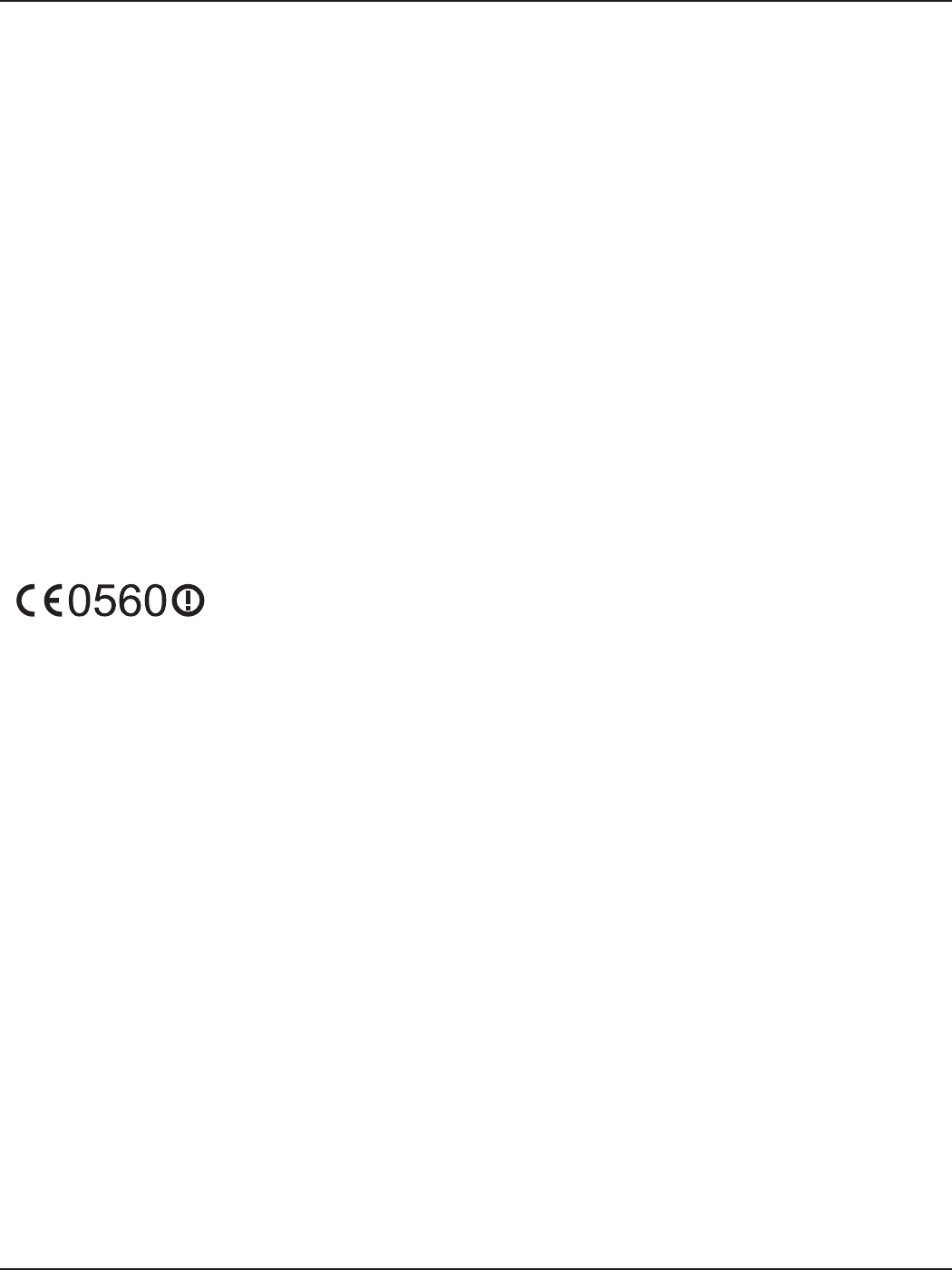
D-Link DSR-Series User Manual 300
Appendix G - Product Statement
This device is a 2.4 GHz wideband transmission system (transceiver), intended for use in all EU member
states and EFTA countries under the following conditions and/or with the following restrictions:
- In Italy the end-user should apply for a license at the national spectrum authorities in order to obtain
authorization to use the device for setting up outdoor radio links and/or for supplying public access to
telecommunications and/or network services.
- This device may not be used for setting up outdoor radio links in France and in some areas the RF output
power may be limited to 10 mW EIRP in the frequency range of 2454 – 2483.5 MHz. For detailed information
the enduser should contact the national spectrum authority in France.
This device is a 5 GHz wideband transmission system (transceiver), intended for use in all EU member
states and EFTA countries under the following conditions and/or with the following restrictions:
- This device may only be used indoors in the frequency bands 5150 – 5250 MHz.
- In France and Luxembourg a limited implementation of the frequency bands 5150 – 5250 MHz and 5250 –
5350 MHz. In Luxermbourg it is not allowed to make use of the frequency band 5470 – 5725 MHz. End-users
are encouraged to contact the national spectrum authorities in France and Luxembourg in order to obtain
the latest information about any restrictions in the 5 GHz frequency band(s).
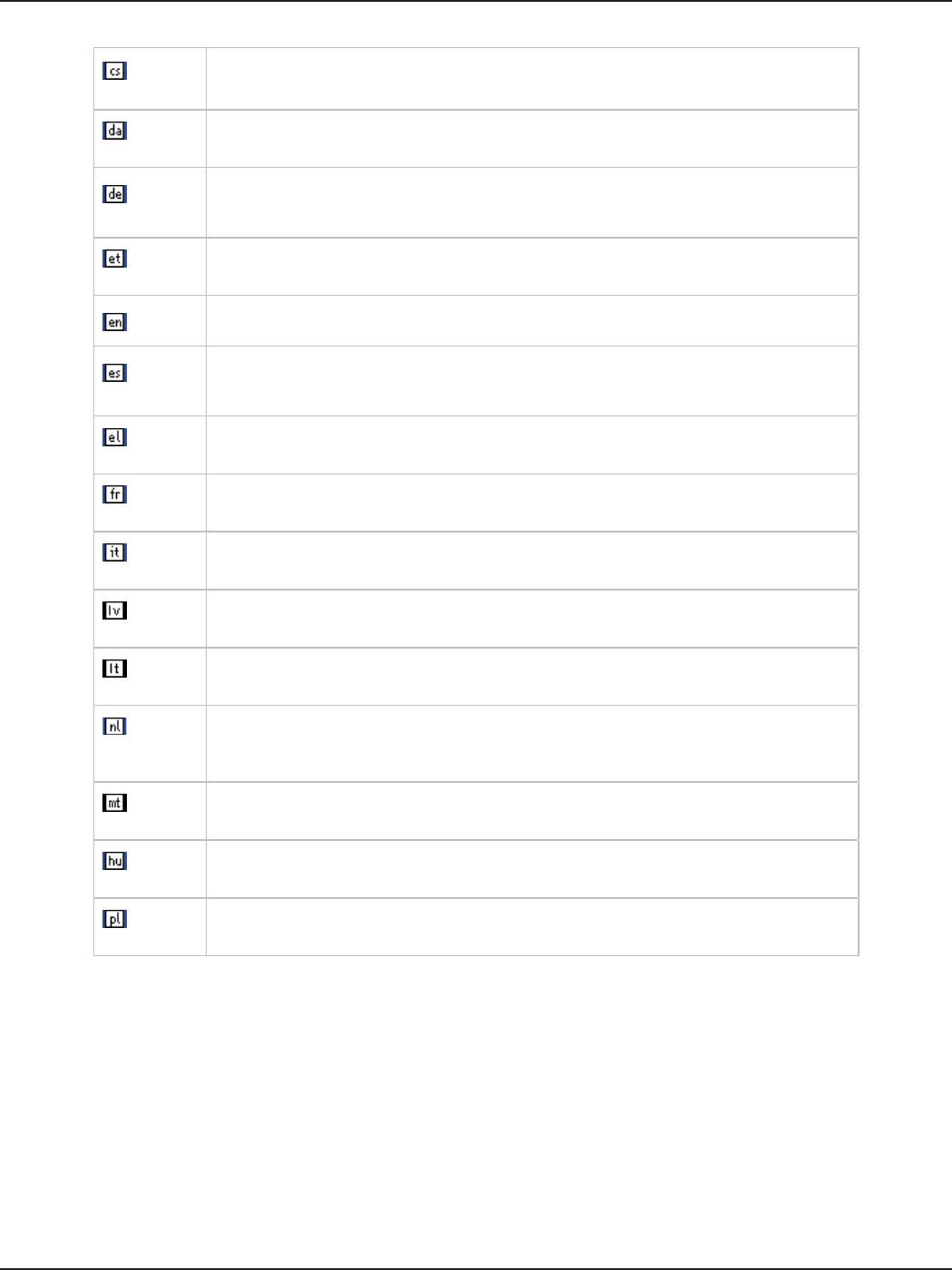
D-Link DSR-Series User Manual 301
Appendix G - Product Statement
Česky
[Czech]
[D-Link Corporation] tímto prohlašuje, že tento [DSR-1000N] je ve shodě se základními
požadavky a dalšími příslušnými ustanoveními směrnice 1999/5/ES.
Dansk
[Danish]
Undertegnede [D-Link Corporation] erklærer herved, at følgende udstyr [DSR-1000N]
overholder de væsentlige krav og øvrige relevante krav i direktiv 1999/5/EF.
Deutsch
[German]
Hiermit erklärt [D-Link Corporation], dass sich das Gerät [DSR-1000N] in Übereinstimmung
mit den grundlegenden Anforderungen und den übrigen einschlägigen Bestimmungen der
Richtlinie 1999/5/EG bendet.
Eesti
[Estonian]
Käesolevaga kinnitab [D-Link Corporation] seadme [DSR-1000N] vastavust direktiivi 1999/5/EÜ
põhinõuetele ja nimetatud direktiivist tulenevatele teistele asjakohastele sätetele.
English Hereby, [D-Link Corporation], declares that this [DSR-1000N] is in compliance with the essential
requirements and other relevant provisions of Directive 1999/5/EC.
Español
[Spanish]
Por medio de la presente [D-Link Corporation] declara que el [DSR-1000N] cumple con los
requisitos esenciales y cualesquiera otras disposiciones aplicables o exigibles de la Directiva
1999/5/CE.
Ελληνική
[Greek]
ΜΕ ΤΗΝ ΠΑΡΟΥΣΑ [D-Link Corporation] ΔΗΛΩΝΕΙ ΟΤΙ [DSR-1000N] ΣΥΜΜΟΡΦΩΝΕΤΑΙ ΠΡΟΣ ΤΙΣ
ΟΥΣΙΩΔΕΙΣ ΑΠΑΙΤΗΣΕΙΣ ΚΑΙ ΤΙΣ ΛΟΙΠΕΣ ΣΧΕΤΙΚΕΣ ΔΙΑΤΑΞΕΙΣ ΤΗΣ ΟΔΗΓΙΑΣ 1999/5/ΕΚ.
Français
[French]
Par la présente [D-Link Corporation] déclare que l’appareil [DSR-1000N] est conforme aux
exigences essentielles et aux autres dispositions pertinentes de la directive 1999/5/CE.
Italiano
[Italian]
Con la presente [D-Link Corporation] dichiara che questo [DSR-1000N] è conforme ai requisiti
essenziali ed alle altre disposizioni pertinenti stabilite dalla direttiva 1999/5/CE.
Latviski
[Latvian]
Ar šo [D-Link Corporation] deklarē, ka [DSR-1000N] atbilst Direktīvas 1999/5/EK būtiskajām
prasībām un citiem ar to saistītajiem noteikumiem.
Lietuvių
[Lithuanian]
Šiuo [D-Link Corporation] deklaruoja, kad šis [DSR-1000N] atitinka esminius reikalavimus ir kitas
1999/5/EB Direktyvos nuostatas.
Nederlands
[Dutch]
Hierbij verklaart [D-Link Corporation] dat het toestel [DSR-1000N] in overeenstemming is met
de essentiële eisen en de andere relevante bepalingen van richtlijn 1999/5/EG.
Malti
[Maltese]
Hawnhekk, [D-Link Corporation], jiddikjara li dan [DSR-1000N] jikkonforma mal-ħtiġijiet
essenzjali u ma provvedimenti oħrajn relevanti li hemm d-Dirrettiva 1999/5/EC.
Magyar
[Hungarian]
Alulírott, [D-Link Corporation] nyilatkozom, hogy a [DSR-1000N] megfelel a vonatkozó alapvetõ
követelményeknek és az 1999/5/EC irányelv egyéb elõírásainak.
Polski
[Polish]
Niniejszym [D-Link Corporation] oświadcza, że [DSR-1000N] jest zgodny z zasadniczymi
wymogami oraz pozostałymi stosownymi postanowieniami Dyrektywy 1999/5/EC.

D-Link DSR-Series User Manual 302
Appendix G - Product Statement
Português
[Portuguese]
[D-Link Corporation] declara que este [DSR-1000N]está conforme com os requisitos essenciais e
outras disposições da Directiva 1999/5/CE.
Slovensko
[Slovenian]
[D-Link Corporation] izjavlja, da je ta [DSR-1000N] v skladu z bistvenimi zahtevami in ostalimi
relevantnimi določili direktive 1999/5/ES.
Slovensky
[Slovak]
[D-Link Corporation] týmto vyhlasuje, že [DSR-1000N] spĺňa základné požiadavky a všetky
príslušné ustanovenia Smernice 1999/5/ES.
Suomi
[Finnish]
[D-Link Corporation] vakuuttaa täten että [DSR-1000N] tyyppinen laite on direktiivin 1999/5/EY
oleellisten vaatimusten ja sitä koskevien direktiivin muiden ehtojen mukainen.
Svenska
[Swedish]
Härmed intygar [D-Link Corporation] att denna [DSR-1000N] står I överensstämmelse med de
väsentliga egenskapskrav och övriga relevanta bestämmelser som framgår av direktiv 1999/5/
EG.

D-Link DSR-Series User Manual 303
Appendix G - Product Statement
2.DSR-500N
Federal Communications Commission (FCC) Compliance Notice: Radio Frequency Notice
This equipment has been tested and found to comply with the limits for a Class B digital device, pursuant
to part 15 of the FCC Rules. These limits are designed to provide reasonable protection against harmful
interference in a residential installation. This equipment generates, uses, and can radiate radio frequency
energy and, if not installed and used in accordance with the instructions, may cause harmful interference
to radio communications. However, there is no guarantee that interference will not occur in a particular
installation. If this equipment does cause harmful interference to radio or television reception, which can be
determined by turning the equipment o and on, the user is encouraged to try to correct the interference
by one or more of the following measures:
x Reorient or relocate the receiving antenna.
x Increase the separation between the equipment and receiver.
x Connect the equipment into an outlet on a circuit dierent from that to which the receiver is
connected.
x Consult the dealer or an experienced radio/TV technician for help.
FCC Radiation Exposure Statement
This equipment complies with FCC RF radiation exposure limits set forth for an uncontrolled environment.
This equipment should be installed and operated with a minimum distance of 20 centimeters between the
radiator and your body.
This device complies with Part 15 of the FCC Rules. Operation is subject to the following two conditions:
1) This device may not cause harmful interference, and
2) This device must accept any interference received, including interference that may cause undesired
operation.
This transmitter must not be co-located or operating in conjunction with any other antenna or transmitter.
The antennas used for this transmitter must be installed to provide a spectrum distance of at least 20cm
from all persons and must not be co-located or operating in conjunction with any other antenna or
transmitter.
This transmitter is restricted to indoor use in the 5150MHz to 5250MHz frequency range.
Non-modication Statement
Use only the integral antenna supplied by the manufacturer when operating this device. Unauthorized
antennas, modications, or attachments could damage the TI Navigator access point and violate FCC
regulations. Any changes or modications not expressly approved by the party responsible for compliance
could void the user’s authority to operate this equipment.
Canadian Department of Communications Industry Canada (IC) Notice
This Class B digital apparatus complies with Canadian ICES-003 and RSS-210. Cet appareil numérique de la
classe B est conforme à la norme NMB-003 et CNR-210 du Canada.

D-Link DSR-Series User Manual 304
Appendix G - Product Statement
Industry Canada Statement
This device complies with RSS-210 of the Industry Canada Rules. Operation is subject to the following two
conditions:
1) This device may not cause harmful interference, and
2) This device must accept any interference received, including interference that may cause undesired
operation.
IMPORTANT NOTE: Radiation Exposure Statement
This equipment complies with IC radiation exposure limits set forth for an uncontrolled environment.
End users must follow the specic operating instructions for satisfying RF exposure compliance.
To maintain compliance with IC RF exposure compliance requirements, please follow operation instruction
as documented in this manual.
Europe – EU Declaration of Conformity
This device complies with the essential requirements of the R&TTE Directive 1999/5/EC. The following
test methods have been applied in order to prove presumption of conformity with the essential
requirements
of the R&TTE Directive 1999/5/EC:
- EN 60950-1: 2006+A11:2009
Safety of information technology equipment
- EN 300 328 V1.7.1 (2006-10)
Electromagnetic compatibility and Radio spectrum Matters (ERM); Wideband transmission systems; Data
transmission equipment operating in the 2,4 GHz ISM band and using wide band modulation techniques;
Harmonized EN covering essential requirements under article 3.2 of the R&TTE Directive
- EN 301 489-17 V1.3.2 (2008-04) and EN 301 489-1 V1.8.1 (2008-04)
Electromagnetic compatibility and Radio spectrum Matters (ERM); Electro Magnetic Compatibility (EMC)
standard for radio equipment and services; Part 17: Specic conditions for 2,4 GHz wideband transmission
systems and 5 GHz high performance RLAN equipment
This device is a 2.4 GHz wideband transmission system (transceiver), intended for use in all EU member
states and EFTA countries under the following conditions and/or with the following restrictions:
- In Italy the end-user should apply for a license at the national spectrum authorities in order to obtain
authorization to use the device for setting up outdoor radio links and/or for supplying public access to
telecommunications and/or network services.
- This device may not be used for setting up outdoor radio links in France and in some areas the RF output
power may be limited to 10 mW EIRP in the frequency range of 2454 – 2483.5 MHz. For detailed
information the enduser should contact the national spectrum authority in France.
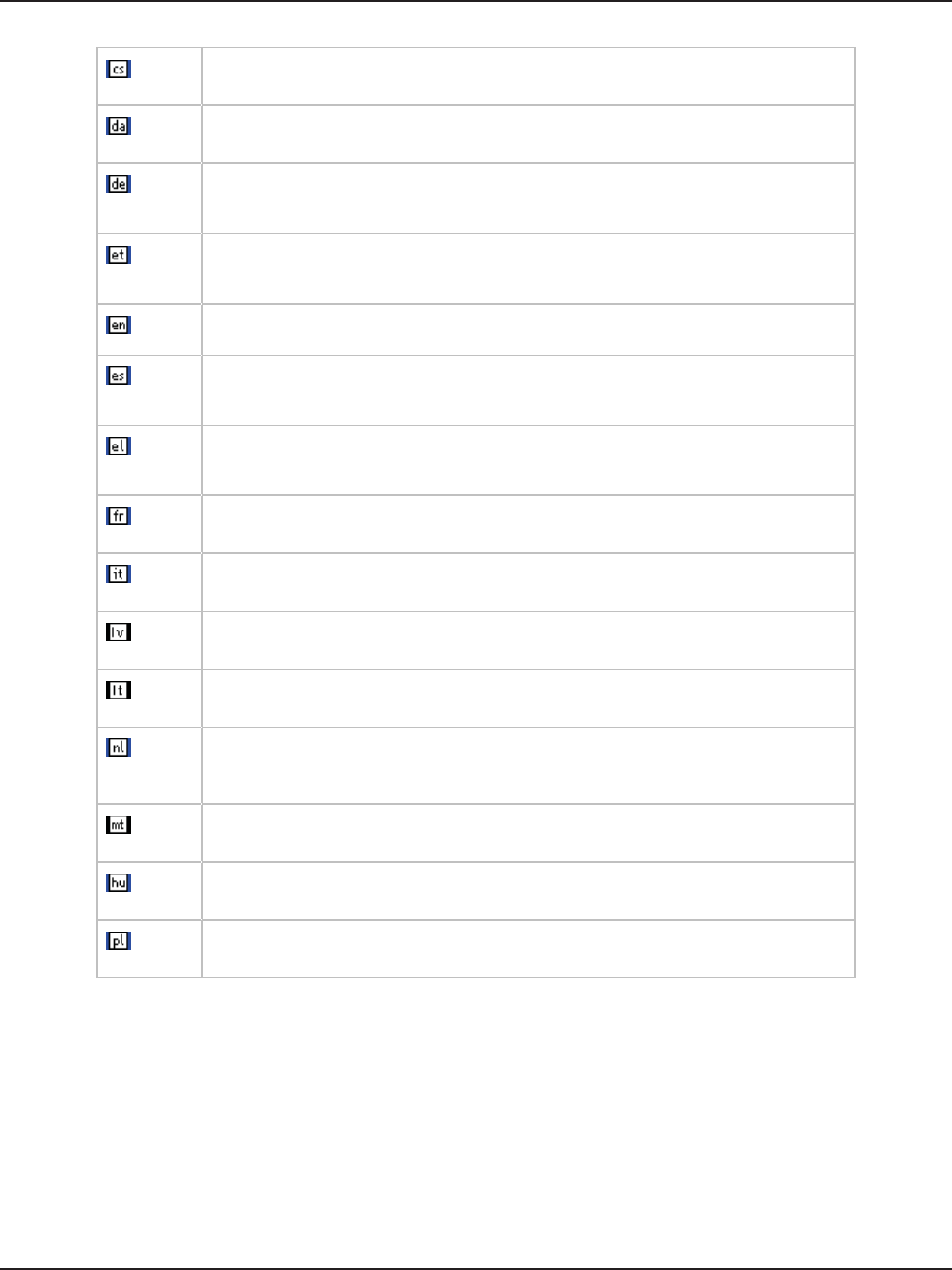
D-Link DSR-Series User Manual 305
Appendix G - Product Statement
ýHVN\
>&]HFK@
>'/LQN&RUSRUDWLRQ@WtPWRSURKODãXMHåHWHQWR>'651@MHYHVKRGČVH]iNODGQtPL
SRåDGDYN\DGDOãtPLSĜtVOXãQêPLXVWDQRYHQtPLVPČUQLFH(6
'DQVN
>'DQLVK@
8QGHUWHJQHGH>'/LQN&RUSRUDWLRQ@HUNOUHUKHUYHGDWI¡OJHQGHXGVW\U>'651@
RYHUKROGHUGHYVHQWOLJHNUDYRJ¡YULJHUHOHYDQWHNUDYLGLUHNWLY()
'HXWVFK
>*HUPDQ@
+LHUPLWHUNOlUW>'/LQN&RUSRUDWLRQ@GDVVVLFKGDV*HUlW>'651@LQhEHUHLQVWLPPXQJ
PLWGHQJUXQGOHJHQGHQ$QIRUGHUXQJHQXQGGHQEULJHQHLQVFKOlJLJHQ%HVWLPPXQJHQGHU
5LFKWOLQLH(*EH¿QGHW
(HVWL
>(VWRQLDQ@
.lHVROHYDJDNLQQLWDE>'/LQN&RUSRUDWLRQ@VHDGPH>'651@YDVWDYXVWGLUHNWLLYL
(hS}KLQ}XHWHOHMDQLPHWDWXGGLUHNWLLYLVWWXOHQHYDWHOHWHLVWHOHDVMDNRKDVWHOH
VlWHWHOH
(QJOLVK +HUHE\>'/LQN&RUSRUDWLRQ@GHFODUHVWKDWWKLV>'651@LVLQFRPSOLDQFHZLWKWKH
HVVHQWLDOUHTXLUHPHQWVDQGRWKHUUHOHYDQWSURYLVLRQVRI'LUHFWLYH(&
(VSDxRO
>6SDQLVK@
3RUPHGLRGHODSUHVHQWH>'/LQN&RUSRUDWLRQ@GHFODUDTXHHO>'651@FXPSOHFRQ
ORVUHTXLVLWRVHVHQFLDOHV\FXDOHVTXLHUDRWUDVGLVSRVLFLRQHVDSOLFDEOHVRH[LJLEOHVGHOD
'LUHFWLYD&(
ǼȜȜȘȞȚțȒ
>*UHHN@
ȂǼȉǾȃȆǹȇȅȊȈǹ>'/LQN&RUSRUDWLRQ@ǻǾȁȍȃǼǿȅȉǿ>'651@ȈȊȂȂȅȇĭȍȃǼȉǹǿ
ȆȇȅȈȉǿȈȅȊȈǿȍǻǼǿȈǹȆǹǿȉǾȈǼǿȈȀǹǿȉǿȈȁȅǿȆǼȈȈȋǼȉǿȀǼȈǻǿǹȉǹȄǼǿȈȉǾȈ
ȅǻǾīǿǹȈǼȀ
)UDQoDLV
>)UHQFK@
3DUODSUpVHQWH>'/LQN&RUSRUDWLRQ@GpFODUHTXHO¶DSSDUHLO>'651@HVWFRQIRUPHDX[
H[LJHQFHVHVVHQWLHOOHVHWDX[DXWUHVGLVSRVLWLRQVSHUWLQHQWHVGHODGLUHFWLYH&(
,WDOLDQR
>,WDOLDQ@
&RQODSUHVHQWH>'/LQN&RUSRUDWLRQ@GLFKLDUDFKHTXHVWR>'651@qFRQIRUPHDL
UHTXLVLWLHVVHQ]LDOLHGDOOHDOWUHGLVSRVL]LRQLSHUWLQHQWLVWDELOLWHGDOODGLUHWWLYD&(
/DWYLVNL
>/DWYLDQ@
$UãR>'/LQN&RUSRUDWLRQ@GHNODUƝND>'651@DWELOVW'LUHNWƯYDV(.EnjWLVNDMƗP
SUDVƯEƗPXQFLWLHPDUWRVDLVWƯWDMLHPQRWHLNXPLHP
/LHWXYLǐ
>/LWKXDQLDQ@
âLXR>'/LQN&RUSRUDWLRQ@GHNODUXRMDNDGãLV>'651@DWLWLQNDHVPLQLXVUHLNDODYLPXVLU
NLWDV(%'LUHNW\YRVQXRVWDWDV
1HGHUODQGV
>'XWFK@
+LHUELMYHUNODDUW>'/LQN&RUSRUDWLRQ@GDWKHWWRHVWHO>'651@LQRYHUHHQVWHPPLQJLV
PHWGHHVVHQWLsOHHLVHQHQGHDQGHUHUHOHYDQWHEHSDOLQJHQYDQULFKWOLMQ(*
0DOWL
>0DOWHVH@
+DZQKHNN>'/LQN&RUSRUDWLRQ@MLGGLNMDUDOLGDQ>'651@MLNNRQIRUPDPDOƫWLƥLMLHW
HVVHQ]MDOLXPDSURYYHGLPHQWLRƫUDMQUHOHYDQWLOLKHPP¿G'LUUHWWLYD(&
0DJ\DU
>+XQJDULDQ@
$OXOtURWW>'/LQN&RUSRUDWLRQ@Q\LODWNR]RPKRJ\D>'651@PHJIHOHODYRQDWNR]y
DODSYHW}N|YHWHOPpQ\HNQHNpVD](&LUiQ\HOYHJ\pEHO}tUiVDLQDN
3ROVNL
>3ROLVK@
1LQLHMV]\P>'/LQN&RUSRUDWLRQ@RĞZLDGF]DĪH>'651@MHVW]JRGQ\]]DVDGQLF]\PL
Z\PRJDPLRUD]SR]RVWDá\PLVWRVRZQ\PLSRVWDQRZLHQLDPL'\UHNW\Z\(&
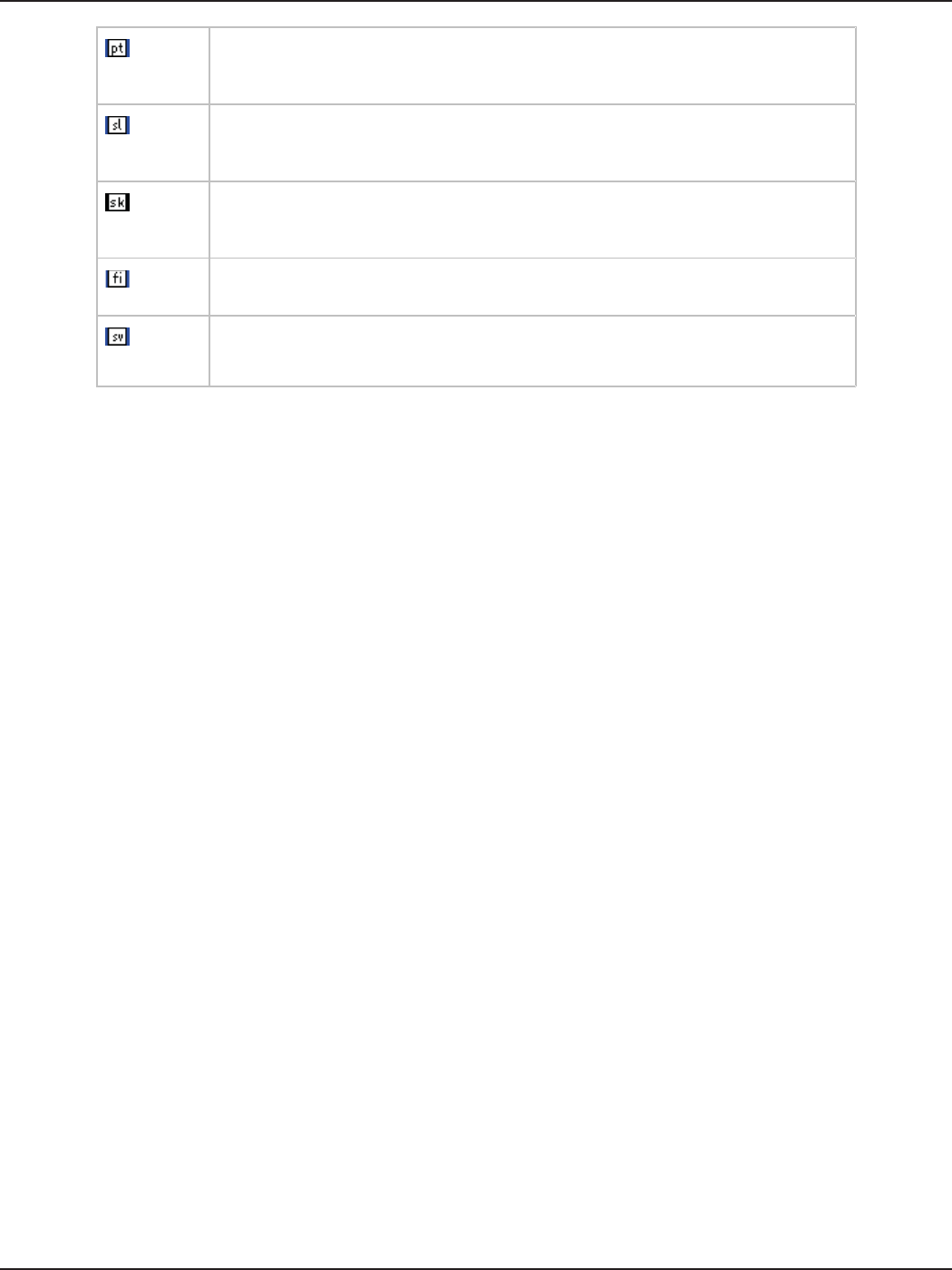
D-Link DSR-Series User Manual 306
Appendix G - Product Statement
3RUWXJXrV
>3RUWXJXHVH@
>'/LQN&RUSRUDWLRQ@GHFODUDTXHHVWH>'651@HVWiFRQIRUPHFRPRVUHTXLVLWRV
HVVHQFLDLVHRXWUDVGLVSRVLo}HVGD'LUHFWLYD&(
6ORYHQVNR
>6ORYHQLDQ@
>'/LQN&RUSRUDWLRQ@L]MDYOMDGDMHWD>'651@YVNODGX]ELVWYHQLPL]DKWHYDPLLQ
RVWDOLPLUHOHYDQWQLPLGRORþLOLGLUHNWLYH(6
6ORYHQVN\
>6ORYDN@
>'/LQN&RUSRUDWLRQ@WêPWRY\KODVXMHåH>'651@VSĎĖD]iNODGQpSRåLDGDYN\D
YãHWN\SUtVOXãQpXVWDQRYHQLD6PHUQLFH(6
6XRPL
>)LQQLVK@
>'/LQN&RUSRUDWLRQ@YDNXXWWDDWlWHQHWWl>'651@W\\SSLQHQODLWHRQGLUHNWLLYLQ
(<ROHHOOLVWHQYDDWLPXVWHQMDVLWlNRVNHYLHQGLUHNWLLYLQPXLGHQHKWRMHQPXNDLQHQ
6YHQVND
>6ZHGLVK@
+lUPHGLQW\JDU>'/LQN&RUSRUDWLRQ@DWWGHQQD>'651@VWnU,|YHUHQVVWlPPHOVH
PHGGHYlVHQWOLJDHJHQVNDSVNUDYRFK|YULJDUHOHYDQWDEHVWlPPHOVHUVRPIUDPJnUDY
GLUHNWLY(*

D-Link DSR-Series User Manual 307
Appendix G - Product Statement
3.DSR-250N/DSR-250NB1
Federal Communication Commission Interference Statement
This equipment has been tested and found to comply with the limits for a Class B digital device, pursuant
to Part 15 of the FCC Rules. These limits are designed to provide reasonable protection against harmful
interference in a residential installation. This equipment generates, uses and can radiate radio frequency
energy and, if not installed and used in accordance with the instructions, may cause harmful interference
to radio communications. However, there is no guarantee that interference will not occur in a particular
installation. If this equipment does cause harmful interference to radio or television reception, which can be
determined by turning the equipment o and on, the user is encouraged to try to correct the interference
by one of the following measures:
x Reorient or relocate the receiving antenna.
x Increase the separation between the equipment and receiver.
x Connect the equipment into an outlet on a circuit dierent from that to which the receiver is
connected.
x Consult the dealer or an experienced radio/TV technician for help.
FCC Caution:
Any changes or modications not expressly approved by the party responsible for compliance could void
the user’s authority to operate this equipment.
This device complies with Part 15 of the FCC Rules. Operation is subject to the following two conditions: (1)
This device may not cause harmful interference, and (2) this device must accept any interference received,
including interference that may cause undesired operation.
RSS-GEN 7.1.4:
User Manual for Transmitters with Detachable Antennas
The user manual of transmitter devices equipped with detachable antennas shall contain the following
information in a conspicuous location:
This device has been designed to operate with the antennas listed below, and having a maximum gain of
[1.8] dB. Antennas not included in this list or having a gain greater than [1.8] dB are strictly prohibited for use
with this device. The required antenna impedance is [50] ohms.
RSS-GEN 7.1.5
To reduce potential radio interference to other users, the antenna type and its gain should be so chosen
that the equivalent isotropically radiated power (e.i.r.p.) is not more than that permitted for successful
communication.
Le présent appareil est conforme aux CNR d’Industrie Canada applicables aux appareils radio exempts de
licence. L’exploitation est autorisée aux deux conditions suivantes: (1) l’appareil ne doit pas produire de
brouillage, et (2) l’utilisateur de l’appareil doit accepter tout brouillage radioélectrique subi, même si le
brouillage est susceptible d’en comSpromettre le fonctionnement.
Is herewith conrmed to comply with the requirements set out in the Council Directive on the
Approximation of the Laws of the Member States relating to Electromagnetic Compatibility (2004/108/

D-Link DSR-Series User Manual 308
Appendix G - Product Statement
EC), Low-voltage Directive (2006/95/EC), the procedures given in European Council Directive 99/5/EC and
2004/104/EC.
The equipment was passed. The test was performed according to the following European standards:
EN 300 328 V.1.7.1
EN 301 489-1 V.1. 8.1 / EN 301 489-17 V.2.1.1
EN 62311
EN 60950-1
Regulatory statement (R&TTE)
European standards dictate maximum radiated transmit power of 100mW EIRP and frequency range 2.400-
2.4835GHz; In France, the equipment must be restricted to the 2.4465-2.4835GHz frequency range and must
be restricted to indoor use.
Operation of this device is subjected to the following National regulations and may be prohibited to use if
certain restriction should be applied.
D=0.020m is the minimum safety distance between the EUT and human body when the E-Field strength is
61V/m.
NCC Warning Statement
Article 12
Without permission, any company, rm or user shall not alter the frequency, increase the power, or change
the characteristics and functions of the original design of the certied lower power frequency electric
machinery.
Article 14
The application of low power frequency electric machineries shall not aect the navigation safety nor
interfere a legal communication, if an interference is found, the service will be suspended until improvement
is made and the interference no longer exists.
Canadian Department of Communications Industry Canada (IC) Notice
CAN ICES-3(B)/NMB-3(B)
Industry Canada Statement
This device complies with Industry Canada licence-exempt RSS standard(s). Operation is subject to the
following two conditions:
(1) this device may not cause interference, and
(2) this device must accept any interference, including interference that may cause undesired operation
of the device.
Le présent appareil est conforme aux CNR d’Industrie Canada applicables aux appareils radio exempts de
licence. L’exploitation est autorisée aux deux conditions suivantes :
(1) l’appareil ne doit pas produire de brouillage, et
(2) l’utilisateur de l’appareil doit accepter tout brouillage radioélectrique subi, même si le brouillage est
susceptible d’en compromettre le fonctionnement.
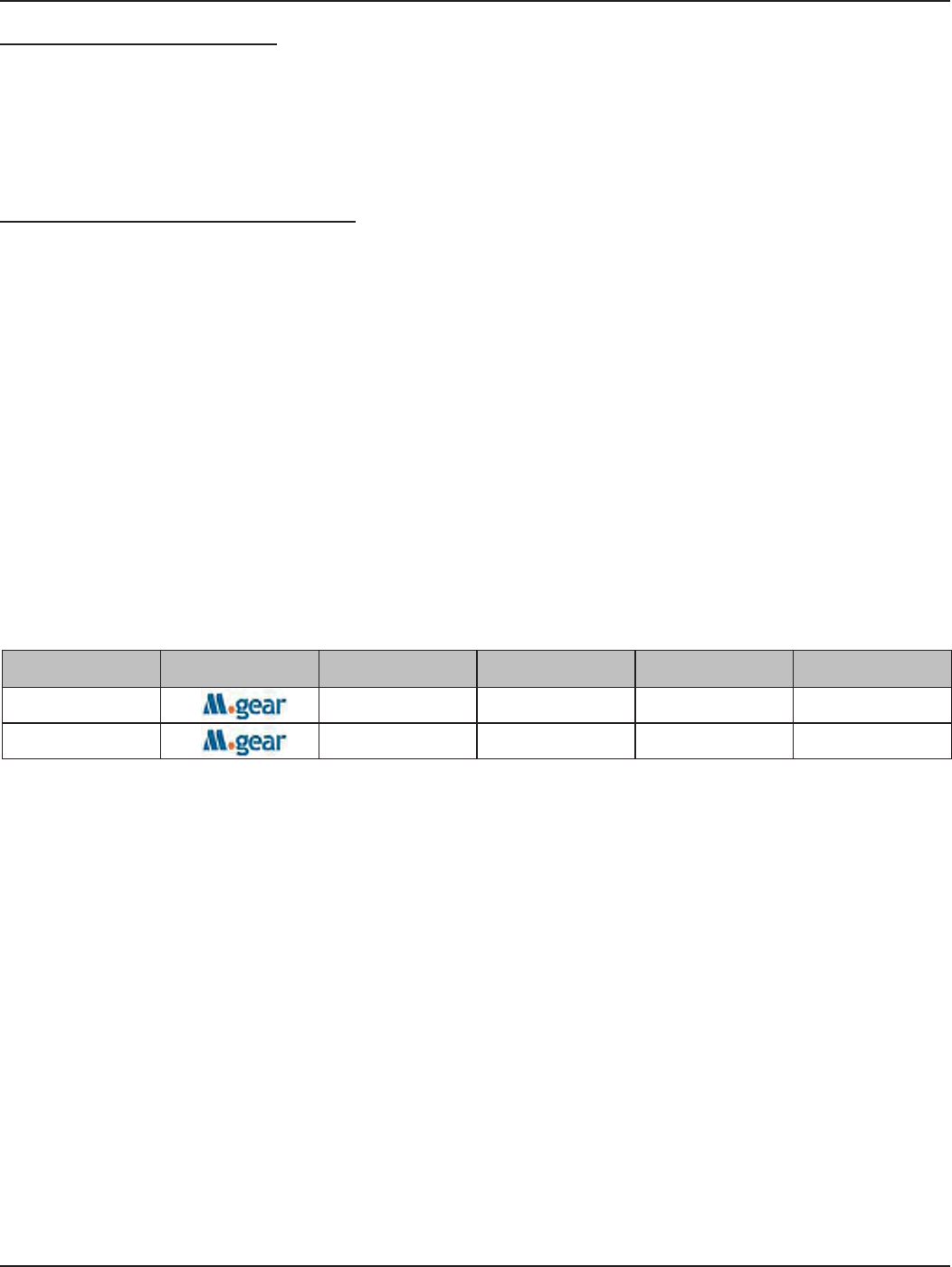
D-Link DSR-Series User Manual 309
Appendix G - Product Statement
Radiation Exposure Statement:
The device meets the exemption from the routine evaluation limits in section 2.5 of RSS 102 and compliance
with RSS-102 RF exposure, users can obtain Canadian information on RF exposure and compliance.
This transmitter must not be co-located or operating in conjunction with any other antenna or transmitter.
This equipment should be installed and operated with a minimum distance of 20 centimeters between the
radiator and your body.
Déclaration d’exposition aux radiations:
Le dispositif rencontre l’exemption des limites courantes d’évaluation dans la section 2.5 de RSS 102 et la
conformité à l’exposition de RSS-102 rf, utilisateurs peut obtenir l’information canadienne sur l’exposition et
la conformité de rf.
Cet émetteur ne doit pas être Co-placé ou ne fonctionnant en même temps qu’aucune autre antenne ou
émetteur. Cet équipement devrait être installé et actionné avec une distance minimum de 20 centimètres
entre le radiateur et votre corps.
This radio transmitter (Model:DSR-250N) has been approved by Industry Canada to operate with the antenna
types listed below with the maximum permissible gain and required antenna impedance for each antenna type
indicated. Antenna types not included in this list, having a gain greater than the maximum gain indicated for that
type, are strictly prohibited for use with this device.
Le présent émetteur radio (Model:DSR-250N) a été approuvé par Industrie Canada pour fonctionner avec les
types d’antenne énumérés ci-dessous et ayant un gain admissible maximal et l’impédance requise pour chaque
type d’antenne. Les types d’antenne non inclus dans cette liste, ou dont le gain est supérieur au gain maximal
indiqué, sont strictement interdits pour l’exploitation de l’émetteur.
Ant. Brand Model Name Antenna Type Connector Gain (dBi)
1 SSR-02521 Dipole R-SMA 2.85
2 SSR-02521 Dipole R-SMA 2.71
This device complies with FCC radiation exposure limits set forth for an uncontrolled environment
and it also complies with Part 15 of the FCC RF Rules. This equipment must be installed and
operated in accordance with provided instructions and the antenna(s) used for this transmitter must
be installed to provide a separation distance of at least 20 cm from all persons and must not be co-
located or operating in conjunction with any other antenna or transmitter. End-users and installers
must be provided with antenna installation instructions and consider removing the no-collocation
statement.

D-Link DSR-Series User Manual 310
Appendix G - Product Statement
4. DSR-150N
Federal Communication Commission Interference Statement
This equipment has been tested and found to comply with the limits for a Class B digital device, pursuant
to Part 15 of the FCC Rules. These limits are designed to provide reasonable protection against harmful
interference in a residential installation. This equipment generates, uses and can radiate radio frequency
energy and, if not installed and used in accordance with the instructions, may cause harmful interference
to radio communications. However, there is no guarantee that interference will not occur in a particular
installation. If this equipment does cause harmful interference to radio or television reception, which can be
determined by turning the equipment o and on, the user is encouraged to try to correct the interference
by one of the following measures:
x Reorient or relocate the receiving antenna.
x Increase the separation between the equipment and receiver.
x Connect the equipment into an outlet on a circuit dierent from that to which the receiver is
connected.
x Consult the dealer or an experienced radio/TV technician for help.
FCC Caution:
Any changes or modications not expressly approved by the party responsible for compliance could void
the user’s authority to operate this equipment. This device complies with Part 15 of the FCC Rules. Operation
is subject to the following two conditions:
(1) This device may not cause harmful interference, and
(2) this device must accept any interference received, including interference that may cause undesired
operation.
IMPORTANT NOTE:
FCC Radiation Exposure Statement:
This equipment complies with FCC radiation exposure limits set forth for an uncontrolled environment. This
equipment should be installed and operated with minimum distance 20cm between the radiator & your
body.
This transmitter must not be co-located or operating in conjunction with any other antenna or transmitter.
The availability of some specic channels and/or operational frequency bands are country dependent and
are rmware programmed at the factory to match the intended destination. The rmware setting is not
accessible by the end user.
Note: The country code selection is for non-US model only and is not available to all US model. Per FCC
regulation, all WiFi product marketed in US must xed to US operation channels only..
Europe – EU Declaration of Conformity
This device complies with the essential requirements of the R&TTE Directive 1999/5/EC. The following test
methods have been applied in order to prove presumption of conformity with the essential requirements of
the R&TTE Directive 1999/5/EC:
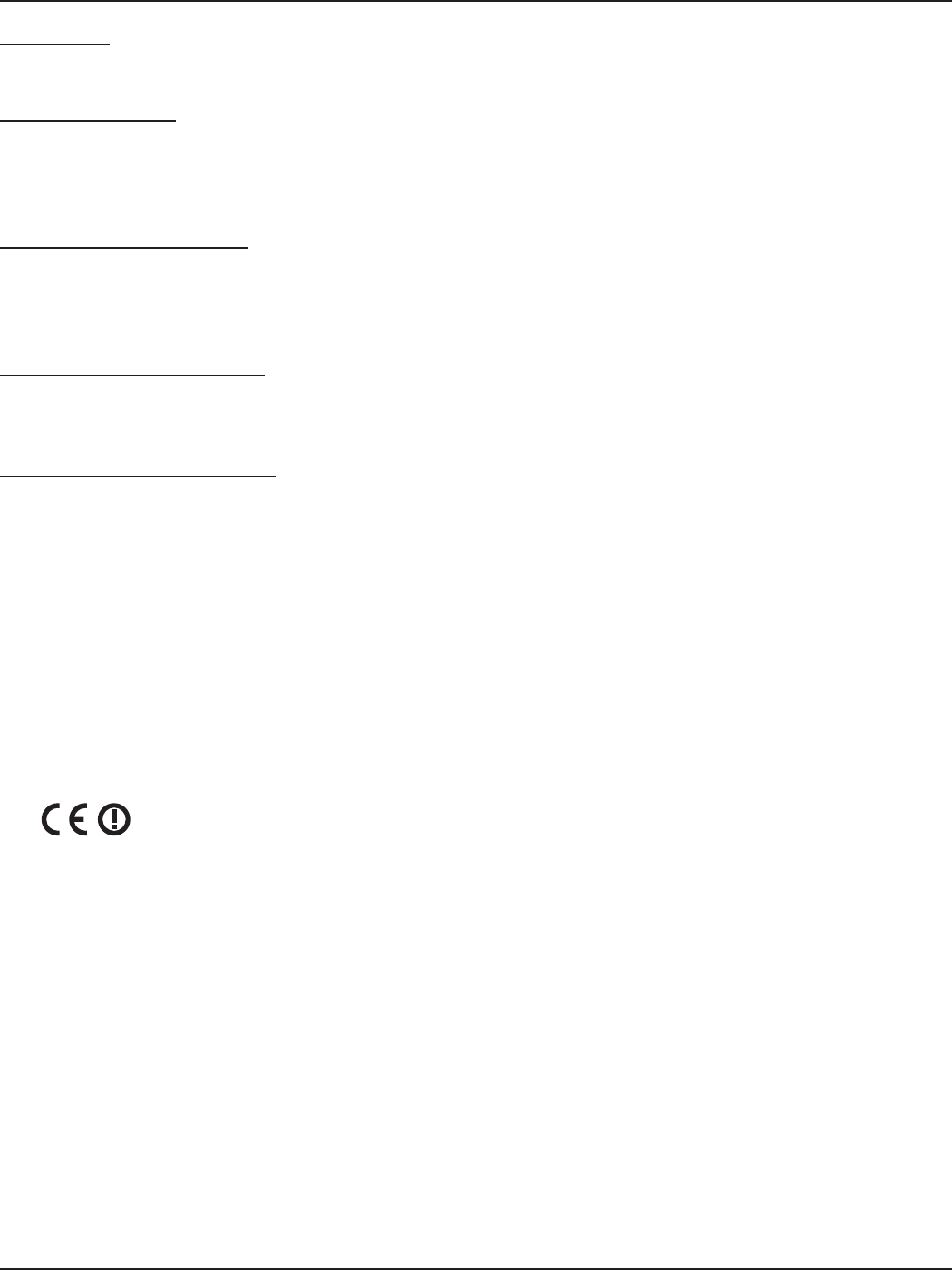
D-Link DSR-Series User Manual 311
Appendix G - Product Statement
EN 60950-1:
Safety of Information Technology Equipment
EN50385 : (2002-08)
Product standard to demonstrate the compliance of radio base stations and xed terminal stations for
wireless telecommunication systems with the basic restrictions or the reference levels related to human
exposure to radio frequency electromagnetic elds (110MHz - 40 GHz) - General public
EN 300 328 V1.7.1: (2006-10)
Electromagnetic compatibility and Radio spectrum Matters (ERM); Wideband Transmission systems; Data
transmission equipment operating in the 2,4 GHz ISM band and using spread spectrum modulation
techniques; Harmonized EN covering essential requirements under article 3.2 of the R&TTE Directive
EN 301 489-1 V1.8.1: (2008-04)
Electromagnetic compatibility and Radio Spectrum Matters (ERM); ElectroMagnetic Compatibility (EMC)
standard for radio equipment and services; Part 1: Common technical requirements
EN 301 489-17 V2.1.1 (2009-05)
Electromagnetic compatibility and Radio spectrum Matters (ERM); ElectroMagnetic Compatibility (EMC)
standard for radio equipment; Part 17: Specic conditions for Broadband Data Transmission Systems
This device is a 2.4 GHz wideband transmission system (transceiver), intended for use in all EU member
states and EFTA countries, except in France and Italy where restrictive use applies.
In Italy the end-user should apply for a license at the national spectrum authorities in order to obtain
authorization to use the device for setting up outdoor radio links and/or for supplying public access to
telecommunications and/or network services.
This device may not be used for setting up outdoor radio links in France and in some areas the RF output
power may be limited to 10 mW EIRP in the frequency range of 2454 – 2483.5 MHz. For detailed information
the end-user should contact the national spectrum authority in France.
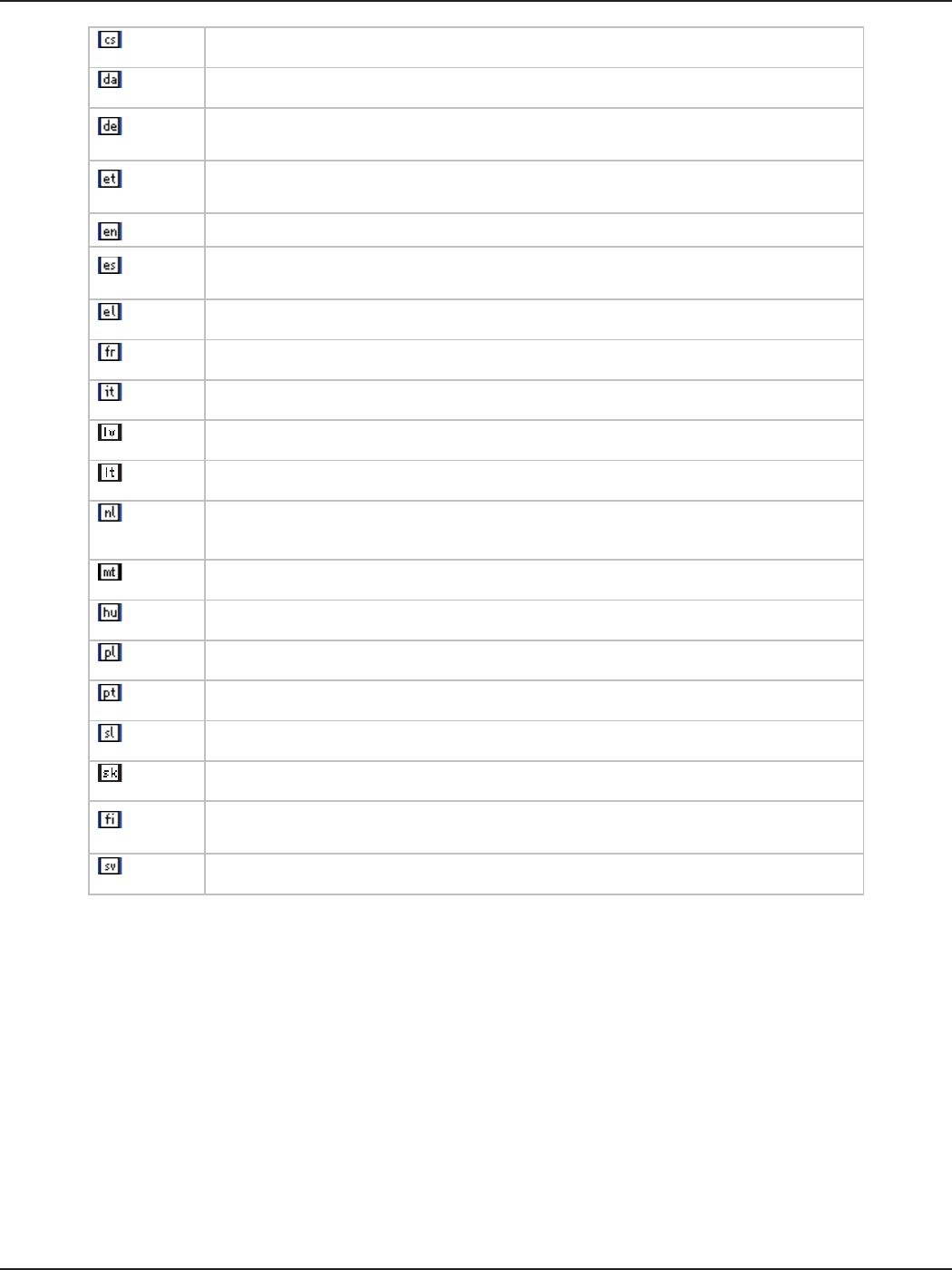
D-Link DSR-Series User Manual 312
Appendix G - Product Statement
Česky
[Czech]
[Jméno výrobce] tímto prohlašuje, že tento [typ zařízení] je ve shodě se základními požadavky a
dalšími příslušnými ustanoveními směrnice 1999/5/ES.
Dansk
[Danish]
Undertegnede [fabrikantens navn] erklærer herved, at følgende udstyr [udstyrets
typebetegnelse] overholder de væsentlige krav og øvrige relevante krav i direktiv 1999/5/EF.
Deutsch
[German]
Hiermit erklärt [Name des Herstellers], dass sich das Gerät [Gerätetyp] in Übereinstimmung
mit den grundlegenden Anforderungen und den übrigen einschlägigen Bestimmungen der
Richtlinie 1999/5/EG bendet.
Eesti
[Estonian]
Käesolevaga kinnitab [tootja nimi = name of manufacturer] seadme [seadme tüüp = type of
equipment] vastavust direktiivi 1999/5/EÜ põhinõuetele ja nimetatud direktiivist tulenevatele
teistele asjakohastele sätetele.
English Hereby, [name of manufacturer], declares that this [type of equipment] is in compliance with the
essential requirements and other relevant provisions of Directive 1999/5/EC.
Español
[Spanish]
Por medio de la presente [nombre del fabricante] declara que el [clase de equipo] cumple con
los requisitos esenciales y cualesquiera otras disposiciones aplicables o exigibles de la Directiva
1999/5/CE.
Ελληνική
[Greek]
ΜΕ ΤΗΝ ΠΑΡΟΥΣΑ [name of manufacturer] ΔΗΛΩΝΕΙ ΟΤΙ [type of equipment] ΣΥΜΜΟΡΦΩΝΕΤΑΙ
ΠΡΟΣ ΤΙΣ ΟΥΣΙΩΔΕΙΣ ΑΠΑΙΤΗΣΕΙΣ ΚΑΙ ΤΙΣ ΛΟΙΠΕΣ ΣΧΕΤΙΚΕΣ ΔΙΑΤΑΞΕΙΣ ΤΗΣ ΟΔΗΓΙΑΣ 1999/5/ΕΚ.
Français
[French]
Par la présente [nom du fabricant] déclare que l’appareil [type d’appareil] est conforme aux
exigences essentielles et aux autres dispositions pertinentes de la directive 1999/5/CE.
Italiano
[Italian]
Con la presente [nome del costruttore] dichiara che questo [tipo di apparecchio] è conforme ai
requisiti essenziali ed alle altre disposizioni pertinenti stabilite dalla direttiva 1999/5/CE.
Latviski
[Latvian]
Ar šo [name of manufacturer / izgatavotāja nosaukums] deklarē, ka [type of equipment / iekārtas
tips] atbilst Direktīvas 1999/5/EK būtiskajām prasībām un citiem ar to saistītajiem noteikumiem.
Lietuvių
[Lithuanian]
Šiuo [manufacturer name] deklaruoja, kad šis [equipment type] atitinka esminius reikalavimus ir
kitas 1999/5/EB Direktyvos nuostatas.
Nederlands
[Dutch]
Hierbij verklaart [naam van de fabrikant] dat het toestel [type van toestel] in overeenstemming is
met de essentiële eisen en de andere relevante bepalingen van richtlijn 1999/5/EG.
Malti
[Maltese]
Hawnhekk, [isem tal-manifattur], jiddikjara li dan [il-mudel tal-prodott] jikkonforma mal-ħtiġijiet
essenzjali u ma provvedimenti oħrajn relevanti li hemm d-Dirrettiva 1999/5/EC.
Magyar
[Hungarian]
Alulírott, [gyártó neve] nyilatkozom, hogy a [... típus] megfelel a vonatkozó alapvetõ
követelményeknek és az 1999/5/EC irányelv egyéb elõírásainak.
Polski
[Polish]
Niniejszym [nazwa producenta] oświadcza, że [nazwa wyrobu] jest zgodny z zasadniczymi
wymogami oraz pozostałymi stosownymi postanowieniami Dyrektywy 1999/5/EC.
Português
[Portuguese]
[Nome do fabricante] declara que este [tipo de equipamento] está conforme com os requisitos
essenciais e outras disposições da Directiva 1999/5/CE.
Slovensko
[Slovenian]
[Ime proizvajalca] izjavlja, da je ta [tip opreme] v skladu z bistvenimi zahtevami in ostalimi
relevantnimi določili direktive 1999/5/ES.
Slovensky
[Slovak]
[Meno výrobcu] týmto vyhlasuje, že [typ zariadenia] spĺňa základné požiadavky a všetky príslušné
ustanovenia Smernice 1999/5/ES.
Suomi
[Finnish]
[Valmistaja=manufacturer] vakuuttaa täten että [type of equipment = laitteen tyyppimerkintä]
tyyppinen laite on direktiivin 1999/5/EY oleellisten vaatimusten ja sitä koskevien direktiivin
muiden ehtojen mukainen.
Svenska
[Swedish]
Härmed intygar [företag] att denna [utrustningstyp] står I överensstämmelse med de väsentliga
egenskapskrav och övriga relevanta bestämmelser som framgår av direktiv 1999/5/EG.

D-Link DSR-Series User Manual 313
Appendix G - Product Statement
Industry Canada statement:
This device complies with RSS-210 of the Industry Canada Rules. Operation is subject to the following two
conditions:
(1) This device may not cause harmful interference, and
(2) This device must accept any interference received, including interference that may cause undesired
operation.
Ce dispositif est conforme à la norme CNR-210 d’Industrie Canada applicable aux appareils radio exempts
de licence. Son fonctionnement est sujet aux deux conditions suivantes: (1) le dispositif ne doit pas produire
de brouillage préjudiciable, et (2) ce dispositif doit accepter tout brouillage reçu, y compris un brouillage
susceptible de provoquer un fonctionnement indésirable.
Radiation Exposure Statement:
The device meets the exemption from the routine evaluation limits in section 2.5 of RSS 102 and compliance
with RSS-102 RF exposure, users can obtain Canadian information on RF exposure and compliance.
This transmitter must not be co-located or operating in conjunction with any other antenna or transmitter.
This equipment should be installed and operated with a minimum distance of 20 centimeters between the
radiator and your body.
Déclaration d’exposition aux radiations:
Le dispositif rencontre l’exemption des limites courantes d’évaluation dans la section 2.5 de RSS 102 et la
conformité à l’exposition de RSS-102 rf, utilisateurs peut obtenir l’information canadienne sur l’exposition et
la conformité de rf.
Cet émetteur ne doit pas être Co-placé ou ne fonctionnant en même temps qu’aucune autre antenne ou
émetteur. Cet équipement devrait être installé et actionné avec une distance minimum de 20 centimètres
entre le radiateur et votre corps.
Wall-Mount Option
The Router has four wall-mount slots on its bottom panel.
Before you begin, make sure you have two screws that are size #4 - this indicates a diameter measurement of
0.112inches (2.845mm).
1. Determine where you want to mount the Router.
2. Drill two holes into the wall. Make sure adjacent holes are 2.36 inches (60mm) apart.
3. Insert a screw into each hole, and leave 0.2inches (5mm) of its head exposed.
4. Maneuver the Router so the wall-mount slots line up with the two screws.
5. Place the wall-mount slots over the screws and slide the Router down until the screws t snugly into the
wall-mount slots.